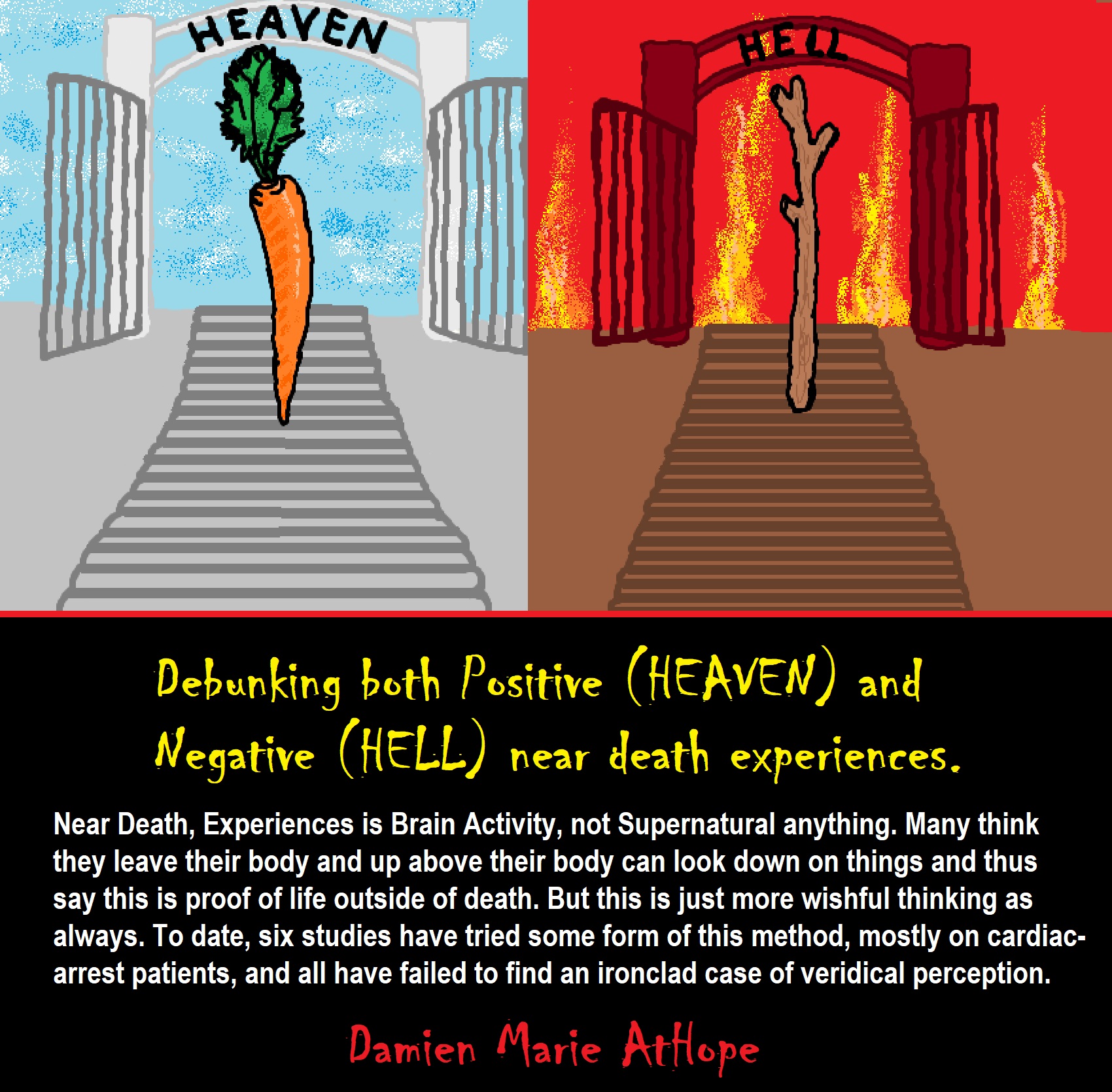
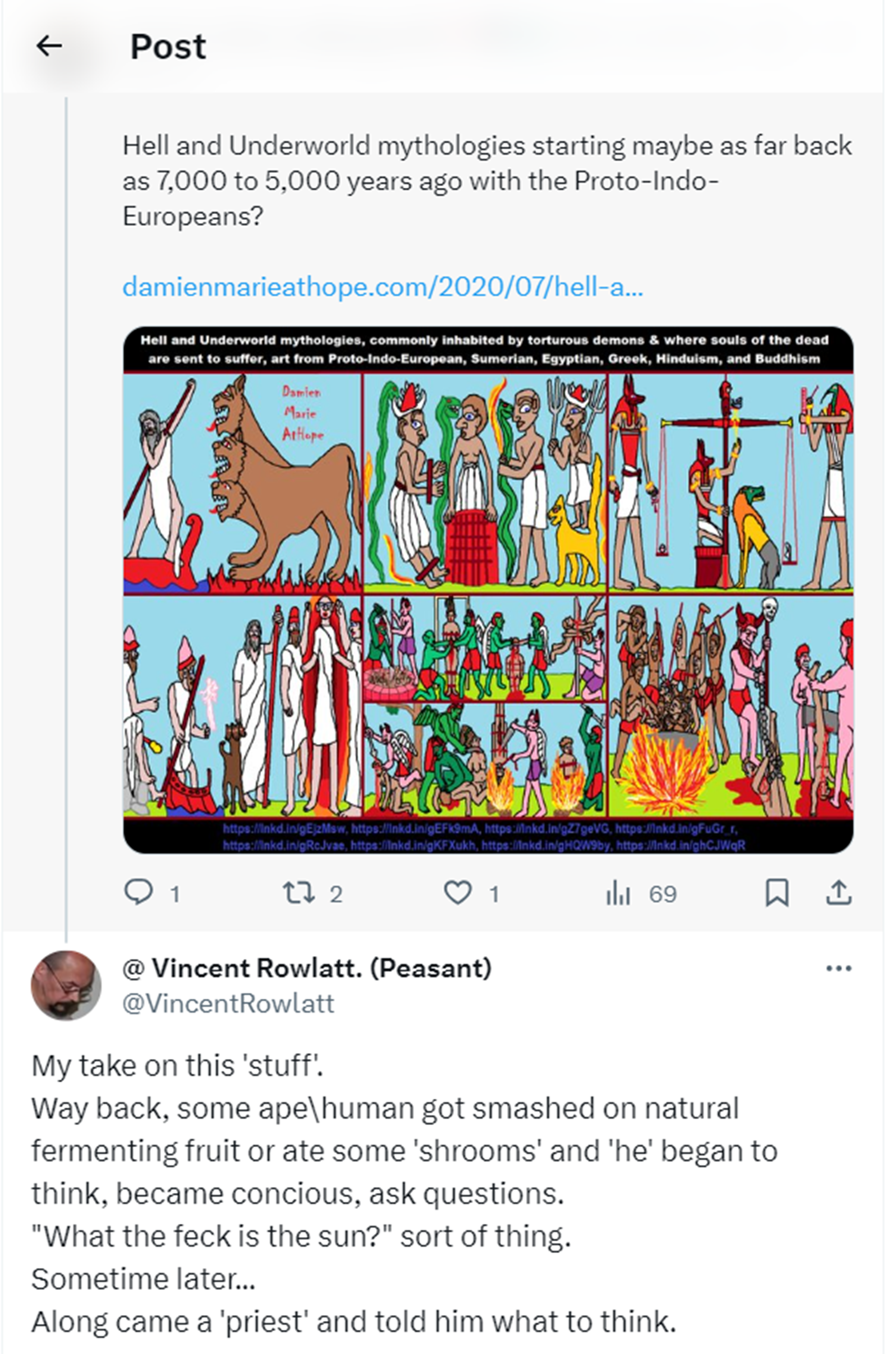
@ Vincent Rowlatt. (Peasant) – “My take on this ‘stuff’. Way back, some ape\human got smashed on natural fermenting fruit or ate some ‘shrooms’, and ‘he’ began to think, became conscious, and ask questions. “What the feck is the sun?” sort of thing. Sometime later… Along came a ‘priest’ and told him what to think.”
My response, The Drunken Monkey hypothesis (Ps. I don’t think it actually is an important factor in evolution, nor religion)
@ Vincent Rowlatt. (Peasant) – “The question, for example, “What the feck is the sun?” was exploited by those who called themselves ‘priests’. At some point in time, ‘humans’ did not ask such questions… What changed and why?”
My response, My take on religious evolution (bellow).
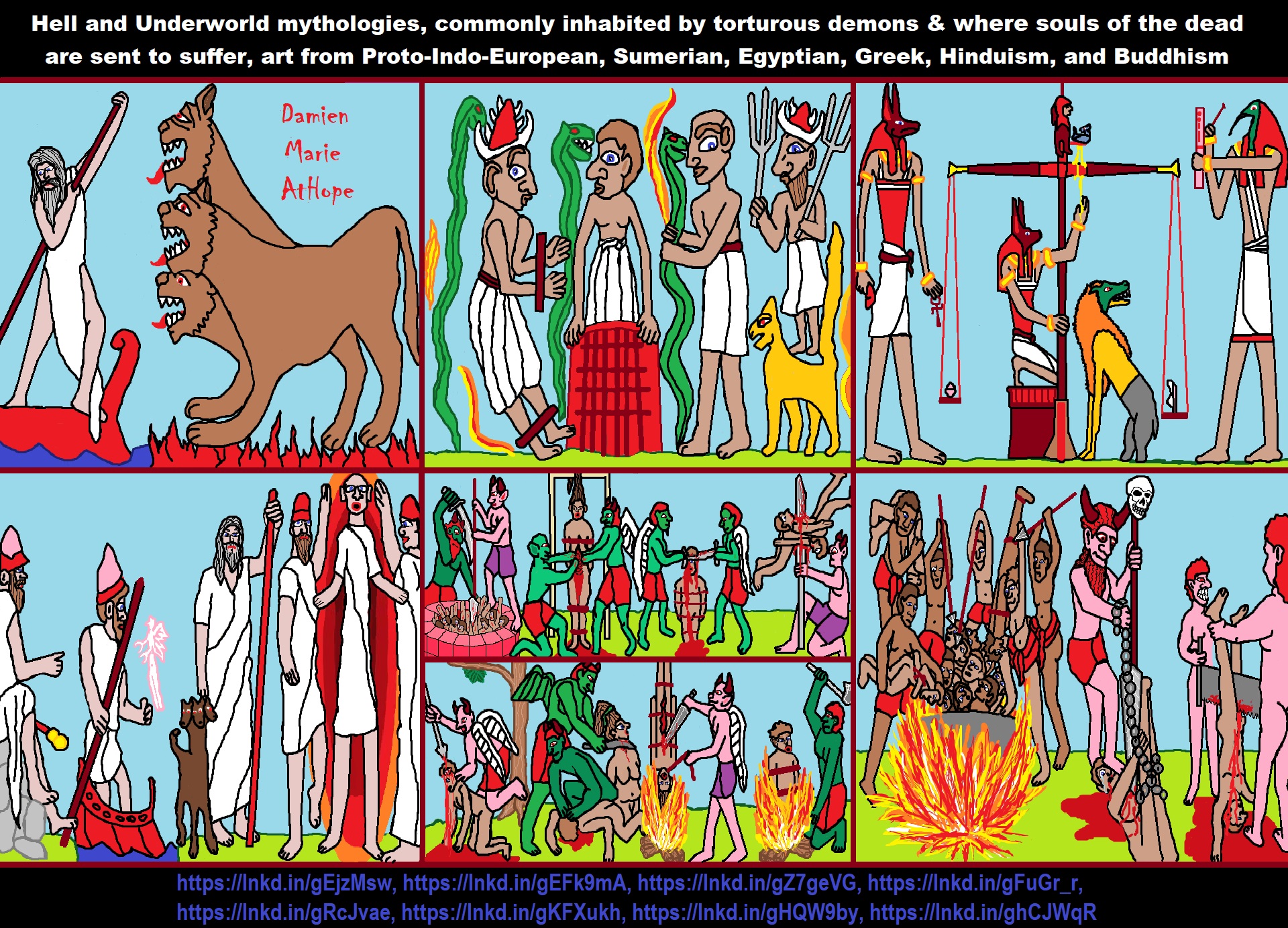
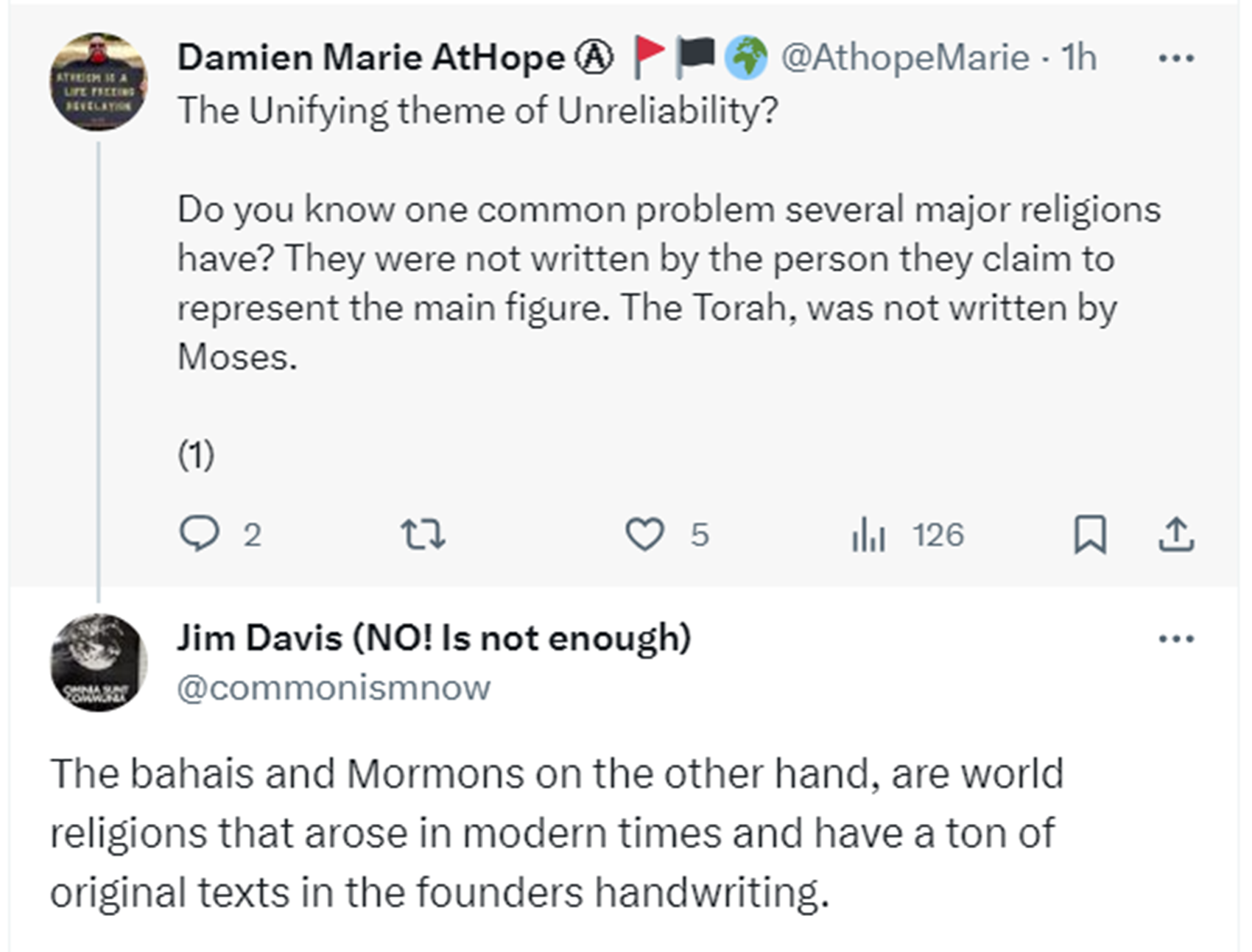
The Unifying theme of Unreliability?
You know one common problem several major religions have? They were not written by the person they claim to represent the main figure. The Torah, was not written by Moses. The claimed sacred texts of Buddhism were not written by Buddha (also known as Siddhārtha Gautama). And of course, not even one written word was put in the Christian Bible authored by Jesus, let me make this fully clear for the students in the back, not any part of the bible was written by Jesus, think long and hard on this. Jesus came according to most Christians it seems, to save the world, and create a new religion “Christianity”, one would assume as well, but then why did he not just simply write the books himself? Oh, let’s not forget the late bloomer, the Koran not written by Muhammad, not even one word. Nor did he say to write a Koran either, strange, right? But the shit show must go on, I guess. Neither was the Taoism or Daoism “Tao Te Ching” written by Lao-Tzu, so you see the theme I see, right?
My response, Here is my blog post for: Sexism in Bahaism
“According to Latter Day Saint belief, the golden plates are the source from which Joseph Smith translated the Book of Mormon, a sacred text of the faith. Smith said that he returned the plates to the angel and their authenticity cannot be determined by physical examination.” ref
“The “lost 116 pages” were the original manuscript pages of what Joseph Smith, founder of the Latter Day Saint movement, said was the translation of the Book of Lehi, the first portion of the golden plates revealed to him by an angel in 1827.” ref
Jim Davis @commonismnow – “Reform Mormons believe he just wrote it as religious fiction with some good ideas. The thing about Mormonism is that the process of revelation is always open, and the Mormon God is open to change. I suspect the LDS people will follow the Community of Christ Mormons and accept queer folks within the next decade.”
My thoughts on religious progression, and reasoned speculations from the evidence:
Animism (100,000 years ago)
Totemism (50/45,000 years ago)
Shamanism (30/35,000 years ago)
Paganism (13/12,000 years ago)
“Institutional” Progressed Organized Religion (5,000 years ago)
Present world religions are under 4,000 years ago.
“Since I believe that all cults/religions are made up for profit of the few, and fooling of the many – how did they profit from animism? Any guesses?” – Questioner
My response, Anamism allows unscientific thinking/magical thinking to believe one understands what can seem like mysteries, such as how you feel air yet there is nothing there, “it is a spirit then” they may think, or have thought in our ancient past.
“I would guess selling to the unwashed, magic talismans to ward off the evil (Ie. was the beginning of religions involving selling)?” – Questioner
My response, Evil is likely something that relates to shamanism, ie. sicknesses were seen as things like evil spirits the shaman can heal you from. Then you make things such as magic talismans to ward off the evil.
“Animism is intrinsic to hunter-gatherer societies which are/were mostly egalitarian – ‘the many’ profits. Animism features a system of related taboos that help enforce the egalitarian/sharing culture.” – Get Starmer @davidjohnc
My response, I agree, there are behavior modifiers like “prestige avoidance” which is the practice of not bringing lots of attention to yourself and being humble, being just one worth of all the other people who have equal worth.
What I do not like about religion in one idea, religions as a group are “Conspiracy Theories of Reality,” usually filled with Pseudoscience, Pseudohistory, along with Pseudomorality, and other harmful aspects.

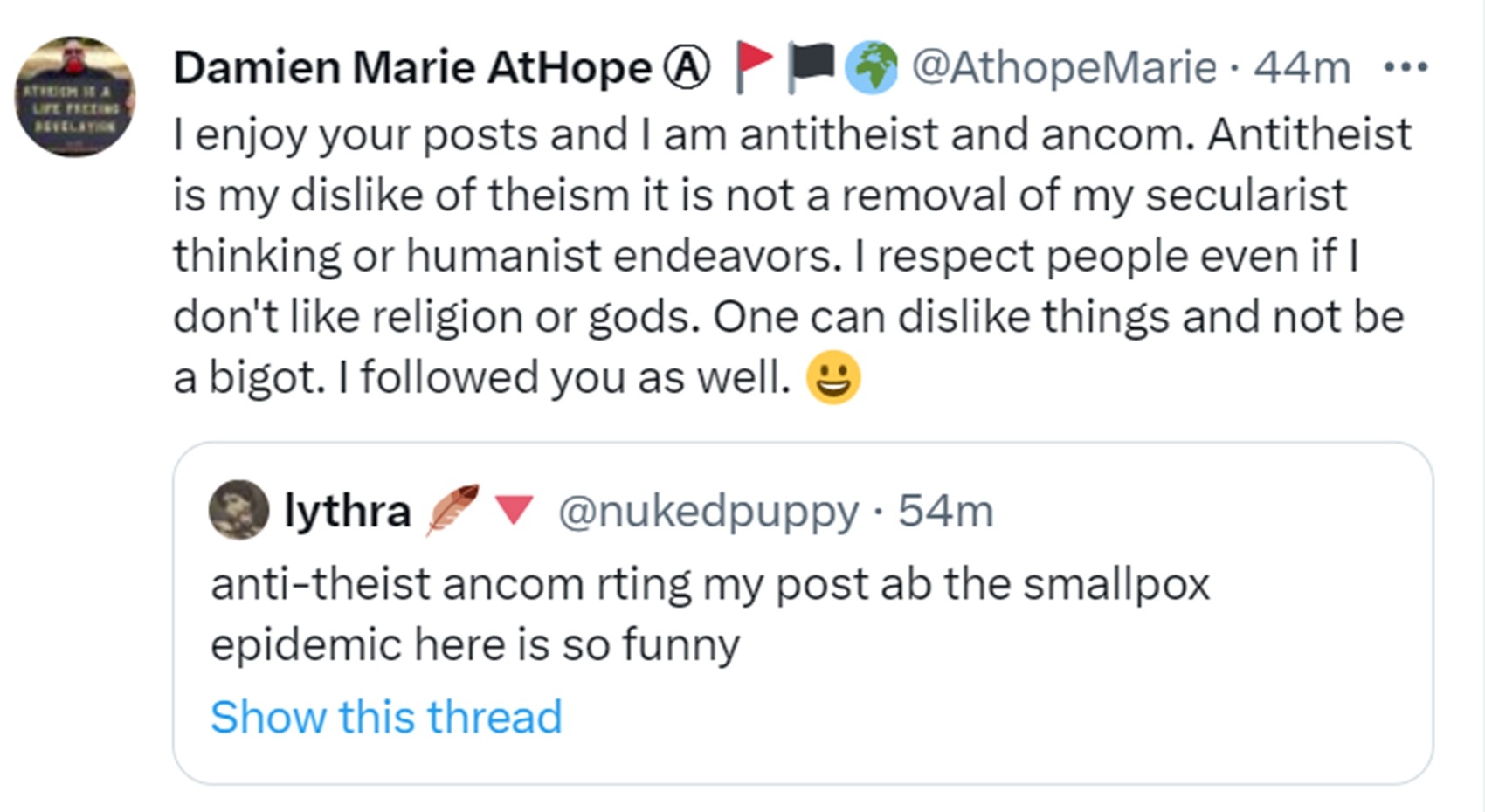
“Anti-theist ancom (Anarchist Communist) rting my post ab the smallpox epidemic here is so funny. Anti-theists would participate in the extortion of the Wei Wai Kai cultural & historical artifacts actually.” – lythra @nukedpuppy
My response, I enjoy your posts and I am an antitheist and ancom. Antitheist is my dislike of theism it is not a removal of my secularist thinking or humanist endeavors. I respect people even if I don’t like religion or gods. One can dislike things and not be a bigot. I followed you as well.
“istg I will never hear a white person say “Kwakiutl” the right way, I’ve seen a lot of videos on general Kwakwaka’wakw history lately & every single white person has pronounced it the same wrong way.” – lythra @nukedpuppy
My response, I hear you and I feel bad as I talk on prehistory a lot and I am terrible at pronouncing names. I wish I was better at saying names correctly. I know it matters and I do try to improve. It would have been better if America was not so bigoted, and used more indigenous words as a rule.
“I’m not bigoted, I just vehemently oppose & demonize a core aspect of your culture.” – lythra @nukedpuppy
My response, I am not opposed to your culture. I am not opposed to someone choosing religion or gods, I do believe in them (people, not their religions or gods) and think religion teaches mythology as truth. I respect people’s rights to beliefs but not that those beliefs have to be respected.
“How anti-theists say this shit seriously is baffling.” – lythra @nukedpuppy
My response, Well it seems many people seem to strawman or be in error what antitheist means and then think this error makes antitheist bad. “Antitheism is the philosophical position that theism should be opposed.” I do oppose gods and theism, I do this by writing thinking about theism.
“Could you explain Ligwilda’xw culture, to me, without the aspect of gods & spirituality?” – lythra @nukedpuppy
My response, So everything in culture is related to religion? Or theism? There are many things in cultures of non-religious or nontheism in cultures that are merged with religion and theism. If I oppose the belief in a religion that is not the same as thinking I want to remove others’ rights.
“Could you explain your fundamental criticisms of the Ligwilda’xw religion?” – lythra @nukedpuppy
My response, I have some knowledge of some Indigenous peoples of the Americas but I don’t know anything about Ligwilda’xw. I am open to learning about it. I don’t attack Indigenous religions, I address beliefs and how I see lots of connections. I see religion as a cultural product, like that of languages.

ref, ref, ref, ref, ref, ref, ref, ref, ref, ref, ref, ref, ref, ref, ref, ref, ref
“These ideas are my speculations from the evidence.”
I am still researching the “god‘s origins” all over the world. So you know, it is very complicated but I am smart and willing to look, DEEP, if necessary, which going very deep does seem to be needed here, when trying to actually understand the evolution of gods and goddesses. I am sure of a few things and less sure of others, but even in stuff I am not fully grasping I still am slowly figuring it out, to explain it to others. But as I research more I am understanding things a little better, though I am still working on understanding it all or something close and thus always figuring out more.
Sky Father/Sky God?
“Egyptian: (Nut) Sky Mother and (Geb) Earth Father” (Egypt is different but similar)
Turkic/Mongolic: (Tengri/Tenger Etseg) Sky Father and (Eje/Gazar Eej) Earth Mother *Transeurasian*
Hawaiian: (Wākea) Sky Father and (Papahānaumoku) Earth Mother *Austronesian*
New Zealand/ Māori: (Ranginui) Sky Father and (Papatūānuku) Earth Mother *Austronesian*
Proto-Indo-European: (Dyḗus/Dyḗus ph₂tḗr) Sky Father and (Dʰéǵʰōm/Pleth₂wih₁) Earth Mother
Indo-Aryan: (Dyaus Pita) Sky Father and (Prithvi Mata) Earth Mother *Indo-European*
Italic: (Jupiter) Sky Father and (Juno) Sky Mother *Indo-European*
Etruscan: (Tinia) Sky Father and (Uni) Sky Mother *Tyrsenian/Italy Pre–Indo-European*
Hellenic/Greek: (Zeus) Sky Father and (Hera) Sky Mother who started as an “Earth Goddess” *Indo-European*
Nordic: (Dagr) Sky Father and (Nótt) Sky Mother *Indo-European*
Slavic: (Perun) Sky Father and (Mokosh) Earth Mother *Indo-European*
Illyrian: (Deipaturos) Sky Father and (Messapic Damatura’s “earth-mother” maybe) Earth Mother *Indo-European*
Albanian: (Zojz) Sky Father and (?) *Indo-European*
Baltic: (Perkūnas) Sky Father and (Saulė) Sky Mother *Indo-European*
Germanic: (Týr) Sky Father and (?) *Indo-European*
Colombian-Muisca: (Bochica) Sky Father and (Huythaca) Sky Mother *Chibchan*
Aztec: (Quetzalcoatl) Sky Father and (Xochiquetzal) Sky Mother *Uto-Aztecan*
Incan: (Viracocha) Sky Father and (Mama Runtucaya) Sky Mother *Quechuan*
China: (Tian/Shangdi) Sky Father and (Dì) Earth Mother *Sino-Tibetan*
Sumerian, Assyrian and Babylonian: (An/Anu) Sky Father and (Ki) Earth Mother
Finnish: (Ukko) Sky Father and (Akka) Earth Mother *Finno-Ugric*
Sami: (Horagalles) Sky Father and (Ravdna) Earth Mother *Finno-Ugric*
Puebloan-Zuni: (Ápoyan Ta’chu) Sky Father and (Áwitelin Tsíta) Earth Mother
Puebloan-Hopi: (Tawa) Sky Father and (Kokyangwuti/Spider Woman/Grandmother) Earth Mother *Uto-Aztecan*
Puebloan-Navajo: (Tsohanoai) Sky Father and (Estsanatlehi) Earth Mother *Na-Dene*
ref, ref, ref, ref, ref, ref, ref, ref, ref, ref, ref, ref, ref, ref, ref, ref, ref, ref, ref, ref, ref, ref, ref, ref, ref, ref, ref
“Mf said I straw-manned, then said this. And how do you define “arcane?” – lythra @nukedpuppy
My response, Thank you for the question. I generally see “arcane” as obscure presently (hard to get information about), not well-known, or mostly forgotten.
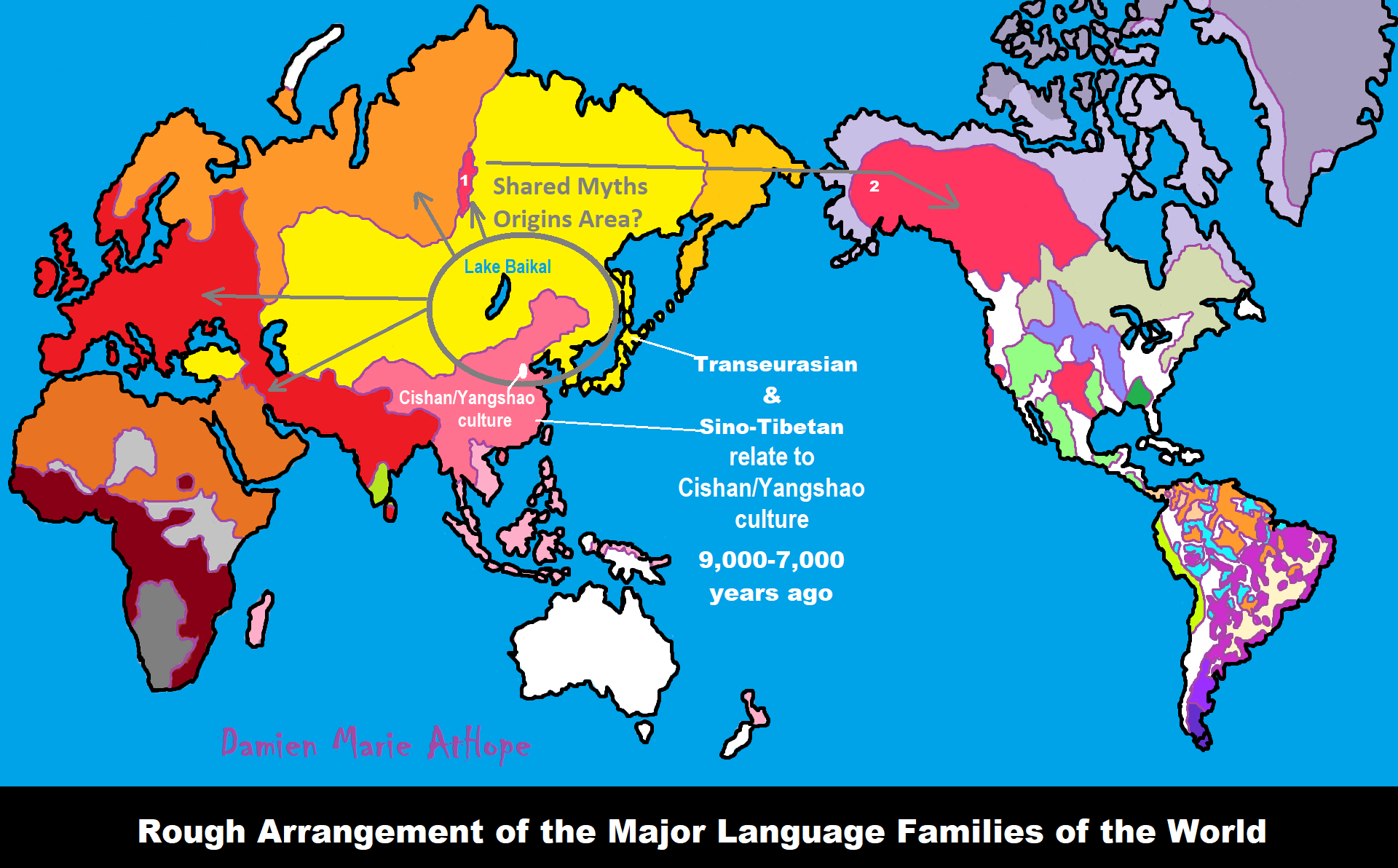
“These ideas are my speculations from the evidence.”
“1 central Eurasian Neolithic individual from Tajikistan (around 8,000 years ago) and approximately 8,200 years ago Yuzhniy Oleniy Ostrov group from Karelia in western Russia formed by 19 genomes affinity to Villabruna ancestry than all the other Eastern Hunter-Gatherer groups” https://www.nature.com/articles/s41586-023-05726-0
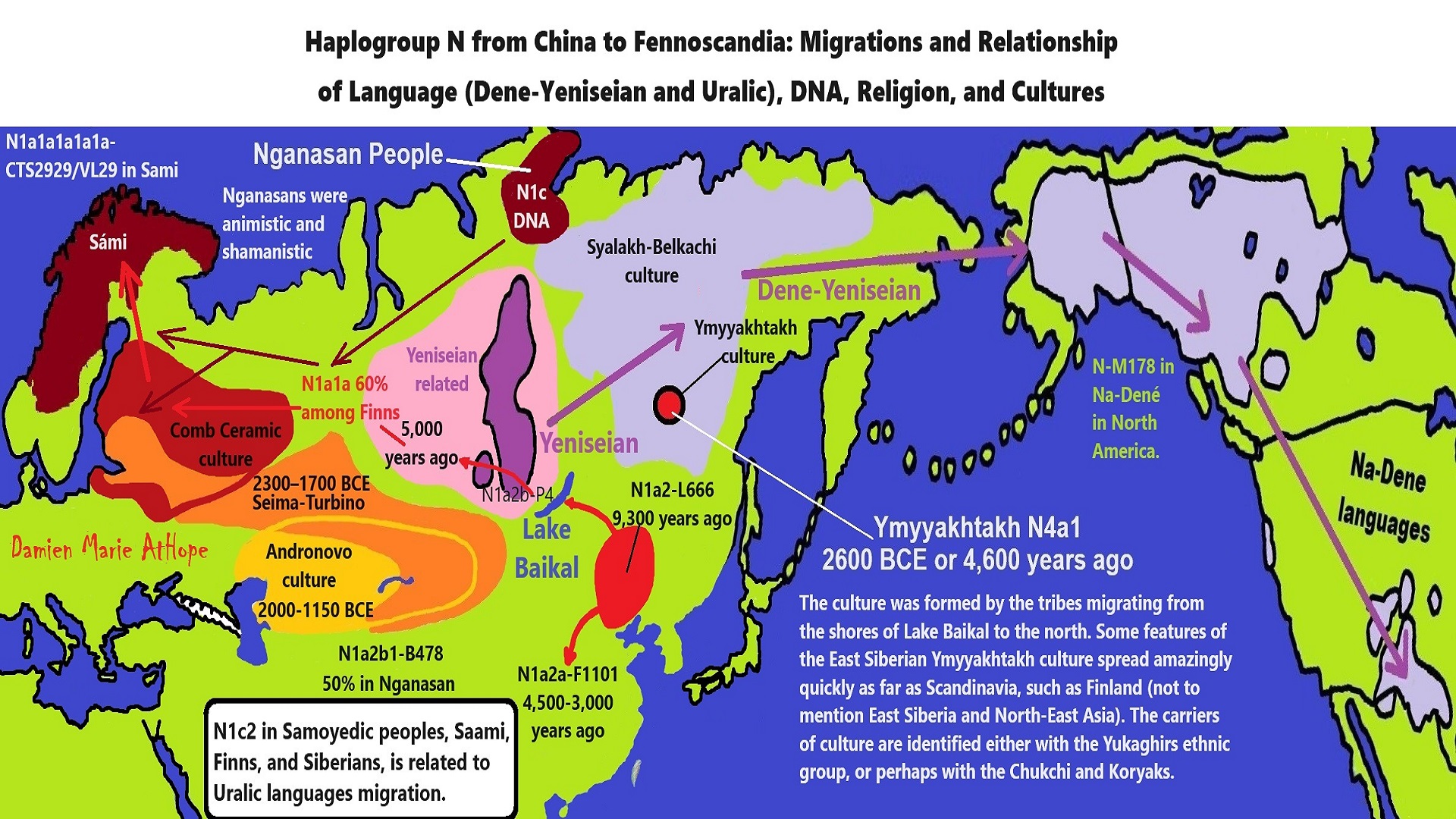
Postglacial genomes from foragers across Northern Eurasia reveal prehistoric
mobility associated with the spread of the Uralic and Yeniseian languages
Abstract
“The North Eurasian forest and forest-steppe zones have sustained millennia of sociocultural connections among northern peoples. We present genome-wide ancient DNA data for 181 individuals from this region spanning the Mesolithic, Neolithic, and Bronze Age. We find that Early to Mid-Holocene hunter-gatherer populations from across the southern forest and forest-steppes of Northern Eurasia can be characterized by a continuous gradient of ancestry that remained stable for millennia, ranging from fully West Eurasian in the Baltic region to fully East Asian in the Transbaikal region. In contrast, cotemporaneous groups in far Northeast Siberia were genetically distinct, retaining high levels of continuity from a population that was the primary source of ancestry for Native Americans. By the mid-Holocene, admixture between this early Northeastern Siberian population and groups from Inland East Asia and the Amur River Basin produced two distinctive populations in eastern Siberia that played an important role in the genetic formation of later people. Ancestry from the first population, Cis-Baikal Late Neolithic-Bronze Age (Cisbaikal_LNBA), is found substantially only among Yeniseian-speaking groups and those known to have admixed with them. Ancestry from the second, Yakutian Late Neolithic-Bronze Age (Yakutia_LNBA), is strongly associated with present-day Uralic speakers. We show how Yakutia_LNBA ancestry spread from an east Siberian origin ~4.5kya, along with subclades of Y-chromosome haplogroup N occurring at high frequencies among present-day Uralic speakers, into Western and Central Siberia in communities associated with Seima-Turbino metallurgy: a suite of advanced bronze casting techniques that spread explosively across an enormous region of Northern Eurasia ~4.0kya. However, the ancestry of the 16 Seima-Turbino-period individuals–the first reported from sites with this metallurgy–was otherwise extraordinarily diverse, with partial descent from Indo-Iranian-speaking pastoralists and multiple hunter-gatherer populations from widely separated regions of Eurasia. Our results provide support for theories suggesting that early Uralic speakers at the beginning of their westward dispersal where involved in the expansion of Seima-Turbino metallurgical traditions, and suggests that both cultural transmission and migration were important in the spread of Seima-Turbino material culture.” ref

Dené–Yeniseian languages
“Dené–Yeniseian is a proposed language family consisting of the Yeniseian languages of central Siberia and the Na-Dené languages of northwestern North America. Reception among experts has been somewhat favorable; thus, Dené–Yeniseian has been called “the first demonstration of a genealogical link between Old World and New World language families that meets the standards of traditional comparative–historical linguistics“, besides the Eskaleut languages spoken in far eastern Siberia and North America.” ref
“In his 2012 presentation, Vajda also addressed non-linguistic evidence, including analyses of Y-chromosome and mitochondrial DNA haplogroups, which are passed unchanged down the male and female lines, respectively, except for mutations. His most compelling DNA evidence is the Q1 Y-chromosomal haplogroup subclade, which he notes arose c. 15,000 years ago and is found in nearly all Native Americans and nearly all of the Yeniseian Ket people (90%), but almost nowhere else in Eurasia except for the Selkup people (65%), who have intermarried with the Ket people for centuries. In his 2012 reply to George Starostin, Vajda clarifies that Dené-Yeniseian “as it currently stands is a hypothesis of language relatedness but not yet a proper hypothesis of language taxonomy”. He leaves “open the possibility that either Yeniseian or ND (or both) might have a closer relative elsewhere in Eurasia.” ref
“Using this and other evidence, he proposes a Proto-Dené-Yeniseian homeland located in eastern Siberia around the Amur and Aldan Rivers. These people would have been hunter-gatherers, as are the modern Yeniseians, but unlike, as Vajda incorrectly claims, nearly all other Siberian groups (except for some Paleosiberian peoples located around the Pacific Rim of far eastern Siberia, who appear genetically unrelated to the Yeniseians). Eventually all descendants in Eurasia were eliminated by the spread of reindeer-breeding pastoralist peoples (e.g. the speakers of the so-called Altaic languages) except for the modern Yeniseians, who were able to survive in swampy refuges far to the west along the Yenisei River because it is too mosquito-infested for reindeer to survive easily. Contrarily, the caribou (the North American reindeer population) were never domesticated, and thus the modern Na-Dené people were not similarly threatened. In fact, reindeer herding spread throughout Siberia rather recently and there were many other hunter-gatherer peoples in Siberia in modern times.” ref
“Instead of forming a separate family, Starostin believes that both Yeniseian and Na-Dené are part of a much larger grouping called Dene-Caucasian. Starostin states that the two families are related in a large sense, but there is no special relationship between them that would suffice to create a separate family between these two language families. In 2015, linguist Paul Kiparsky endorsed Dené–Yeniseian, saying that “the morphological parallelism and phonological similarities among corresponding affixes is most suggestive, but most compelling evidence for actual relationship comes from those sound correspondences which can be accounted for by independently motivated regular sound changes.” ref
“The Dene-Yeniseian hypothesis regards the Ket language spoken in the Yenisei River Basin as genetically related to the widespread Na-Dene language family in North America. Na-Dene comprises Tlingit and the recently extinct Eyak in Alaska, along with over thirty Athabaskan languages spoken from the western North American Subarctic to pockets in California (Hupa), Oregon (Tolowa) and the American Southwest (Navajo, Apache) (Krauss 1976). Pre-Proto-Na-Dene is believed to have spread from Alaska ca. 3000-2500 BCE.” ref
“Sampled Ancient Athabaskans from Alaska (ca. CE 1200) show a 30-40% contribution from Paleo-Eskimo ancestry – complementing the pre-existing ancestry of Northern First Peoples – in an admixture event estimated to have happened roughly during the formation of the Proto-Na-Dene community. To complicate things, these two Ancient Athabascan samples (together with a 19th-century one of hg. Q1b-Y4276) suggest a Y-chromosome bottleneck under Q1b-FGC8436 lineages, in common with an ancient sample (ca. AD 880) from a likely Uto-Aztecan-speaking population from San Nicolas Island, in California.” ref
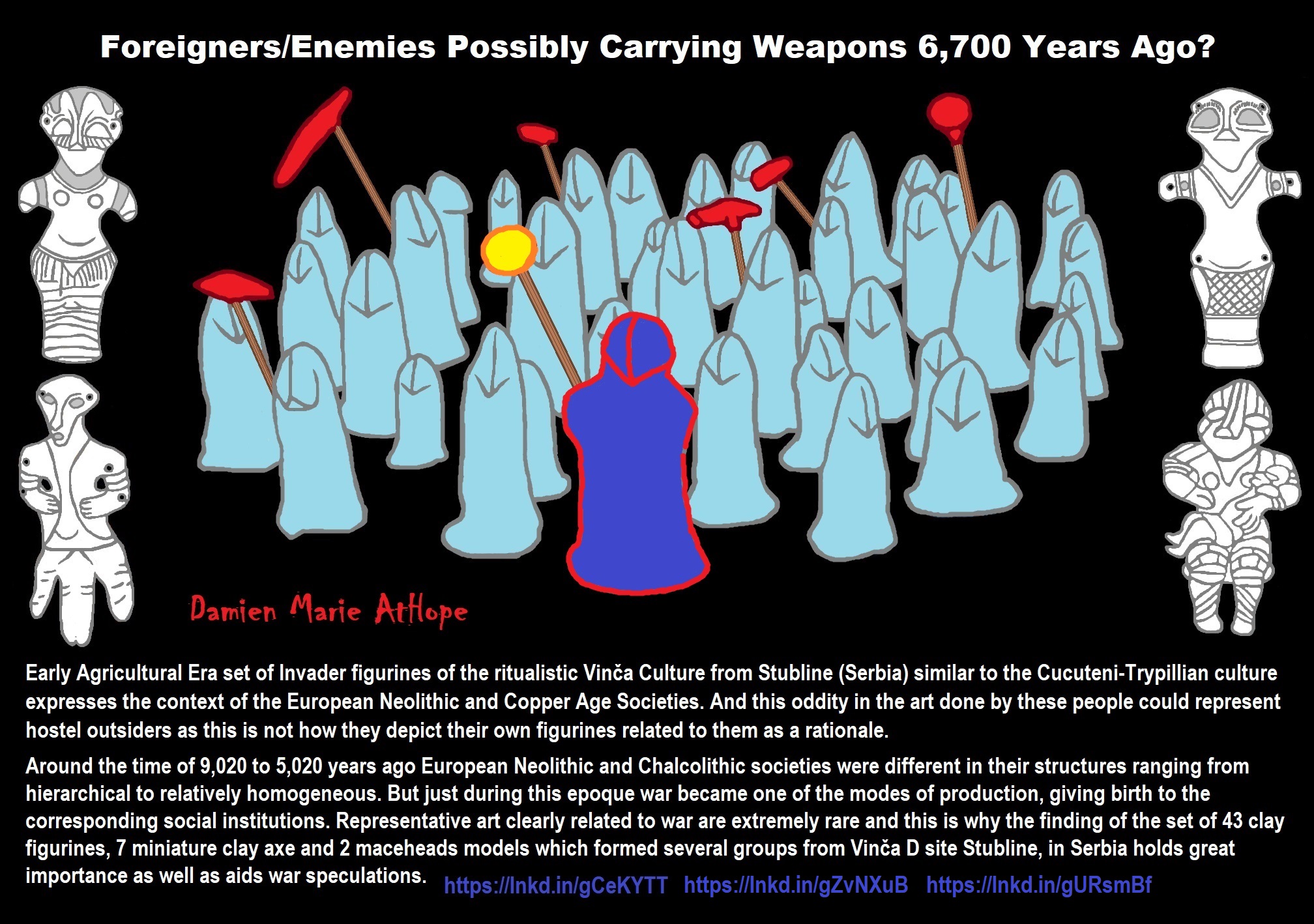
The art above is from the blog post: What is a god? Just an Empty Label.
“War became one of the modes of production during that epoch”, this is very good to know. Thank you. And lovely work. I really like the depiction of the warriors. It’s very thought-provoking and insightful.” – Commenter
My response, Those are my art of clay figurines found. Did you like the blog post, I explained a lot?
“I just clicked through just now. Wow! The effort you’ve put in is overpowering. And inspiring! I’ll be sure to start my reading with this post. And explore the rest as time permits. Thank you.” – Commenter
My response, I am honored. We rise by helping each other.
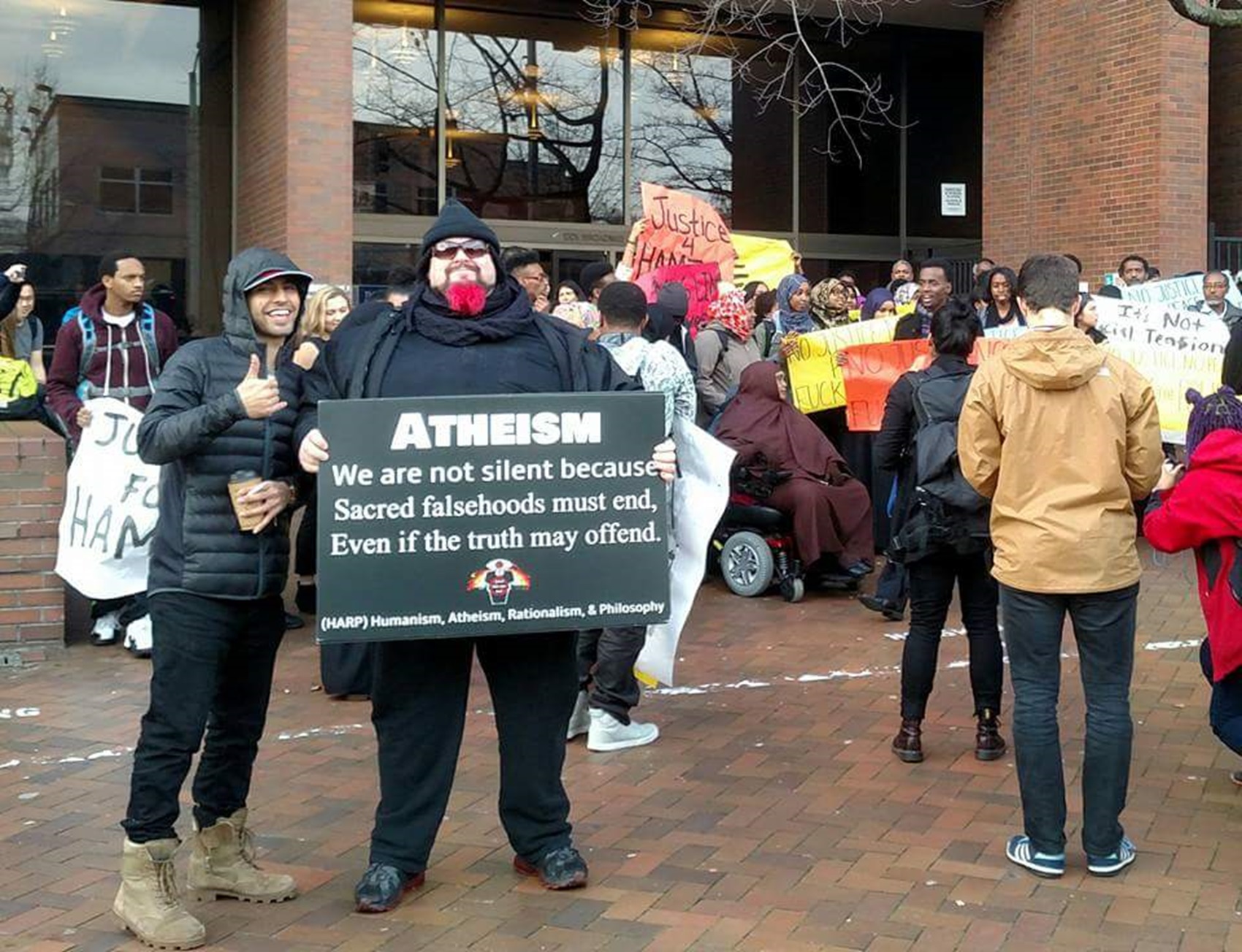
Here is me doing antitheism in public. I used to do a little atheism activism out on the street.
Religion: “Sacred Falsehoods” (untrue statements)
“How do you respond when someone condescendingly says, ‘I will pray for you’?” – Questioner
My response, I sometimes say, “Don’t waste your prayers on me, pray for all the children starving throughout the world, that your “God” seems to not care about.”
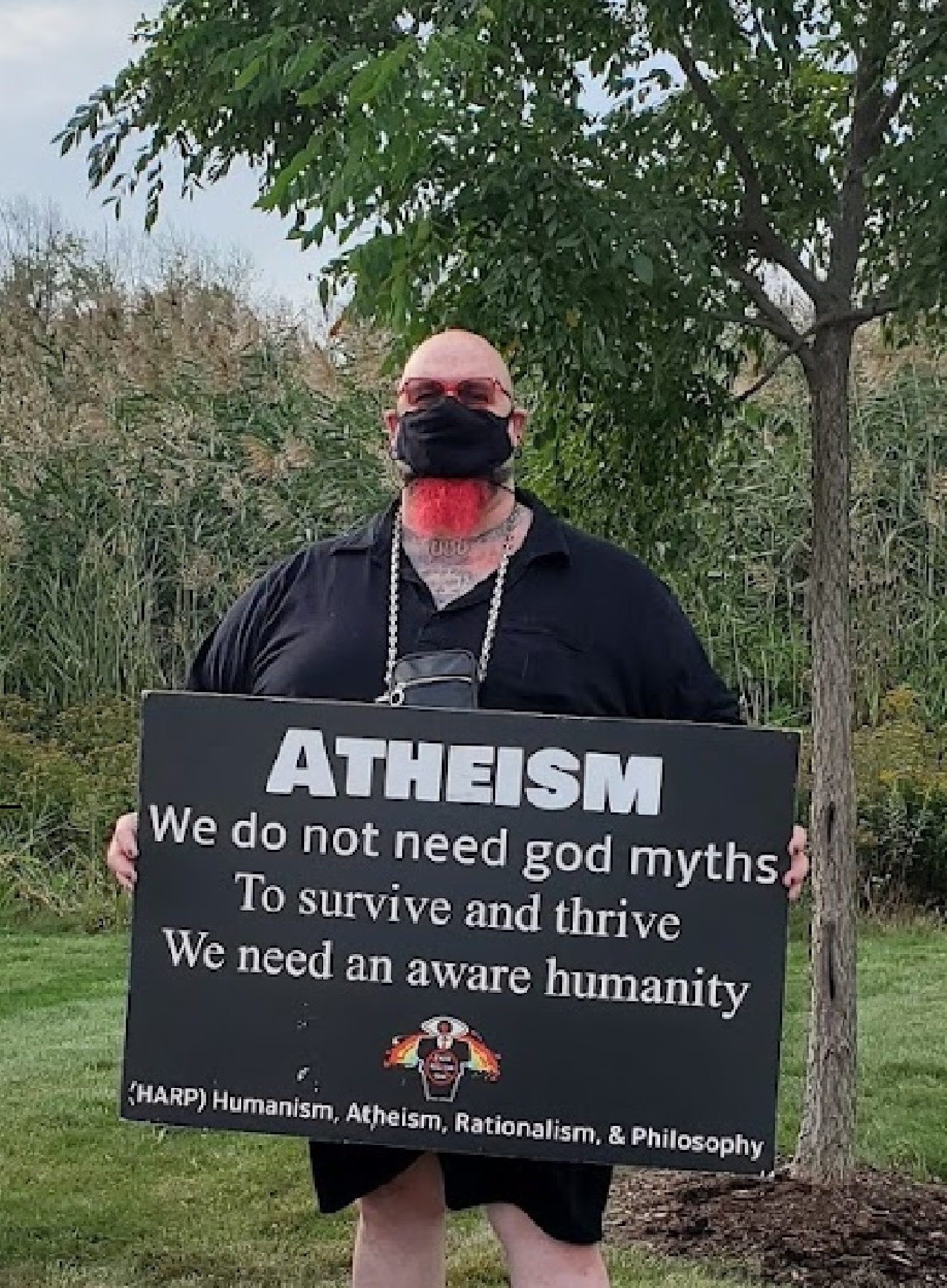
“Damien, you seem to think god is antiscience but we did call the Higgs Boson the God particle?” – Commenter
My response, The media called it that, it is not somehow proof of anything, but human superstitious language is still used because of religions giving evidenceless terms meaning they don’t deserve.

“Damian, do people from the opposite opinion talk to you?”
My response, I don’t challenge people who believe unless they claim true or ask me a question. I attack thinking not people. I just sit there with a sign and let others come to me, which they do. In all kinds of ways. It is like 80% of the people who try to talk to you during atheist activism are theists.
“Damien, what has come of your atheist activism?”
My response, I have had people lose faith, doubt their faith, still think they will use faith, or a few seemed to want to clutch faith harder. Most people who talk with me for a while, start thinking more before leaving me. I use the Hammer of Truth questions (Hammer of Truth: Investigate (ONTOLOGY), Expose (EPISTEMOLOGY), and Judge (AXIOLOGY)) to show errors in thinking and help others think better.
I don’t see religious terms like Animism, Totemism, Shamanism, or Paganism as primitive, but original or core elements that are different parts of world views and their supernatural/non-natural beliefs or thinking. I see all religions as having shared or similar features or core elements that relate to religious terms Animism, Totemism, Shamanism, or Paganism including Abrahamic (Judaism, Christianity, or Islam) religious thinking. I don’t class any religious thinking as primitive but in error to what I see as a natural-only world, that religious thinking then makes up a myriad of non-natural/non-empirical themes/beings, stories, and myths about which group together are called religions.
I was asked what is my favorite putdown of religious believers. Well, I don’t worry about putting anyone down, my goal is to offer info to challenge what believers think they know, hoping to change their minds. Truth rather than some fixed thing is at times but a guess, later shown accurate thus labeled knowledge or possibly seen as wrong in the sunlight of new information, requiring correction.
As an atheist, I don’t believe in gods, as an antitheist I oppose theism, and as an antireligionist, I oppose religions.
“Oppose: disapprove of and attempt to prevent, especially by argument.”
I am intelligent but don’t use it against people as some seem to do,
rather I strive to use my abilities to empower others.
I want to make a difference in the world if I can.

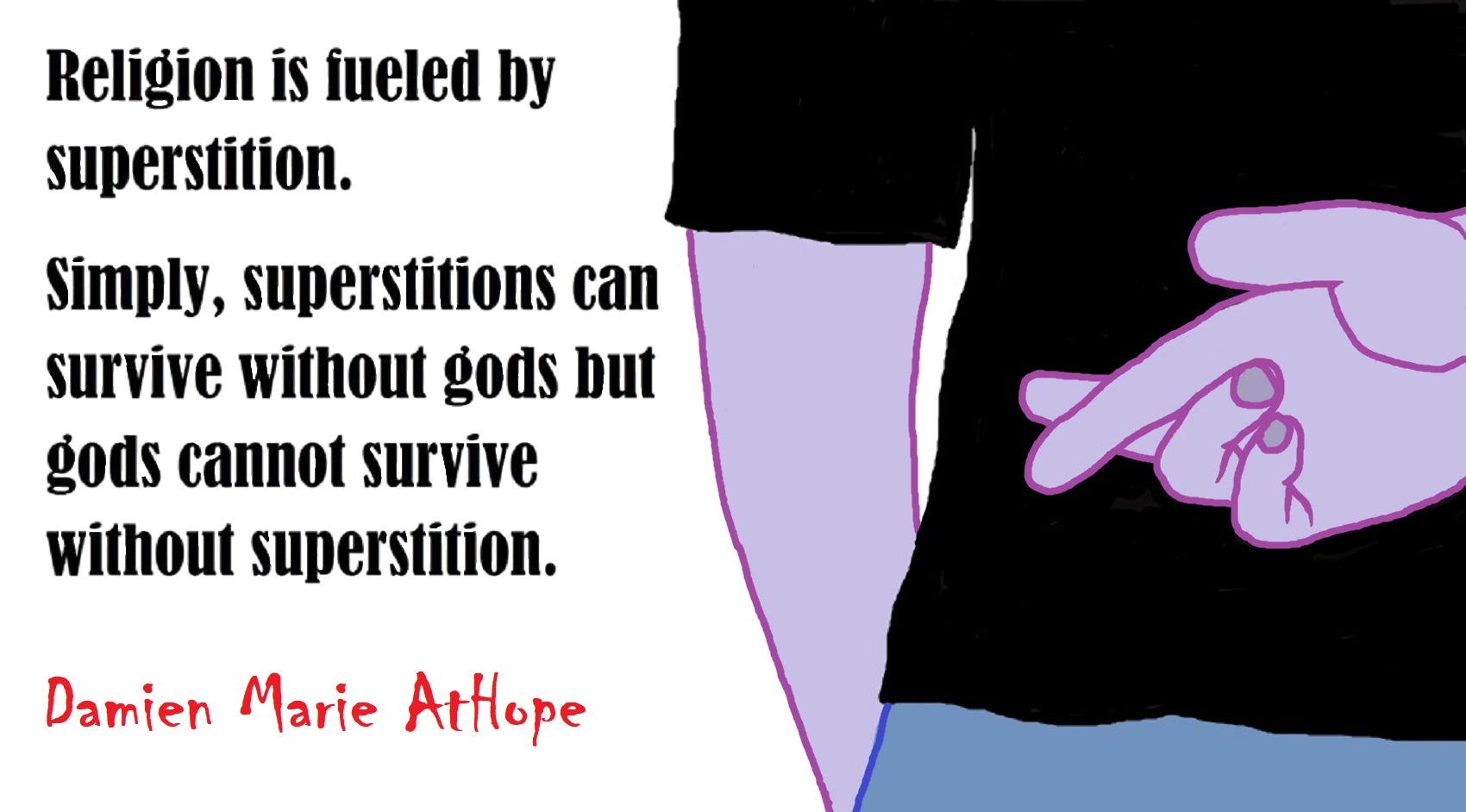
“Did you ever try to understand religion? Did you ever try to find superstition in it? I am tired of “atheists” giving childish descriptions of faith.” – Angel de Plata@toyman0806@mastodon.social
My response, I am more informed about religion than most people. If you want to understand what I know about religion you can check out my blog post: An Archaeological/Anthropological Understanding of Religion Evolution
My response, Please feel free to give what you see as a non-childish version of faith. “Faith: a firm belief in something for which there is no proof.” If you support faith: What makes faith reasonable or unreasonable, valuable or disvaluable, and how do you navigate between contradictory faith assumptions?
My response, “A superstition is any belief or practice considered by non-practitioners to be irrational or supernatural, attributed to fate or magic, perceived supernatural influence, or fear of that which is unknown. The word superstition is also used to refer to a religion not practiced by the majority of a given society regardless of whether the prevailing religion contains alleged superstitions or to all religions by the antireligious. The Oxford English Dictionary describes them as “irrational, unfounded”, Merriam-Webster as “a false conception about causation or belief or practice. Stuart Vyse proposes that a superstition’s “presumed mechanism of action is inconsistent with our understanding of the physical world”, and Dale Martin says they “presuppose an erroneous understanding about cause and effect, that have been rejected by modern science.” Both Vyse and Martin argue that what is considered superstitious varies across cultures and time. For Vyse, “if a culture has not yet adopted science as its standard, then what we consider magic or superstition is more accurately the local science or religion. Vyse proposes that in addition to being irrational and culturally dependent, superstitions have to be instrumental; an actual effect is expected by the person holding a belief.” ref
“Religious practices that differ from commonly accepted religions in a given culture are sometimes called superstitious; similarly, new practices brought into an established religious community can also be labeled as superstitious in an attempt to exclude them. Also, an excessive display of devoutness has often been labeled as superstitious behavior. According to Michael David Bailey, it was with Pliny’s usage that Magic came close to superstition; and charges of being superstitious were first leveled by Roman authorities on their Christian subjects. In turn, early Christian writers pronounced all Roman and Pagan cults to be superstitious, worshipping false Gods, fallen angels, and demons. It is with Christian usage that almost all forms of magic started being described as forms of superstition. In the classical era, the existence of gods was actively debated both among philosophers and theologians, and opposition to superstition arose consequently. From a simpler perspective, natural selection will tend to reinforce a tendency to generate weak associations or heuristics that are overgeneralized. If there is a strong survival advantage to making correct associations, then this will outweigh the negatives of making many incorrect, “superstitious” associations. It has also been argued that there may be connections between OCD and superstition. It is stated that superstition is at the end of the day long-held beliefs that are rooted in coincidence and/or cultural tradition rather than logic and facts.” ref
“How interesting. I just translated from English to Russian the book of Randall Price on archaeology. He is a Christian, archaeologist, and professor of archaeology at university (don’t remember what university, Wikipedia knows). I know that there are several schools of thought in modern archaeology and I am not impressed with high criticism. I can’t say much about anthropology, I haven’t met a good scholar in that field. Sorry, I don’t have time to watch your video.” – Angel de Plata@toyman0806@mastodon.social
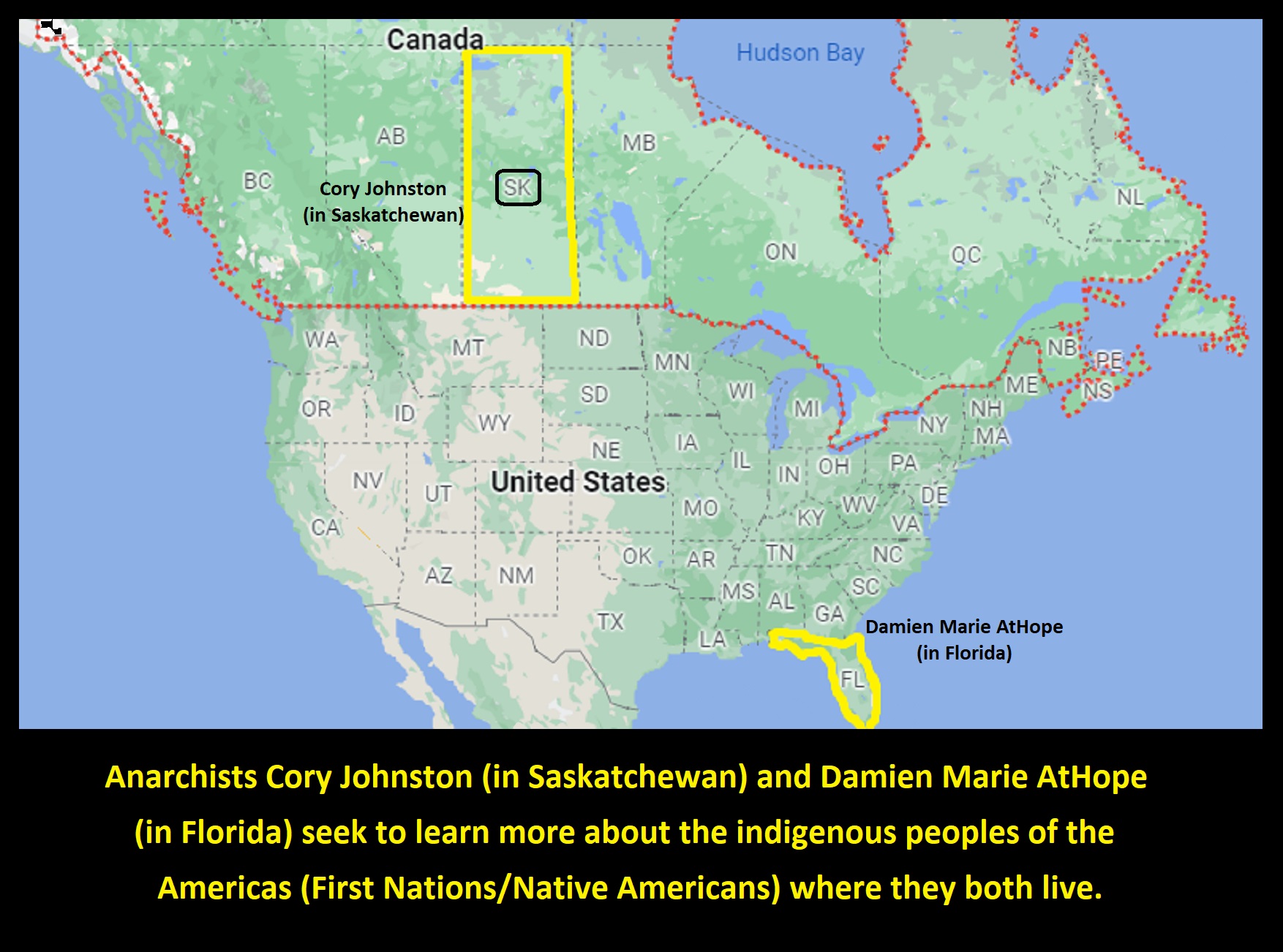
Laich-kwil-tach
“Laich-kwil-tach (also spelled Ligwilda’xw), is the Anglicization of the Kwak’wala autonomy by the “Southern Kwakiutl” people of Quadra Island and Campbell River in British Columbia, Canada. There are today two main groups (of perhaps five original separate groups): the Wei Wai Kai (Cape Mudge Band) and Wei Wai Kum just across on the Vancouver Island “mainland” in the town of Campbell River. In addition to these two main groups there are the Kwiakah (Kwiakah Band / Kwiakah First Nation) originally from Phillips Arm and Frederick Arm and the Discovery Islands, the Tlaaluis (Laa’luls) between Bute and Loughborough Inlets—after a great war between the Kwakiutl and the Salish peoples they were so reduced in numbers that they joined the Kwiakah—and the Walitsima / Walitsum Band of Salmon River (also called Hahamatses or Salmon River Band).” ref
“So great was the power of the Southern Kwakiutl that the Comox people of the Courtenay–Comox came to speak Kwak’wala instead of K’omox, which today remains spoken by their kin the Sliammon and Homalhko on the other side of Georgia Strait around Powell River. Many of the Wewaykum in Campbell River are of Comox descent, while the Weewaikai of the Cape Mudge Band retain noble lineages and ceremonies going back centuries to their roots in the Queen Charlotte Strait. The great potlatches of the Cape Mudge chiefs are celebrated in the book Chiefly Feasts: The Enduring Kwakiutl Potlatch (A. Donaitis, U. Wash Press).” ref
“The Southern Kwakiutl remain politically separate from their distant kin, the Kwakwaka’wakw, whose name means speakers of Kwak’wala who remained in the Queen Charlotte Strait. The Kwagu’ł or Northern Kwakiutl of Fort Rupert are more closely allied and related to the Southern Kwakiutl than are the Kwakwaka’wakw. The term “Kwakiutl” has different political and historical associations with each of these groups, and has associations with one band in particular over all others, which is one reason why Kwakwaka’wakw evolved as the collective name for the main group of Queen Charlotte Strait Kwak’wala-speakers. The Southern Kwakiutl have always called themselves Laich-kwil-tach, at least since moving into the Georgia Strait.” ref
“Laich-kwil-tach raids on the southern Georgia Strait, Puget Sound, and even up the Fraser River and out into the Strait of Juan de Fuca, and northwards, are described in the annals of the early non-First Nations explorers and traders. There was one notable incident shortly after the founding of Fort Langley in which the Hudson’s Bay Company (HBC) staff repelled a siege by the Euclataws (i.e. the Laich-kwil-tach) with cannonades (much earning the appreciation of the beleaguered local Kwantlens). Despite the presence of Fort Langley the Laich-kwil-tach continued to raid other Sto:lo communities farther up the river.” ref
“The Kwakwa̱ka̱ʼwakw (IPA: [ˈkʷakʷəkʲəʔwakʷ]), also known as the Kwakiutl (/ˈkwɑːkjʊtəl/; “Kwakʼwala-speaking peoples”), are one of the indigenous peoples of the Pacific Northwest Coast. Their current population, according to a 2016 census, is 3,665. Most live in their traditional territory on northern Vancouver Island, nearby smaller islands including the Discovery Islands, and the adjacent British Columbia mainland. Some also live outside their homelands in urban areas such as Victoria and Vancouver. They are politically organized into 13 band governments. Their language, now spoken by only 3.1% of the population, consists of four dialects of what is commonly referred to as Kwakʼwala. These dialects are Kwak̓wala, ʼNak̓wala, G̱uc̓ala and T̓łat̓łasik̓wala.” ref
“The name Kwakiutl derives from Kwaguʼł—the name of a single community of Kwakwa̱ka̱ʼwakw located at Fort Rupert. The anthropologist Franz Boas had done most of his anthropological work in this area and popularized the term for both this nation and the collective as a whole. The term became misapplied to mean all the nations who spoke Kwakʼwala, as well as three other Indigenous peoples whose language is a part of the Wakashan linguistic group, but whose language is not Kwakʼwala. These peoples, incorrectly known as the Northern Kwakiutl, were the Haisla, Wuikinuxv, and Heiltsuk. Each Kwakwa̱ka̱ʼwakw nation has its own clans, chiefs, history, culture, and peoples, but remains collectively similar to the rest of the Kwak̓wala-Speaking nations.” ref
“Many people who others call “Kwakiutl” consider that name a misnomer. They prefer the name Kwakwa̱ka̱ʼwakw, which means “Kwakʼwala-speaking-peoples”. One exception is the Laich-kwil-tach at Campbell River—they are known as the Southern Kwakiutl, and their council is the Kwakiutl District Council. Kwakwa̱ka̱ʼwakw oral history says their ancestors (ʼnaʼmima) came in the forms of animals by way of land, sea, or underground. When one of these ancestral animals arrived at a given spot, it discarded its animal appearance and became human. Animals that figure in these origin myths include the Thunderbird, his brother Kolas, the seagull, orca, grizzly bear, or chief ghost. Some ancestors have human origins and are said to come from distant places.” ref
“Historically, the Kwakwa̱ka̱ʼwakw economy was based primarily on fishing, with the men also engaging in some hunting, and the women gathering wild fruits and berries. Ornate weaving and woodwork were important crafts, and wealth, defined by slaves and material goods, was prominently displayed and traded at potlatch ceremonies. These customs were the subject of extensive study by the anthropologist Franz Boas. In contrast to most non-native societies, wealth and status were not determined by how much you had, but by how much you had to give away. This act of giving away your wealth was one of the main acts in a potlatch.” ref
“The first documented contact with Europeans was with Captain George Vancouver in 1792. Disease, which developed as a result of direct contact with European settlers along the West Coast of Canada, drastically reduced the Indigenous Kwakwa̱ka̱ʼwakw population during the late 19th-early 20th century. Kwakwa̱ka̱ʼwakw population dropped by 75% between 1830 and 1880. The 1862 Pacific Northwest smallpox epidemic alone killed over half of the people. Kwakwa̱ka̱ʼwakw dancers from Vancouver Island performed at the 1893 World’s Columbian Exposition in Chicago.” ref
“An account of experiences of two founders of early residential schools for Aboriginal children was published in 2006 by the University of British Columbia Press. Good Intentions Gone Awry – Emma Crosby and the Methodist Mission On the Northwest Coast by Jan Hare and Jean Barman contains the letters and account of the life of the wife of Thomas Crosby the first missionary in Lax Kwʼalaams (Port Simpson). This covers the period from 1870 to the turn of the 20th century.” ref
“A second book was published in 2005 by the University of Calgary Press, The Letters of Margaret Butcher – Missionary Imperialism on the North Pacific Coast edited by Mary-Ellen Kelm. It picks up the story from 1916 to 1919 in Kitamaat Village and details of Butcher’s experiences among the Haisla people. A review article entitled Mothers of a Native Hell about these two books was published in the British Columbia online news magazine The Tyee in 2007.” ref
“Restoring their ties to their land, culture and rights, the Kwakwa̱ka̱ʼwakw have undertaken much in bringing back their customs, beliefs and language. Potlatches occur more frequently as families reconnect to their birthright, and the community uses language programs, classes and social events to restore the language. Artists in the 19th and 20th centuries, such as Mungo Martin, Ellen Neel, and Willie Seaweed have taken efforts to revive Kwakwakaʼwakw art and culture.” ref
“Kwakwa̱ka̱ʼwakw kinship is based on a bilinear structure, with loose characteristics of a patrilineal culture. It has large extended families and interconnected community life. The Kwakwa̱ka̱ʼwakw are made up of numerous communities or bands. Within those communities they are organized into extended family units or naʼmima, which means ‘of one kind’. Each naʼmima had positions that carried particular responsibilities and privileges. Each community had around four naʼmima, although some had more, some had less.” ref
“Kwakwa̱ka̱ʼwakw follow their genealogy back to their ancestral roots. A head chief who, through primogeniture, could trace his origins to that naʼmima‘s ancestors delineated the roles throughout the rest of his family. Every clan had several sub-chiefs, who gained their titles and position through their own family’s primogeniture. These chiefs organized their people to harvest the communal lands that belonged to their family.” ref
“Kwakwa̱ka̱ʼwakw society was organized into four classes: the nobility, attained through birthright and connection in lineage to ancestors, the aristocracy who attained status through connection to wealth, resources or spiritual powers displayed or distributed in the potlatch, commoners, and slaves. On the nobility class, “the noble was recognized as the literal conduit between the social and spiritual domains, birthright alone was not enough to secure rank: only individuals displaying the correct moral behavior [sic] throughout their life course could maintain ranking status.” ref
“As in other Northwest Coast peoples, the concept of property was well developed and important to daily life. Territorial property such as hunting or fishing grounds was inherited, and from these properties material wealth was collected and stored. A trade and barter subsistence economy formed the early stages of the Kwakwa̱ka̱ʼwakw economy. Trade was carried out between internal Kwakwakaʼwakw nations, as well as surrounding Indigenous nations such as the Tsimshian, Tlingit, the Nuu-chah-nulth, and Coast Salish peoples.” ref
“Over time, the potlatch tradition created a demand for stored surpluses, as such a display of wealth had social implications. By the time of European colonialism, it was noted that wool blankets had become a form of common currency. In the potlatch tradition, hosts of the potlatch were expected to provide enough gifts for all the guests invited. This practice created a system of loan and interest, using wool blankets as currency. As with other Pacific Northwest nations, the Kwakwa̱ka̱ʼwakw highly valued copper in their economy and used it for ornament and precious goods.” ref
“Scholars have proposed that prior to trade with Europeans, the people acquired copper from natural copper veins along riverbeds, but this has not been proven. Contact with European settlers, particularly through the Hudson’s Bay Company, brought an influx of copper to their territories. The Kwakwa̱ka̱ʼwakw nations also were aware of silver and gold, and crafted intricate bracelets and jewellery from hammered coins traded from European settlers. Copper was given a special value amongst the Kwakwa̱ka̱ʼwakw, most likely for its ceremonial purposes. This copper was beaten into sheets or plates, and then painted with mythological figures. The sheets were used for decorating wooden carvings or kept for the sake of prestige.” ref
“Individual pieces of copper were sometimes given names based on their value. The value of any given piece was defined by the number of wool blankets last traded for them. In this system, it was considered prestigious for a buyer to purchase the same piece of copper at a higher price than it was previously sold, in their version of an art market. During potlatch, copper pieces would be brought out, and bids were placed on them by rival chiefs. The highest bidder would have the honor of buying said copper piece. If a host still held a surplus of copper after throwing an expensive potlatch, he was considered a wealthy and important man. Highly ranked members of the communities often have the Kwakʼwala word for “copper” as part of their names.” ref
“Copper’s importance as an indicator of status also led to its use in a Kwakwa̱ka̱ʼwakw shaming ritual. The copper cutting ceremony involved breaking copper plaques. The act represents a challenge; if the target cannot break a plaque of equal or greater value, he or she is shamed. The ceremony, which had not been performed since the 1950s, was revived by chief Beau Dick in 2013, as part of the Idle No More movement. He performed a copper cutting ritual on the lawn of the British Columbia Legislature on February 10, 2013, to ritually shame the Stephen Harper government.” ref
“The Kwakwa̱ka̱ʼwakw are a highly stratified bilineal culture of the Pacific Northwest. They are many separate nations, each with its own history, culture and governance. The Nations commonly each had a head chief, who acted as the leader of the nation, with numerous hereditary clan or family chiefs below him. In some of the nations, there also existed Eagle Chiefs, but this was a separate society within the main society and applied to the potlatching only.” ref
“The Kwakwa̱ka̱ʼwakw are one of the few bilineal cultures. Traditionally the rights of the family would be passed down through the paternal side, but in rare occasions, the rights could pass on the maternal side of their family also. Within the pre-colonization times, the Kwakwa̱ka̱ʼwakw were organized into three classes: nobles, commoners, and slaves. The Kwakwa̱ka̱ʼwakw shared many cultural and political alliances with numerous neighbors in the area, including the Nuu-chah-nulth, Heiltsuk, Wuikinuxv, and some Coast Salish.” ref
“The Kwakʼwala language is a part of the Wakashan language group. Word lists and some documentation of Kwakʼwala were created from the early period of contact with Europeans in the 18th century, but a systematic attempt to record the language did not occur before the work of Franz Boas in the late 19th and early 20th century. The use of Kwakʼwala declined significantly in the 19th and 20th centuries, mainly due to the assimilationist policies of the Canadian government. Kwakwa̱ka̱ʼwakw children were forced to attend residential schools, which enforced English use and discouraged other languages. Although Kwakʼwala and Kwakwa̱ka̱ʼwakw culture have been well-studied by linguists and anthropologists, these efforts did not reverse the trends leading to language loss. According to Guy Buchholtzer, “The anthropological discourse had too often become a long monologue, in which the Kwakwa̱ka̱ʼwakw had nothing to say.” ref
“As a result of these pressures, there are relatively few Kwakʼwala speakers today. Most remaining speakers are past the age of child-rearing, which is considered a crucial stage for language transmission. As with many other Indigenous languages, there are significant barriers to language revitalization. Another barrier separating new learners from the native speaker is the presence of four separate orthographies; the young are taught Uʼmista or NAPA, while the older generations generally use Boaz, developed by the American anthropologist Franz Boas. A number of revitalization efforts are underway. A 2005 proposal to build a Kwakwakaʼwakw First Nations Centre for Language Culture has gained wide support. A review of revitalization efforts in the 1990s showed that the potential to fully revitalize Kwakʼwala still remained, but serious hurdles also existed.” ref

What branch of Judaism are you or were you? I was a Christian but am now an atheist. lol
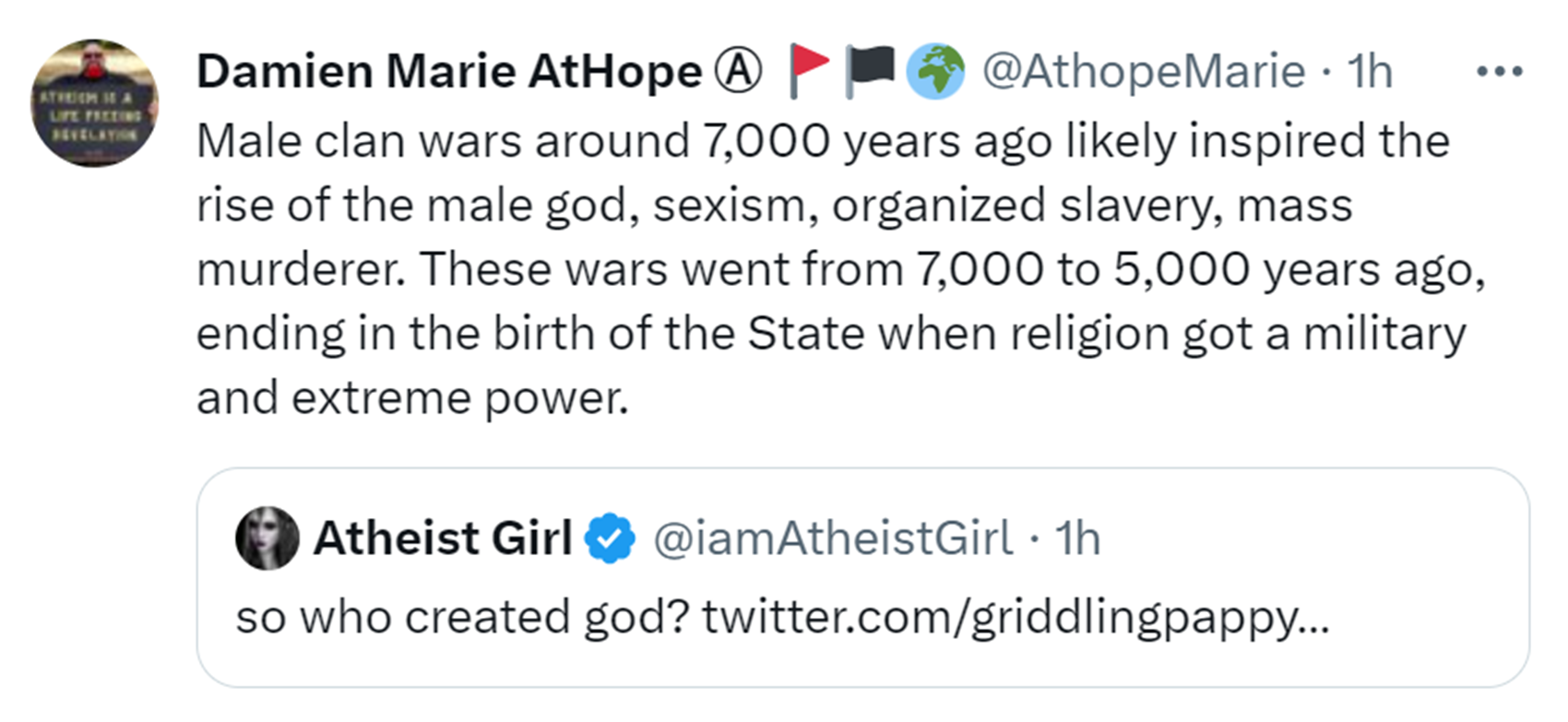
“So, who created god?” – Atheist Girl @iamAtheistGirl
My response, Male clan wars around 7,000 years ago likely inspired the rise of the male god, sexism, organized slavery, and mass murder. These wars went from 7,000 to 5,000 years ago, ending in the birth of the State when religion got a military and extreme power.
Anarchist Schools/Anarchist Education?
“In 1904, the anarchist activist Francisco Ferrer established the Escuela Moderna (Modern School) in Barcelona. In the school’s prospectus, he declared: ‘I will teach them only the simple truth. I will not ram a dogma into their heads. I will not conceal from them one iota of fact. I will teach them not what to think but how to think’.” ref

My response, Religion, to me, started in Animism around 100,000 years ago. Animism is basically the belief that non-alive things have lifelike qualities/spirits and are therefore maybe capable of having feelings, intentions, and emotions.

In a general way, it all starts with Animism (a theoretical belief in supernatural powers/spirits) and this is physically expressed in or with Totemism (a theoretical belief in a mythical relationship with powers/spirits through a totem item), which then enlists a full-time specific person to perform this worship and believed interaction as Shamanism (a theoretical belief in access and influence with spirits through rituals). In addition, there is the further employment of myths and gods added to all the above, which is Paganism and is often a lot more nature-based than most current top world religions, thus hinting to their close link to more ancient religious thinking from which it stems.
My hypothesis is expressed with an explanation of the building of a theoretical house (modern religions development). It seems ancient peoples had to survived amazing threats in a “dangerous universe by superstition perceived as good and evil”, and human “immorality or imperfection of the soul”, which was thought to affect the still living and led to ancestor worship. Presumably, this ancestor worship led to the belief in supernatural beings, which some of these were turned into the belief in gods. This feeble myth called gods were just a human conceived idea that was “made from nothing into something over and over, changing again and again, taking on more as they evolve, and all the while, they are thought to be special.” However, it is just supernatural animistic spirit-belief perceived as sacred.
Historically, around 5,000 years ago, in large city-state societies such as Egypt or Iraq culminated to make religion into something kind of new, a sociocultural-governmental-religious monarchy, where all or at least many of the people of such large city-state societies seem familiar with and committed to the existence of “religion” as the integrated life identity package of control dynamics with a fixed closed magical doctrine. However, this juggernaut integrated religion identity package of Dogmatic-Propaganda certainly did not exist or if developed to an extent, it was highly limited in most smaller prehistoric societies as they seem to lack most of the strong control dynamics with a fixed closed magical doctrine. These magical beliefs could be at times be added or removed and many people just want to see developed religious dynamics everywhere, even if it is not. Instead, all that is found is largely fragments until the domestication of religion.
Religions, as we think of them today, are a new fad, even if they go back to around 6,000 years in the timeline of human existence. This amounts to almost nothing when seen in the long slow evolution of religion that started at least around 70,000 years ago with one of the oldest ritual worship. This message of how religion and gods are intertwined with humans is clearly a man-made idea that was developed slowly as it was invented, reinvented, and implemented piece by piece, which discredits them all. This seems to be a simple point, which some are just not grasping how devastating this is to any claims of truth when we can see the lie clearly in the archeological sites.
“Religion is an Evolved Product”
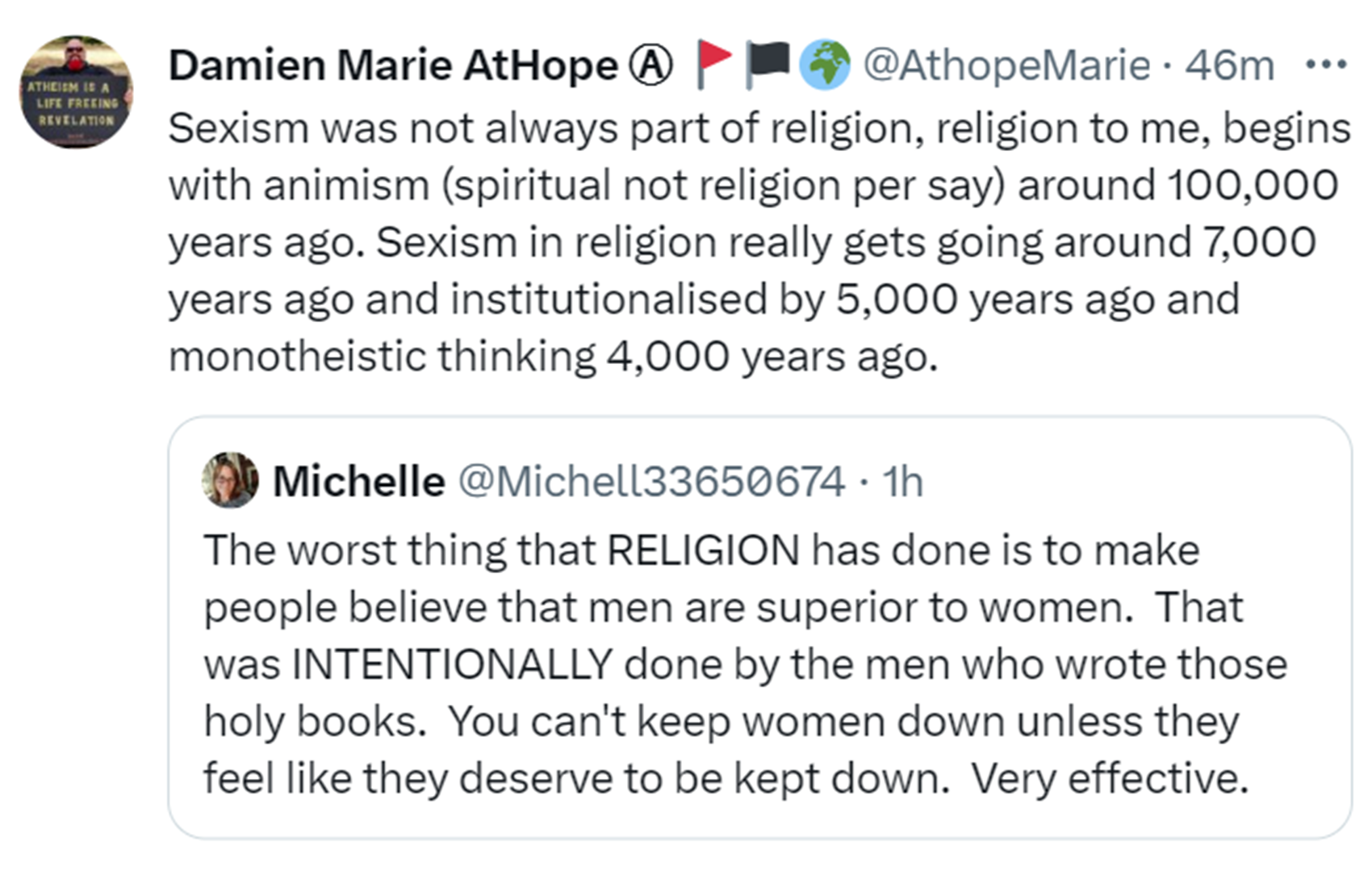
“The worst thing that RELIGION has done is to make people believe that men are superior to women. That was INTENTIONALLY done by the men who wrote those holy books. You can’t keep women down unless they feel like they deserve to be kept down. Very effective.” – Michelle @Michell33650674
My response, Sexism was not always part of religion, religion to me, begins with animism (spiritual not religion per say) around 100,000 years ago. Sexism in religion really gets going around 7,000 years ago and institutionalised by 5,000 years ago and monotheistic thinking 4,000 years ago.
My response, Monotheism is actually “man-o-theism” as it is all just men. There is no single female Monotheism that I know of. And monotheism is only around 4,000 years old.
“The broader definition of monotheism characterizes the traditions of Bábism, the Bahá’í Faith, Balinese Hinduism, Cao Dai (Caodaiism), Cheondoism (Cheondogyo), Christianity, Deism, Eckankar, Hindu sects such as Shaivism and Vaishnavism, Islam, Judaism, Mandaeism, Rastafari, Seicho no Ie, Sikhism, Tengrism (Tangrism), Tenrikyo (Tenriism), Yazidism, and Zoroastrianism, and elements of pre-monotheistic thought are found in early religions such as Atenism, ancient Chinese religion, and Yahwism.” ref
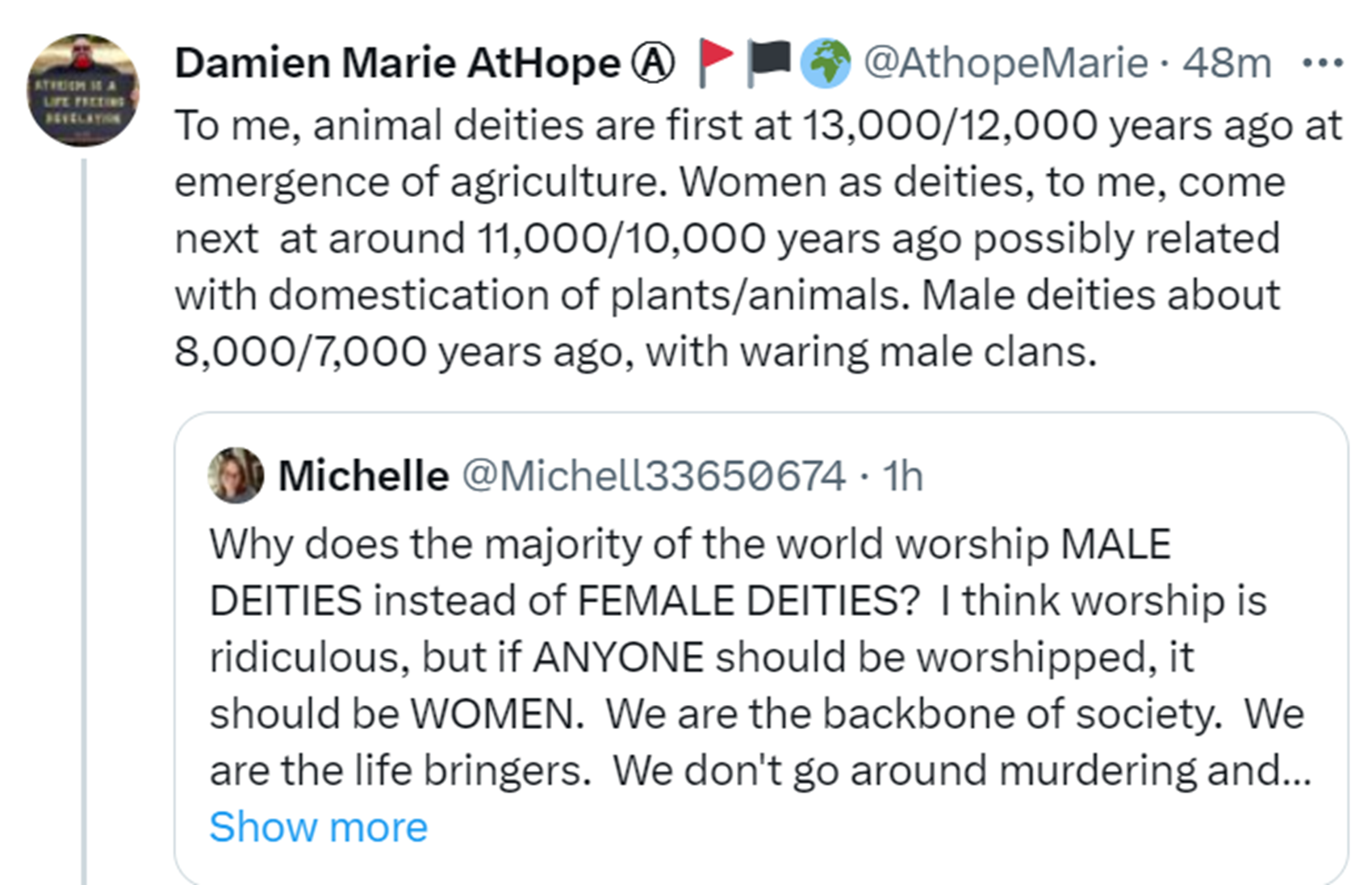
“Why does the majority of the world worship MALE DEITIES instead of FEMALE DEITIES? I think worship is ridiculous, but if ANYONE should be worshipped, it should be WOMEN. We are the backbone of society. We are the life bringers. We don’t go around murdering and raping.” – Michelle @Michell33650674
My response, To me, animal deities are first at 13,000/12,000 years ago at emergence of agriculture. Women as deities, to me, come next at around 11,000/10,000 years ago possibly related with domestication of plants/animals. Male deities about 8,000/7,000 years ago, with waring male clans.
Origins of Agriculture: 13,000-12,000 years ago
“Localised climate change is the favored explanation for the origins of agriculture in the Levant. When major climate change took place after the last ice age (c. 13,000 years ago), much of the earth became subject to long dry seasons. These conditions favoured annual plants which die off in the long dry season, leaving a dormant seed or tuber. An abundance of readily storable wild grains and pulses enabled hunter-gatherers in some areas to form the first settled villages at this time. The development of agriculture about 12,000 years ago changed the way humans lived. They switched from nomadic hunter-gatherer lifestyles to permanent settlements and farming.” ref
Domestication of Animals: 11,000-10,000 years ago
“The domestication of plants began around 13,000–11,000 years ago with cereals such as wheat and barley in the Middle East, alongside crops such as lentil, pea, chickpea, and flax. In the Fertile Crescent 10,000-11,000 years ago, zooarchaeology indicates that goats, pigs, sheep, and taurine cattle were the first livestock to be domesticated.” ref, ref
“A fertility deity is a god or goddess associated with fertility, sex, pregnancy, childbirth, and crops. in some cases these deities are directly associated with these experiences; in others, they are more abstract symbols. Fertility rites may accompany their worship. The following is a list of fertility deities. Fertility rites or fertility cults are religious rituals that are intended to stimulate reproduction in humans or in the natural world. Such rites may involve the sacrifice of “a primal animal, which must be sacrificed in the cause of fertility or even creation. Fertility rites may occur in calendric cycles, as rites of passage within the life cycle, or as ad hoc rituals….Commonly fertility rituals are embedded within larger-order religions or other social institutions.” ref, ref
Male Clan Wars: 7,000 to 5,000 years ago
“Ancient Clan War Explains Genetic Diversity Drop. Some 5,000 to 7,000 years ago, the diversity of Y chromosomes plummeted. A new analysis suggests clan warfare may have been the cause. Christopher Intagliata reports. “It seemed to us that the 17-to-1 sex ratio was just too extreme to be real.” Imagine a single deadly battle knocking out a whole clan of men with the same Y chromosomes. Then repeat that unpleasant scenario a few times. You’d get a huge drop in the diversity of Y chromosomes, as the victorious clans won battles and expanded. The details are in the journal Nature Communications. [Tian Chen Zeng, Alan J. Aw & Marcus W. Feldman, Cultural hitchhiking and competition between patrilineal kin groups explain the post-Neolithic Y-chromosome bottleneck]” ref
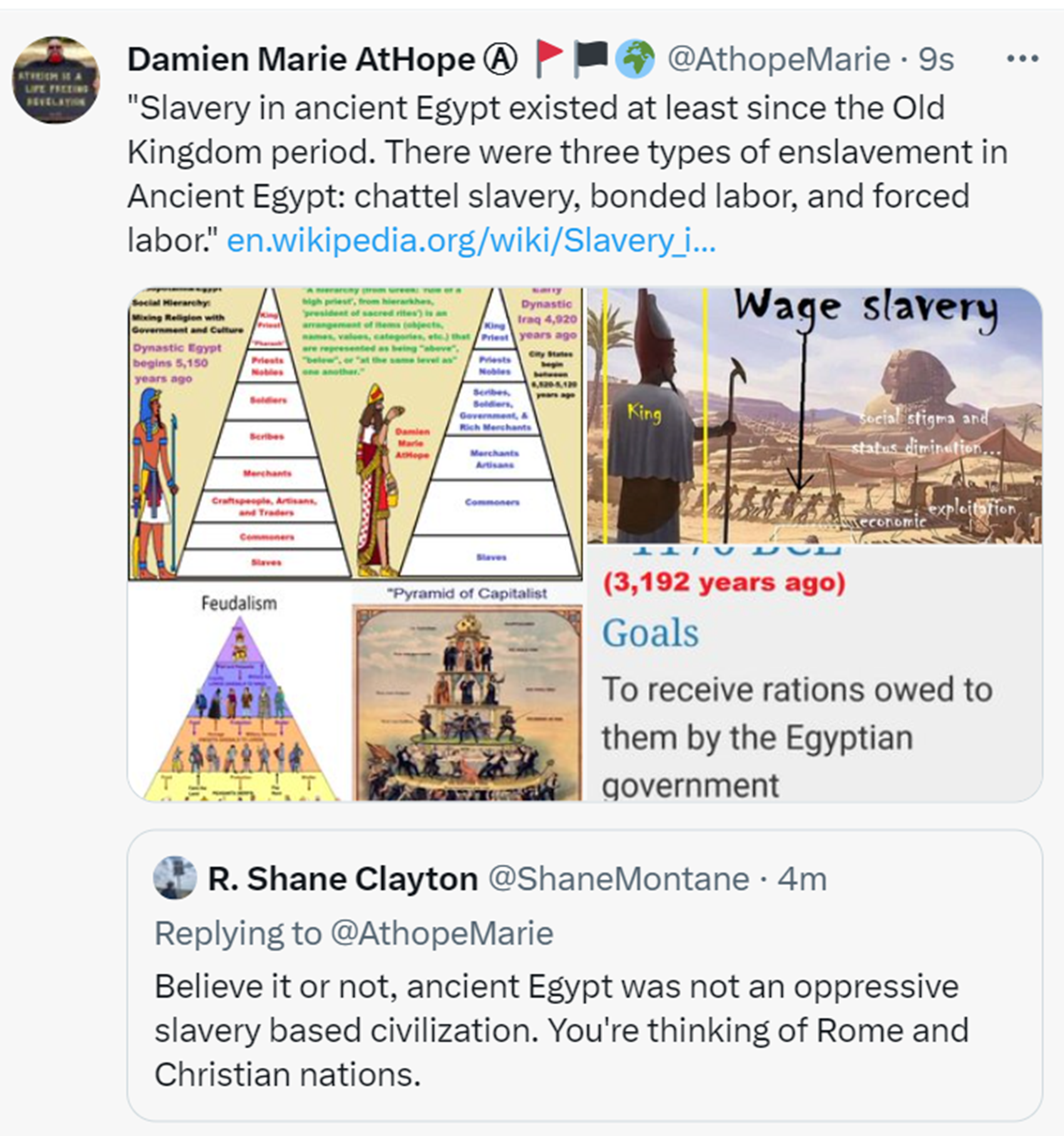
“Believe it or not, ancient Egypt was not an oppressive slavery-based civilization. You’re thinking of Rome and Christian nations.” – R. Shane Clayton @ShaneMontane
My response, “Slavery in ancient Egypt existed at least since the Old Kingdom period. There were three types of enslavement in Ancient Egypt: chattel slavery, bonded labor, and forced labor.” ref
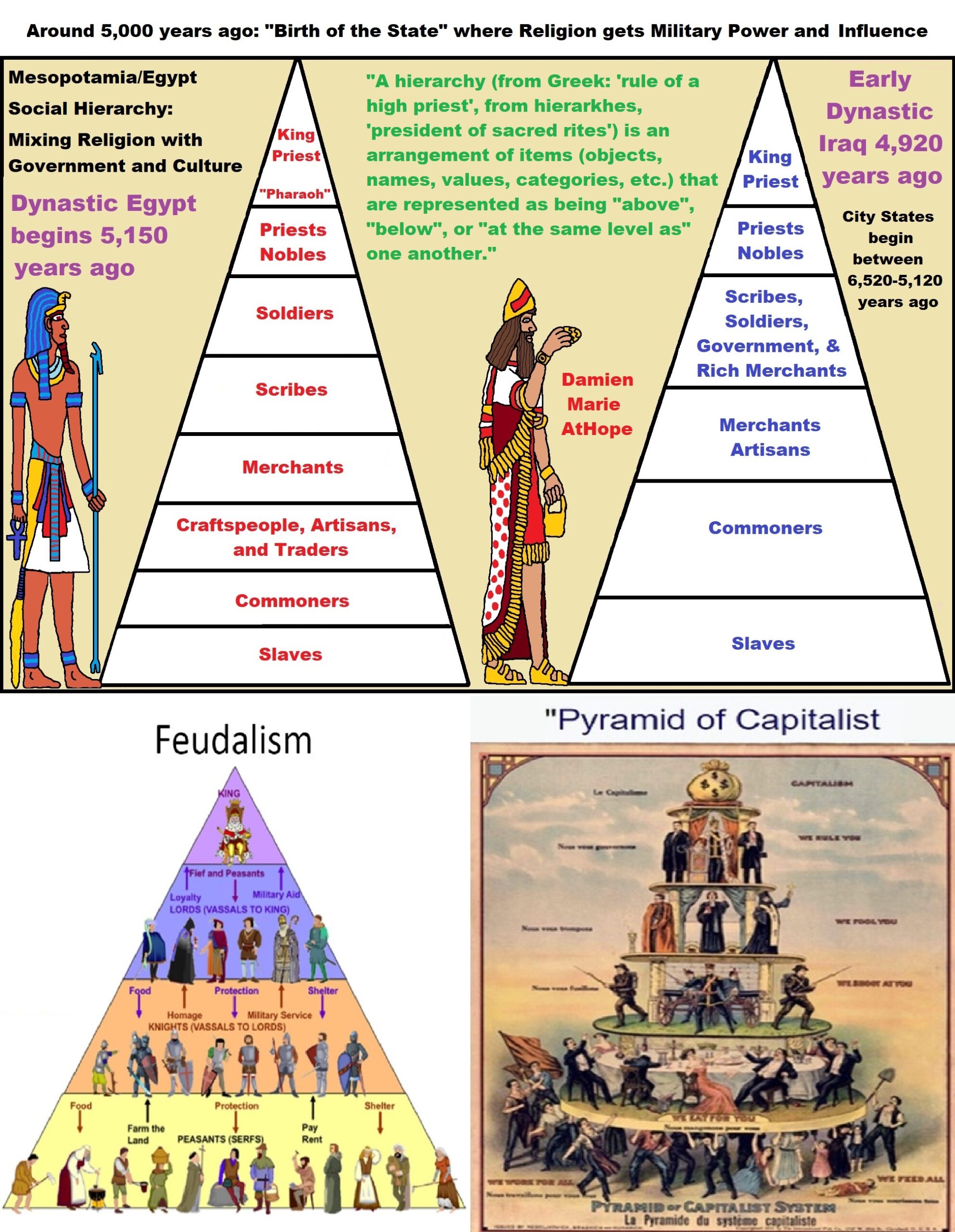
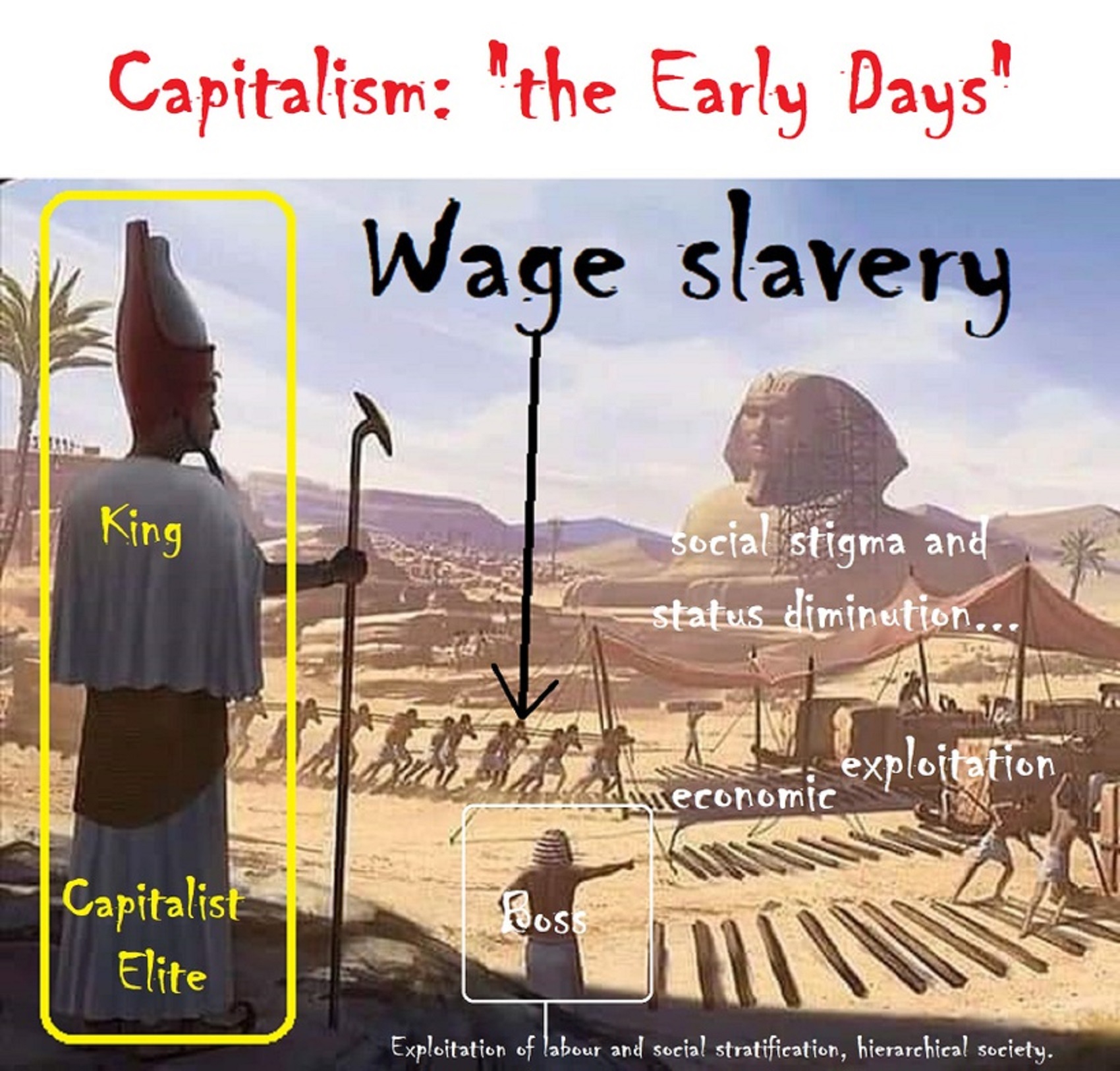
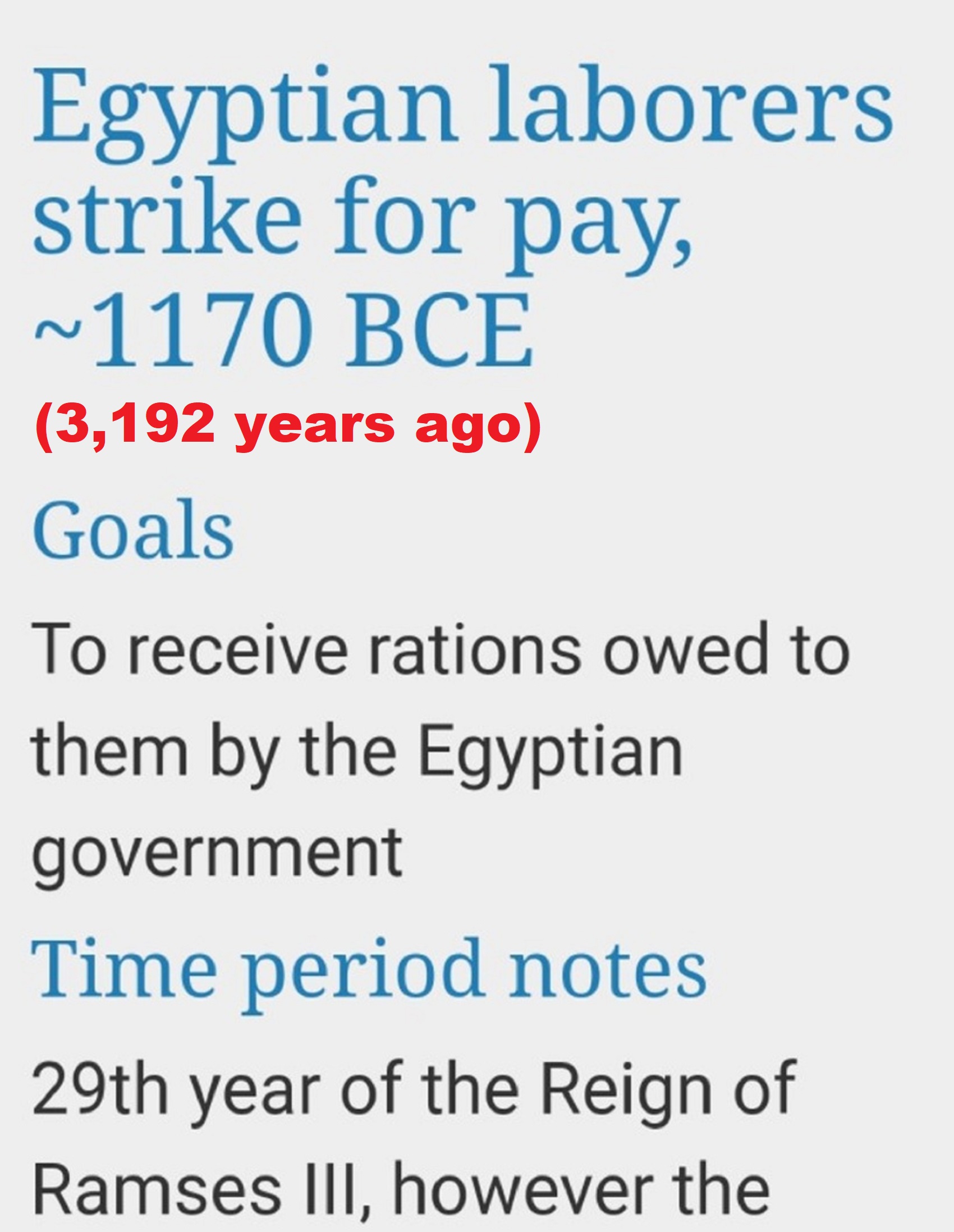
“I did not claim that it didn’t exist. I said that the civilization was not oppressive and based on slavery. As early as the Old Kingdom, the pyramids were built by working citizens. The only real slaves were criminals or enemy combatants, as your linked wiki article explains. Chattel laborers and other indentured servants were essentially just as free as most workers today.” – R. Shane Clayton @ShaneMontane
My response, Thanks, I appreciate your responses.

Religions continuing in our modern world, full of science and facts, should be seen as little more than a set of irrational conspiracy theories of reality. Nothing more than a confused reality made up of unscientific echoes from man’s ancient past. Rational thinkers must ask themselves why continue to believe in religions’ stories. Religion myths which are nothing more than childlike stories and obsolete tales once used to explain how the world works, acting like magic was needed when it was always only nature. These childlike religious stories should not even be taken seriously, but sadly too often they are.
Often without realizing it, we accumulate beliefs that we allow to negatively influence our lives. In order to bring about awareness, we need to be willing to alter skewed beliefs. Rational thinkers must examine the facts instead of blindly following beliefs or faith. Below is a collection of researched information such as archaeology, history, linguistics, genetics, art, science, sociology, geography, psychology, philosophy, theology, biology, and zoology. It will make you question your beliefs with information, inquiries, and ideas to ponder and expand on. The two main goals are to expose the evolution of religion starting by around 100,000 years ago and to offer challenges to remove the rationale of faith. It is like an intervention for belief in myths that have plagued humankind for way too long. We often think we know what truth is nevertheless this can be but a vantage point away from losing credibility if we are not willing to follow valid and reliable reason and evidence.
The door of reason opens not once but many times. Come on a journey to free thought where the war is against ignorance and the victor is a rational mind. Understanding Religion Evolution: Pre-Animism (at least 300,000 years ago), * Animism (such as that seen in Africa: 100,000 years ago), *Totemism (Europe: 50,000 years ago), * Shamanism (beginning around 30,000 years ago), *Paganism (beginning around 12,000 years ago), * Progressed organized religion (around 5,000 years ago), * CURRENT “World” RELIGIONS (after 4,000 years ago), and * Early Atheistic Doubting (at least by around 2,600 Years Ago)
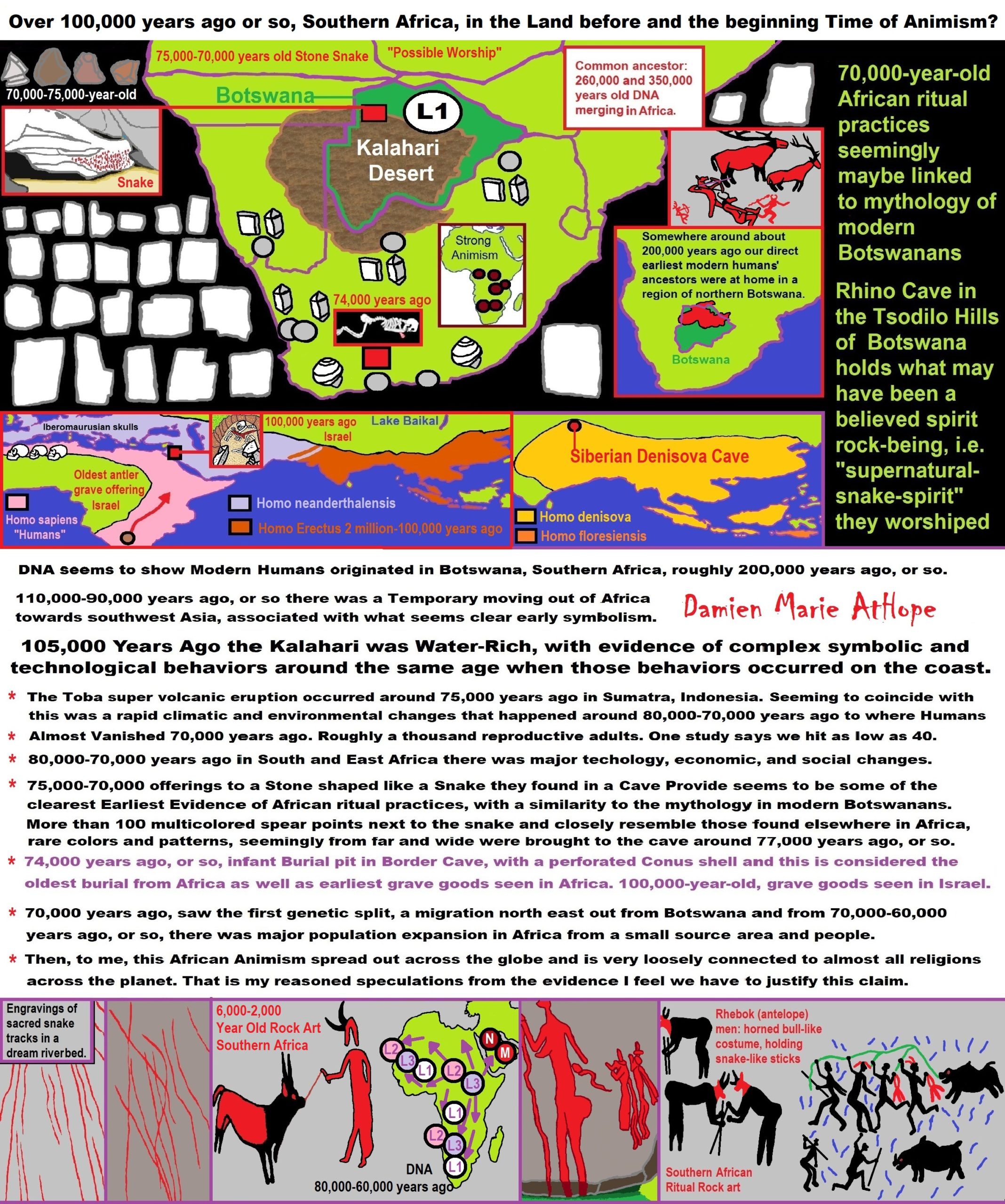
ref, ref, ref, ref, ref, ref, ref, ref, ref, ref, ref, ref, ref, ref, ref, ref, ref, ref, ref, ref, ref, ref, ref, ref, ref, ref, ref, ref, ref, ref, ref, ref, ref, ref, ref, ref, ref, ref, ref, ref, ref, ref, ref, ref, ref, ref, ref, ref, ref, ref, ref, ref
Animism: a belief among some indigenous people, young children, or all religious people!
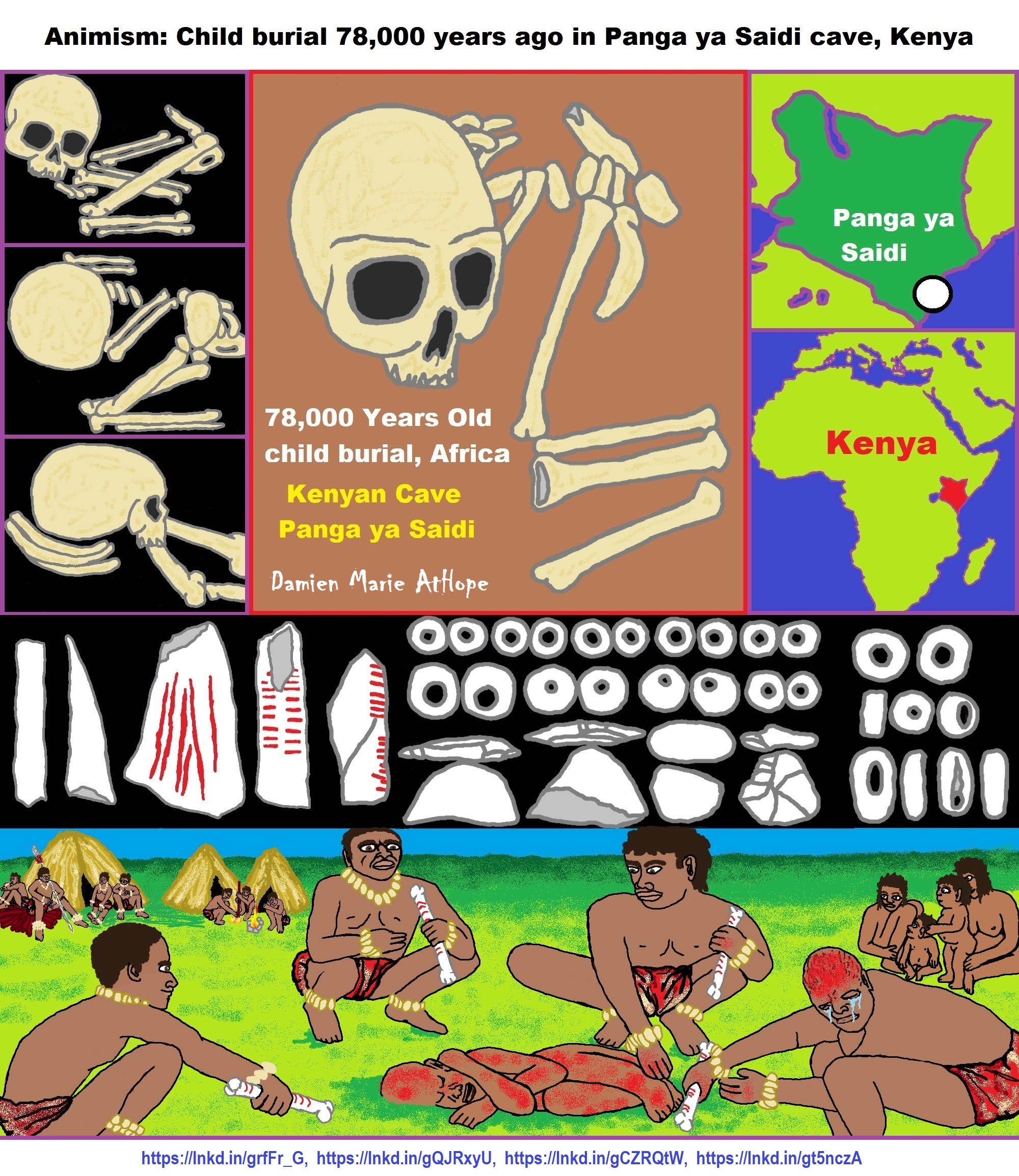
78,000 Years Ago
“Mtoto’s burial, to experts it is believed the child was around three years old when they died and was likely wrapped in a shroud and had their head on a pillow. Besides the seemingly deliberate position of the body, the team noticed a few clues that suggested the child was swaddled in cloth, possibly with the intention of preserving the corpse. They also speculate the body was placed in a cave fissure — known as funerary caching — before being covered with sediment.” ref, ref
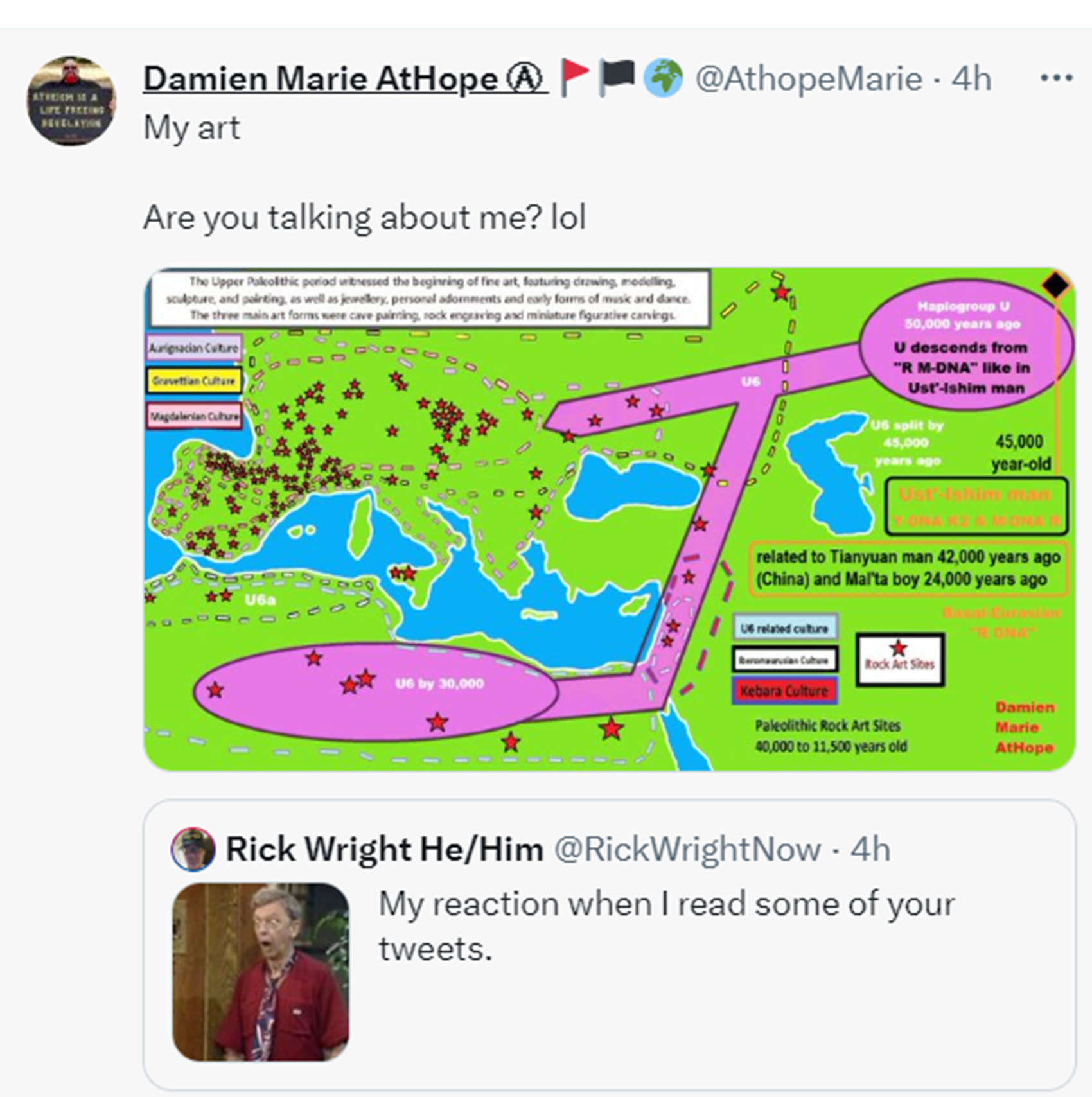

“Ust’-Ishim man is the term given to the 45,000-year-old remains of one of the early modern humans to inhabit western Siberia. He belonged to mitochondrial DNA haplogroup R*, differing from the root sequence of R by a single mutation. Ust’-Ishim man belongs to Y-DNA haplogroup K2. The two subclades of K2 are K2a and K2b. Haplogroup K is believed to have originated in the mid-Upper Paleolithic. It is the most common subclade of haplogroup U8b. The haplogroup U8b’s most common subclade is haplogroup K, and makes up a sizeable fraction of European and West Asian mtDNA lineages.” ref, ref, ref
“Both of these haplogroups and descendant subclades are now found among populations throughout Eurasia, Oceania, and The Americas, although no direct descendants of Ust Ishim man’s specific lineages are known from modern populations. Examination of the sequenced genome indicates that Ust’-Ishim man lived at a point in time (270,000 to 45,000 years ago) between the first wave of anatomically modern humans that migrated out of Africa and the divergence of that population into distinct populations, in terms of autosomal DNA in different parts of Eurasia. Consequently, Ust’-Ishim man is not more closely related to the first two major migrations of Homo Sapiens eastward from Africa into Asia: a group that migrated along the coast of South Asia, or a group that moved north-east through Central Asia. When compared to other ancient remains, Ust’-Ishim man is more closely related, in terms of autosomal DNA to Tianyuan man, found near Beijing and dating from 42,000 to 39,000 years ago; Mal’ta boy (or MA-1), a child who lived 24,000 years ago along the Bolshaya Belaya River near today’s Irkutsk in Siberia, or; La Braña man – a hunter-gatherer who lived in La Braña (modern Spain) about 8,000 years ago.” ref
“Ust’-Ishim was equally related to modern East Asians, Oceanians, and West Eurasian populations, such as the ancient Europeans. Modern Europeans are more closely related to other ancient remains. “The finding that the Ust’-Ishim individual is equally closely related to present-day Asians and to 8,000- to 24,000-year-old individuals from western Eurasia, but not to present-day Europeans, is compatible with the hypothesis that present-day Europeans derive some of their ancestry from a population that did not participate in the initial dispersals of modern humans into Europe and Asia.”In a 2016 study, modern Tibetans were identified as the modern population that has the most alleles in common with Ust’-Ishim man. According to a 2017 study, “Siberian and East Asian populations shared 38% of their ancestry” with Ust’-Ishim man. A 2021 study found that “the Ust’Ishim and Oase1 individuals showed no more affinity to western than to eastern Eurasian populations, suggesting that they did not contribute ancestry to later Eurasian populations, as previously shown.” ref
Paleolithic Y-chromosomal haplogroups by chronological period
- Proto-Aurignacian (47,000 to 43,000 years before present; eastern Europe): F
- Aurignacian Culture (43,000 to 28,000 ybp ; all ice-free Europe): CT, C1a, C1b, I
- Gravettian Culture (31,000 to 24,000 ybp ; all ice-free Europe): BT, CT, F, C1a2
- Epiravettian Culture (22,000 to 8,000 ybp ; Italy): R1b1a
- Magdalenian Culture 17,000 to 12,000 ybp ; Western Europe): IJK, I
- Epipaleolithic France (13,000 to 10,000 ybp): I
- Azilian Culture (12,000 to 9,000 ybp ; Western Europe): I2 ref
Paleolithic mitochondrial haplogroups by chronological period
- Proto-Aurignacian (47,000 to 43,000 years before present ; eastern Europe): N, R*
- Aurignacian Culture (43,000 to 28,000 ybp ; all ice-free Europe): M, U, U2, U6
- Gravettian Culture (31,000 to 24,000 ybp ; all ice-free Europe): M, U, U2’3’4’7’8’9, U2 (x5), U5 (x5), U8c (x2)
- Solutrean Culture (22,000 to 17,000 ybp ; France, Spain): U
- Epiravettian Culture (22,000 to 8,000 ybp ; Italy): U2’3’4’7’8’9, U5b2b (x2)
- Magdalenian Culture 17,000 to 12,000 ybp ; Western Europe): R0, R1b, U2’3’4’7’8’9, U5b (x2), U8a (x5)
- Epipaleolithic France (13,000 to 10,000 ybp): U5b1, U5b2a, U5b2b (x2)
- Epipaleolithic Germany (13,000 to 11,000 ybp): U5b1 (x2)
- Azilian Culture (12,000 to 9,000 ybp ; Western Europe): U5b1h ref
Mesolithic Y-chromosomal haplogroups by country
- Ireland: I2a1b, I2a2
- Britain: IJK, I2a2 (x2)
- France: I (x3), I2a1b2
- Luxembourg: I2a1b
- Germany: I2a2a
- Spain: C1a2
- Italy: I, I2a2
- Sweden: I2a1 (x2), I2a1a1a*, I2a1b (x2), I2c2
- Estonia: R1a-YP1272
- Latvia: I2a1 (x2), I2a1b, I2a2a1, I2a2a1b (x2), Q1a2, R1b1a1a-P297 (x7)
- Lithuania: I2a1b, I2a1a2a1a-L233
- Serbia: I, I2 (x2), I2a1, I2a2, I2a2a-M223, I2a2a-Z161 (x2), R, R1b1a-L794 (x8)
- Romania: R, R1, R1b
- Ukraine: IJ, I (x4), I2, I2a1, I2a2, I2a2a, I2a2a1b1-L702 (x2), R1a, R1b1a-L794
- Russia: J, R1a1* (x3), R1a1-YP1301, R1b1a, R1b1a1a-P297 ref
Mesolithic mitochondrial haplogroups by country
Note that the very late Mesolithic Pitted Ware culture (c. 3200–2300 BCE) in Sweden is listed separately as it is possible that intermarriages with Neolithic or Chalcolithic neighbors took place.
- Croatia: U5b2a5
- France: U5a2 (x2), U5b1, U5b1b
- Germany, Luxembourg: U2e, U4, U5a, U5a2c (x2), U5a2c3, U5b (x2), U5b1a, U5b1d1 (x2), U5b2a2, U5b2c1
- Greece: K1c (x2)
- Italy: U5b1
- Lithuania: U4, U5b (x3)
- Poland: U5a, U5b (x2), U5b1b
- Spain: U5b, U5b1, U5b2c1 (x2)
- Russia: C, C1g, C5d, D, H, U2e, U4 (x3), U4a, U4a1, U5a (x3), U5a1 (x2), U5a1d, T, Z1a (x2)
- Sweden: U2e1 (x2), U4b1, U5a1 (x3), U5a2, U5a2d (x2)
- Sweden (Pitted Ware): H, H1f, HV0 (x2), K1a, K1a1 (x3), T2b (x2), U, U4 (x8), U4a1, U4d (x3), U5a, U5a1a’g (x2), U5b (x2), U5b1, U5b2b1a ref
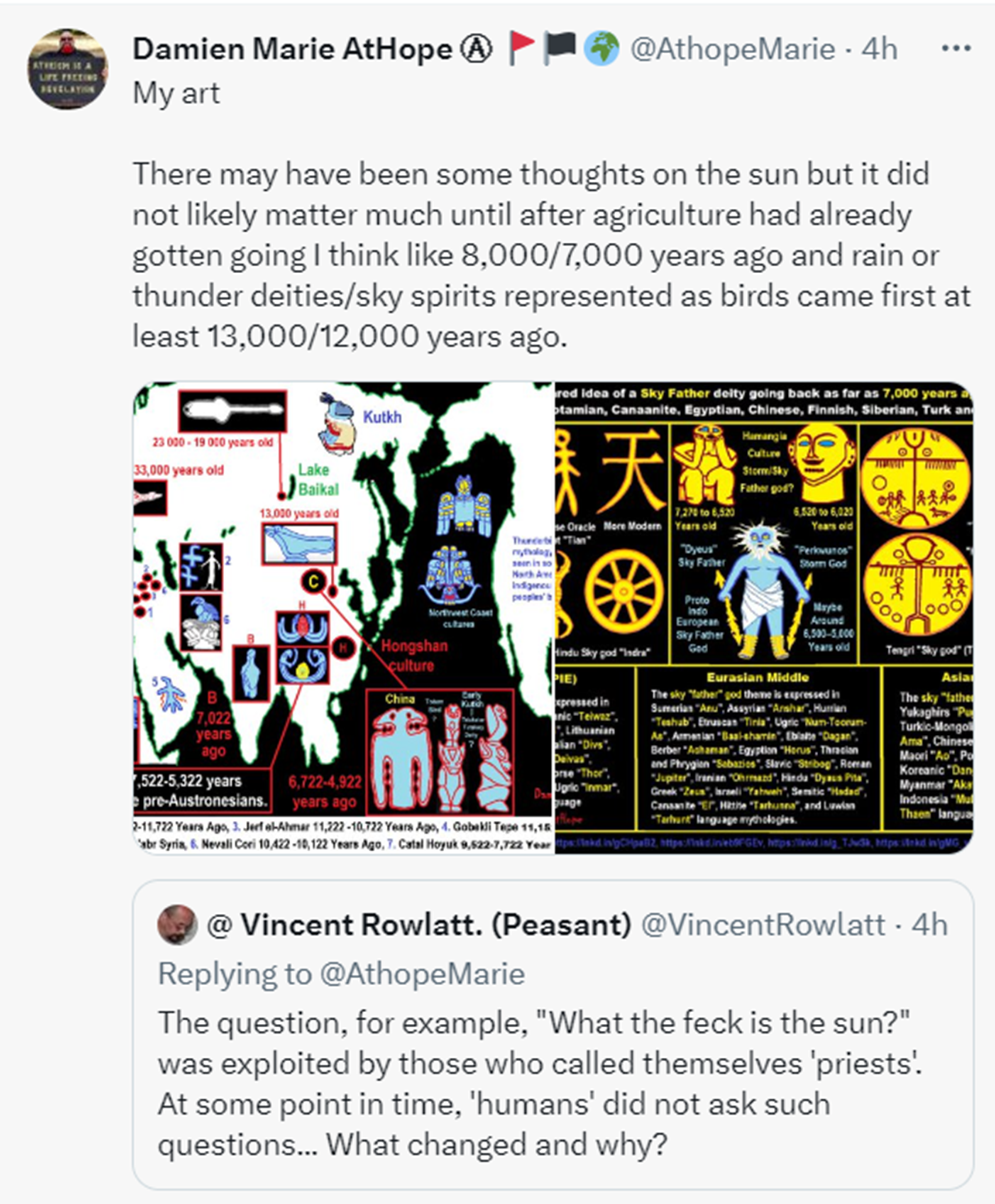
@ Vincent Rowlatt. (Peasant) – “The question, for example, “What the feck is the sun?” was exploited by those who called themselves ‘priests’. At some point in time, ‘humans’ did not ask such questions… What changed and why?”
My response, There may have been some thoughts on the sun but it did not likely matter much until after agriculture had already gotten going I think like 8,000/7,000 years ago, and rain or thunder deities/sky spirits represented as birds came first at least 13,000/12,000 years ago.

ref, ref, ref, ref, ref, ref, ref, ref, ref, ref, ref, ref, ref, ref
1. Kebaran culture 23,022-16,522 Years Ago, 2. Kortik Tepe 12,422-11,722 Years Ago, 3. Jerf el-Ahmar 11,222 -10,722 Years Ago, 4. Gobekli Tepe 11,152-9,392 Years Ago, 5. Tell Al-‘abrUbaid and Uruk Periods, 6. Nevali Cori 10,422 -10,122 Years Ago, 7. Catal Hoyuk 9,522-7,722 Years Ago
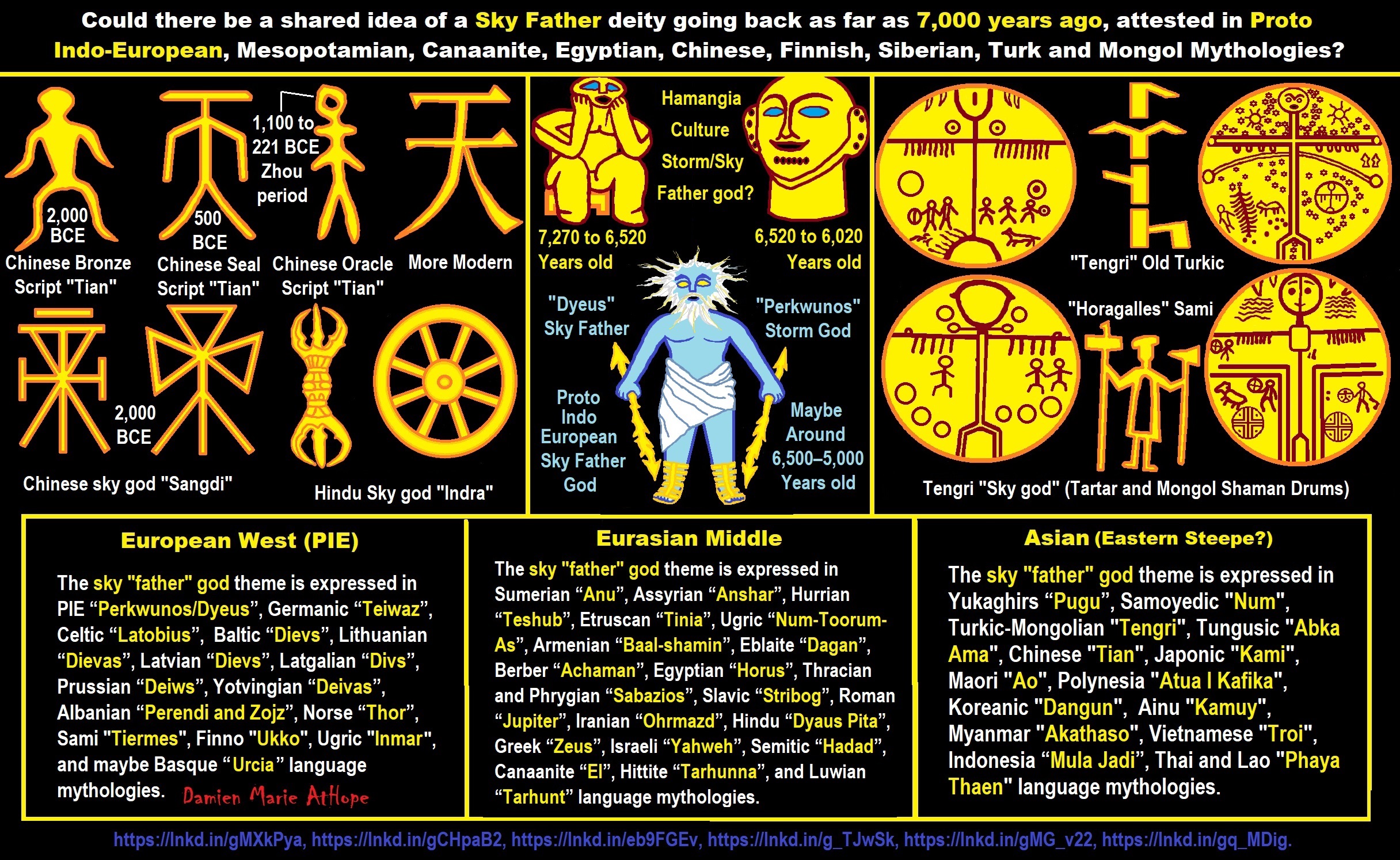
@ Vincent Rowlatt. (Peasant) – “The sun was important long before agriculture. What changed, why did ‘we’ invent ‘gods and religion’?“
My response, The moon was more important first. For most of human evolution, we were on the move as migratory peoples in hunter-gatherer cultures. The moon is favored by migrating peoples and the sun by sedentary people.

34,000 years ago Lunar Calendar Cave art around the Time Shift From Totemism to Early Shamanism?
“The Oldest Lunar Calendars and Earliest Constellations have been identified in cave art found in France and Germany. The astronomer-priests of these late Upper Paleolithic Cultures understood mathematical sets, and the interplay between the moon annual cycle, ecliptic, solstice and seasonal changes on earth. The archaeological record’s earliest data that speaks to human awareness of the stars and ‘heavens’ dates to the Aurignacian Culture of Europe, around 34,000 years ago. Between 1964 and the early 1990s, Alexander Marshack published breakthrough research that documented the mathematical and astronomical knowledge in the Late Upper Paleolithic Cultures of Europe. Marshack deciphered sets of marks carved into animal bones, and occasionally on the walls of caves, as records of the lunar cycle. These marks are sets of crescents or lines. Artisans carefully controlled line thickness so that a correlation with lunar phases would be as easy as possible to perceive. Sets of marks were often laid out in a serpentine pattern that suggests a snake deity or streams and rivers. Many of these lunar calendars were made on small pieces of stone, bone or antler so that they could be easily carried. These small, portable, lightweight lunar calendars were easily carried on extended journeys such as long hunting trips and seasonal migrations.” ref
“Hunting the largest animals was arduous, and might require hunters to follow herds of horses, bison, mammoth or ibex for many weeks. (Other big animals such as the auroch, cave bear and cave lion were well known but rarely hunted for food because they had a special status in the mythic realm. The Auroch is very important to the search for earliest constellations.) The phases of the moon depicted in these sets of marks are inexact. Precision was impossible unless all nights were perfectly clear which is an unrealistic expectation. The arithmetic counting skill implied by these small lunar calendars is obvious. The recognition that there are phases of the moon and seasons of the year that can be counted – that should be counted because they are important – is profound. “All animal activities are time factored, simply because time passes, the future is forever arriving. The reality of time factoring is objective physics and does not depend upon human awareness or consciousness. Until Marshack’s work, many archeologists believed the sets of marks he chose to study were nothing but the aimless doodles of bored toolmakers. What Marshack uncovered is the intuitive discovery of mathematical sets and the application of those sets to the construction of a calendar.” Bone is the preferred medium because it allows for easy transport and a long calendar lifetime. Mankind’s earliest astronomy brought the clan into the multi-dimensional universe of the gods. Objects used in the most potent rituals had the highest contextual, cultural value and were treated with great reverence.” ref
“Regarding the Aurignacian, between 43,000 and 35,000 years ago, the archaeological record from habitations is relatively poor in the Ardèche (Abri des Pécheurs, Grotte du Figuier) while appearing more abundant in the Languedoc (La Salpétrière, La Balauzière, Esquicho-Grapaou, La Laouza etc.). The same applies to the sites of the early phases of the Gravettian. During climatic fluctuations, and unlike the deep caves such as Chauvet, the porch and shelter fills seem to have better recorded the cold episodes than the humid phases. To date, 20 decorated caves are indexed in the gorges of the Ardèche and nearby; in other words as far as the valley of the Gardon (Baume-Latrone). This group includes several important caves (Ebbou, Oulen, Émilie etc.) which are not precisely dated and were judged to be of secondary importance until the discovery of the Chauvet Cave.” ref
“A 10,000-year-old engraved stone could be a lunar calendar. The rare pebble — found high up in the mountains near Rome, Italy, the hammer-stone was found on top of Monte Alta in the Alban Hills. It’s believed that our early ancestors would’ve used the stone to keep track of the moon’s cycles. Notches were engraved “as if they were being used to count, calculate or store the record of some kind of information. And these notches — which total either 27 or 28 — suggest the stone’s engraver used the pebble to track lunar cycles.” ref
“Archaeologists excavating in Scotland found a series of huge pits were dug by Mesolithic people to track the cycle of the Moon. They found a series of twelve huge, specially shaped pits designed to mimic the various phases of the Moon. The holes aligned perfectly on the midwinter solstice to help the hunter-gathers of Mesolithic Britain keep precise track of the passage of the seasons and the lunar cycle. The holes were dug in the shapes of various phases of the moon. “Waxing, waning, crescents, and gibbous, they’re all there and arranged in a 50-meter-long (164-foot) arc. The one representing the full moon is large and circular, approximately two meters (roughly seven feet) across, and placed right in the center. And this arc is arranged perfectly with a notch in the landscape where the sun would have risen on the day of the midwinter solstice about 10,000 years ago. Placing their calendar in the landscape the way they did would have let the people who built it to recalibrate the lunar months every winter to bring their lunar calendar in line with the solar year. This means that any effort to keep track of the seasons using the moon alone will slowly drift ever further from true. An observer needs to know when to add or subtract an extra month to make good the time or hit the reset button and start counting again.” ref
“A moon-shaped calendar was found in Smederevska Palanka, Serbia that dates back 8,000 years, and is made from a wild boar’s tusk engraved with markings to denote a lunar cycle. Farmers may have used the device to plan when to plant crops. It is made from the tusk of a wild boar and is marked with engravings thought to denote a lunar cycle of 28 days, as well as the four phases of the moon.” ref
“A lunisolar calendar was found at Warren Field in Scotland and has been dated to c. 8000 BCE, during the Mesolithic period. Some scholars argue for lunar calendars still earlier—Rappenglück in the marks on a c. 17,000-year-old cave painting at Lascaux and Marshack in the marks on a c. 27,000-year-old bone baton—but their findings remain controversial. Scholars have argued that ancient hunters conducted regular astronomical observations of the Moon back in the Upper Palaeolithic. Samuel L. Macey dates the earliest uses of the Moon as a time-measuring device back to 28,000–30,000 years ago.” ref
“A lunar calendar is a calendar based on the monthly cycles of the Moon‘s phases (synodic months, lunations), in contrast to solar calendars, whose annual cycles are based only directly on the solar year. The most commonly used calendar, the Gregorian calendar, is a solar calendar system that originally evolved out of a lunar calendar system. A purely lunar calendar is also distinguished from a lunisolar calendar, whose lunar months are brought into alignment with the solar year through some process of intercalation. The details of when months begin varies from calendar to calendar, with some using new, full, or crescent moons and others employing detailed calculations.” ref
“Since each lunation is approximately 29+1⁄2 days, it is common for the months of a lunar calendar to alternate between 29 and 30 days. Since the period of 12 such lunations, a lunar year, is 354 days, 8 hours, 48 minutes, 34 seconds (354.36707 days), purely lunar calendars are 11 to 12 days shorter than the solar year. In purely lunar calendars, which do not make use of intercalation, like the Islamic calendar, the lunar months cycle through all the seasons of a solar year over the course of a 33–34 lunar-year cycle.” ref
“Although the Gregorian calendar is in common and legal use in most countries, traditional lunar and lunisolar calendars continue to be used throughout the world to determine religious festivals and national holidays. Such holidays include Rosh Hashanah (Hebrew calendar); Easter (the Computus); the Chinese, Korean, Vietnamese, and Mongolian New Year (Chinese, Korean, Vietnamese, and Mongolian calendars, respectively); the Nepali New Year (Nepali calendar); the Mid-Autumn Festival and Chuseok (Chinese and Korean calendars); Loi Krathong (Thai calendar); Sunuwar calendar; Vesak/Buddha’s Birthday (Buddhist calendar); Diwali (Hindu calendars); Ramadan, Eid al-Fitr and Eid al-Adha (Islamic calendar).” ref
“The Japanese Calendar formerly used both the lunar and lunisolar calendar before it was replaced by the Gregorian Calendar during the Meiji government in 1872. Holidays such as the Japanese New Year were simply transposed on top as opposed to being calculated like other countries that use the lunisolar and Gregorian calendars together, for example, the Japanese New Year now falls on January 1, creating a month delay as opposed to other East Asian Countries. See customary issues in modern Japan.” ref
“Most calendars referred to as “lunar” calendars are in fact lunisolar calendars. Their months are based on observations of the lunar cycle, with intercalation being used to bring them into general agreement with the solar year. The solar “civic calendar” that was used in ancient Egypt showed traces of its origin in the earlier lunar calendar, which continued to be used alongside it for religious and agricultural purposes. Present-day lunisolar calendars include the Chinese, Vietnamese, Hindu, and Thai calendars.” ref
“Synodic months are 29 or 30 days in length, making a lunar year of 12 months about 11 to 12 days shorter than a solar year. Some lunar calendars do not use intercalation, for example, the lunar Hijri calendar used by most Muslims. For those that do, such as the Hebrew calendar, and Buddhist Calendars in Myanmar, the most common form of intercalation is to add an additional month every second or third year. Some lunisolar calendars are also calibrated by annual natural events which are affected by lunar cycles as well as the solar cycle. An example of this is the lunar calendar of the Banks Islands, which includes three months in which the edible palolo worms mass on the beaches. These events occur at the last quarter of the lunar month, as the reproductive cycle of the palolos is synchronized with the moon.” ref
“Lunar and lunisolar calendars differ as to which day is the first day of the month. In some lunisolar calendars, such as the Chinese calendar, the first day of a month is the day when an astronomical new moon occurs in a particular time zone. In others, such as some Hindu calendars, each month begins on the day after the full moon. Others are based on the first sighting of the lunar crescent, such as the lunar Hijri calendar (and, historically, the Hebrew calendar).” ref

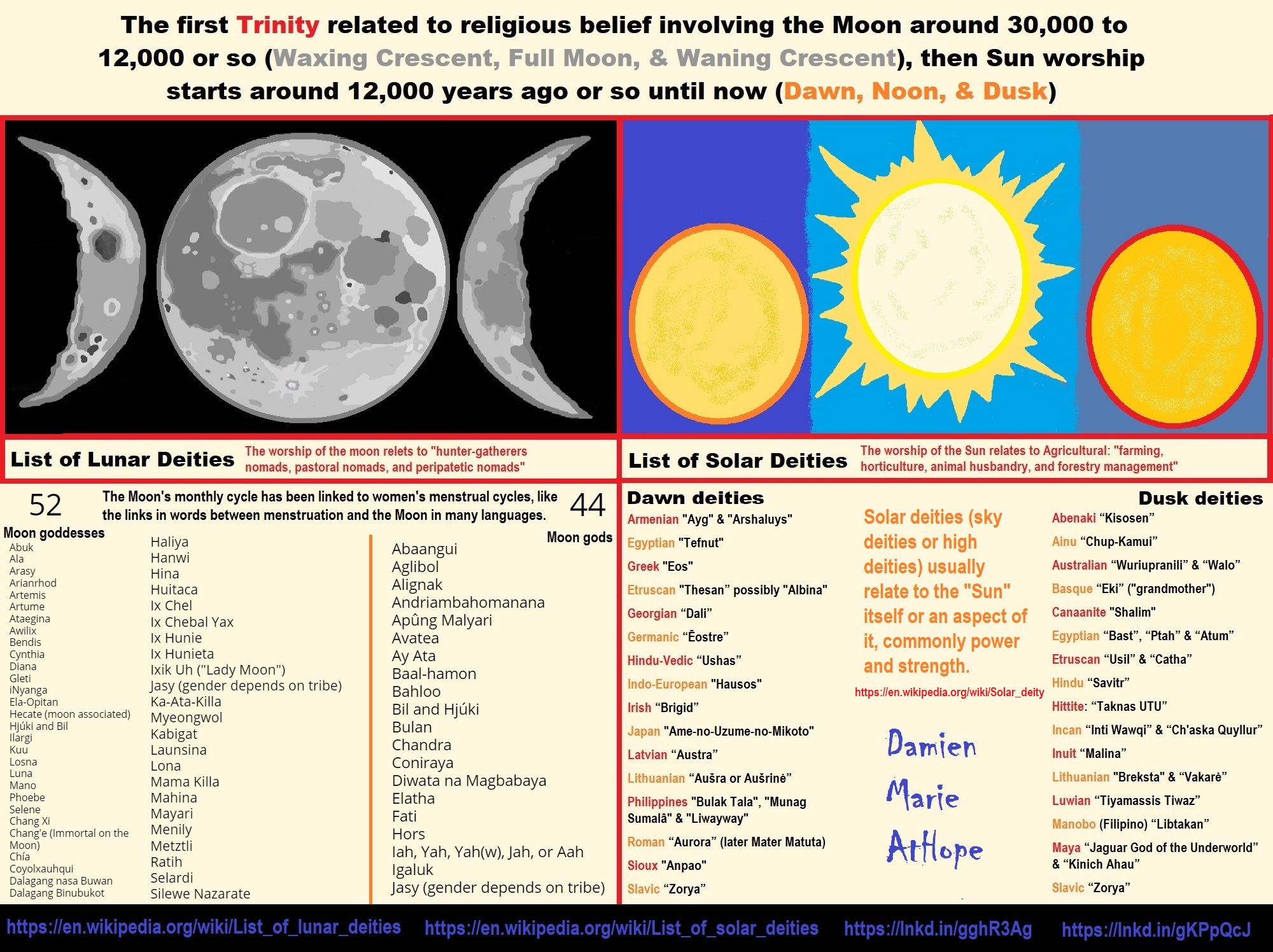
ref, ref, ref, ref, ref, ref, ref
List of Lunar Deities
“In mythology, a lunar deity is a god or goddess of the Moon, sometimes as a personification. These deities can have a variety of functions and traditions depending upon the culture, but they are often related. Some forms of moon worship can be found in most ancient religions. The Moon features prominently in art and literature, often with a purported influence in human affairs. Many cultures are oriented chronologically by the Moon, as opposed to the Sun. The Hindu calendar maintains the integrity of the lunar month and the moon god Chandra has religious significance during many Hindu festivals (e.g. Karwa Chauth, Sankashti Chaturthi, and during eclipses). The ancient Germanic tribes were also known to have a lunar calendar.” ref
“Many cultures have implicitly linked the 29.5-day lunar cycle to women’s menstrual cycles, as evident in the shared linguistic roots of “menstruation” and “moon” words in multiple language families. This identification was not universal, as demonstrated by the fact that not all moon deities are female. Still, many well-known mythologies feature moon goddesses, including the Greek goddess Selene, the Roman goddess Luna, and the Chinese goddess Chang’e. Several goddesses including Artemis, Hecate, and Isis did not originally have lunar aspects, and only acquired them late in antiquity due to syncretism with the de facto Greco-Roman lunar deity Selene/Luna. In traditions with male gods, there is little evidence of such syncretism, though the Greek Hermes has been equated with the male Egyptian lunar god Thoth.” ref
“Male lunar gods are also common, such as Sin of the Mesopotamians, Mani of the Germanic tribes, Tsukuyomi of the Japanese, Igaluk/Alignak of the Inuit, and the Hindu god Chandra. The original Proto-Indo-European lunar deity appears to have been male, with many possible derivatives including the Homeric figure of Menelaus. Cultures with male moon gods often feature sun goddesses. An exception is Hinduism, featuring both male and female aspects of the solar divine. The ancient Egyptians had several moon gods including Khonsu and Thoth, although Thoth is a considerably more complex deity. Set represented the moon in the Egyptian Calendar of Lucky and Unlucky Days.” ref
List of Solar Deities
“A solar deity is a god or goddess who represents the Sun, or an aspect of it, usually by its perceived power and strength. Solar deities and Sun worship can be found throughout most of recorded history in various forms. The following is a list of solar deities. A dawn god or goddess is a deity in a polytheistic religious tradition who is in some sense associated with the dawn. These deities show some relation with the morning, the beginning of the day, and, in some cases, become syncretized with similar solar deities.” ref, ref
Deity Artemis
“The Greek deity Artemis is the ancient Greek goddess of the hunt, wilderness, wild animals, chastity, and the Moon. She is the daughter of Zeus and Leto and the twin sister of Apollo. She would eventually be extensively syncretized with the Roman goddess Diana. Cynthia was originally an epithet of the Greek goddess Artemis, who according to legend was born on Mount Cynthus. Selene, the Greek personification of the Moon, and the Roman Diana were also sometimes called “Cynthia.” ref
“While associated with the Moon, Hecate is not actually considered a goddess of the moon.” ref
Lusitanian Deity Ataegina
“Diana is a goddess in Roman and Hellenistic religion, primarily considered a patroness of the countryside, hunters, crossroads, and the Moon. She is equated with the Greek goddess Artemis (see above), and absorbed much of Artemis’ mythology early in Roman history, including a birth on the island of Delos to parents Jupiter and Latona, and a twin brother, Apollo, though she had an independent origin in Italy.” ref
“Elatha was a king of the Fomorians in Irish mythology. He succeeded his father Delbáeth and was replaced by his son Bres, mothered by Ériu.” ref
Norse Deities Hjúki and Bil
African
“Goddess of fertility, morality, creativity, and love.” ref
“Protective goddess and wife of Apedemak, the lion-god. She was represented with a crown-shaped as a falcon, or with a crescent moon on her head on top of which a falcon was standing.” ref
Dahomean Deities Gleti and Mawu
Zulu Deity iNyanga
“Goddess of the Moon.” ref
“God of wisdom, the arts, science, and judgment.” ref
“The god of the moon. A story tells that Ra (the sun God) had forbidden Nut (the Sky goddess) to give birth on any of the 360 days of the calendar. In order to help her give birth to her children, Thoth (the god of wisdom) played against Khonsu in a game of senet. Khonsu lost to Thoth and then he gave away enough moonlight to create 5 additional days so Nut could give birth to her five children. It was said that before losing, the moonlight was on par with the sunlight. Sometimes, Khonsu is depicted as a hawk-headed god, however, he is mostly depicted as a young man with a side-lock of hair, like a young Egyptian. He was also a god of time. The center of his cult was at Thebes which was where he took place in a triad with Amun and Mut. Khonsu was also heavily associated with Thoth who also took part in the measurement of time and the moon.” ref
Yoruba Deity Ela-Opitan
Norse SOL AND MANI
“Sol (pronounced like the English word “soul”; Old Norse Sól, “Sun”) and Mani (pronounced “MAH-nee”; Old Norse Máni, “Moon”), are, as their names suggest, the divinities of the sun and the moon, respectively. Sol is female, and Mani male.” ref
“Sol and Mani form a sister and brother pair. When they first emerged as the cosmos was being created, they didn’t know what their powers were or what their role was in the new world. Then the gods met together and created the different parts of the day and year and the phases of the moon so that Sol and Mani would know where they fit into the great scheme of things.” ref
“They ride through the sky on horse-drawn chariots. The horses who pull Mani’s chariot are never named, but Sol’s horses are apparently named Árvakr (“Early Riser”) and Alsviðr (“Swift”). They ride “swiftly” because they’re pursued through the sky by the wolves Skoll (“Mockery”) and Hati (“Hate”), who will overtake them when the cosmos descends back into chaos during Ragnarok.” ref
“According to one of the poems in the Poetic Edda, a figure named Svalinn rides in the sun’s chariot and holds a shield between her and the earth below. If he didn’t do this, both the land and the sea would be consumed in flames. Elsewhere, the father of Sol and Mani is named as “Mundilfari,” about whom we know nothing. His name might mean “The One Who Moves According to Particular Times.” ref
“The medieval Icelandic historian Snorri Sturluson, whose Prose Edda can’t be taken at face value but nevertheless is in most low-quality introductory books on Norse mythology, offers a story that combines these disparate references into a whole. The story isn’t attested anywhere else, and very well may be an invention of Snorri’s rather than a traditional, pre-Christian tale. According to Snorri, Mundilfari had two children who were so beautiful that he called the girl “Sol” after the sun and the boy “Mani” after the moon. Sun married a man called Glenr (“Opening in the Clouds”[8]). The sun, which had originated as a spark in Muspelheim, was pulled through the sky in a chariot, but the chariot had no driver. The gods were outraged by Mundilfari’s arrogance in the names he chose for his children, so they forced Sol to drive the sun’s chariot.” ref
“The conception of the sun and the moon riding on chariots through the sky is evidently a very old one among the Norse and other Germanic peoples. It can be found on rock carvings and other Scandinavian artifacts from the Bronze Age, perhaps the most notable of which is the Trundholm sun chariot (pictured). The idea that the sun deity was female, and with a name that means simply “Sun,” is also attested among the continental Germanic peoples.” ref
“So while we don’t know much about Sol and Mani, we can be sure that the basic conception they indicate is not only authentic, but was a part of pre-Christian Germanic religion from the earliest times. Looking for more great information on Norse mythology and religion? While this site provides the ultimate online introduction to the topic, my book The Viking Spirit provides the ultimate introduction to Norse mythology and religion period. Also here is a popular list of The 10 Best Norse Mythology Books, which you’ll probably find helpful in your pursuit.” ref
The Moon and Nomadic peoples
“Nomadism is also a lifestyle adapted to infertile regions such as steppe, tundra, or ice and sand, where mobility is the most efficient strategy for exploiting scarce resources. For example, many groups living in the tundra are reindeer herders and are semi-extra nomadic, following forage for their animals. Sometimes also described as “nomadic” are the various itinerant populations who move among densely populated areas to offer specialized services (crafts or trades) to their residents—external consultants, for example. These groups are known as “peripatetic nomads.” ref
“Nomadic hunting and gathering—following seasonally available wild plants and game—is by far the oldest human subsistence method. Pastoralists raise herds, driving or accompanying in patterns that normally avoid depleting pastures beyond their ability to recover. Nomade “people without fixed habitation” is a member of a community without fixed habitation who regularly moves to and from the same areas. Such groups include hunter-gatherers, pastoral nomads (owning livestock), and tinkers or trader nomads.” ref
“A nomad is a person with no settled home, moving from place to place as a way of obtaining food, finding pasture for livestock, or otherwise making a living. The word “nomad” comes ultimately from the classical Greek word νομάς (nomás, “roaming, wandering, especially to find pasture”), from Ancient Greek νομός (nomós, “pasture”). Most nomadic groups follow a fixed annual or seasonal pattern of movements and settlements. Nomadic peoples traditionally travel by animal or canoe or on foot. Animals include camels, horses, and alpaca. Today, some nomads travel by motor vehicle. Some nomads may live in homes or homeless shelters, though this would necessarily be on a temporary or itinerant basis.” ref
“Nomads (also known as foragers) move from campsite to campsite, following game and wild fruits and vegetables. Hunting and gathering describes early people’s subsistence living style. Following the development of agriculture, most hunter-gatherers were eventually either displaced or converted to farming or pastoralist groups. Only a few contemporary societies are classified as hunter-gatherers; and some of these supplements, sometimes extensively, their foraging activity with farming or keeping animals.” ref
“Pastoral nomads are nomads moving between pastures. Nomadic pastoralism is thought to have developed in three stages that accompanied population growth and an increase in the complexity of social organization. The pastoralists are sedentary to a certain area, as they move between the permanent spring, summer, autumn, and winter (or dry and wet season) pastures for their livestock. The nomads moved depending on the availability of resources.” ref
“Karim Sadr has proposed the following stages:
- Pastoralism: This is a mixed economy with a symbiosis within the family.
- Agropastoralism: This is when symbiosis is between segments or clans within an ethnic group.
- True Nomadism: This is when symbiosis is at the regional level, generally between specialized nomadic and agricultural populations.” ref
“Nomadic pastoralism seems to have developed as a part of the secondary products revolution proposed by Andrew Sherratt, in which early pre-pottery Neolithic cultures that had used animals as live meat (“on the hoof”) also began using animals for their secondary products, for example, milk and its associated dairy products, wool and other animal hair, hides and consequently leather, manure for fuel and fertilizer, and traction.” ref
“The first nomadic pastoral society developed in the period from 8,500 to 6,500 BCE or 10,522 to 8,522 years ago in the area of the southern Levant. There, during a period of increasing aridity, Pre-Pottery Neolithic B (PPNB) cultures in the Sinai were replaced by a nomadic, pastoral pottery-using culture, which seems to have been a cultural fusion between a newly arrived Mesolithic people from Egypt (the Harifian culture), adopting their nomadic hunting lifestyle to the raising of stock.” ref
“This lifestyle quickly developed into what Jaris Yurins has called the circum-Arabian nomadic pastoral techno-complex and is possibly associated with the appearance of Semitic languages in the region of the Ancient Near East. The rapid spread of such nomadic pastoralism was typical of such later developments as of the Yamnaya culture of the horse and cattle nomads of the Eurasian steppe, or of the Mongol spread of the later Middle Ages. Trekboer in southern Africa adopted nomadism from the 17th century.” ref
Warfare and Nomadic peoples
“According to Gérard Chaliand, terrorism originated in nomad-warrior cultures. He points to Machiavelli‘s classification of war into two types, which Chaliand interprets as describing a difference between warfare in sedentary and nomadic societies:
There are two different kinds of war. The one springs from the ambition of princes or republics that seek to extend their empire; such were the wars of Alexander the Great, and those of the Romans, and those which two hostile powers carry on against each other. These wars are dangerous but never go so far as to drive all its inhabitants out of a province, because the conqueror is satisfied with the submission of the people…The other kind of war is when an entire people, constrained by famine or war, leave their country with their families for the purpose of seeking a new home in a new country, not for the purpose of subjecting it to their dominion as in the first case, but with the intention of taking absolute possession of it themselves and driving out or killing its original inhabitants.” ref
“Primary historical sources for nomadic steppe-style warfare are found in many languages: Chinese, Persian, Polish, Russian, Classical Greek, Armenian, Latin, and Arabic. These sources concern both the true steppe nomads (Mongols, Huns, Magyars, and Scythians) and also the semi-settled people like Turks, Crimean Tatars, and Russians who retained or, in some cases, adopted the nomadic form of warfare.” ref
“Pala nomads living in Western Tibet have a diet that is unusual in that they consume very few vegetables and no fruit. The main staple of their diet is tsampa and they drink Tibetan-style butter tea. Pala will eat heartier foods in the winter months to help keep them warm. Some of the customary restrictions they explain as cultural saying only that drokha do not eat certain foods, even some that may be naturally abundant. Though they live near sources of fish and fowl these do not play a significant role in their diet, and they do not eat carnivorous animals, rabbits, or the wild asses that are abundant in the environs, classifying the latter as horse due to their cloven hooves.” ref
“Some families do not eat until after the morning milking, while others may have a light meal with butter tea and tsampa. In the afternoon, after the morning milking, the families gather and share a communal meal of tea, tsampa, and sometimes yogurt. During the winter months, the meal is more substantial and includes meat. Herders will eat before leaving the camp and most do not eat again until they return to camp for the evening meal. The typical evening meal may include thin stew with tsampa, animal fat, and dried radish. Winter stew would include a lot of meat with either tsampa or boiled flour dumplings.” ref
“Nomadic diets in Kazakhstan have not changed much over centuries. The Kazakh nomad cuisine is simple and includes meat, salads, marinated vegetables, and fried and baked breads. Tea is served in bowls, possibly with sugar or milk. Milk and other dairy products, like cheese and yogurt, are especially important. Kumiss is a drink of fermented milk. Wrestling is a popular sport, but the nomadic people do not have much time for leisure. Horse riding is a valued skill in their culture.” ref
“Nomadic people are communities who move from one place to another, rather than settling permanently in one location. Many cultures have traditionally been nomadic, but nomadic behavior is increasingly rare in industrialized countries. Pastoralists raise herds, driving them or moving with them, in patterns that normally avoid depleting pastures beyond their ability to recover. The pastoralists are sedentary, remaining within a local area, but moving between permanent spring, summer, autumn, and winter (or dry and wet season) pastures for their livestock.” ref
@ Vincent Rowlatt. (Peasant) – “Agreed. But why ask? Why not accept that the Moon is? Why did we choose to give the Moon divinity? What changed?”
My response, Animism is the answer to why we made magical thinking of non-magical things. “Preschoolers also tend to give lifelike qualities, such as feelings and thoughts, to inanimate objects like teddy bears and leaves. This kind of thinking is known as animism.”

Animism: Respecting the Living World by Graham Harvey
“How have human cultures engaged with and thought about animals, plants, rocks, clouds, and other elements in their natural surroundings? Do animals and other natural objects have a spirit or soul? What is their relationship to humans? In this new study, Graham Harvey explores current and past animistic beliefs and practices of Native Americans, Maori, Aboriginal Australians, and eco-pagans. He considers the varieties of animism found in these cultures as well as their shared desire to live respectfully within larger natural communities. Drawing on his extensive casework, Harvey also considers the linguistic, performative, ecological, and activist implications of these different animisms.” ref
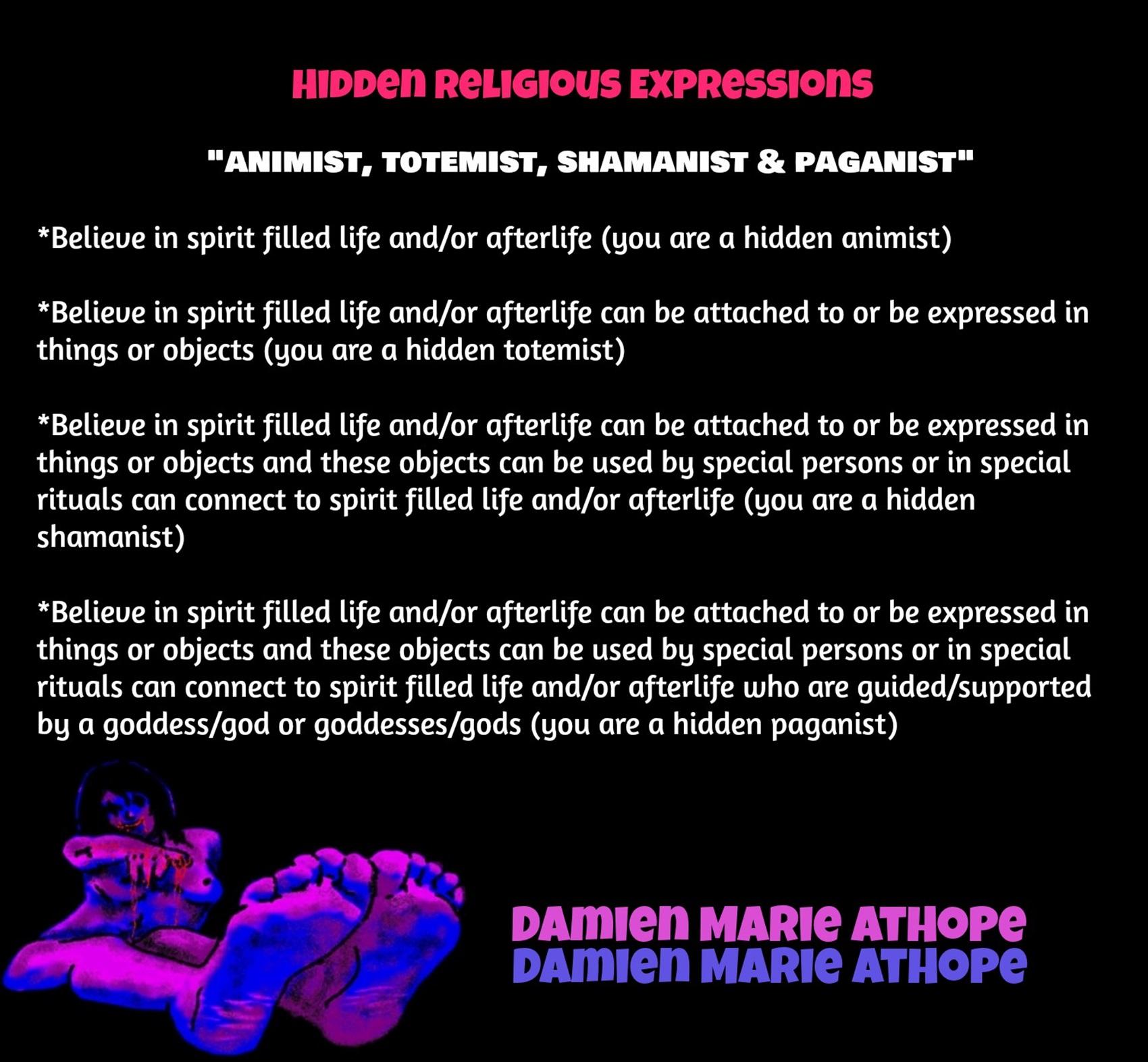
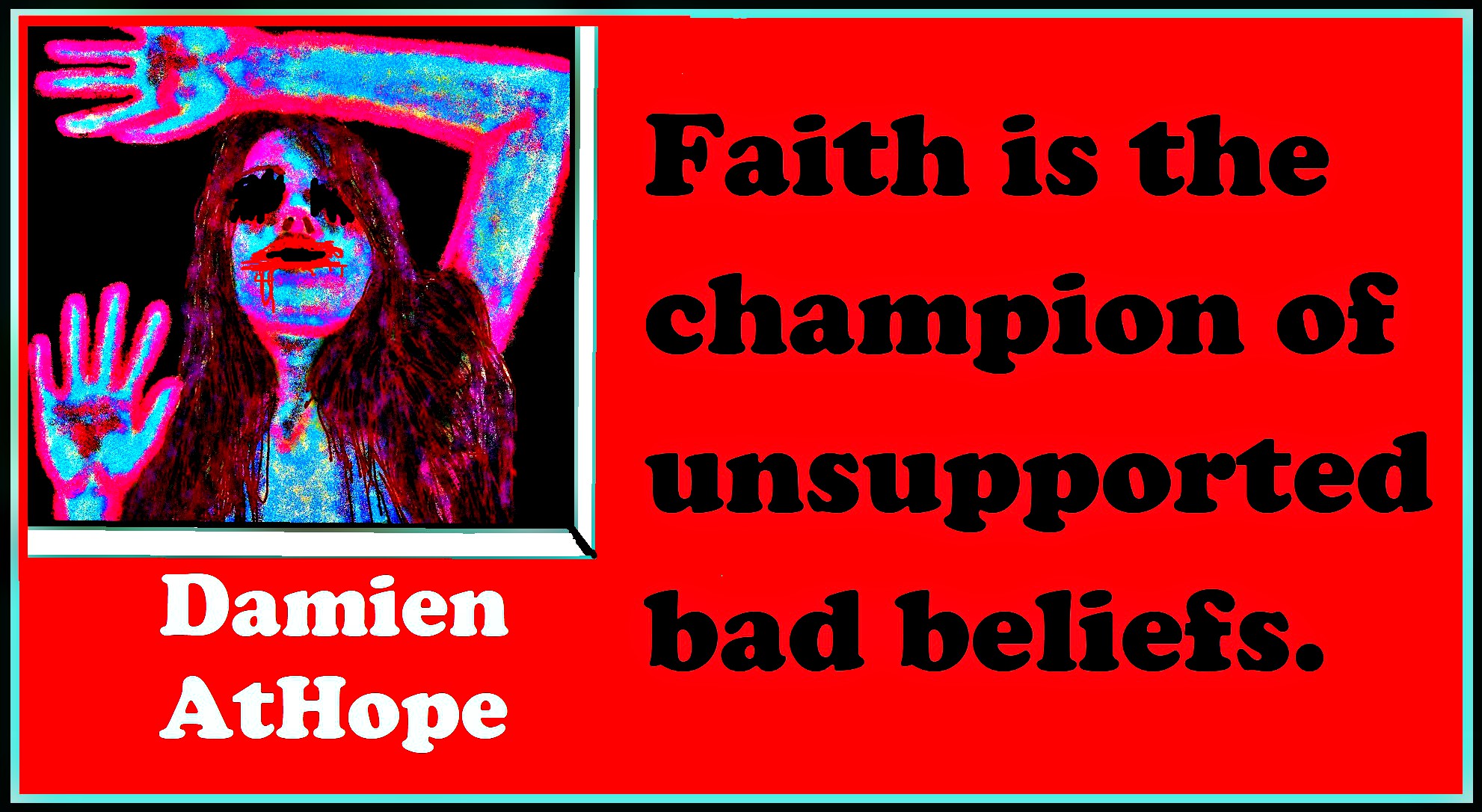
I post lots of religious info but don’t believe in any religion or spiritual beliefs?
I am an atheist, antitheist, and antireligionist. However, I am also a self-taught prehistorian, trying to explain the evolution of religion which requires me to fully understand the connections of religious or spiritual beliefs to allow others to rethink the belief in them. To expose the evolution of religion and thus understand its humanness not just from reason but do to understanding all the facts of archaeology, anthropology, and religious mythology. It is to bring about awareness to inspire others to atheism or at least a new understanding of religion removing its believed special status when religion or spiritual beliefs are, to me, just “culture” or “sociocultural“ products, like language. I don’t believe in gods or ghosts, and nor souls either. I don’t believe in heavens or hells, nor any supernatural anything. I don’t believe in Aliens, Bigfoot, nor Atlantis. I strive to follow reason and be a rationalist. Reason is my only master and may we all master reason.
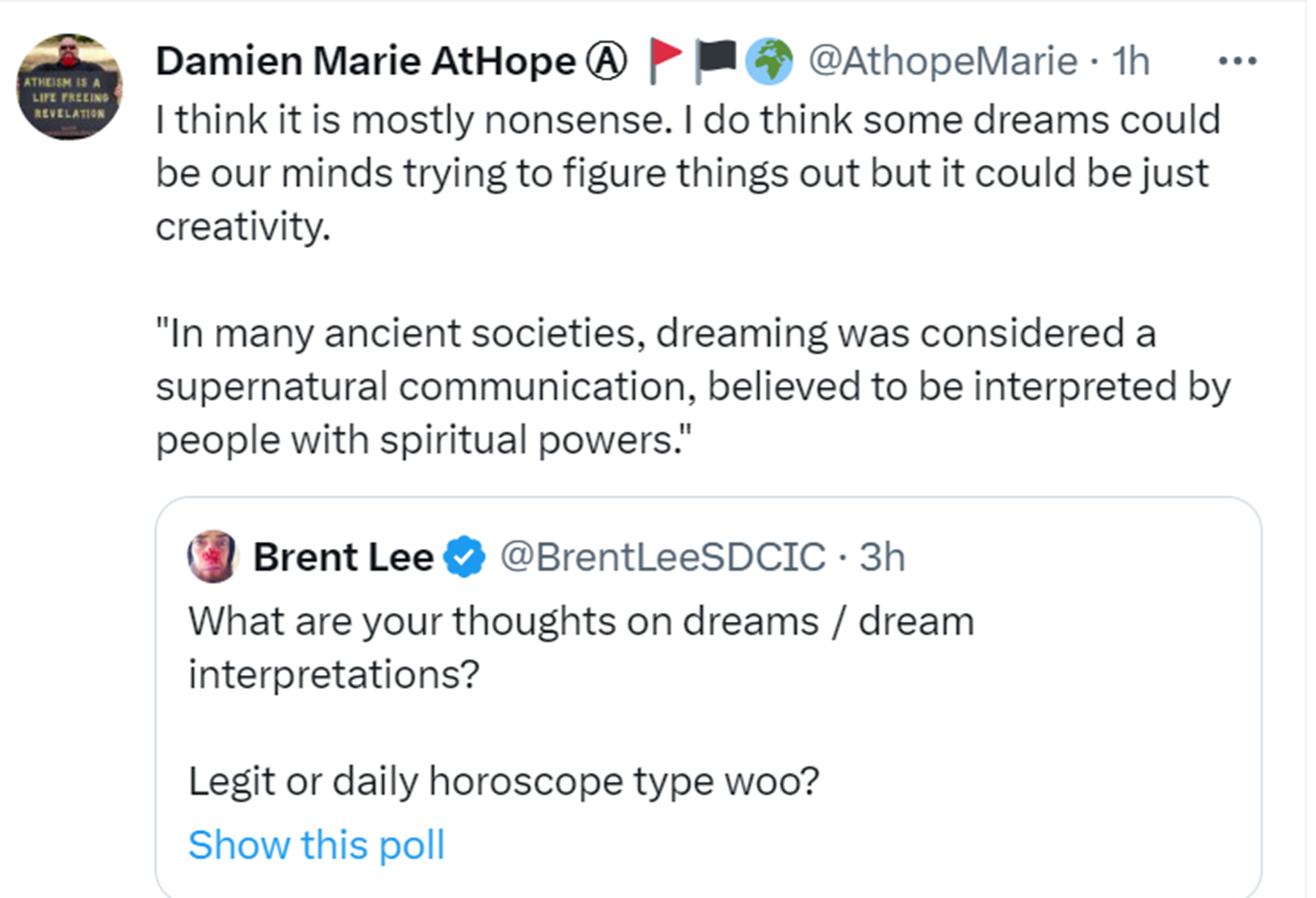
“What are your thoughts on dreams / dream interpretations? Legit or daily horoscope type woo?” – Brent Lee @BrentLeeSDCIC
My response, I think it is mostly nonsense. I do think some dreams could be our minds trying to figure things out but it could be just creativity.
“In many ancient societies, dreaming was considered a supernatural communication, believed to be interpreted by people with spiritual powers.” ref
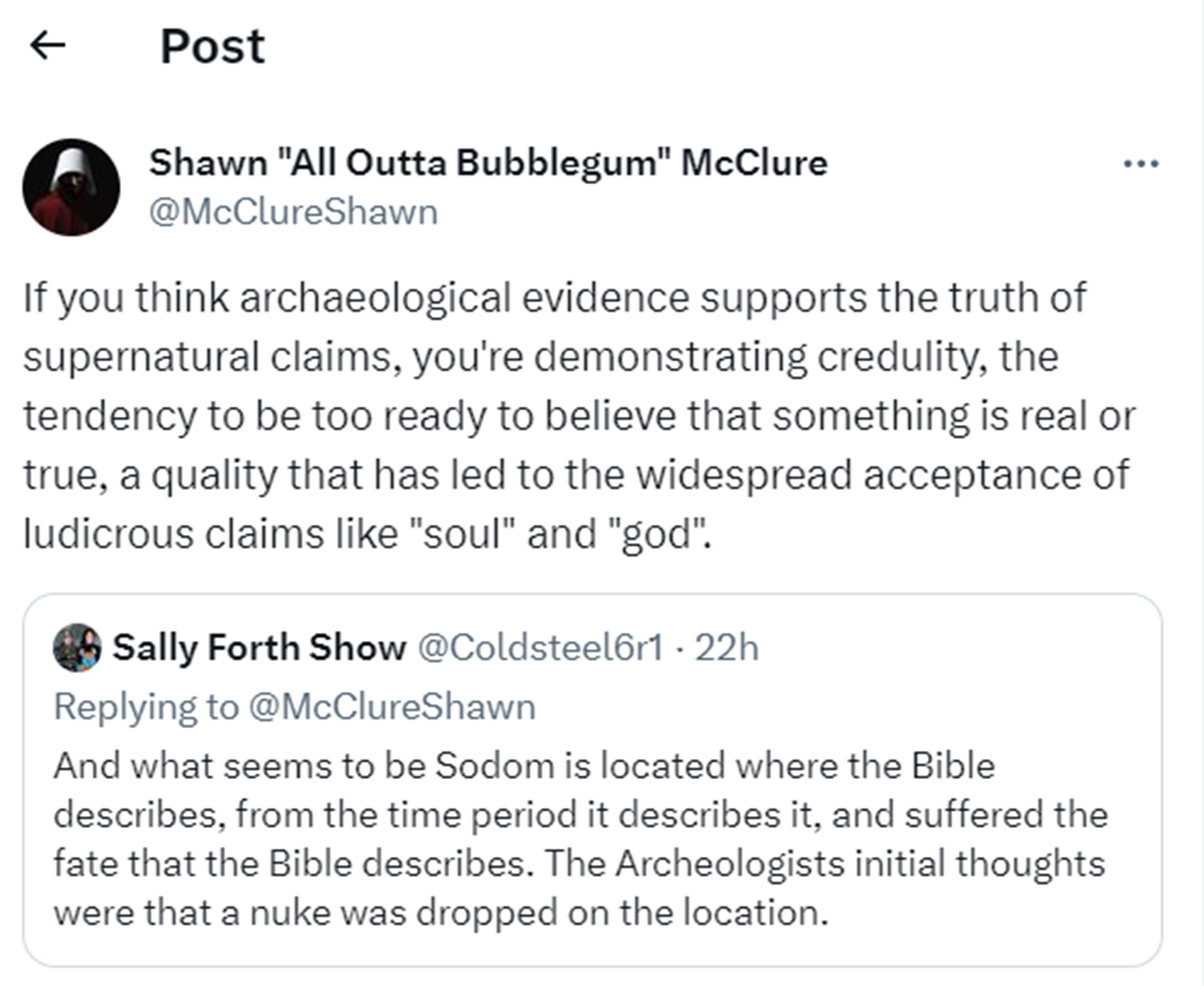
My response, I believe in archaeology and archaeology shows many errors/lies/propaganda in the mythologies in holy books, and this includes the Bible, as well as who the people were/became Jews? Did they have a volcano god?
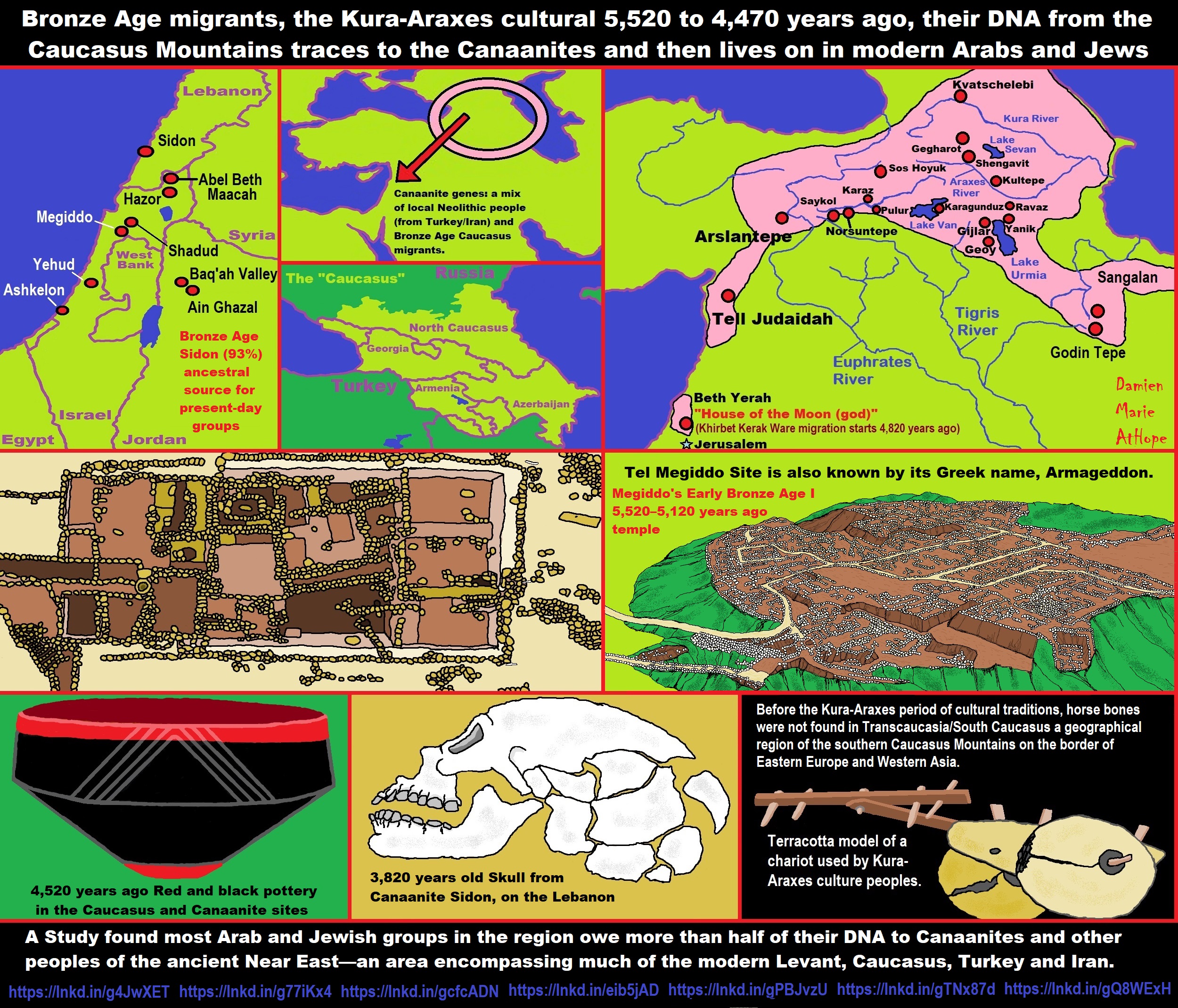
ref, ref, ref, ref, ref, ref, ref, ref, ref, ref, ref, ref
Bronze Age migrants, the Kura-Araxes cultural 5,520 to 4,470 years ago, their DNA from the Caucasus Mountains traces to the Canaanites and then lives on in modern Arabs and Jews. A Study found most Arab and Jewish groups in the region owe more than half of their DNA to Canaanites and other peoples of the ancient Near East—an area encompassing much of the modern Levant, Caucasus, Turkey, and Iran. Before the Kura-Araxes period of cultural traditions, horse bones were not found in Transcaucasia/South Caucasus a geographical region of the southern Caucasus Mountains on the border of Eastern Europe and Western Asia.
“The Kura–Araxes culture, also named Kur–Araz culture, or the Early Transcaucasian culture was a civilization that existed from about 4000 BCE until about 2000 BCE or around 6,020 to 4,020 years ago, which has traditionally been regarded as the date of its end; in some locations, it may have disappeared as early as 2600 or 2700 BCE or around 4,620 to 4,720 years ago. The earliest evidence for this culture is found on the Ararat plain; it spread northward in Caucasus by 3000 BCE or around 5,020 years ago). Altogether, the early Transcaucasian culture enveloped a vast area and mostly encompassed, on modern-day territories, the Southern Caucasus (except western Georgia), northwestern Iran, the northeastern Caucasus, eastern Turkey, and as far as Syria. The name of the culture is derived from the Kura and Araxes river valleys. Kura–Araxes culture is sometimes known as Shengavitian, Karaz (Erzurum), Pulur, and Yanik Tepe (Iranian Azerbaijan, near Lake Urmia) cultures. Furthermore, it gave rise to the later Khirbet Kerak-ware culture found in Syria and Canaan after the fall of the Akkadian Empire. While it is unknown what cultures and languages were present in Kura-Araxes, the two most widespread theories suggest a connection with Hurro-Urartian and/or Anatolian languages.” ref
“The Kura-Araxes cultural tradition existed in the highlands of the South Caucasus from 3500 to 2450 BCE or 5,520 to 4,470 years ago. This tradition represented an adaptive regime and a symbolically encoded common identity spread over a broad area of patchy mountain environments. By 3000 BCE or around 5,020 years ago, groups bearing this identity had migrated southwest across a wide area from the Taurus Mountains down into the southern Levant, southeast along the Zagros Mountains, and north across the Caucasus Mountains. In these new places, they became effectively ethnic groups amid already heterogeneous societies. This paper addresses the place of migrants among local populations as ethnicities and the reasons for their disappearance in the diaspora after 2450 BCE.” ref
“DNA from the Bible’s Canaanites lives on in modern Arabs and Jews: A new study of ancient DNA traces the surprising heritage of these mysterious Bronze Age people. Tel Megiddo was an important Canaanite city-state during the Bronze Age, approximately 3500 to 1200 B.CE or 5,520 to 3,220 years ago. DNA analysis reveals that the city’s population included migrants from the distant Caucasus Mountains. They are best known as the people who lived “in a land flowing with milk and honey” until they were vanquished by the ancient Israelites and disappeared from history. But a scientific report published today reveals that the genetic heritage of the Canaanites survives in many modern-day Jews and Arabs. The study in Cell also shows that migrants from the distant Caucasus Mountains combined with the indigenous population to forge the unique Canaanite culture that dominated the area between Egypt and Mesopotamia during the Bronze Age. The team extracted ancient DNA from the bones of 73 individuals buried over the course of 1,500 years at five Canaanite sites scattered across Israel and Jordan. They also factored in data from an additional 20 individuals from four sites previously reported. “Individuals from all sites are highly genetically similar,” says co-author and molecular evolutionist Liran Carmel of Jerusalem’s Hebrew University.” ref
“So while the Canaanites lived in far-flung city-states, and never coalesced into an empire, they shared genes as well as a common culture. The researchers also compared the ancient DNA with that of modern populations and found that most Arab and Jewish groups in the region owe more than half of their DNA to Canaanites and other peoples who inhabited the ancient Near East—an area encompassing much of the modern Levant, Caucasus, and Iran. The study—a collaborative effort between Carmel’s lab, the ancient DNA lab at Harvard University headed by geneticist David Reich, and other groups—was by far the largest of its type in the region. Its findings are the latest in a series of recent breakthroughs in our understanding of this mysterious people who left behind few written records. Marc Haber, a geneticist at the Wellcome Trust’s Sanger Institute in Hinxton, United Kingdom, co-led a 2017 study of five Canaanite individuals from the coastal town of Sidon. The results showed that modern Lebanese can trace more than 90 percent of their genetic ancestry to Canaanites.” ref
“As Egyptians built pyramids and Mesopotamians constructed ziggurats some 4,500 years ago, the Canaanites began to develop towns and cities between these great powers. They first appear in the historical record around 1800 B.C., when the king of the city-state of Mari in today’s eastern Syria complained about “thieves and Canaanites.” Diplomatic correspondence written five centuries later mentions several Canaanite kings, who often struggled to maintain independence from Egypt. “The land of Canaan is your land and its kings are your servants,” acknowledged one Babylonian monarch in a letter to the Egyptian pharaoh Akhenaten. Biblical texts, written many centuries later, insist that Yahweh promised the land of Canaan to the Israelites after their escape from Egypt. Jewish scripture says the newcomers eventually triumphed, but archaeological evidence doesn’t show widespread destruction of Canaanite populations. Instead, they appear to have been gradually overpowered by later invaders such as the Philistines, Greeks, and Romans.” ref
“Red and black pottery circa 2500 BCE or around 4,520 years old was found in the Caucasus Mountains, as well as at Canaanite sites far to the southwest. The Canaanites spoke a Semitic language and were long thought to derive from earlier populations that settled in the region thousands of years before. But archaeologists have puzzled over red-and-black pottery discovered at Canaanite sites that closely resembles ceramics found in the Caucasus Mountains, some 750 miles to the northwest. Historians also have noted that many Canaanite names derive from Hurrian, a non-Semitic language originating in the Caucasus. Whether this resulted from long-distance trade or migration was uncertain. The new study demonstrates that significant numbers of people, and not just goods, were moving around during humanity’s first era of cities and empires. The genes of Canaanite individuals proved to be a mix of local Neolithic people and the Caucasus migrants, who began showing up in the region around the start of the Bronze Age. Carmel adds that the migration appears to have been more than a one-time event, and “could have involved multiple waves throughout the Bronze Age.” One brother and sister who lived around 1500 B.C. in Megiddo, in what is now northern Israel, were from a family that had migrated relatively recently from the northeast. The team also noted that individuals at two coastal sites—Ashkelon in Israel and Sidon in Lebanon—show slightly more genetic diversity. That may be the result of broader trade links in Mediterranean port towns than inland settlements.” ref
“Glenn Schwartz, an archaeologist at Johns Hopkins University who was not involved in the study, said that the biological data provides important insight into how Canaanites shared a notable number of genes as well as cultural traits. And Haber from the Wellcome Trust noted that the quantity of DNA results is particularly impressive, given the difficulty of extracting samples from old bones buried in such a warm climate that can quickly degrade genetic material. Both Israeli and Palestinian politicians claim the region of Israel and the Palestinian territories is the ancestral home of their people, and maintain that the other group was a late arrival. “We are the Canaanites,” asserted Palestinian Authority President Mahmoud Abbas last year. “This land is for its people…who were here 5,000 years ago.” Israeli Prime Minister Benjamin Netanyahu, meanwhile, said recently that the ancestors of modern Palestinians “came from the Arabian peninsula to the Land of Israel thousands of years” after the Israelites. The new study suggests that despite tumultuous changes in the area since the Bronze Age, “the present-day inhabitants of the region are, to a large extent, descended from its ancient residents,” concludes Schwartz—although Carmel adds that there are hints of later demographic shifts. Carmel hopes to soon expand the findings by collecting DNA from the remains of those who can be identified as Judean, Moabite, Ammonite, and other groups mentioned in the Bible and other texts. “One could analyze ‘Canaanite’ as opposed to ‘Israelite’ individuals,” adds archaeologist Mary Ellen Buck, who wrote a book on the Canaanites. “The Bible claims that these are distinct and mutually antagonistic groups, yet there’s reason to believe that they were very closely related.” ref
“As reported from genome-wide DNA data for 73 individuals from five archaeological sites across the Bronze and Iron Ages Southern Levant. These individuals, who share the “Canaanite” material culture, can be modeled as descending from two sources: (1) earlier local Neolithic populations and (2) populations related to the Chalcolithic Zagros or the Bronze Age Caucasus. The non-local contribution increased over time, as evinced by three outliers who can be modeled as descendants of recent migrants. We show evidence that different “Canaanite” groups genetically resemble each other more than other populations. We find that Levant-related modern populations typically have substantial ancestry coming from populations related to the Chalcolithic Zagros and the Bronze Age Southern Levant. These groups also harbor ancestry from sources we cannot fully model with the available data, highlighting the critical role of post-Bronze-Age migrations into the region over the past 3,000 years.” ref
“The Bronze Age (ca. 3500–1150 BCE) was a formative period in the Southern Levant, a region that includes present-day Israel, Jordan, Lebanon, the Palestinian Authority, and southwest Syria. This era, which ended in a large-scale civilization collapse across this region (Cline, 2014), shaped later periods both demographically and culturally. The following Iron Age (ca. 1150–586 BCE) saw the rise of territorial kingdoms such as biblical Israel, Judah, Ammon, Moab, and Aram-Damascus, as well as the Phoenician city-states. In much of the Late Bronze Age, the region was ruled by imperial Egypt, although in later phases of the Iron Age it was controlled by the Mesopotamian-centered empires of Assyria and Babylonia. Archaeological and historical research has documented major changes during the Bronze and Iron Ages, such as the cultural influence of the northern (Caucasian) populations related to the Kura-Araxes tradition during the Early Bronze Age (Greenberg and Goren, 2009) and effects from the “Sea Peoples” (such as Philistines) from the west in the beginning of the Iron Age (Yasur-Landau, 2010). The inhabitants of the Southern Levant in the Bronze Age are commonly described as “Canaanites,” that is, residents of the Land of Canaan. The term appears in several 2nd millennium BCE sources (e.g., Amarna, Alalakh, and Ugarit tablets) and in biblical texts dating from the 8th–7th centuries BCE and later (Bienkowski, 1999, Lemche, 1991, Na’aman, 1994a). In the latter, the Canaanites are referred to as the pre-Israelite inhabitants of the land (Na’aman, 1994a). Canaan of the 2nd millennium BCE was organized in a system of city-states (Goren et al., 2004), where elites ruled from urban hubs over rural (and in some places pastoral) countryside. The material culture of these city-states was relatively uniform (Mazar, 1992), but whether this uniformity extends to their genetic ancestry is unknown. Although genetic ancestry and material culture are unlikely to ever match perfectly, past ancient DNA analyses show that they might sometimes be strongly associated. In other cases, a direct correspondence between genetics and culture cannot be established. We discuss several examples in the Discussion. Previous ancient DNA studies published genome-scale data for thirteen individuals from four Bronze Age sites in the Southern Levant: three individuals from ‘Ain Ghazal in present-day Jordan, dated to ∼2300 BCE (Intermediate Bronze Age) (Lazaridis et al., 2016); five from Sidon in present-day Lebanon, dated to ∼1750 BCE (Middle Bronze Age) (Haber et al., 2017); two from Tel Shadud in present-day Israel, dated to ∼1250 BCE (Late Bronze Age) (van den Brink et al., 2017); and three from Ashkelon in present-day Israel, dated to ∼1650–1200 BCE (Middle and Late Bronze Age) (Feldman et al., 2019). The ancestry of these individuals could be modeled as a mixture of earlier local groups and groups related to the Chalcolithic people of the Zagros Mountains, located in present-day Iran and designated in previous studies as Iran_ChL (Haber et al., 2017, Lazaridis et al., 2016). The Bronze Age Sidon group could be modeled as a major (93% ± 2%) ancestral source for present-day groups in the region (Haber et al., 2017). A study of Chalcolithic individuals from Peqi’in cave in the Galilee (present-day Israel) showed that the ancestry of this earlier group included an additional component related to earlier Anatolian farmers, which was excluded as a substantial source for later Bronze Age groups from the Southern Levant, with the exception of the coastal groups from Sidon and Ashkelon (Feldman et al., 2019, Harney et al., 2018). These observations point to a degree of population turnover in the Chalcolithic-Bronze Age transition, consistent with archaeological evidence for a disruption between local Chalcolithic and Early Bronze cultures (de Miroschedji, 2014). Addressing three issues: First, we sought to determine the extent of genetic homogeneity among the sites associated with Canaanite material culture. Second, we analyzed the data to gain insights into the timing, extent, and origin of gene flow that brought Zagros- and Caucasus-related ancestry to the Bronze Age Southern Levant. Third, we assessed the extent to which additional gene flow events have affected the region since that time. To address these questions, we generated genome-wide ancient DNA data for 71 Bronze Age and 2 Iron Age individuals, spanning roughly 1,500 years, from the Intermediate Bronze Age to the Early Iron Age. Combined with previously published data on the Bronze and Iron Ages in the Southern Levant, we assembled a dataset of 93 individuals from 9 sites across present-day Israel, Jordan, and Lebanon, all demonstrating Canaanite material culture. We show that the sampled individuals from the different sites are usually genetically similar, albeit with subtle but in some cases significant differences, especially in residents of the coastal regions of Sidon and Ashkelon. Almost all individuals can be modeled as a mixture of local earlier Neolithic populations and populations from the northeastern part of the Near East. However, the mixture proportions change over time, revealing the demographic dynamics of the Southern Levant during the Bronze Age. Finally, we show that the genomes of present-day groups geographically and historically linked to the Bronze Age Levant, including the great majority of present-day Jewish groups and Levantine Arabic-speaking groups, are consistent with having 50% or more of their ancestry from people related to groups who lived in the Bronze Age Levant and the Chalcolithic Zagros. These present-day groups also show ancestries that cannot be modeled by the available ancient DNA data, highlighting the importance of additional major genetic effects on the region since the Bronze Age.” ref
Their Results
DNA from the bones of 73 individuals from 5 archaeological sites in the Southern Levant (Table S1; STAR Methods; Figure 1A):
- Thirty-five individuals from Tel Megiddo (northern Israel), most of whom date to the Middle-to-Late Bronze Age, except for one dating to the Intermediate Bronze Age and one dating to the Early Iron Age
- Twenty-one individuals from the Baq‛ah in central Jordan (northeast of Amman), mostly from the Late Bronze Age
- Thirteen individuals from Yehud (central Israel), dating to the Intermediate Bronze Age
- Three individuals from Tel Hazor (northern Israel) dating to the Middle-to-Late Bronze Age
- One individual from Tel Abel Beth Maacah (northern Israel), dating to the Iron Age ref
“For all analyzed samples but one, DNA was extracted from petrous bones. The DNA was converted to double-indexed half Uracil-DNA glycosylase (UDG)-treated libraries that we enriched for about 1.2 million single nucleotide polymorphism (SNPs) before sequencing (see STAR Methods). The median number of autosomal SNPs covered was 288,863 (range 4,883–945,269). In addition to genetic data, we measured values of strontium isotopes for 12 individuals (and for 8 additional individuals that did not produce DNA) (STAR Methods; Methods S1A), and generated accelerator mass spectrometry radiocarbon dates for 20 individuals (Table S1). We combined our newly generated data with published data for 13 Bronze Age Southern Levant individuals from ‘Ain-Ghazal, Sidon, Tel Shadud, and Ashkelon (van den Brink et al., 2017, Feldman et al., 2019, Haber et al., 2017, Lazaridis et al., 2016), and 7 Iron Age Southern Levant Individuals from Ashkelon (Feldman et al., 2019). The projected the autosomal genetic data onto the plane spanned by the first two principal components of 777 present-day West Eurasian individuals genotyped for roughly 600,000 SNPs on the Affymetrix Human Origins SNP array (Lazaridis et al., 2014). The reserchers restricted the plot to 68 individuals represented by at least 30,000 autosomal SNPs (Figure 1B), a coverage threshold where the ability to infer ancestry was robust to sampling noise (Methods S1B). All Bronze and Iron Age Levant individuals (blue and green shapes) form a tight cluster, except for three outliers from Megiddo, and previously identified outliers from the Ashkelon population known as Iron Age I (IA1) (Feldman et al., 2019). We also ran ADMIXTURE on a set of 1,663 present-day and ancient individuals (see STAR Methods; Figure S1). The ADMIXTURE results are qualitatively consistent with the principal component analysis (PCA), suggesting that all individuals but the outliers from Megiddo and the Ashkelon IA1 population have similar ancestry (Figure 1C). The method described in (Olalde et al., 2019) to identify 17 individuals as being first-, second-, or third-degree relatives of other individuals in the dataset. They fall within seven families: five in Tel Megiddo and two in the Baq‛ah. In most families, we used only the member with the highest SNP coverage in subsequent analyses (Table S1). Two of the three Megiddo outliers are a brother and a sister (Family 4, I2189 and I2200), leaving in the final dataset two individuals marked as outliers. After removing low-coverage individuals and closely related family members, 62 individuals were left for further analysis (Table S1). High Degree of Genetic Affinities between Multiple Sites: The reserch divided the 26 high-coverage individuals from Tel Megiddo into the following groups, on the basis of geographic location, archaeological period, and genetic clustering in PCA (Table S1): Intermediate Bronze Age (Megiddo_IBA, a single individual), Middle-to-Late Bronze Age (Megiddo_MLBA, 22 individuals), Iron Age (Megiddo_IA, a single individual), as well as the two outliers, Megiddo_I2200 and Megiddo_I10100, which were each treated as a separate group. We compared these groups and the other populations in our dataset to previously published data from other sites in the broader region and from earlier periods, including the Early Bronze Age Caucasus (Armenia_EBA), the Middle-to-Late Bronze Age Caucasus (Armenia_MLBA), the Chalcolithic Zagros Mountains (Iran_ChL), the Chalcolithic Caucasus (Armenia_ChL), the Neolithic of the Southern Levant (Levant_N), the Neolithic of the Zagros Mountains (Iran_N), and the Neolithic of Anatolia (Anatolia_N) (Lazaridis et al., 2016).” ref
“To test for variation in ancestry proportions among the Levant Bronze and Iron Age groups, we used qpWave. qpWave tests whether each possible pair of groups (Testi, Testj) is consistent with descending from a common ancestral population—that is, consistent with being a clade—since separation from the ancestors of a set of outgroup populations. qpWave works by computing symmetry test statistics of the form f4(Testi, Testj; Outgroupk, Outgroupl), which have an expected value of zero if (Testi, Testj) form a clade with respect to the outgroups. qpWave then generates a single p value corrected for the empirically measured correlation among the statistics (Reich et al., 2012). Using a distantly related set of outgroups, we found that with the exception of the outliers from Megiddo, Ashkelon IA1, and Sidon, all Bronze and Iron Age Levant groups are consistent with being pairwise clades with respect to the outgroups (Figure 2). We discuss each of qpWave’s findings of significant population substructure in turn. The Megiddo outliers not only fail to form a clade with the other populations, but also with each other. Ashkelon IA1 has previously been reported to harbor European ancestry, and so our finding that it is genetically differentiated from contemporary groups is unsurprising (Feldman et al., 2019). The significant differentiation of the Sidon individuals in qpWave—despite the fact that they roughly cluster with the other Southern Levant Bronze Age groups in PCA and ADMIXTURE—is notable, especially because we find that they are consistent with forming a clade with the two groups from coastal Ashkelon that do not have European-related admixture (the Bronze Age and later Iron Age groups ASH_LBA and ASH_IA2). Speculatively, this observation could be related to the fact that both Sidon and Ashkelon were port towns with connections to other Mediterranean coastal groups outside the Southern Levant, which could have introduced ancestry components that are absent from inland Levantine Bronze Age groups, although it is difficult to test this hypothesis in the absence of high resolution ancient DNA sampling from the eastern Mediterranean rim. The genetic distinctiveness of the Sidon individuals is also compatible with previous findings that Chalcolithic Levantine individuals from Peqi’in Cave are consistent with contributing some ancestry to the Sidon individuals, but not to the ‘Ain Ghazal ones (Harney et al., 2018). We considered the possibility that the significantly different genetic patterns we detect in the Sidon individuals could reflect their different experimental treatment compared with that of the other individuals in this study (shotgun sequencing of non-UDG-treated libraries compared with enrichment of UDG-treated libraries). To test this, we repeated the analyses by using only transversion SNPs, which are less prone to characteristic ancient DNA errors, but found no indication of systematic bias (Wang et al., 2015). However, we did find evidence of substructure within the Sidon individuals, and some but not all were consistent with forming a clade with inland Southern Levant populations, a finding that could reflect substantial cosmopolitan nature of this coastal site (Methods S1C, see Discussion).” ref
“To reveal subtler population structure, we repeated the qpWave analysis adding outgroups that are genetically closer to the test groups, such as Armenia_MLBA and Natufian (Figure 3). With this more powerful set of outgroups, Baq‛ah and Megiddo_IBA also provide evidence of not being pairwise clades with the remaining groups. Thus, beyond the broad observation of genetic affinities between sites, we also observe subtle ancestry heterogeneity across the region during the Bronze Age (see Discussion). Gene Flow into the Southern Levant During the Bronze Age: Two previous studies of Bronze Age individuals from ‘Ain Ghazal and Sidon modeled them as derived from a mixture of earlier local groups (Levant_N) and groups related to peoples of the Chalcolithic Zagros mountains (Iran_ChL) (Haber et al., 2017, Lazaridis et al., 2016). These groups were estimated to harbor around 56%±±3% and 48%±±4% Neolithic Levant-related ancestry for ‘Ain Ghazal (Lazaridis et al., 2016) and Sidon (Haber et al., 2017), respectively. We used qpAdm to estimate that Bronze and Iron Age Ashkelon (ASH_LBA and ASH_IA2) carry 54%±±5% and 42%±±5% Neolithic Levant-related ancestry, respectively. Next, we used qpAdm to test the same model for the data reported here and found that most Middle-to-Late Bronze Age groups fit the model, with point estimates of 48%–57% Levant_N ancestry. These ancestry proportions are statistically indistinguishable (Bonferroni-corrected z test), which corroborates the fact that they are consistent with forming pairwise clades in qpWave (Table S2; Methods S1D). The only group that failed to fit this model was Baq‛ah (p = 0.0003), even when using a wide range of outgroup populations (Table S2). This might be a result of ancestry heterogeneity across the Baq‛ah individuals. To obtain insight into the Zagros-related ancestry component, we focused on two questions: what is the likely origin of this ancestry component and what is its likely timing? Although people of the Chalcolithic Zagros are so far the best proxy population for this ancestry component, there is no archaeological evidence for cultural spread directly from the Zagros into the Southern Levant during the Bronze Age. In contrast, there is archaeological support for connections between Bronze Age Southern Levant groups and the Caucasus (Greenberg and Goren, 2009), a term we use to represent both present-day Caucasus, as well as neighboring regions such as eastern Anatolia (see Discussion). With regard to the timing of these events, archaeology points to cultural affinities between the Kura-Araxes (Caucasus) and Khirbet Kerak (Southern Levant) archaeological cultures in the first half of the 3rd millennium BCE (Greenberg and Goren, 2009), and textual evidence documents a number of non-Semitic, Hurrian (from the northeast of the ancient Near East) personal names in the 2nd millennium BCE, for example in the Amarna archive of the 14th century BCE (Na’aman, 1994b). The reserchers, therefore, reasoned that the Chalcolithic Zagros component might have arrived into the Southern Levant through the Caucasus (and even more proximately the northeastern areas of the ancient Near East, although we have no ancient DNA sampling from this region). This movement might not have been limited to a short pulse, and instead could have involved multiple waves throughout the Bronze Age. To test whether the origin of the gene flow was from the Caucasus, rather than directly from the Zagros region, we ran qpAdm, replacing Iran_ChL with Early Bronze Age Caucasus (Armenia_EBA). We found that the Caucasus model received similar support to that of the Zagros model (Table S2; Methods S1E). Next, we modeled Armenia_EBA as a mixture of an earlier Caucasus population (Chalcolithic Armenia, Armenia_ChL) and Iran_ChL and found that indeed Armenia_EBA is compatible with this model (Table S2). Altogether, we conclude that our data are also compatible with a model in which Zagros-related ancestry in the Southern Levant arrived through the Caucasus, either directly or via intermediates.” ref
“To study the timing of the admixture of Zagros-related ancestry in the Southern Levant, we leveraged the large time span of individuals in our dataset, extending across roughly 1,500 years, from the Intermediate Bronze Age to the Early Iron Age. Using qpAdm-based ancestry estimates for each of the individuals, we found that almost all are compatible with being an admixture of groups related to the Neolithic Levant and Chalcolithic Zagros. One exception to this is an individual in Megiddo_MLBA that is weakly compatible with the model. Another exception is three individuals in the Baq’ah (Table S2), which suggests that the difficulty in modeling individuals from this site as a mixture of Neolithic Levant and Chalcolithic Zagros might reflect ancestry heterogeneity (Figure 3). These results do not change qualitatively when we used a larger set of outgroup populations (Table S2). We observed that the oldest individuals in our collection, from the Intermediate Bronze Age, already carried significant Zagros-related ancestry, suggesting that gene flow into the region started before ca. 2400 BCE. This is consistent with the hypothesis that people of Kura-Araxes archaeological complex of the 3rd millennium BCE might have affected the Southern Levant not only culturally, but also through some degree of movement of people. Our data also imply an increase in the proportion of Zagros-related ancestry after the Intermediate Bronze Age, as reflected in a significantly positive slope in a linear regression of the Chalcolithic-Zagros-related ancestry over the calendar year (β=1.4⋅104±0.4⋅104β=1.4⋅104±0.4⋅104, Jackknife), amounting to an increase of ∼14% per thousand years (Figures 4 and S2A). However, we caution that the number of individuals and their time span are insufficient to determine whether the increase in the Zagros-related ancestry happened continuously during the Middle and Late Bronze Ages, or whether there were multiple distinct migration events. The two outliers from Megiddo (three including the sibling pair) provide additional evidence for the timing and origin of gene flow into the region. The three were found in close proximity to each other at Level K-10, which is radiocarbon dated to 1581–1545 BCE (domestic occupation) and 1578–1421 BCE (burials; both ± 1 s) (Martin et al., 2020, Toffolo et al., 2014), whereas the bone of one of the three (I10100) was directly dated (1688–1535 BCE, ± 2Σ). The reason these individuals are distinct from the rest is that their Caucasus- or Zagros-related genetic component is much higher, reflecting ongoing gene flow into the region from the northeast (Table S2; Figure S2B). The Neolithic Levant component is 22%–27% in I2200, and 9%–26% in I10100. These individuals are unlikely to be first generation migrants, as strontium isotope analysis on the two outlier siblings (I2189 and I2200) (Methods S1A) suggests that they were raised locally. This implies that the Megiddo outliers might be descendants of people who arrived in recent generations. Direct support for this hypothesis comes from the fact that in sensitive qpAdm modeling (including closely related sets of outgroups), the only working northeast source population for these two individuals is the contemporaneous Armenia_MLBA, whereas the earlier Iran_ChL and Armenia_EBA do not fit (Table S2). The addition of Iran_ChL to the set of outgroups does not change this result or cause model failure. Finally, no other Levantine group shows a similar admixture pattern (Table S2). This shows that some level of gene flow into the Levant took place during the later phases of the Bronze Age and suggests that the source of this gene flow was the Caucasus. Altogether, our analyses show that gene flow into the Levant from people related to those in the Caucasus or Zagros was already occurring by the Intermediate Bronze Age, and that it lingered, episodically or continuously, at least in inland sites, during the Middle-to-Late Bronze Age.” ref
Further Change in Levantine Populations Since the Bronze Age
“To develop a sense of population changes in the Levant since the Bronze Age, we attempted to model groups that have a tradition of descent from ancient people in the region (Jews) as well as Levantine Arabic-speakers as mixtures of various ancient source populations. qpAdm assumes no admixture between groups related to the outgroups and the source populations, but almost all present-day Levantine and Mediterranean populations have significant sub-Saharan-African-related admixture that the ancient groups did not. This eliminates many key outgroups for qpAdm and reduces the utility of the method in this context. In particular, we were not able to apply qpAdm to get a single working model for the majority of present-day West Eurasian populations. As an alternative, we developed a methodology we call LINADMIX, which relies on the output of ADMIXTURE (Alexander et al., 2009) and uses constrained least-squares to estimate the contribution of given source populations to a target population (see STAR Methods). As a complementary approach, we developed a tool we call pseudo-haplotype ChromoPainter (PHCP), which is an adaptation of the haplotype-based method ChromoPainter (Lawson et al., 2012) to ancient genomes (see STAR Methods; Methods S1F). We first established that these methods provide meaningful estimates of ancestry in the context of this study by using them to re-compute the ancestry proportions that we were able to model with qpAdm. Both LINADMIX and PHCP (Table S3; Figure S3; Methods S1F) produce qualitatively similar estimates as qpAdm (Table S2). To further establish the methods, we performed simulations that were designed to test the methods’ abilities to infer ancestry proportions in present-day populations in a setup similar to the current study (Methods S1H). For this, we generated present-day populations as a mixture of two closely related ancient populations with and without a third, more distant, population. Both methods estimated the ancestry proportion of the distant source population with errors of up to 4% and the proportions of the closely related source populations with errors of up to 10%. Thus, although ADMIXTURE, the basis of LINADMIX, is known to have certain pitfalls as a tool for quantifying ancestry proportions (Lawson et al., 2018), in the case of individuals with ancestry sources similar to those we have analyzed here, our results suggest that both LINADMIX and PHCP are highly informative. For the LINADMIX analysis of present-day populations, we used a background dataset of 1,663 present-day and ancient individuals from 239 populations genotyped by using SNP arrays and focused our analysis on 14 Jewish and Levantine present-day populations, along with modern English, Tuscan, and Moroccan populations that were used as controls. We used LINADMIX to model each of the 17 present-day populations as an admixture of four sources: (1) Megiddo_MLBA (the largest group) as a representative of the Middle-to-Late Bronze Age component; (2) Iran_ChL as a representative of the Zagros and the Caucasus; (3) Present-day Somalis as representatives of an Eastern African source (in the absence of genetic data on ancient populations from the region); and (4) Europe_LNBA as a representative of ancient Europeans from the Late Neolithic and Bronze Age (Methods S1I; Table S4; Figure S4). We also applied PHCP to these 17 present-day populations (Methods S1G; Table S4; Figure S4). Comparison of PHCP and LINADMIX shows that they agree well with respect to the Somali and Europe_LNBA component, and therefore also for the combined contribution of Iran_ChL and Megiddo_MLBA (Methods S1G; Figure S4). However, they deviate regarding the respective contributions of Iran_ChL and Megiddo_MLBA (Figure S4), likely because of the fact that the Megiddo_MLBA and Iran_ChL are already very similar populations (Table S3). To only consider results that are robust and shared by LINADMIX and PHCP, we have combined Megiddo_MLBA and Iran_ChL to a single source population representing the Middle East for our main results (Figure 5). We further verified these conclusions, as well as the robustness of the estimations, by using a different representative for the Bronze Age Levantine groups as a source (Tables S4 and S5; Methods S1J) and using perturbations to the ADMIXTURE parameters (Table S4; Methods S1K). Combined, these results suggest that modern populations related to the Levant are consistent with having a substantial ancestry component from the Bronze Age Southern Levant and the Chalcolithic Zagros. Nonetheless, other potential ancestry sources are possible, and more ancient samples might enable a refined picture (Table S4).” ref
The results show that since the Bronze Age, an additional East-African-related component was added to the region (on average ∼10.6%, excluding Ethiopian Jews who harbor ∼80% East African component), as well as a European-related component (on average ∼8.7%, excluding Ashkenazi Jews who harbor a ∼41% European-related component). The East-African-related component is highest in Ethiopian Jews and North Africans (Moroccans and Egyptians). It exists in all Arabic-speaking populations (apart from the Druze). The European-related component is highest in the European control populations (English and Tuscan), as well as in Ashkenazi and Moroccan Jews, both having a history in Europe (Atzmon et al., 2010, Carmi et al., 2014, Schroeter, 2008). This component is present, although in smaller amount, in all other populations except for Bedouin B and Ethiopian Jews. As expected, the English and Tuscan populations have a very low Middle-Eastern-related component. Whereas LINADMIX and PHCP have high uncertainty in estimating the relative contributions of Megiddo_MLBA and Iran_ChL, the results and simulations nevertheless suggest that additional Zagros-related ancestry has penetrated the region since the Bronze Age (Methods S1I). Except for the populations with the highest Zagros-related component, PHCP estimates lower magnitudes of this component (Figure S4A), and therefore detection by PHCP of a Zagros-related ancestry is likely an indication for the presence of this component. Indeed, examining the results of LINADMIX and PHCP on all four source populations (Figure S4), we observe a relatively large Zagros-related component in many Arabic-speaking groups, suggesting that gene flow from populations related to those of the Zagros and Caucasus (although not necessarily from these specific regions) continued even after the Iron Age (Methods S1I). Altogether, the patterns of the present-day populations reflect demographic processes that occurred after the Bronze Age and are plausibly related to processes known from the historical literature (Methods S1I). These include an Eastern-African-related component that is present in Arabic-speaking groups but is lower in non-Ethiopian Jewish groups, as well as Zagros-related contribution to Levantine populations, which is highest in the northernmost population examined, suggesting a contribution of populations related to the Zagros even after the Bronze and Iron Ages. The results provide a comprehensive genetic picture of the primary inhabitants of the Southern Levant during the 2nd millennium BCE, known in the historical record and based on shared material culture as “Canaanites.” We carried out a detailed analysis aimed at answering three basic questions: how genetically homogeneous were these people, what were their plausible origins with respect to earlier peoples, and how much change in ancestry has there been in the region since the Bronze Age? Earlier genetic analyses modeled the genomes of Middle-to-Late Bronze Age people of the Southern Levant as having almost equal shares of earlier local populations (Levant_N) and populations that are related to the Chalcolithic Zagros (Feldman et al., 2019, Haber et al., 2017, Lazaridis et al., 2016), suggesting a movement from the northeast into the Southern Levant. Here, we provide more details on this process, taking into account evidence from both archaeology and our temporally and geographically diverse genetic data. Because there is little archaeological evidence of a direct cultural connection between the Southern Levant and the Zagros region in this period, the Caucasus is a more likely source for this ancestry. We used our data to compare these two scenarios and concluded that the genetic data are compatible with both.” ref
“The Megiddo outliers, which we inferred to be relative newcomers to the region, are particularly important in demonstrating that the gene flow continued throughout the Bronze Age and that at least some of the gene flow likely came from the Caucasus rather than the Zagros. These two individuals have the highest proportions of Zagros- or Caucasian-related ancestry in our dataset. Analysis of these outliers gave significantly stronger evidence of a Caucasus source compared with a Zagros one, although this conclusion might be revised once ancient DNA data from the Middle-to-Late Bronze Age in the Zagros region become available. The two Megiddo individuals with the next lowest Neolithic Levant component (I10769 and I10770, brothers) were found near the monumental tomb that was likely related to the palace at Megiddo, raising the possibility that they might be associated with the ruling caste. Indeed, a ruler of Taanach (a town located immediately to the south of Megiddo) mentioned in a 15th century BCE cuneiform tablet found at the site and the rulers of Megiddo and Taanach mentioned in the 14th century BCE Amarna letters (found in Egypt) carry Hurrian names (a language spoken in the northeast of the ancient Near East, possibly including the Caucasus) (Na’aman, 1994b). This provides some evidence—albeit so far only suggestive—that at least some of the ruling groups in these (and other) cities might have originated from the northeast of the ancient Near East. The Caucasus is represented in this study by ancient groups from the present-day country of Armenia, but the region known to have had cultural ties with the Southern Levant is much broader. Evidence of cultural effects on the Southern Levant is mainly focused on the Kura-Araxes culture during the Early Bronze Age (archaeology) and on the Hurrians during the Middle-to-Late Bronze Age (linguistic testimony). These two complexes were spread over the Caucasus, Eastern Anatolia, and neighboring regions. The Armenian sites we analyzed are the best representatives to date of these cultures. The Early Bronze Age individuals from Armenia (Armenia_EBA) come from an Early Bronze Age Kura-Araxes burial ground, and the later Middle-to-Late Bronze Age individuals (Armenia_MLBA) come from the Aragatsotn Province in northwestern Armenia. It is important to note that the Neolithic and Chalcolithic Anatolian individuals analyzed in this study come from the northwestern part of Anatolia, which is not part of the Caucasus. The Chalcolithic Zagros individuals come from the Kangavar Valley in Iran, which is located on the border of the Kura-Araxes influence.” ref
“The term “Canaanites” is loosely defined, referring to a collection of groups (which in the Bronze Age were organized in a city-state system) and thus in principle could lack genetic coherence. The individuals examined here cover a wide geographic span—coming from nine sites in present-day Lebanon, Israel, and Jordan. Our analyses revealed that, with the exception of Sidon (and to a smaller extent the individuals of the Baq‛ah), they are homogeneous in the sense of being closer to each other than to other contemporary and neighboring populations. This suggests that the archaeological and historical category of “Canaanites” correlates with shared ancestry (Eisenmann et al., 2018). This resembles the pattern observed in the Aegean basin during the 2nd millennium BCE, where the cultural categories of “Minoan” and “Mycenaean” show evidence of genetic homogeneity across multiple sites albeit with potentially subtle ancestry differences within these groupings (Lazaridis et al., 2017). Another example is the “Yamnaya” pastoralists of late 3rd and early 2nd millennium BCE in the western Eurasian Steppe (Allentoft et al., 2015, Haak et al., 2015). This contrasts with the pattern seen in other places, such as for the Bell Beaker cultural complex of the 2nd millennium BCE (Olalde et al., 2018), where people sharing similar cultural practices had widely varying ancestry. In any case, the detection of such associations—as we do here—cannot by itself prove that group identities in the past were related to genetics. From the groups we have examined, the only one that is somewhat diverged from the rest is Sidon. We provide evidence against the possibility that this observation is a batch effect (Methods S1C). Rather, we suggest that the relative remoteness of Sidon stems from the fact that this population is genetically heterogeneous and has different individuals showing resemblance to different Southern Levantine groups (Methods S1C). During the 2nd millennium BCE, Sidon was a major port city and was connected in trading relations with the eastern Mediterranean basin, which could have led to a significant genetic inflow, making its population more heterogeneous than that of inland cities. This might also be the reason that the site that most resembles Sidon is Ashkelon, which is another coastal site. The only inland population that resembles Sidon is Abel Beth Maacah, perhaps because of its geographic proximity (Figures 1A and 2). Apart from Sidon, Baq‛ah also shows some minor deviations from the rest when taking a richer set of outgroup populations (Figure 3). The Baq‛ah is located on the fringe of the Syrian desert, therefore this population might be admixed with more eastern groups, which are not yet genetically sampled. This might be reflected by the fact that the individuals of the Baq‛ah also show some degree of variability in their ancestry patterns (Table S2).” ref
“Although this study focuses on the Bronze Age, it also reports two new samples from the Iron Age—one from Megiddo and the other from Abel Beth Maacah. These two individuals show ancestry patterns that are very similar to those observed in the Middle and Late Bronze Age individuals (Figure 4), suggesting that the destruction at the end of the Bronze Age in the region did not necessarily lead to genetic discontinuity in each and every site. Notably, both Abel Beth Maacah and Megiddo are inland cities, and their genetic continuity throughout the transition from the Bronze Age to the Iron Age might not be representative of other sites in the region. For example, one of the two Iron Age populations in the Philistine coastal city of Ashkelon (ASH_IA1) showed evidence of mobility of populations related to southern Europe around the Bronze Age to Iron Age transition (Feldman et al., 2019). Estimating the ancestry proportions in present-day Middle Eastern populations with substantial sub-Saharan African admixture (as well as multiple sources of admixture from different parts of the Mediterranean), is difficult. We addressed the problem by developing two statistical techniques and then testing the robustness of our inference on the basis of a comparison between these methods, simulations, and perturbations of the input (see STAR Methods; Methods S1F–S1K). We examined 14 present-day populations that are historically or geographically linked to the Southern Levant and tested the contributions of East Africa, Europe, and the Middle East (combining Southern Levant Bronze Age populations and Zagros-related Chalcolithic ones) to their ancestry. We found that both Arabic-speaking and Jewish populations are compatible with having more than 50% Middle-Eastern-related ancestry. This does not mean that any these present-day groups bear direct ancestry from people who lived in the Middle-to-Late Bronze Age Levant or in Chalcolithic Zagros; rather, it indicates that they have ancestries from populations whose ancient proxy can be related to the Middle East. The Zagros- or Caucasian-related ancestry flow into the region apparently continued after the Bronze Age. We also see an Eastern-African-related ancestry entering the region after the Bronze Age with an approximate south-to-north gradient. In addition, we observe a European-related ancestry with the opposite gradient (north-to-south). Given the difficulties in separating the ancestry components arriving from the Southern Levant and the Zagros, an important direction for future work will be to reconstruct in high resolution the ancestry trajectories of each present-day group, and to understand how people from the Southern Levant Bronze Age mixed with other people in later periods in the context of processes known from the rich archaeological and historical records of the last three millennia.” ref
“The Kura-Araxes cultural tradition is reflected in the mountains north, east and west of Mesopotamia from the mid-fourth to mid-third millennia BC. Originating in the Armenian Highlands and its subset the South Caucasus, it developed over that period, and also spread across a wide area of the Taurus and Zagros mountains, down into the Southern Levant, and north beyond the Caucasus Mountains. Despite many decades of excavation of sites relating to this cultural tradition, we know surprisingly little about the societies of the homelands and their relationship to their migrant diaspora. This paper looks at one aspect of those cultures, ritual practice and ideology, to see if it is possibly better to define the nature of and changes in Kura-Araxes societies within the homelands, and their possible relationship to migrant communities.” ref
“Excavation of the early 3rd millennium levels at Arslantepe-Malatya, which reveal substantial changes following the collapse of the Late Chalcolithic centralized system in connection with the establishment of new groups linked to the Kura-Araxes culture . The new data show that these early 3rd millennium settlements, besides marking a break with respect to the earlier Chalcolithic period and a radically new organization, interestingly also show more elements of continuity than previously thought in the maintenance of a central role for Arslantepe in the Malatya region and in the continuation of some traditions such as those related to metallurgy. Rather than a momentary intrusion of pastoral communities of Transcaucasian origin, the new picture suggests the temporary appropriation of the site by mobile, probably transhumant groups moving in a wide area around the plain and already well-rooted in the region; after the destruction of the 4th millennium (4000 through 3000 BCE or around 6,020 to 5,020 years ago) palace, they used Arslantepe as their power center and landmark, probably competing with the local rural population for the control of the site and the region. This article presents the main results obtained during the recent excavation of levels from the beginning of the 3rd millennium in Arslantepe-Malatya, levels which revealed profound changes after the collapse of the centralized system of the Late Chalcolithic, in connection with the installation. on the site new population groups linked to the Kura-Araxe culture. Besides the fact that they mark a break with the Chalcolithic and testify to a radically new organization, recent data show that these occupations of the beginning of the 3rd millennium also present more elements of continuity than previously thought in the maintenance of the central role d’Arslantepe in the region of Malatya and in the pursuit of certain traditions such as those related to metallurgy. The image that is emerging now suggests the temporary appropriation of the site by mobile groups, probably transhumant, moving over a large area around the [Malatya] plain and already well established in this region, more than a temporary intrusion. pastoral communities from Transcaucasia. After the destruction of the 4th millennium palace.” ref
The formative processes of the Kura-Araxes cultural complex, and the date and circumstances of its rise, have been long debated. Shulaveri-Shomu culture preceded the Kura–Araxes culture in the area. There were many differences between these two cultures, so the connection was not clear. Later, it was suggested that the Sioni culture of eastern Georgia possibly represented a transition from the Shulaveri to the Kura-Arax cultural complex. At many sites, the Sioni culture layers can be seen as intermediary between Shulaver-Shomu-Tepe layers and the Kura-Araxes layers. This kind of stratigraphy warrants a chronological place of the Sioni culture at around 4000 BCE. Nowadays scholars consider the Kartli area, as well as the Kakheti area (in the river Sioni region) as key to forming the earliest phase of the Kura–Araxes culture. To a large extent, this appears as an indigenous culture of Caucasus that was formed over a long period, and at the same time incorporating foreign influences. There are some indications (such as at Arslantepe) of the overlapping in time of the Kura-Araxes and Uruk cultures; such contacts may go back even to the Middle Uruk period. Some scholars have suggested that the earliest manifestation of the Kura-Araxes phenomenon should be dated at least to the last quarter of the 5th millennium BC. This is based on the recent data from Ovçular Tepesi, a Late Chalcolithic settlement located in Nakhchivan by the Arpaçay river.” ref
Kura-Araxes Cultural Expansion
“They proceed westward to the Erzurum plain, southwest to Cilicia, and to the southeast into the area of Lake Van, and below the Urmia basin in Iran, such as to Godin Tepe. Finally, it proceeded into present-day Syria (Amuq valley), and as far as Palestine. Its territory corresponds to large parts of modern Armenia, Azerbaijan, Chechnya, Dagestan, Georgia, Ingushetia, North Ossetia, and parts of Iran and Turkey. At Sos Hoyuk, in Erzurum Province, Turkey, early forms of Kura-Araxes pottery were found in association with local ceramics as early as 3500-3300 BC. During the Early Bronze Age in 3000-2200 BC, this settlement was part of the Kura-Araxes phenomenon. At Arslantepe, Turkey, around 3000 BCE, there was widespread burning and destruction, after which Kura-Araxes pottery appeared in the area. According to Geoffrey Summers, the movement of Kura-Araxes peoples into Iran and the Van region, which he interprets as quite sudden, started shortly before 3000 BC, and may have been prompted by the ‘Late Uruk Collapse’ (end of the Uruk period), taking place at the end of Uruk IV phase c. 3100 BC.” ref
“Archaeological evidence of inhabitants of the Kura–Araxes culture showed that ancient settlements were found along the Hrazdan river, as shown by drawings at a mountainous area in a cave nearby. Structures in settlements have not revealed much differentiation, nor was there much difference in size or character between settlements, facts that suggest they probably had a poorly developed social hierarchy for a significant stretch of their history. Some, but not all, settlements were surrounded by stone walls. They built mud-brick houses, originally round, but later developing into subrectangular designs with structures of just one or two rooms, multiple rooms centered around an open space, or rectilinear designs. At some point, the culture’s settlements and burial grounds expanded out of lowland river valleys and into highland areas. Although some scholars have suggested that this expansion demonstrates a switch from agriculture to pastoralism and that it serves as possible proof of a large-scale arrival of Indo-Europeans, facts such as that settlement in the lowlands remained more or less continuous suggest merely that the people of this culture were diversifying their economy to encompass crop and livestock agriculture. Shengavit Settlement is a prominent Kura-Araxes site in present-day Yerevan area in Armenia. It was inhabited from approximately 3200 BC cal to 2500 BC cal. Later on, in the Middle Bronze Age, it was used irregularly until 2200 BC cal. The town occupied an area of six hectares, which is large for Kura-Araxes sites.” ref
Kura-Araxes Ritual Mounds
“In the 3rd millennium B.C., one particular group of mounds of the Kura–Araxes culture is remarkable for their wealth. This was the final stage of culture’s development. These burial mounds are known as the Martqopi (or Martkopi) period mounds. Those on the left bank of the river Alazani are often 20–25 meters high and 200–300 meters in diameter. They contain especially rich artefacts, such as gold and silver jewelry. Inhumation practices are mixed. Flat graves are found but so are substantial kurgan burials, the latter of which may be surrounded by cromlechs. This points to a heterogeneous ethno-linguistic population. Analyzing the situation in the Kura-Araxes period, T.A. Akhundov notes the lack of unity in funerary monuments, which he considers more than strange in the framework of a single culture; for the funeral rites reflect the deep culture-forming foundations and are weakly influenced by external customs. There are non-kurgan and kurgan burials, burials in-ground pits, in stone boxes and crypts, in the underlying ground strata, and on top of them; using both the round and rectangular burials; there are also substantial differences in the typical corpse position. Burial complexes of Kura–Araxes culture sometimes also include cremation. Here one can come to the conclusion that the Kura–Araxes culture developed gradually through a synthesis of several cultural traditions, including the ancient cultures of the Caucasus and nearby territories.” ref
‘Origin of Early Transcaucasian Culture (aka Kura-Araxes culture)
From the paper:
Akhundov (2007) recently uncovered pre-Kura-Araxes/Late Chalcolithic materials from the settlement of Boyuk Kesik and the kurgan necropolis of Soyuq Bulaq in northwestern Azerbaijan, and Makharadze (2007) has also excavated a pre-Kura-Araxes kurgan, Kavtiskhevi, in central Georgia. Materials recovered from both these recent excavations can be related to remains from the metal-working Late Chalcolithic site of Leilatepe on the Karabakh steppe near Agdam (Narimanov et al. 2007) and from the earliest level at the multi-period site of Berikldeebi in Kvemo Kartli (Glonti and Dzavakhishvili 1987). They reveal the presence of early 4th millennium raised burial mounds or kurgans in the southern Caucasus. Similarly, on the basis of her survey work in eastern Anatolia north of the Oriental Taurus mountains, C. Marro (2007)likens chafffaced wares collected at Hanago in the Sürmeli Plain and Astepe and Colpan in the eastern Lake Van district in northeastern Turkey with those found at the sites mentioned above and relates these to similar wares (Amuq E/F) found south of the Taurus Mountains in northern Mesopotamia
…
The new high dating of the Maikop culture essentially signifies that there is no
chronological hiatus separating the collapse of the Chalcolithic Balkan centre of
metallurgical production and the appearance of Maikop and the sudden explosion of Caucasian metallurgical production and use of arsenical copper/bronzes. More than forty calibrated radiocarbon dates on Maikop and related materials now support this high chronology; and the revised dating for the Maikop culture means that the earliest kurgans occur in the northwestern and southern Caucasus and precede by several centuries those of the Pit-Grave (Yamnaya) cultures of the western Eurasian steppes (cf. Chernykh and Orlovskaya 2004a and b). The calibrated radiocarbon dates suggest that the Maikop ‘culture’ seems to have had a formative influence on steppe kurgan burial rituals and what now appears to be the later development of the Pit-Grave (Yamnaya) culture on the Eurasian steppes (Chernykh and Orlovskaya 2004a: 97).
…
In other words, sometime around the middle of the 4th millennium BCE or slightly subsequent to the initial appearance of the Maikop culture of the NW Caucasus, settlements containing proto-Kura-Araxes or early Kura-Araxes materials first appear across a broad area that stretches from the Caspian littoral of the northeastern Caucasus in the north to the Erzurum region of the Anatolian Plateau in the west. For simplicity’s sake these roughly simultaneous developments across this broad area will be considered as representing the beginnings of the Early Bronze Age or the initial stages of development of the KuraAraxes/Early Transcaucasian culture.
…
The ‘homeland’ (itself a very problematic concept) of the Kura-Araxes culture-historical community is difficult to pinpoint precisely, a fact that may suggest that there is no single well-demarcated area of origin, but multiple interacting areas including northeastern Anatolia as far as the Erzurum area, the catchment area drained by the Upper Middle Kura and Araxes Rivers in Transcaucasia and the Caspian corridor and adjacent mountainous regions of northeastern Azerbaijan and southeastern Daghestan. While broadly (and somewhat imprecisely) defined, these regions constitute on present evidence the original core area out of which the Kura-Araxes ‘culture-historical community’ emerged.
Kura-Araxes materials found in other areas are primarily intrusive in the local sequences. Indeed, many, but not all, sites in the Malatya area along the Upper Euphrates drainage of eastern Anatolia (e.g., Norsun-tepe, Arslantepe) and western Iran (e.g., Yanik Tepe, Godin Tepe) exhibit— albeit with some overlap—a relatively sharp break in material remains, including new forms of architecture and domestic dwellings, and such changes support the interpretation of a subsequent spread or dispersal from this broadly defined core area in the north to the southwest and southeast. The archaeological record seems to document a movement of peoples north to south across a very extensive part of the Ancient Near East from the end of the 4th to the first half of the 3rd millennium BCE. Although migrations are notoriously difficult to document on archaeological evidence, these materials constitute one of the best examples of prehistoric movements of peoples available for the Early Bronze Age.” ref
Origins, Homelands and Migrations: Situating the Kura-Araxes Early Transcaucasian ‘Culture’ within the History of Bronze Age Eurasia
“This paper summarizes the current understanding of the emergence, nature and subsequent southwestern and southeastern spread of the early Transcaucasian (eTC) or Kura-Araxes ‘culture-historical community’ (Russian: obshchnost’) and then places this complex cultural phenomenon in the context of the larger early Bronze Age world of the Ancient Near East and the western Eurasian steppes.” ref
Early Bronze Age migrants and ethnicity in the Middle Eastern mountain zone
“This analysis shows the complex interaction of ethnic groups in antiquity, adapting to new locations and adopting and ultimately, assimilating into a majority culture. It occurs in a background of mountain valleys and highland plains, where ever-shifting populations carve out a living and an identity.” ref
Abstract
“The Kura-Araxes cultural tradition existed in the highlands of the South Caucasus from 3500 to 2450 BCE (before the Christian era). This tradition represented an adaptive regime and a symbolically encoded common identity spread over a broad area of patchy mountain environments. By 3000 BCE, groups bearing this identity had migrated southwest across a wide area from the Taurus Mountains down into the southern Levant, southeast along the Zagros Mountains, and north across the Caucasus Mountains. In these new places, they became effectively ethnic groups amid already heterogeneous societies. This paper addresses the place of migrants among local populations as ethnicities and the reasons for their disappearance in the diaspora after 2450 BCE.” ref
Kura-Araxes Case
“The societies of the so-called Kura-Araxes cultural tradition that emerged in the highlands during the fourth millennium and continued into the early third millennium BCE (before the Christian era)—Shengavitian, Karaz, Pulur, Yanik, Early Transcaucasian, and Khirbet Kerak are some of its other names—present scholars of the Greater Middle East and Eurasia with a laboratory for studying the evolution of human cultures and the societies that they spawned in highland zones, a topic much studied in ethnography and less so in archaeology.” ref
Kura-Araxes as a Cultural Tradition.
“How do we know that we are dealing with groups of ethnic migrants? The commonly cited answer is that the Kura-Araxes groups are marked by distinctive pottery styles (9⇓–11) (Fig. 2). This pottery corpus consists of very distinctive handmade, black burnished pottery, often with incised or raised designs. In the latter, a thick layer is added, and then, all but the design is removed, like a faux appliqué. The cultural importance of this pottery style is that it dominates the area of the earliest appearance of the Kura-Araxes cultural tradition for a millennium or more. In areas out of the homeland of the South Caucasus [the current nation-states of Georgia, Armenia, Azerbijan (specifically Nachiçevan), and northeastern Turkey], the same pottery begins to appear, most prominently in the late fourth and early third millennia BCE. Its contrast with the local buff, wheel-made pottery makes the Kura-Araxes black ware seem out of place. Based on this fact, archaeologists have argued that this pottery represents migrants, who became, in effect, ethnic groups within the areas of the Taurus Mountains (12), the Zagros Mountains (13), the Amuq, Galilee (14), and north of the Caucasus Mountains (15). Whereas the idea that pottery style alone can define social groups—pots equal peoples (4, 11, 16)—is suspect and was used by many 19th and early 20th century archaeologists to reach rather unsophisticated and frankly, wrong conclusions about social process, in this case, it may be valid (11, 17). More than simple style is evident. Based on studies of the inclusions in the fabric of pottery bodies—pure clay cannot be used to make stable pottery without the addition of tempering materials—petrographers who study the makeup of pottery fabric determined that the residents of Bet Yeraḥ (Khirbet Kerak) in the Southern Levantine Early Bronze III (2650 BCE) were using the same techniques as those of Kura-Araxes sites hundreds of years earlier and as many kilometers away in Armenia (18, 19). The Kura-Araxes/Khirbet Kerak people and the local Early Bronze III people did not even use the same clay sources, except for some cooking pot wares.” ref
“In addition, a repeated pattern of migration is evident. In the Muş Province west of Lake Van, new sites appeared in the mountainous areas with early Kura-Araxes pottery followed by the appearance of greater population (determined by number of sites and total hectares) in the valley bottom. In the latest phases, residents were using pottery that was a fusion of Kura-Araxes and local Late Chalcolithic techniques (20). Farther west in the Taurus and the Levant, another pattern appeared. Archaeologists found small percentages of Kura-Araxes pottery first at central (or town) sites followed by the appearance of small sites dominated entirely by people using Kura-Araxes–styled pottery (12). At the same time, Frangipane and Palumbi (21) argue that, in the Upper Euphrates area near Arslantepe (Fig. 1), the fourth millennium BCE black burnished ware is not the same as the Kura-Araxes ware, deriving instead from central Anatolia to the west. In the Zagros, Kura-Araxes wares, often with design techniques different from those farther west, appear in newly founded and central sites, whereas neighboring areas lack any evidence of Kura-Araxes presence (pottery) (13).” ref
“This ethnic identity is not, however, limited to pottery style. Archaeologists found remains of a common religious ritual that spans large areas of the South Caucasian homeland and the immigrant diaspora. This common religious practice is represented by a type of ritual emplacement with decorated fireplaces (either ceramic or a free-standing andiron) (22, 23). House construction and layouts are also distinct. These practices indicate common structures of social groups (family) and activities (13). Metals items also share common design patterns, especially in decorative objects. Spiral earrings and pins with two spiral ends occur across the range of the Kura-Araxes (11, 24). Taken together, these different kinds of data suggest that there were Kura-Araxes ethnic groups within a large expanse of the upper Middle East, mostly in mountainous zones. To the west of the homeland, they were, in most cases, a minority within their new homelands and did not dominate or replace the local populations. In the Zagros to the east, they seem to be more dominant (see below). According to definitions of ethnicity by Barth (2) and Gross (3), they had the key elements of ethnic groups. They shared a symbolic identity, which was distinct and recognizable from their surrounding populations, and maintained a field of communication and interaction that extended all of the way back to their homeland. If the ritual practices are widespread—we have only a few excavated examples—their common religious ritual certainly represents a common set of values (23).” ref
“Furthermore, Anthony (25) relates these kinds of common ideological and ethnic identifiers through style (in this case, pottery, architecture, and metals) to language, one of the most prominent components of ethnographically and historically documented ethnic groups. Anthony (25) correlates distinctive regional languages and dialects to what he calls “Material-Culture Frontiers” (25). These frontiers are created by different sources of immigration and also, different ecological boundaries. The more self-sufficient that a group is in a particular environment, the more likely that they will tend toward a local language and a local, more homogeneous cultural style. This pattern may explain, in part, the many local variations in Kura-Araxes pottery designs and shapes, even in the homeland (26). However, in less certain environments or ones that require resources from a broad set of ecological niches, greater variability in language will exist. The latter describes, in part, the highland domain of the Kura-Araxes.” ref
Kura-Araxes in Broader Ecological Context.
“Issues of ecology and adaptation to local conditions within a broader geographical context are important in understanding ethnic identity and change. The Kura-Araxes homeland and the vast majority of its diaspora were mountainous environments. These environments go from the narrow valleys of the higher elevations in areas, like Shida Kartli (27), to the broader lower elevation plains, like Ararat (28, 29). All are in fairly marginal zones for agricultural, although rich in pastureland (30). One of the largest issues remaining to be resolved is the nature of the broader effect of intercultural interaction on reasons for migration (see below) and the comparison of the lowland and highland cultural structures. Archaeologists are still investigating direct relationships between the South Caucasian homeland and its adjoining regions. The raw materials for metal production north of the Caucasus (the Maikop) certainly were mined in the South Caucasus (15). Whether the Kura-Araxes societies were the source of metal technology—this possibility has long been a supposition of archaeologists—is now being questioned (31). Certainly, the Taurus and Zagros, where Kura-Araxes migrants went, are the key resources areas for the developing state societies of Mesopotamia (32⇓–34). The “supercities” of the Ukraine in the fourth millennium BCE, which are thought to be a result of exchange through the Mesopotamian Uruk expansion trading network (15, 35), had to pass through the South Caucasus. Archaeologists found fourth millennium BCE northern Mesopotamian pottery styles in the Kura-Araxes area of Georgia, and the precursors of the Kura-Araxes exhibit Mesopotamian-related styles (11, 31).” ref
“However, from what we know of the effects of the trading relationship with Mesopotamia on local societal development in other parts of the mountain zone (21, 36), such effects are not evident in the Kura-Araxes homeland. Societies and ethnic groups exhibiting the Kura-Araxes cultural tradition are a contrast to contemporary Mesopotamian societies. They were not urban societies, and as far as we can tell, they initially had subsistence economies. They had greater reliance on pastoral than agricultural products. Their productive technologies seem to have been tied to local resources, such as obsidian and flint; copper ores; semiprecious stones, like carnelian; and indigenous plants, such as wheat, barley, and grapes. Their social organization exhibited less centralization and less social differentiation than in Mesopotamia (23).” ref
Causes of Migration.
“To understand the role and the fate of ethnic groups in the diaspora, four questions need to be addressed. (i) Why did they emigrate in the first place? (ii) How does that reflect their place in the local societies? (iii) How did their new setting get reflected in their societies? (iv) In this case, why did they, in effect, disappear after 2500 B.C. as a distinct ethnic group? The first question, after evidence of a migration has been established, is to ask why it took place in enough numbers that we find their remains in mounded sites. However, “while it is often difficult to identify specific causes of particular migrations, even with the help of documentary data, it is somewhat easier to identify general structural conditions that favor the occurrence of migrations. Moreover, particular structural conditions favor migrations of particular types” (37). In other words, we need to understand the natural, cultural, and sociopolitical environments in their homeland and outside in areas of migration at the time that we are studying, and then, if there were significant movements of human groups, goods, or information, we can begin to understand how that changed the adaptations of all of the societies involved (38, 39).” ref
“The natural environments and presumably, the local conditions of émigré starting points varied. I have come to see roughly seven environmental zones with populations exhibiting the Kura-Araxes cultural tradition: (i) the higher mountain valleys of the South Caucasus, such as Shida Kartli; (ii) the lower broad areas of the South Caucasus comprising the Ararat Plains into Erzurum and the area north of Lake Van; (iii) Iran east and south of Lake Urmia; (iv) the Taurus zone from the western side of Urmia to the eastern part of Elaziğ; (v) the area of Malatya near the Euphrates, including Arslantepe; (vi) Daghestan into the northern Caucasus; and (vii) the Amuq and Khirbet Kerak of the Levant. These zones tend to elicit somewhat different symbolic languages and somewhat different adaptations. For example, styles in pottery within the overall Kura-Araxes corpus varied among these zones (9). Economically, the more northern, higher elevation societies within the Kura-Araxes cultural tradition tended to have a higher percentage of domesticated cattle than sheep compared with societies in the lower elevation environmental zones. Like dialects in language, these variations were based on the degree of interaction of people in each of these zones (26) and their particular local customs and institutions. On a continuum, they are much more similar to the styles of other peoples of the mountains than those of lowland Mesopotamia.” ref
“So, why did they leave as emigrants from their homeland? Following the suggestion by Anthony (25), what we know of the social and economic organization of these societies is that they were small scale, were nonurban, and had subsistence economies in the fourth millennium BCE but may have intensified production through irrigation in some places during the third millennium BCE (40). Areshian (29) posits a population growth in the Ararat Plain at that time. As I have argued (17, 26), the Kura-Araxes migrations did not take the form of a wave like what Ammerman and Cavalli-Sforza (41) proposed for the spread of agriculture and language into Europe from the Middle East during the Neolithic Period. I see it rather as a series of vectors of movements by small groups, perhaps clans, from place to place. Some have tried to match areas within the Kura-Araxes homeland with some variation in local pottery style within the environmental and style zones that I have listed above (9, 13, 42). As we gain more data, however, this proposed pattern does not seem to work all that well. Rather, a kind of crisscross pattern of groups moving and settling long enough to create mounded sites occurred (these people are not purely nomadic people, although they could be transhumant pastoralists). In northwestern Iran, for example, some small sites are dominated by pottery typical of that in the Shida Kartli highlands in Georgia, and others are dominated by pottery typical of that in the lower mountains of the Ararat Plain of Armenia (43).” ref
“So why did they move? Demographers speak of a push and a pull in all migrations (44⇓–46). There must be some reason to be pushed out of an earlier homeland, but there must also be something that pulls the mobile population in a particular direction. Burney and Lang (10) and Areshian (29) have proposed that there was a sharp rise in population in the homeland in the early third millennium BCE. Primogeniture or other customs favoring one family member, kinship segment, or class over another, for example, may cause the less economically fortunate to emigrate. However, was it enough of a rise in population to exceed the carrying capacity of the homeland? If it was not primarily a push, was it a pull? Moch (47) writes of modern migrations that “I argue that the primary determinants of migration patterns consist of fundamental structural elements of economic life: labor force demands in countryside and city, deployment of capital, population patterns (rates of birth, death, marriage), and landholding regimes. Shifts in those elements underlie changing migration itineraries” (47). At the same time, Moch (47) admits that configurations of political economy—this factor is what anthropologists would call social organization—underlie all of the different possible itineraries. As Anthony (46) points out, “[m]igration is a social strategy, not an automatic response to crowding” (46). In this case, environmental conditions were, in fact, propitious in the homeland, and therefore, a forced exit seems less necessary (30).” ref
“Therefore, it is possible that there was a push, not so much from demographic stress but from changes in social organization and access to resources, especially arable land and pasture. There are indications of intensification of agricultural production by the construction of irrigation systems to either feed more people or support the wishes of emerging leadership groups (29). At the same time, little evidence of the kind of authority necessary to control resources and the concomitant social stratification is in evidence (23). The beginning of mobile populations, marked by kurgans and the contemporaneous building of walls at Shengavit, Mokhra Blur (23, 28, 29), and Ravaz (48), is already evident in the early third millennium BCE. Ultimately, in the homeland, the Kura-Araxes adaptation would be displaced by a more mobile and militaristic one associated with the so-called Kurgan Cultures (15, 49). Is that a significant cause? Also, as the more mobile, militaristic organization of the homeland evolved after the end of the Kura-Araxes adaptation, the black burnished pottery continued (50), indicating some continuity of the cultural tradition.” ref
“The evidence, although still slim, suggests that emigration was catalyzed more by a pull than a push (17, 13, 51). If so, the likelihood is that some economic opportunities presented themselves in the diaspora. Three productive activities are possible: animal meat or byproducts (wool), metals and metallurgical skills, or viticulture. To trace these possible pulls, I will take a more detailed look at a few of the migration sites. The first is Godin Tepe in the Kangavar Valley of the central western Zagros (13). Kura-Araxes migrants had entered the Zagros Mountains in the fourth millennium BCE. Archaeologists at Gijlar Tepe west of Lake Urmia uncovered 10 m of occupation with Kura-Araxes artifacts. Considerable time depth is also evident at Yanik Tepe on the eastern side of Lake Urmia (10) and Sangalan Tepe in Hamadan (the last destroyed by modern villagers in the 1970s). The story of Kura-Araxes people at Godin began in the late fourth millennium, when contact between the Mesopotamian lowland and the western Zagros along the High Road (later called the Silk Road) was established. Excavators recovered a few clearly Kura-Araxes potsherds in the oval-walled compound of late fourth millennium BCE Godin VI:1.” ref
“What would have pulled these Kura-Araxes people, who never went south of Kangavar or west into the Mahi Dasht, to Godin? The traditional answer has been metallurgy. Sagona (31) suggests that metallurgical work may not have been extensive enough to produce a regular flow of export products. However, there is a significant smelting installation in the third millennium BCE occupation of Godin IV:1a (13). There are, however, two alternatives. One is wine (52). Areshian et al. (53) have shown that the full process of winemaking was already known and practiced in Armenia in the fifth millennium BCE. The first clear evidence of wine at Godin Tepe occurred in VI:1 (54), just when the few Kura-Araxes potsherds appeared. Another less visible product is wool. Woolen cloth was supposed to be one of the major exports of Mesopotamia societies in the Uruk expansion (35). However, Anthony (25) points out that highland sheep had thick wool with long strands best for making yarn as opposed to the lowland sheep. After the end of VI:1 and a hiatus of about a century around 2900 BCE, significant numbers of Kura-Araxes migrants reappear at Godin Tepe. Now, rather than a small minority, they dominate Godin and the other medium-sized site in Kangavar, although the overall population of the valley remained the same as during VI:1. Sheep and goats in Godin IV tended to be killed at 4–6 y of age, old for their use as primarily meat sources but right for wool or milk production (13). The distribution of the Zagros variant of Kura-Araxes–styled pottery follows an old, inner-Zagros Mountain route that swings to the east south of the Caspian Sea. Exactly what was passed along that route we do not know, although lapis lazuli in the late fourth and early third millennia BCE followed a route to Susa (55).” ref
“For a period from 2900 to 2700 BCE, Kura-Araxes people seem to dominate the Kangavar Valley. No evidence exists of a mass departure of the local population, and some sites seem to use the older pottery. Others seem to adopt Kura-Araxes styles. However, by 2600 BCE, although the Kura-Araxes cultural tradition is still active in homeland South Caucasus, a transition occurred. Now, only 10% of the pottery was black ware, and it was undecorated. The architectural form and hypothetically, the family structure changed. As the Awan highland empire took over the Kangavar Valley (56), all vestiges of the Kura-Araxes cultural tradition disappeared. They had created a unique variant of the Kura-Araxes ethnicity in the Zagros ecological zone and then, could be conquered and assimilated by organized forces that were part of the ethnic mix all along.” ref
“To the west, the situation is quite different (12). The pattern is of small numbers of Kura-Araxes pottery and also, some ritual items, like ceramic decorated hearths at larger sites, like Korucutepe and Norşuntepe (57). This area between the Taurus massifs along the Murat River in Elaziğ Province consisted, however, of small clusters of largely decentralized communities (26). The key might be one of seeking new lands for pasture, or it might be related to Arslantepe. Arslantepe was a primate center during the fourth millennium BCE with a large temple/palace center (36). Its location at the nexus of routes from the northeast, east, west, and south made it a natural center for trade with Mesopotamia, just as Godin was but on a much smaller scale. The site was also near the largest copper mine south and west of the Caucasus, Zagros, and high Taurus at Ergani Maden. Frangipane and Palumbi (21) see the fourth millennium BCE black burnished wares at Arslantepe VIA as typical of central Anatolia, but after the collapse of the temple/palace organization, a combined population of people using a distinct variant of Kura-Araxes wares and local Plain Simple Wares occupied the site. Houses in the third millennium B.C. town had either black burnished or local buff wares (58), and some leader’s house was part of a larger feasting center, like the one at Godin. The immigrants, once a small percentage of the population in the fourth millennium BCE, had become a more significant, although still ethnically identifiable group, in the third millennium. The third millennium BCE also saw a marked increase in population around the site of Arslantepe (59⇓–61), although many of these new sites seem to be short-term occupations on rocky outcrops. Perhaps these places are temporary sites for pastoralists, whom Frangipane and Siracusano (62) see as the Kura-Araxes migrants. An increase in the percentages of mobile sheep and goats at this time reinforces this theory (62). At the same time, a “royal” tomb over the remains of the abandoned temple/palace complex suggests closer cultural ties with the Kura-Araxes homeland and the Maikop cultures north of the Caucasus Mountains, especially in terms of metallurgy (63). We tend to want each ethnic or cultural group to be homogeneous, but because I believe that the zones of Kura-Araxes occupation are environmentally distinct, there is no reason to assume that they all shared the same economic adaptation in the diaspora. Some may have been primarily pastoralists; others may have been farmers and herders, who were more likely to settle for a longer time. Either group could have served as transmitters of goods and technologies.” ref
“A pull, again, for opportunities (perhaps metals and metallurgy, the byproducts of sheep and goat, or viniculture and winemaking) drew Kura-Araxes migrant clans over a few hundred years into the Elaziğ and Malatya areas. There is little indication that the interactions were at all violent. Ethnic communities over time integrated into these populations while keeping their identity. As in the Zagros, over time, these populations began to assimilate into the local populations. At Norşuntepe, the symbolic designs continued (57) but appeared as painted designs on buff wares rather than incised or raised designs on handmade black burnished wares. By the end or past the end of when the Kura-Araxes adaptation described the lives of people in the South Caucasus, the people at Norşuntepe built a Mesopotamian-style public building (“Palas”), and signs of the Kura-Araxes ethnic identity all but disappeared. Those same symbols of pottery style, despite the radical change in the lifeway of people in the South Caucasus, continued in the homeland.” ref
Conclusion
“This paper looked at the creation through migration of ancient populations related to the Kura-Araxes cultural tradition. The creation of distinct ethnic groups outside the homeland seems to have been based on a pull of population into areas where there were new opportunities to market skills in viniculture, metallurgy, and wool production. The migrants formed an identifiable ethnic group within local populations, as Barth (2) suggests, sharing values, identity, and communication networks while slowly integrating and ultimately, assimilating into local cultures. Only in the homeland, where a density of homogeneous cultural practices existed, did these same cultural traditions continue. This pattern was so, despite a major change in their lives from relatively peaceful, largely settled agropastoral and locally directed craft production practices to a mobile and military lifestyle. In many ways, this same pattern is evident historically, such as in the United States, where people of distinct and strong ethnic identities migrated for opportunity and to fill needed productive and labor roles. Over the less than two centuries since the high point of US immigration, a similar process of assimilation and slowly losing the elements of ethnic identity or incorporating them (like pizza, Chinese food, or participation in St. Patrick Day parades) into a new common, nonethnic social order continues to occur.” ref
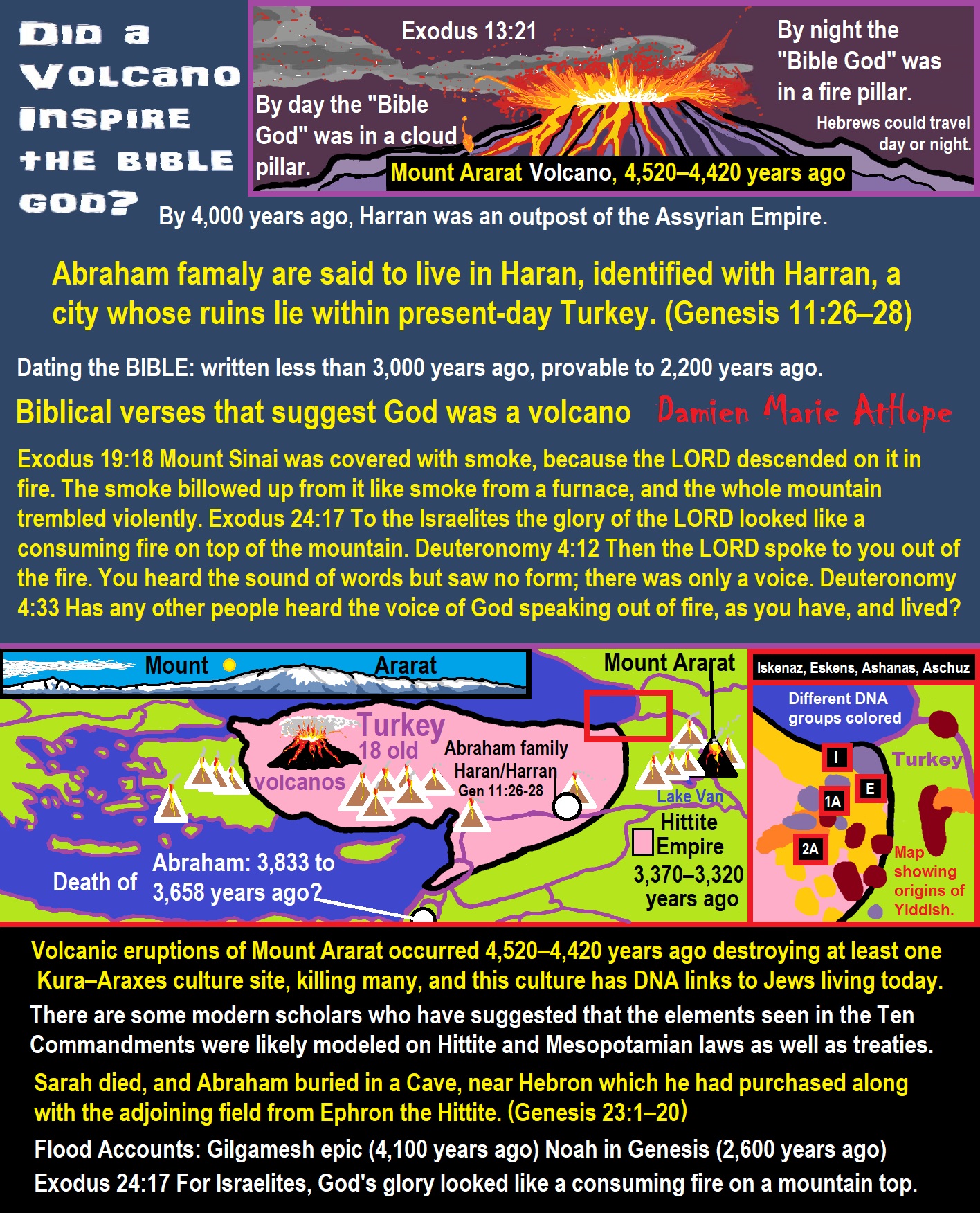
ref, ref, ref, ref, ref, ref, ref, ref, ref, ref, ref, ref, ref
By day the LORD went ahead of them in a pillar of cloud to guide them on their way and by night in a pillar of fire to give them light, so that they could travel by day or night.
- By day the “Bible God” was in a cloud pillar.
- By night the “Bible God” was in a fire pillar.
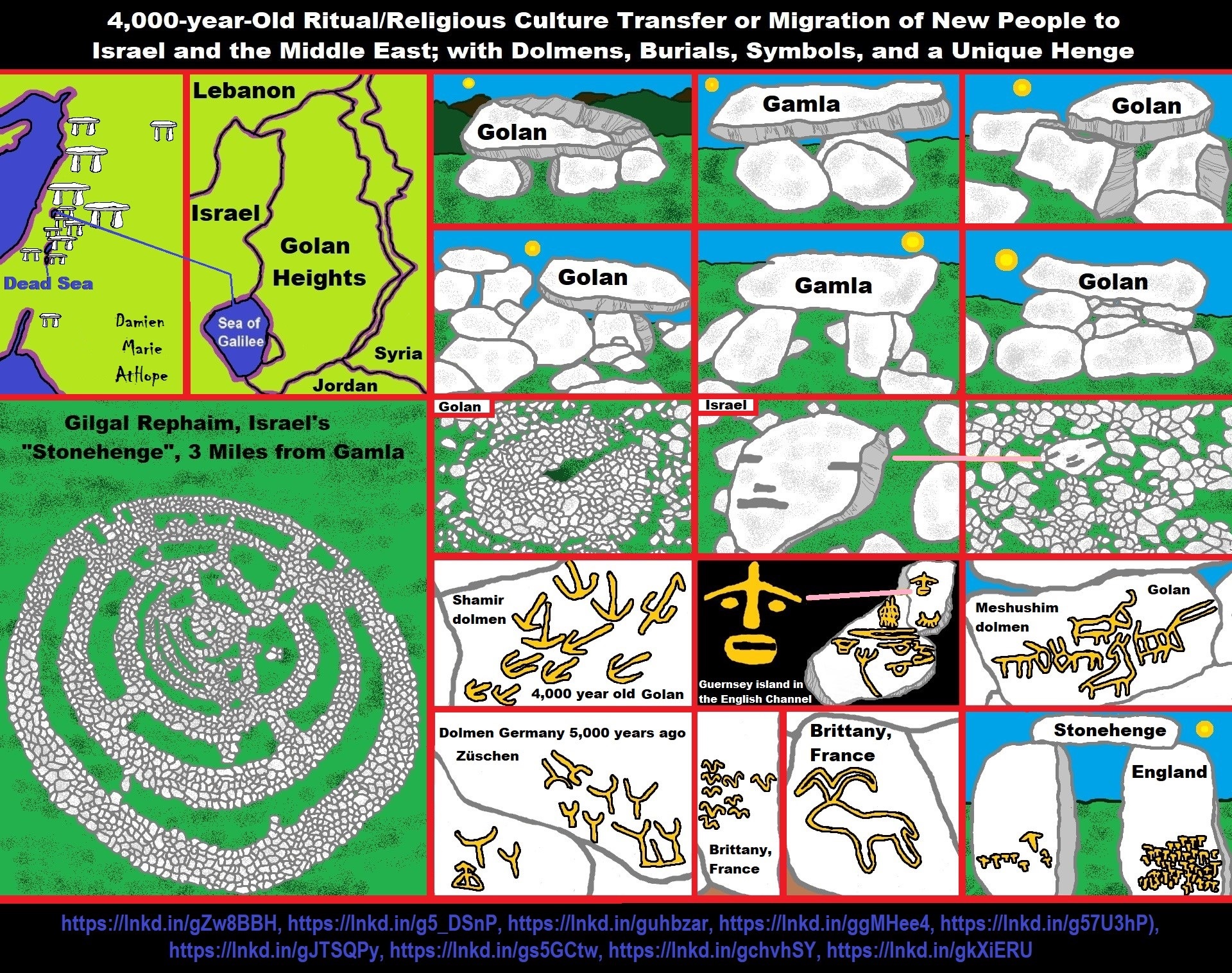
@ Vincent Rowlatt. (Peasant) – “Did they have a volcano god? Of course, they did. Anything that wasn’t ‘understood’ must be god. And along came the ‘priests’…”
My response, I can agree with that. It was way more involved than just that but as a short blanket statement, it is close. I think so as well or at least one possibly related to the idea of a volcano god.
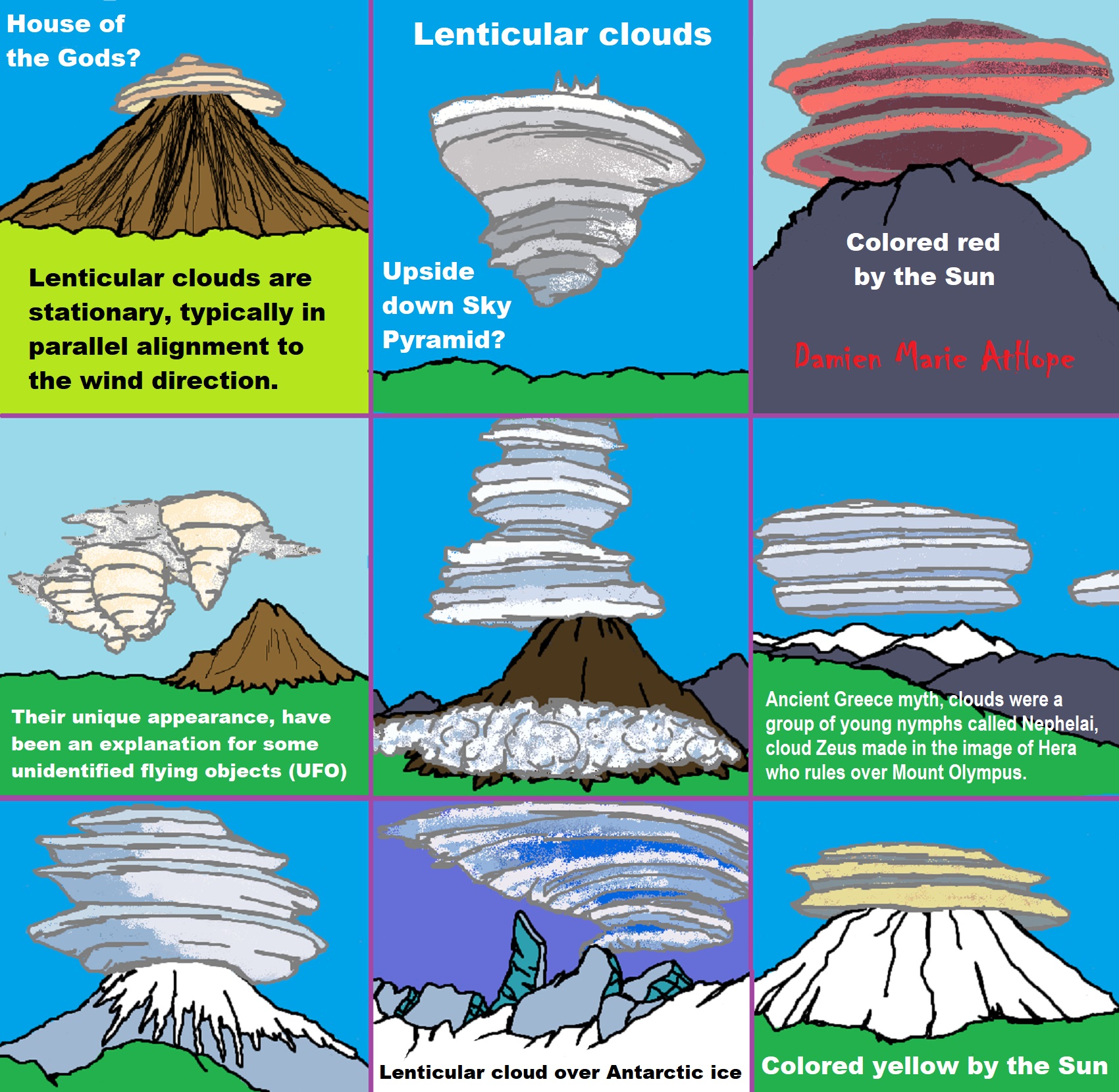
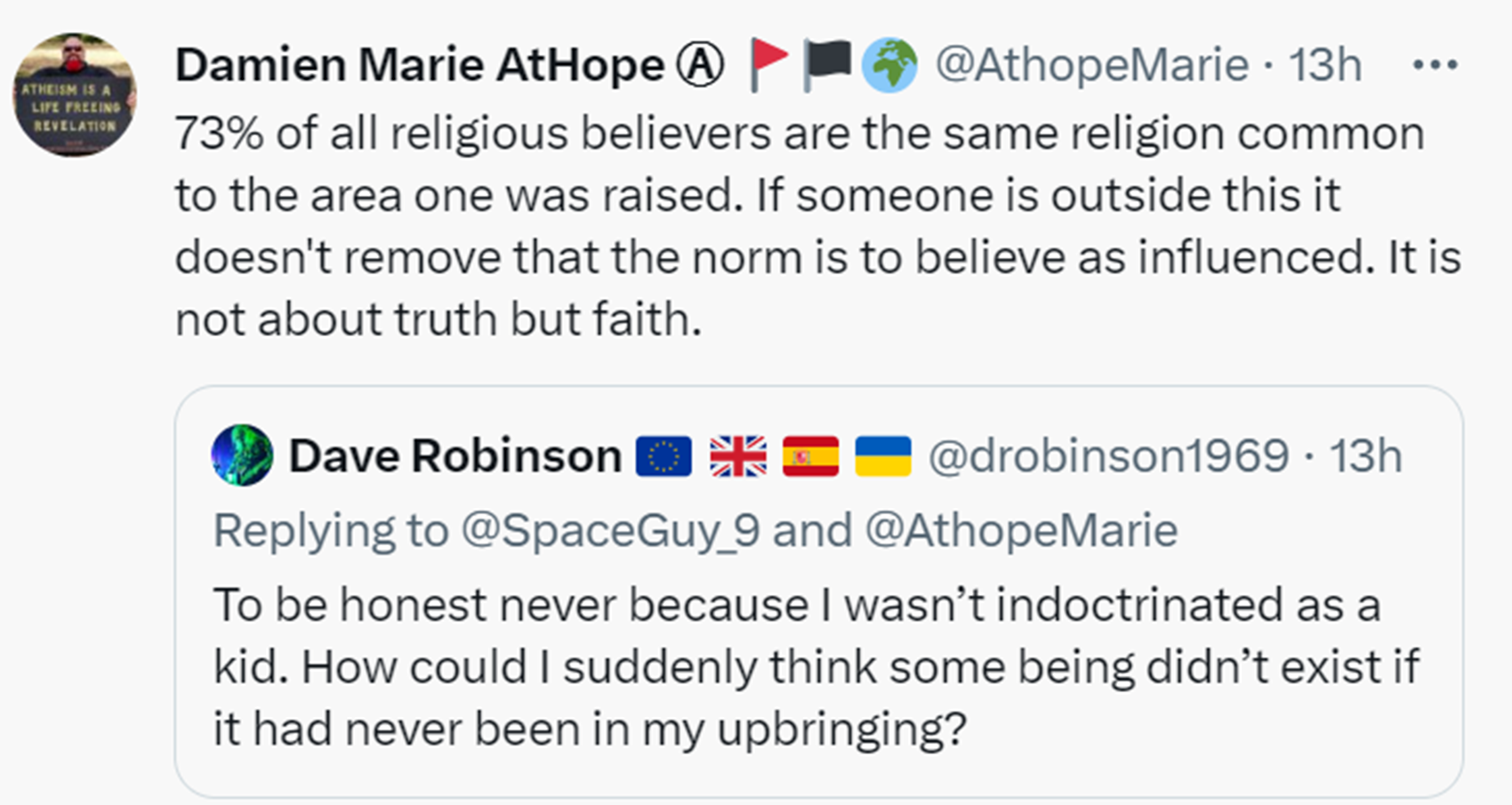
“To be honest never because I wasn’t indoctrinated as a kid. How could I suddenly think some being didn’t exist if it had never been in my upbringing?” – Dave Robinson @drobinson1969
My response, 73% of all religious believers are the same religion common to the area one was raised. If someone is outside this it doesn’t remove that the norm is to believe as influenced. It is not about truth but faith.
“Nearly three-quarters (73%) of the world’s people live in countries in which their religious group makes up a majority of the population.” ref
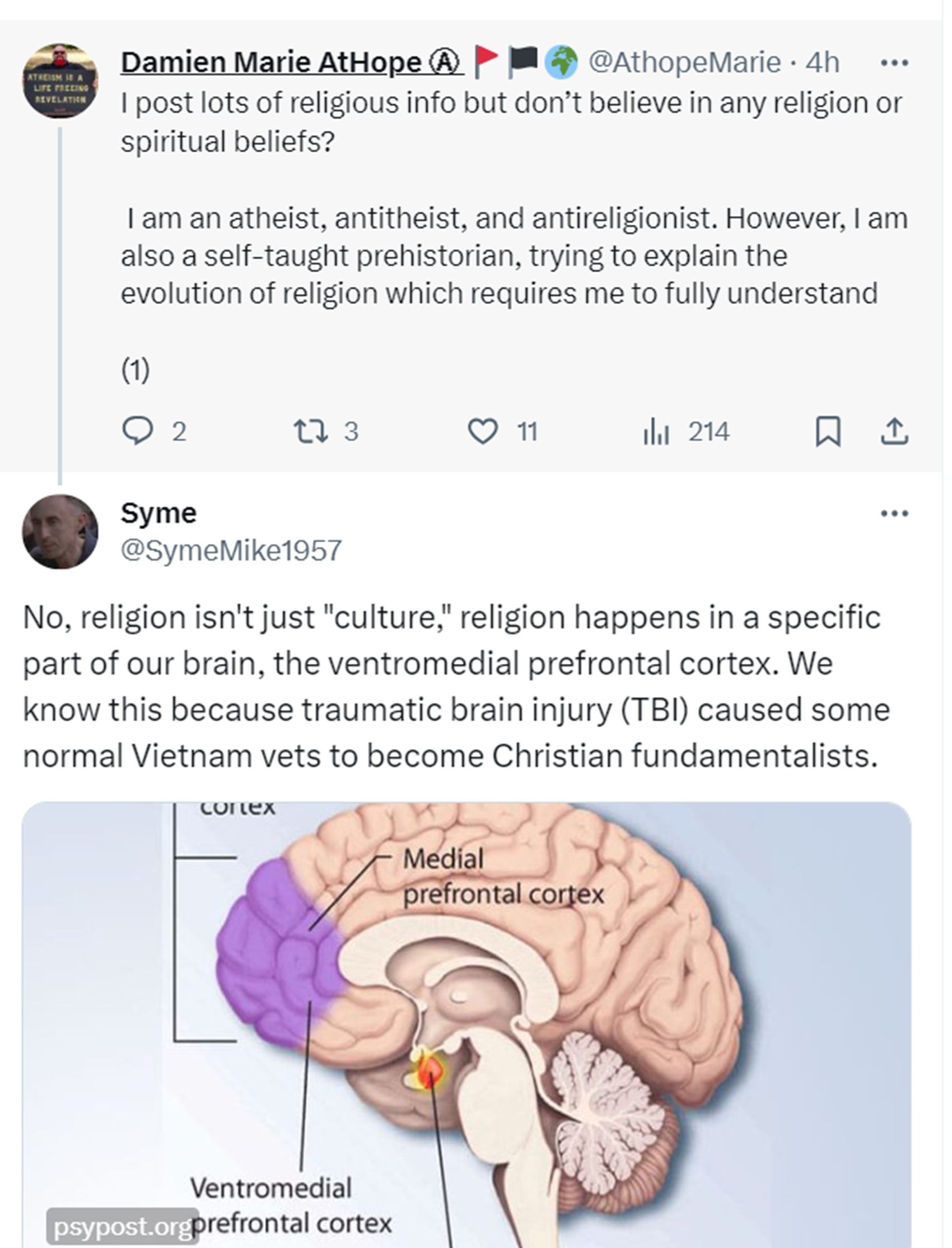
My response, By religion, you mean animism thinking. Yes, things can be motivators, traumatic brain injuries can inspire religious type beliefs (it does not pick the religion or that it could not lead to a nonreligious spirituality). I am explaining in my thinking the evolution of religion and people migrating taking their culture/religious beliefs and why some areas share religious thinking.
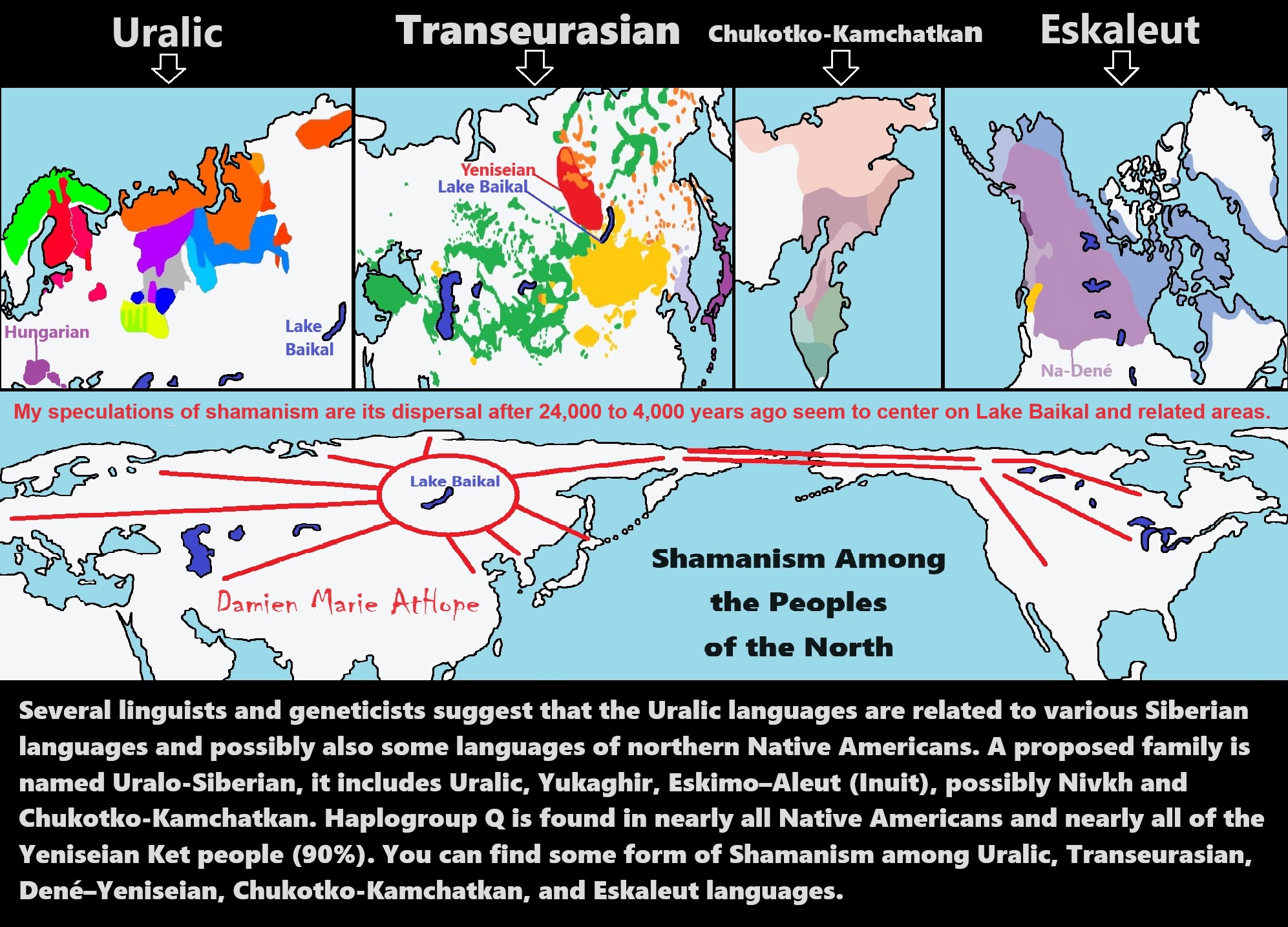
ref, ref, ref, ref, ref, ref, ref, ref, ref
“Several linguists and geneticists suggest that the Uralic languages are related to various Siberian languages and possibly also some languages of northern Native Americans. A proposed family is named Uralo-Siberian, it includes Uralic, Yukaghir, Eskimo–Aleut (Inuit), possibly Nivkh, and Chukotko-Kamchatkan. Haplogroup Q is found in nearly all Native Americans and nearly all of the Yeniseian Ket people (90%).” ref, ref
You can find some form of Shamanism, among Uralic, Transeurasian, Dené–Yeniseian, Chukotko-Kamchatkan, and Eskaleut languages.
My speculations of shamanism are its dispersals, after 24,000 to 4,000 years ago, seem to center on Lake Baikal and related areas. To me, the hotspot of Shamanism goes from west of Lake Baikal in the “Altai Mountains” also encompassing “Lake Baikal” and includes the “Amur Region/Watershed” east of Lake Baikal as the main location Shamanism seems to have radiated out from.
Syme @SymeMike1957 – “That initial #Vietnam vets study started a new study, Neurotheology, the biological basis for religious belief. Humans have vmPFCs, do chimpanzees? Do chimpanzees believe in god? Are animald that don’t have a vmPVC #atheists?”
“Studying Injured Minds” – The Vietnam Head Injury Study and 40 Years of Brain Injury Research
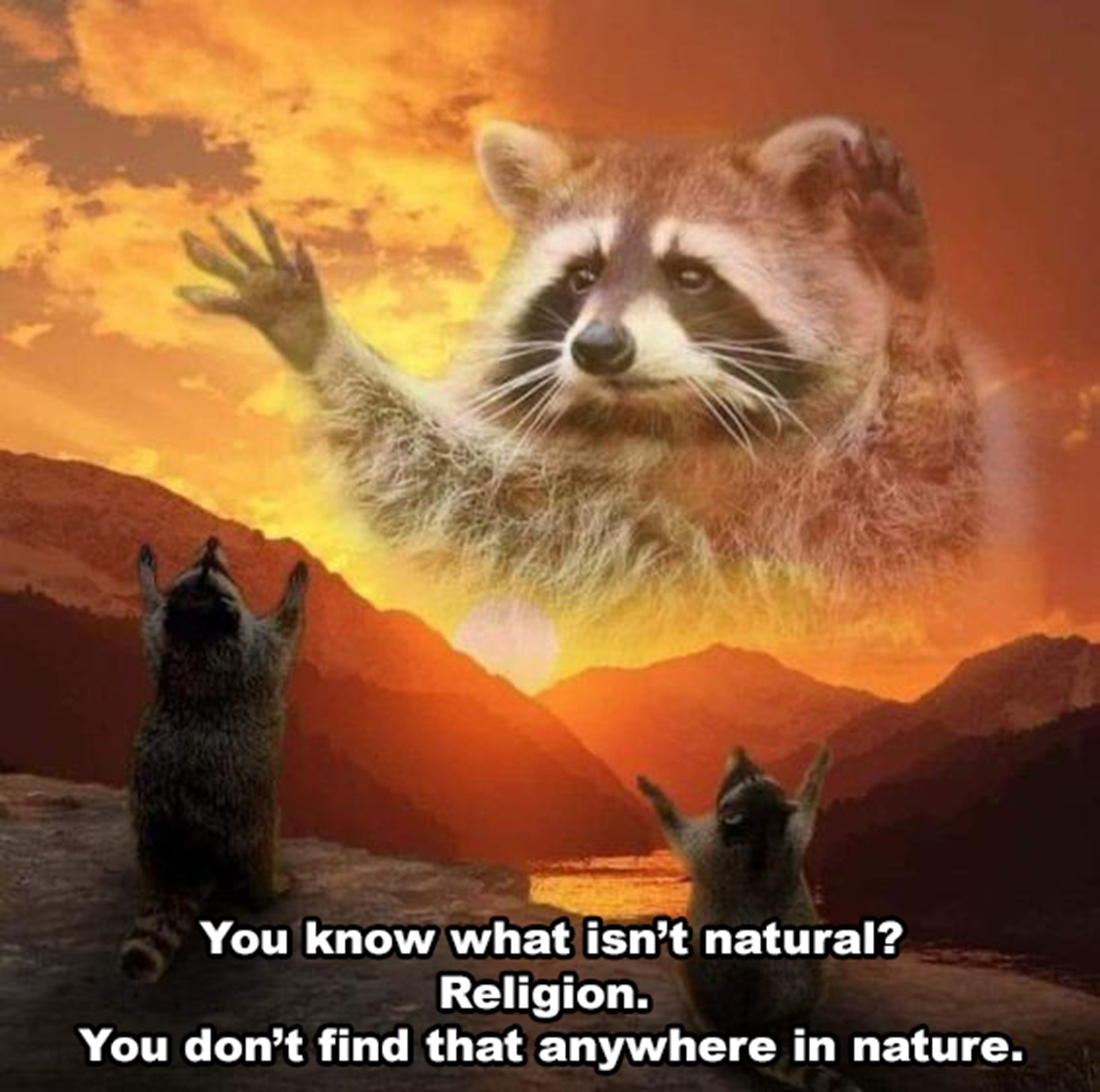
@ Vincent Rowlatt. (Peasant) – “The sun was important long before agriculture. What changed, why did ‘we’ invent ‘gods and religion’?”

Not all “Religions” or “Religious Persuasions” have a god(s) but
All can be said to believe in some imaginary beings or imaginary things like spirits, afterlives, etc.
“Damien, sometimes religion is a primitive belief.”
I hear you but because of religious bigotry, saying the term “primitive” is too often assumed to mean “primitive” from “non-primitive” religions. I want to avoid such labeling as it is all non-reality beliefs to me anyway.
I don’t see religious terms Animism, Totemism, Shamanism, or Paganism as primitive but original or core elements that are different parts of world views and their supernatural/non-natural beliefs or thinking. I don’t class any religious thinking as primitive but in error to what I see as a natural-only world, that religious thinking then makes up a myriad of non-natural/non-empirical themes/beings, stories, and myths about which group together are called religions.
I see all religions as having shared or similar features or core elements that relate to religious terms Animism, Totemism, Shamanism, or Paganism including Abrahamic (Judaism, Christianity, or Islam) religious thinking.

ref, ref, ref, ref, ref, ref, ref, ref, ref, ref, ref, ref, ref, ref, ref, ref, ref, ref, ref, ref, ref
Low Gods “Earth” or Tutelary deity and High Gods “Sky” or Supreme deity
“An Earth goddess is a deification of the Earth. Earth goddesses are often associated with the “chthonic” deities of the underworld. Ki and Ninhursag are Mesopotamian earth goddesses. In Greek mythology, the Earth is personified as Gaia, corresponding to Roman Terra, Indic Prithvi/Bhūmi, etc. traced to an “Earth Mother” complementary to the “Sky Father” in Proto-Indo-European religion. Egyptian mythology exceptionally has a sky goddess and an Earth god.” ref
“A mother goddess is a goddess who represents or is a personification of nature, motherhood, fertility, creation, destruction or who embodies the bounty of the Earth. When equated with the Earth or the natural world, such goddesses are sometimes referred to as Mother Earth or as the Earth Mother. In some religious traditions or movements, Heavenly Mother (also referred to as Mother in Heaven or Sky Mother) is the wife or feminine counterpart of the Sky father or God the Father.” ref
“Any masculine sky god is often also king of the gods, taking the position of patriarch within a pantheon. Such king gods are collectively categorized as “sky father” deities, with a polarity between sky and earth often being expressed by pairing a “sky father” god with an “earth mother” goddess (pairings of a sky mother with an earth father are less frequent). A main sky goddess is often the queen of the gods and may be an air/sky goddess in her own right, though she usually has other functions as well with “sky” not being her main. In antiquity, several sky goddesses in ancient Egypt, Mesopotamia, and the Near East were called Queen of Heaven. Neopagans often apply it with impunity to sky goddesses from other regions who were never associated with the term historically. The sky often has important religious significance. Many religions, both polytheistic and monotheistic, have deities associated with the sky.” ref
“In comparative mythology, sky father is a term for a recurring concept in polytheistic religions of a sky god who is addressed as a “father”, often the father of a pantheon and is often either a reigning or former King of the Gods. The concept of “sky father” may also be taken to include Sun gods with similar characteristics, such as Ra. The concept is complementary to an “earth mother“. “Sky Father” is a direct translation of the Vedic Dyaus Pita, etymologically descended from the same Proto-Indo-European deity name as the Greek Zeûs Pater and Roman Jupiter and Germanic Týr, Tir or Tiwaz, all of which are reflexes of the same Proto-Indo-European deity’s name, *Dyēus Ph₂tḗr. While there are numerous parallels adduced from outside of Indo-European mythology, there are exceptions (e.g. In Egyptian mythology, Nut is the sky mother and Geb is the earth father).” ref
Tutelary deity
“A tutelary (also tutelar) is a deity or spirit who is a guardian, patron, or protector of a particular place, geographic feature, person, lineage, nation, culture, or occupation. The etymology of “tutelary” expresses the concept of safety and thus of guardianship. In late Greek and Roman religion, one type of tutelary deity, the genius, functions as the personal deity or daimon of an individual from birth to death. Another form of personal tutelary spirit is the familiar spirit of European folklore.” ref
“A tutelary (also tutelar) in Korean shamanism, jangseung and sotdae were placed at the edge of villages to frighten off demons. They were also worshiped as deities. Seonangshin is the patron deity of the village in Korean tradition and was believed to embody the Seonangdang. In Philippine animism, Diwata or Lambana are deities or spirits that inhabit sacred places like mountains and mounds and serve as guardians. Such as: Maria Makiling is the deity who guards Mt. Makiling and Maria Cacao and Maria Sinukuan. In Shinto, the spirits, or kami, which give life to human bodies come from nature and return to it after death. Ancestors are therefore themselves tutelaries to be worshiped. And similarly, Native American beliefs such as Tonás, tutelary animal spirit among the Zapotec and Totems, familial or clan spirits among the Ojibwe, can be animals.” ref
“A tutelary (also tutelar) in Austronesian beliefs such as: Atua (gods and spirits of the Polynesian peoples such as the Māori or the Hawaiians), Hanitu (Bunun of Taiwan‘s term for spirit), Hyang (Kawi, Sundanese, Javanese, and Balinese Supreme Being, in ancient Java and Bali mythology and this spiritual entity, can be either divine or ancestral), Kaitiaki (New Zealand Māori term used for the concept of guardianship, for the sky, the sea, and the land), Kawas (mythology) (divided into 6 groups: gods, ancestors, souls of the living, spirits of living things, spirits of lifeless objects, and ghosts), Tiki (Māori mythology, Tiki is the first man created by either Tūmatauenga or Tāne and represents deified ancestors found in most Polynesian cultures). ” ref, ref, ref, ref, ref, ref, ref
Mesopotamian Tutelary Deities can be seen as ones related to City-States
“Historical city-states included Sumerian cities such as Uruk and Ur; Ancient Egyptian city-states, such as Thebes and Memphis; the Phoenician cities (such as Tyre and Sidon); the five Philistine city-states; the Berber city-states of the Garamantes; the city-states of ancient Greece (the poleis such as Athens, Sparta, Thebes, and Corinth); the Roman Republic (which grew from a city-state into a vast empire); the Italian city-states from the Middle Ages to the early modern period, such as Florence, Siena, Ferrara, Milan (which as they grew in power began to dominate neighboring cities) and Genoa and Venice, which became powerful thalassocracies; the Mayan and other cultures of pre-Columbian Mesoamerica (including cities such as Chichen Itza, Tikal, Copán and Monte Albán); the central Asian cities along the Silk Road; the city-states of the Swahili coast; Ragusa; states of the medieval Russian lands such as Novgorod and Pskov; and many others.” ref
“The Uruk period (ca. 4000 to 3100 BCE; also known as Protoliterate period) of Mesopotamia, named after the Sumerian city of Uruk, this period saw the emergence of urban life in Mesopotamia and the Sumerian civilization. City-States like Uruk and others had a patron tutelary City Deity along with a Priest-King.” ref
“Chinese folk religion, both past, and present, includes myriad tutelary deities. Exceptional individuals, highly cultivated sages, and prominent ancestors can be deified and honored after death. Lord Guan is the patron of military personnel and police, while Mazu is the patron of fishermen and sailors. Such as Tu Di Gong (Earth Deity) is the tutelary deity of a locality, and each individual locality has its own Earth Deity and Cheng Huang Gong (City God) is the guardian deity of an individual city, worshipped by local officials and locals since imperial times.” ref
“A tutelary (also tutelar) in Hinduism, personal tutelary deities are known as ishta-devata, while family tutelary deities are known as Kuladevata. Gramadevata are guardian deities of villages. Devas can also be seen as tutelary. Shiva is the patron of yogis and renunciants. City goddesses include: Mumbadevi (Mumbai), Sachchika (Osian); Kuladevis include: Ambika (Porwad), and Mahalakshmi. In NorthEast India Meitei mythology and religion (Sanamahism) of Manipur, there are various types of tutelary deities, among which Lam Lais are the most predominant ones. Tibetan Buddhism has Yidam as a tutelary deity. Dakini is the patron of those who seek knowledge.” ref
“A tutelary (also tutelar) The Greeks also thought deities guarded specific places: for instance, Athena was the patron goddess of the city of Athens. Socrates spoke of hearing the voice of his personal spirit or daimonion:
You have often heard me speak of an oracle or sign which comes to me … . This sign I have had ever since I was a child. The sign is a voice which comes to me and always forbids me to do something which I am going to do, but never commands me to do anything, and this is what stands in the way of my being a politician.” ref
“Tutelary deities who guard and preserve a place or a person are fundamental to ancient Roman religion. The tutelary deity of a man was his Genius, that of a woman her Juno. In the Imperial era, the Genius of the Emperor was a focus of Imperial cult. An emperor might also adopt a major deity as his personal patron or tutelary, as Augustus did Apollo. Precedents for claiming the personal protection of a deity were established in the Republican era, when for instance the Roman dictator Sulla advertised the goddess Victory as his tutelary by holding public games (ludi) in her honor.” ref
“Each town or city had one or more tutelary deities, whose protection was considered particularly vital in time of war and siege. Rome itself was protected by a goddess whose name was to be kept ritually secret on pain of death (for a supposed case, see Quintus Valerius Soranus). The Capitoline Triad of Juno, Jupiter, and Minerva were also tutelaries of Rome. The Italic towns had their own tutelary deities. Juno often had this function, as at the Latin town of Lanuvium and the Etruscan city of Veii, and was often housed in an especially grand temple on the arx (citadel) or other prominent or central location. The tutelary deity of Praeneste was Fortuna, whose oracle was renowned.” ref
“The Roman ritual of evocatio was premised on the belief that a town could be made vulnerable to military defeat if the power of its tutelary deity were diverted outside the city, perhaps by the offer of superior cult at Rome. The depiction of some goddesses such as the Magna Mater (Great Mother, or Cybele) as “tower-crowned” represents their capacity to preserve the city. A town in the provinces might adopt a deity from within the Roman religious sphere to serve as its guardian, or syncretize its own tutelary with such; for instance, a community within the civitas of the Remi in Gaul adopted Apollo as its tutelary, and at the capital of the Remi (present-day Rheims), the tutelary was Mars Camulus.” ref
Household deity (a kind of or related to a Tutelary deity)
“A household deity is a deity or spirit that protects the home, looking after the entire household or certain key members. It has been a common belief in paganism as well as in folklore across many parts of the world. Household deities fit into two types; firstly, a specific deity – typically a goddess – often referred to as a hearth goddess or domestic goddess who is associated with the home and hearth, such as the ancient Greek Hestia.” ref
“The second type of household deities are those that are not one singular deity, but a type, or species of animistic deity, who usually have lesser powers than major deities. This type was common in the religions of antiquity, such as the Lares of ancient Roman religion, the Gashin of Korean shamanism, and Cofgodas of Anglo-Saxon paganism. These survived Christianisation as fairy-like creatures existing in folklore, such as the Anglo-Scottish Brownie and Slavic Domovoy.” ref
“Household deities were usually worshipped not in temples but in the home, where they would be represented by small idols (such as the teraphim of the Bible, often translated as “household gods” in Genesis 31:19 for example), amulets, paintings, or reliefs. They could also be found on domestic objects, such as cosmetic articles in the case of Tawaret. The more prosperous houses might have a small shrine to the household god(s); the lararium served this purpose in the case of the Romans. The gods would be treated as members of the family and invited to join in meals, or be given offerings of food and drink.” ref
“In many religions, both ancient and modern, a god would preside over the home. Certain species, or types, of household deities, existed. An example of this was the Roman Lares. Many European cultures retained house spirits into the modern period. Some examples of these include:
- Brownie (Scotland and England) or Hob (England) / Kobold (Germany) / Goblin / Hobgoblin
- Domovoy (Slavic)
- Nisse (Norwegian or Danish) / Tomte (Swedish) / Tonttu (Finnish)
- Húsvættir (Norse)” ref
“Although the cosmic status of household deities was not as lofty as that of the Twelve Olympians or the Aesir, they were also jealous of their dignity and also had to be appeased with shrines and offerings, however humble. Because of their immediacy they had arguably more influence on the day-to-day affairs of men than the remote gods did. Vestiges of their worship persisted long after Christianity and other major religions extirpated nearly every trace of the major pagan pantheons. Elements of the practice can be seen even today, with Christian accretions, where statues to various saints (such as St. Francis) protect gardens and grottos. Even the gargoyles found on older churches, could be viewed as guardians partitioning a sacred space.” ref
“For centuries, Christianity fought a mop-up war against these lingering minor pagan deities, but they proved tenacious. For example, Martin Luther‘s Tischreden have numerous – quite serious – references to dealing with kobolds. Eventually, rationalism and the Industrial Revolution threatened to erase most of these minor deities, until the advent of romantic nationalism rehabilitated them and embellished them into objects of literary curiosity in the 19th century. Since the 20th century this literature has been mined for characters for role-playing games, video games, and other fantasy personae, not infrequently invested with invented traits and hierarchies somewhat different from their mythological and folkloric roots.” ref
“In contradistinction to both Herbert Spencer and Edward Burnett Tylor, who defended theories of animistic origins of ancestor worship, Émile Durkheim saw its origin in totemism. In reality, this distinction is somewhat academic, since totemism may be regarded as a particularized manifestation of animism, and something of a synthesis of the two positions was attempted by Sigmund Freud. In Freud’s Totem and Taboo, both totem and taboo are outward expressions or manifestations of the same psychological tendency, a concept which is complementary to, or which rather reconciles, the apparent conflict. Freud preferred to emphasize the psychoanalytic implications of the reification of metaphysical forces, but with particular emphasis on its familial nature. This emphasis underscores, rather than weakens, the ancestral component.” ref
“William Edward Hearn, a noted classicist, and jurist, traced the origin of domestic deities from the earliest stages as an expression of animism, a belief system thought to have existed also in the neolithic, and the forerunner of Indo-European religion. In his analysis of the Indo-European household, in Chapter II “The House Spirit”, Section 1, he states:
The belief which guided the conduct of our forefathers was … the spirit rule of dead ancestors.” ref
“In Section 2 he proceeds to elaborate:
It is thus certain that the worship of deceased ancestors is a vera causa, and not a mere hypothesis. …
In the other European nations, the Slavs, the Teutons, and the Kelts, the House Spirit appears with no less distinctness. … [T]he existence of that worship does not admit of doubt. … The House Spirits had a multitude of other names which it is needless here to enumerate, but all of which are more or less expressive of their friendly relations with man. … In [England] … [h]e is the Brownie. … In Scotland this same Brownie is well known. He is usually described as attached to particular families, with whom he has been known to reside for centuries, threshing the corn, cleaning the house, and performing similar household tasks. His favorite gratification was milk and honey.” ref

ref, ref, ref, ref, ref, ref, ref, ref, ref, ref, ref, ref, ref, ref, ref, ref, ref
From the Evidence, I Speculate, the First Human-Male God was Created in the Balkans around or after 7,000 years ago following Harsher climate, Emerging social hierarchy, and Fear of violence.
Fear of Wars Violence and the Creation of Male God: Hamangia culture around 7,250-6,500 years ago (Romania and Bulgaria)?
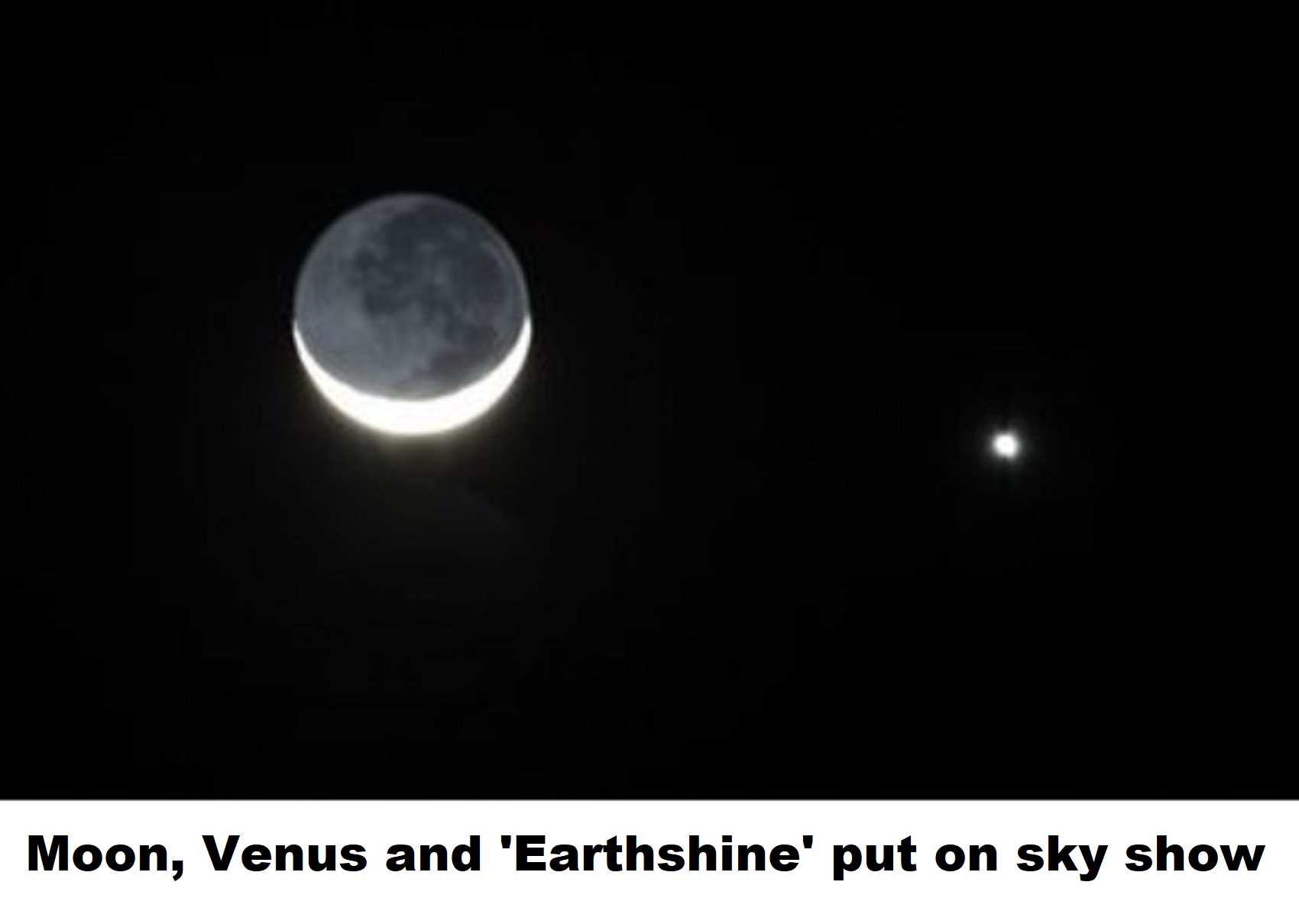
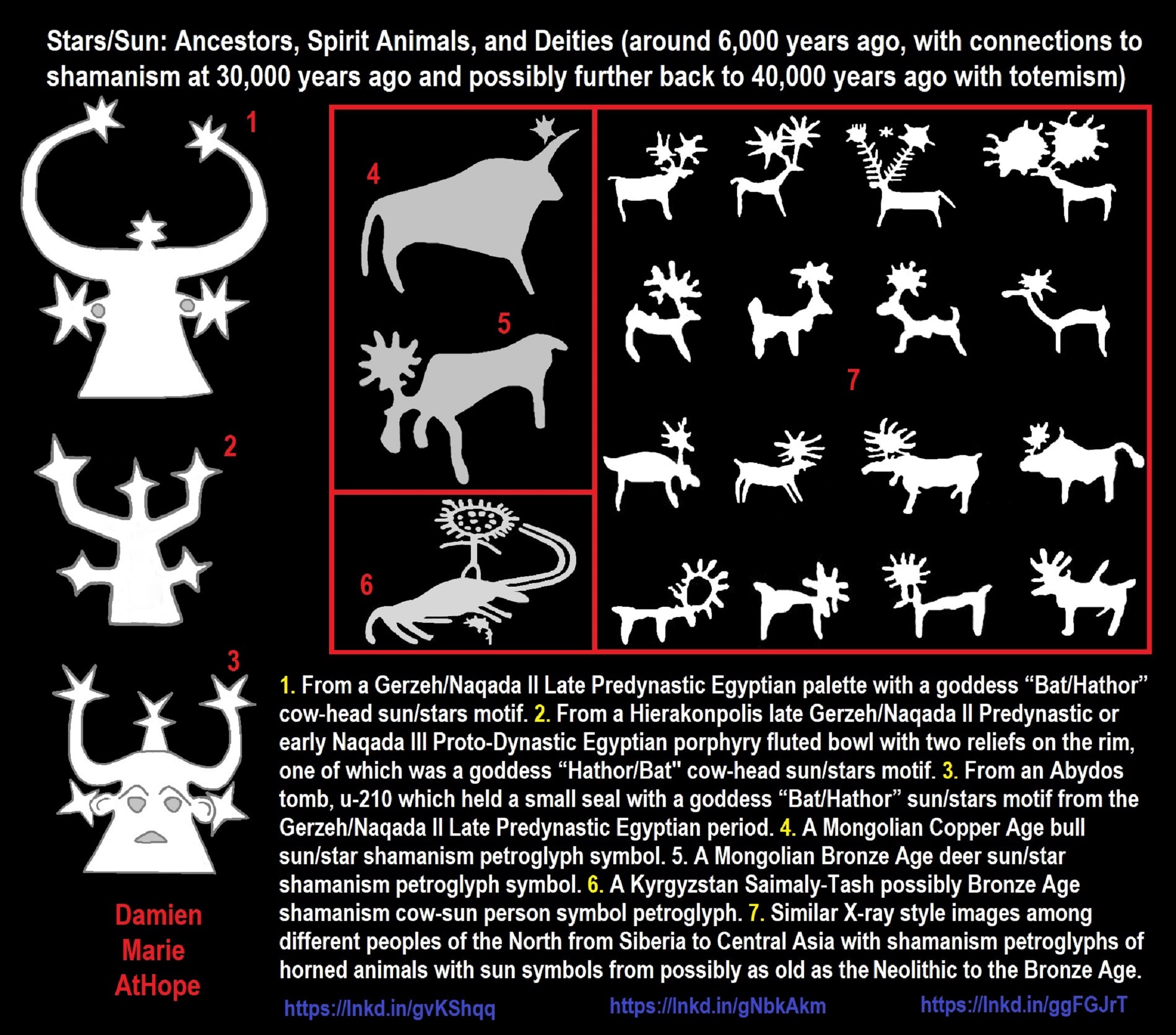
- From a Gerzeh/Naqada II Late Predynastic Egyptian palette with a goddess “Bat/Hathor” cow-head sun/stars motif.
- From a Hierakonpolis late Gerzeh/Naqada II Predynastic or early Naqada III Proto-Dynastic Egyptian porphyry fluted bowl with two reliefs on the rim, one of which was a goddess “Hathor/Bat” cow-head sun/stars motif.
- From an Abydos tomb, u-210 which held a small seal with a goddess “Bat/Hathor” sun/stars motif from the Gerzeh/Naqada II Late Predynastic Egyptian period.
- A Mongolian Copper Age bull sun/star shamanism petroglyph
- A Mongolian Bronze Age deer sun/star shamanism petroglyph symbol.
- A Kyrgyzstan Saimaly-Tash possibly Bronze Age shamanism cow-sun person symbol petroglyph.
- Similar X-ray style images among different peoples of the North from Siberia to Central Asia with shamanism petroglyphs of horned animals with sun symbols from possibly as old as the Neolithic to the Bronze Age. ref, ref, ref
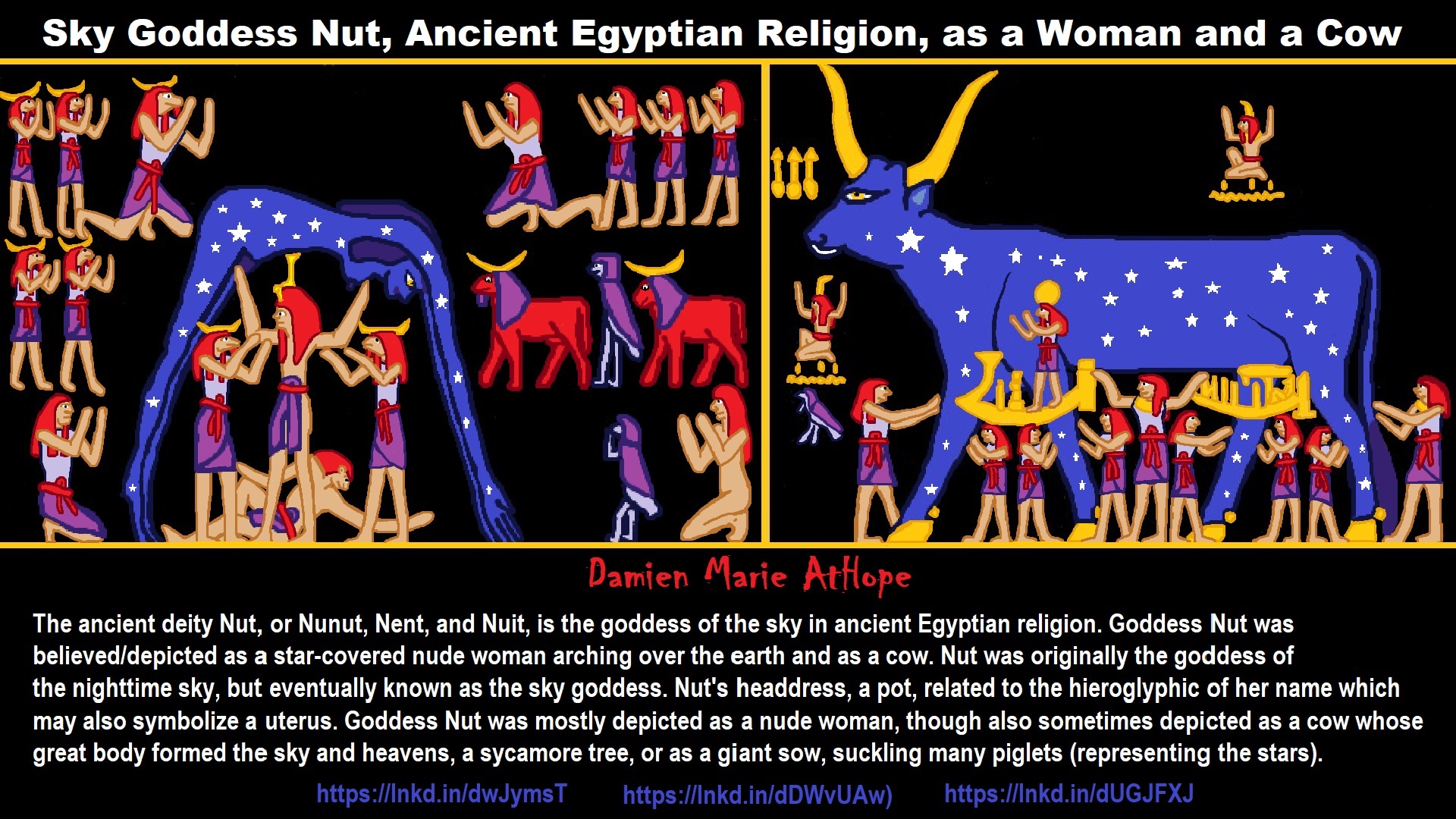
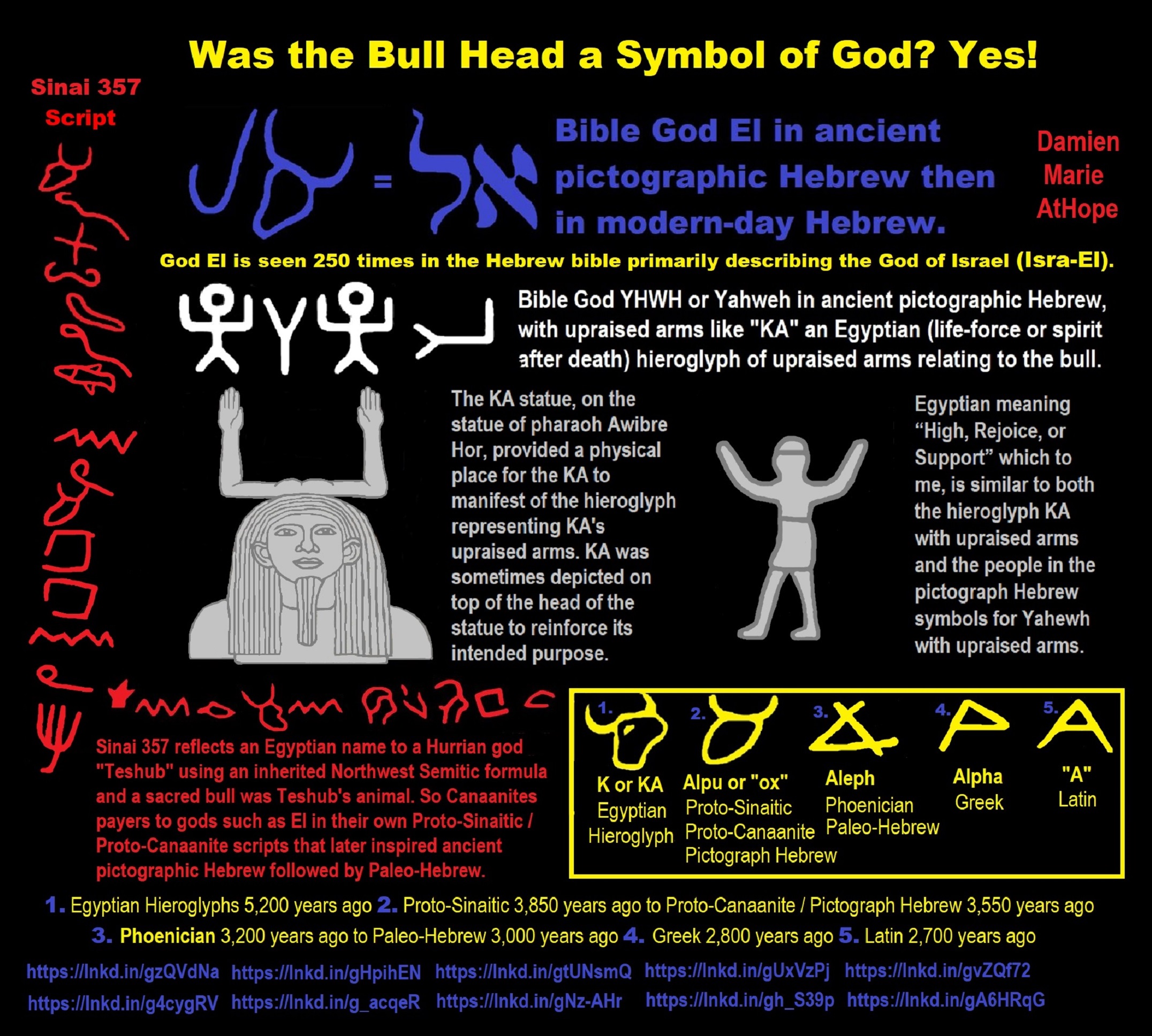
Did you know the God of the Bible once was known by bull symbolism?
· Bible God El in ancient pictographic Hebrew then in modern-day Hebrew.
· God El is seen 250 times in the Hebrew bible primarily describing the God of Israel (Isra-El).
· Bible God YHWH or Yahweh in ancient pictographic Hebrew, with upraised arms like “KA” an Egyptian (life-force or spirit after death) hieroglyph of upraised arms relating to the bull.
· Egyptian with upraised arms means High, Rejoice, or Support, which to me, is similar to both the hieroglyph KA with upraised arms and the people pictographic Hebrew symbols (meaning Lo, Behold, “The”) for Yahweh with upraised arms.
· The KA statue, on the statue of pharaoh Awibre Hor, provided a physical place for the KA to manifest of the hieroglyph representing KA’s upraised arms. KA was sometimes depicted on top of the head of the statue to reinforce its intended purpose.
· Egyptian meaning “High, Rejoice, or Support” which to me, is similar to both the hieroglyph KA with upraised arms and the people in the pictograph Hebrew symbols for Yahewh with upraised arms.
· Sinai 357 reflects an Egyptian name to a Hurrian god “Teshub” using an inherited Northwest Semitic formula and a sacred bull was Teshub’s animal. So Canaanites payers to gods such as El in their own Proto-Sinaitic / Proto-Canaanite scripts that later inspired ancient pictographic Hebrew followed by Paleo-Hebrew.
· 1. Egyptian Hieroglyphs 5,200 years ago 2. Proto-Sinaitic 3,850 years ago to Proto-Canaanite / Pictograph Hebrew 3,550 years ago 3. Phoenician 3,200 years ago to Paleo-Hebrew 3,000 years ago 4. Greek 2,800 years ago 5. Latin 2,700 years ago. ref, ref, ref, ref, ref, ref, ref, ref, ref, ref, ref, ref, ref, ref
To have faith is to make a presumption of faith towards something and the most common use of faith is toward things that relate to concepts of gods such as their names. Another way to have faith would mean to understand why a god would change their name. In the Jewish and Christian religions, their god’s name was changed. In the beginning, god’s eternal name is El, Near East god is most holy, and the father of all gods. El is a Semitic word meaning “god” or may relate to multiple ancient Near Eastern deities such as Hebrew: el, Amorite: il, Arabic ilah, Akkadian and Ugaritic: ilu, Aramaic and Phoenician: l, and is the known name of the original god to the Abrahamic religions. ref, ref, ref
In Judaism, the later Hebrew and Aramaic texts, as well as the Dead Sea Scrolls, dating around 2,408 to 1,700 years ago, used El or Elohim for the names of God and sometimes were in written paleo-Hebrew script dating about 3,000 years ago, and used in the ancient kingdoms of Israel and Judah, which shows that El was still treated as special. ref, ref
In the first statement of the Muslim confession of faith in the Quran, it states that “There is no god (ilah) except God (al-Lah or Allah).” And al-ilah, “the god” relates to El and Elah, the Hebrew and Aramaic words for God. ref, ref
Also what is interesting is that Hebrew is a Semitic language and according to a popular Israeli news source the Haaretz, the country Isra-El (Israel) expresses the relationship with the 3,300 years old Canaanite deity El who was the head of the Canaanite pantheon. ref
However, El’s name changed in the human-made Bible to El Shaddai. El Shaddai was the Bible-God’s name as first seen in Genesis 17:1, “God appeared to Abram, saying I am El Shaddai.” Similarly, in Genesis 35:11, Bible-God says to Jacob, “I am El Shaddai.” And seen in Exodus 6:2–3, El Shaddai was God’s name known to Abraham, Isaac, and Jacob. All must follow El and Baal whose features were absorbed into the Yahweh religion. ref
God El, the Semitic god, and the creator have a son named Baal “The Lord,” who is the governor of all adversaries to the fake god of the Jews, Yahweh or his other name El Shaddai. Bible-God, the Abrahamic god and the creator have a son named Jesus “The Lord.” It is interesting how people say that Jesus is “Lord” because Jesus is the son of Bible-God and without realizing they seem to be referencing Baal, which can mean “Lord” and is the son of El. No? Okay, let me try again! Why would a god go and change its name anyway? Some religious scholars have stated that the early Hebrews used the names Baʿal (“Lord”) and Baʿali (“My Lord”) to refer to the Lord of Israel, who is El and Yahweh. This use of Baʿal and Baʿali occurred both directly and as the divine element of some Hebrew theophoric names, which means consisting of the name of a deity and a verb. A few names that included the element Baʿal and presumably referring to Yahweh, including Saul’s son Eshbaʿal (“The Lord is Great”), and David’s son Beeliada (“The Lord Knows”). The name Bealiah is the combination of Baal and Yahweh (“The Lord is Jah” + “Yahweh is Baʿal” = “Yahweh is Lord”). ref
To have faith would mean you would have to believe that you already know all of your god’s different names and believe you have the right god and not some other religions’ god or a combination of gods.
@ Vincent Rowlatt. (Peasant) – “Yes, but why? What changed, why did we consider the stars?”
My response, Yes, practical things to us, that had no split of practical use for travel, all of which were merged with religion not separate as we think of them. Religion/culture are now separate but were all mixed as a worldview that was totally emersed in ‘magical’ thinking.
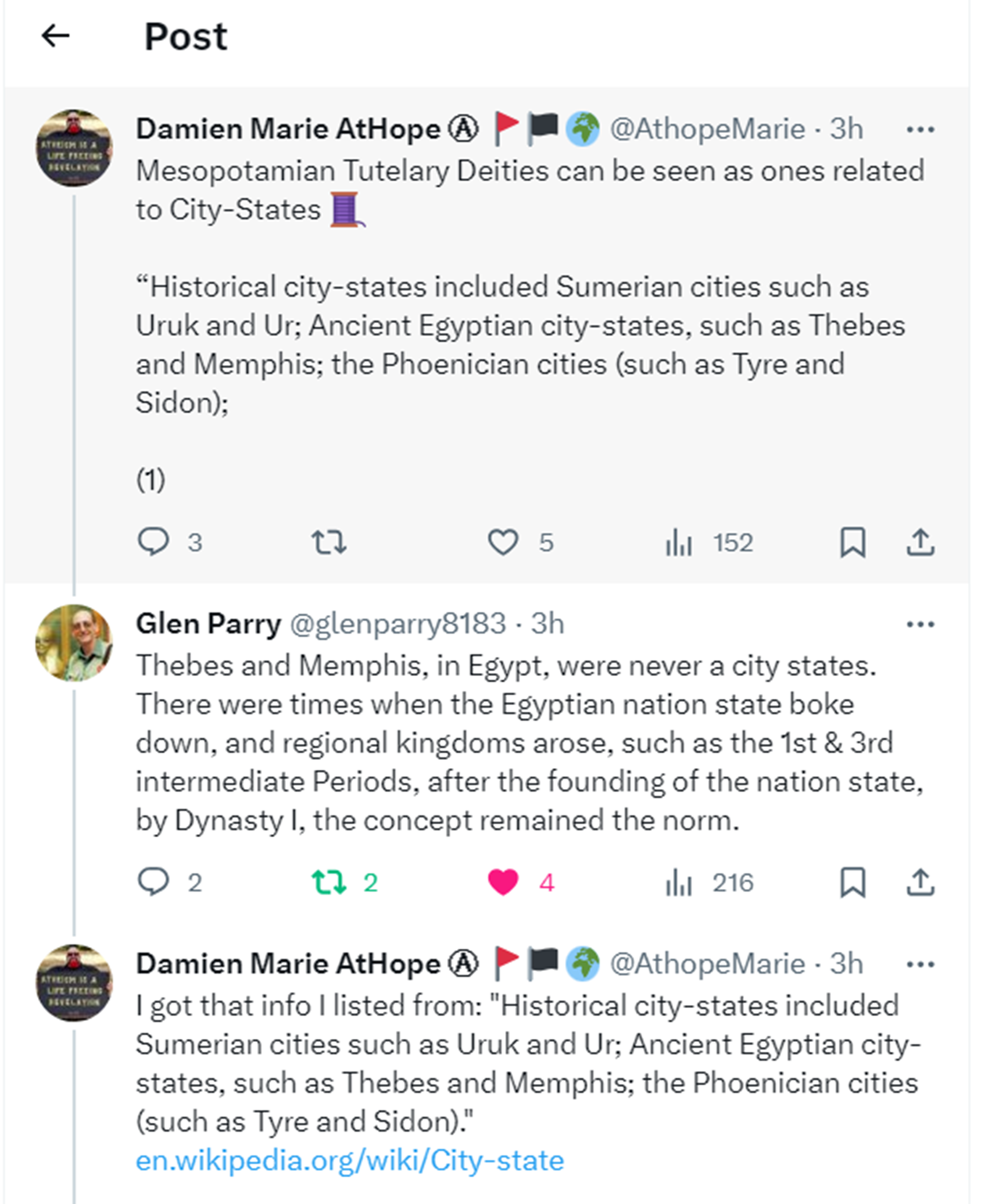
My response, I appreciate your input, Glen.
“Simply stated, a city-state is an independent country that exists completely within the borders of a single city.” ref
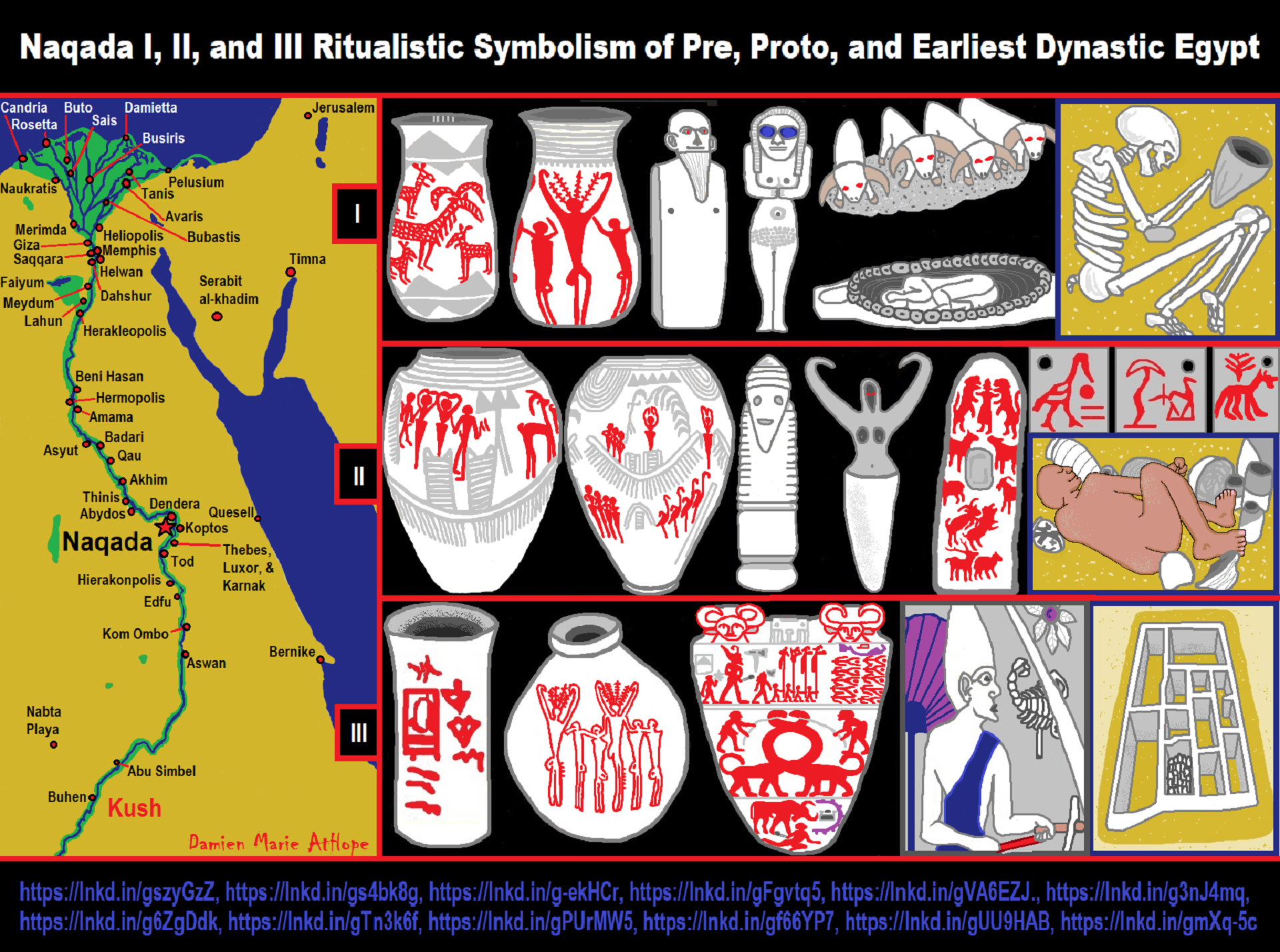
ref, ref, ref, ref, ref, ref, ref, ref, ref
Naqada I, II, and III Ritualistic Symbolism of Pre, Proto, and Earliest Dynastic Egypt
Lower Egypt
Buto-Ma’adi culture, ca. 4000–3200 bc
Upper Egypt
Naqada I (Amratian), ca. 4000–3500 bc
Naqada II (Gerzean), ca. 3500–3200 bc
Naqada III (Semainean)/Dynasty 0, ca. 3200–3000 bc
Lower Nubia
Early A-Group contemporary with Naqada I and early Naqada II
Classic A-Group contemporary with Naqada IId–IIIa
Terminal A-Group contemporary with Naqada IIIb/Dynasty 0, 1st Dynasty ref
Egyptian State Formation and Unification
“Unification of Egypt into one large territorial state, from the Delta to the First Cataract, occurred in late Predynastic times, although there is disagreement as to whether this process was completed by late Naqada II or late Naqada III times. The processes by which this occurred are also not well understood. Naqada culture expansion northward began in Naqada II times. Petrie excavated a cemetery at Gerza in the Faiyum region with Naqada II grave goods. By Naqada IIc times the (Buto-Ma’adi culture) site of Ma’adi, just south of Cairo, was abandoned. At Buto in the northern Delta the stratigraphy shows the replacement of Buto-Ma’adi ceramics by Naqada culture ceramics. This is also demonstrated at other sites in the eastern Delta, including Tell el-Farkha, where the earliest strata have Buto-Ma’adi ceramics, after which there is evidence of a transitional phase (Phase 2, Naqada IID2) when Upper Egyptian ceramics began to be produced.” ref
“At the site of Minshat Abu Omar in the northeastern Delta an early cemetery was found. The earliest burials (MAO I), which date to Naqada IIc–d, are in shallow pits with only a few grave goods. Later burials (MAO III), which date to Naqada III/Dynasty 0, show abrupt changes in mortuary practices. These graves are rectangular and larger than the earlier ones and are often lined with mud plaster and roofed with matting. Orientation of the contracted burials changes as well in this group, with the dead resting on the left side, facing east/southeast. The MAO III burials have many more grave goods than the earliest ones, not only a large number of pots, but also carved stone vessels, jewelry, cosmetic artifacts, and copper tools. The latest burials (MAO IV), which date to the 1st and 2nd Dynasties, are even larger and with more grave goods (up to 125) than those of MAO III. In addition, the eight largest of the MAO IV graves are built with mud or mudbrick and internally divided into two–three rooms. The richest of these burials was of a nine-year-old child, which suggests status ascribed from birth and not achieved through life.” ref
“Thus, archaeological evidence points to the northward expansion of the Naqada culture of Upper Egypt in later Naqada II times, possibly as Naqada traders moved north and were followed by colonists. It is unknown why Ma’adi was abandoned, but one possible explanation is intimidation by Naqada culture peoples. Later, in Naqada III times, when only Naqada ceramics are found in the north, control by a Naqada culture polity may have been established over all the region. The socio-political processes of the expanding Naqada culture are also difficult to characterize from the mainly mortuary evidence. The highly differentiated Naqada II graves at cemeteries in Upper Egypt, and not in Lower Egypt, are probably symbolic of an increasingly hierarchical society. The highest status burials, such as in Cemetery T at Naqada, may represent competition and aggrandizement of local rulers, whose control and wealth increased as economic interaction and long-distance trade developed in Naqada II times (as evidenced in grave goods). Control of the distribution and production of prestigious craft goods, made of exotic imported materials (especially different stones from the Eastern Desert for beads and carved vessels), would also have reinforced the power of rulers in Predynastic centers in Upper Egypt.” ref
“Later Predynastic “statelets” (a term used by Bruce Trigger) may have existed at Hierakonpolis, Naqada, and Abydos. It has been suggested a model of Predynastic settlement development in Upper Egypt, from small egalitarian communities, to agricultural towns, to incipient city-states (based in part on evidence from Naqada’s South Town). According to this thinking, “proto-states” formed in Upper Egypt at Hierakonpolis, Naqada, and Abydos/This, with a hypothetical “proto-kingdom” of all of Upper Egypt followed by unification of the north and south by the 1st Dynasty. Such a model is logical, but there is very little archaeological evidence to demonstrate its validity. In Lower Egypt there is no evidence for a proto-state controlling all of the north, and such a polity is unlikely to have existed. Names and seated kings carved in the broken top part of the Palermo Stone, a 5th-Dynasty king list, suggest a tradition that there had been rulers before the 1st Dynasty. Egyptologist John Baines (University of Oxford) has pointed out the long iconographic evidence for kingship, beginning with the form of what later becomes known as the Red Crown found on a Naqada I pot – long before kings or a kingdom/small state could have existed.” ref
“But the paintings in the later Naqada II Decorated Tomb at Hierakonpolis may represent a “proto-kingship.” Developing along with complex society in later Predynastic times was the institutionalization of kingship. The later unification of southern and northern Egypt was a creation of this kingship, the institutionalization of which helped maintain a well-organized state with long-lasting control over a very large territory – that might otherwise have quickly collapsed. Warfare may have played a significant role in the final stages of Egyptian unification, although sites in the Delta with destruction layers are lacking. But several carved artifacts that date to the late Predynastic/Dynasty 0 have scenes of warfare or its aftermath. The most famous of these is the Narmer Palette, which dates to the end of Dynasty 0 (see Figure 5.5). Excavated at Hierakonpolis, this palette has scenes of the victorious king, dead enemies, and vanquished peoples or towns. There is some disagreement as to whether a specific historical event is represented by the scenes on the Narmer Palette. Günter Dreyer suggests that one scene on the palette, of Narmer in the White Crown of Upper Egypt smiting a bearded enemy, is the same as one on an inscribed ivory label from Cemetery B at Abydos.” ref
“Three scenes on this label possibly make up a “year name” from Narmer’s reign, during which the king won a victory over the Libyans. The subject matter depicted on the ivory label and the palette, which was probably donated to the Horus temple at Hierakonpolis, suggests the importance of warfare in the final phase of the Predynastic, especially for the consolidation of the early state. In the Western Desert at Gebel Tjauti, show a rock drawing of a scene of conflict, of a man wielding a mace and holding the rope of a bound captive. Dating to Naqada IIIA1, the rock drawing provides further evidence for the prevalence of warfare in late Predynastic times. Signs associated with this drawing possibly identify King Scorpion of Dynasty 0. Alliance building would also have been important in warfare. The lack of very high status burials at Naqada in Naqada III times may suggest that Naqada’s power waned as Hierakonpolis, possibly the power base of the so-called “Followers of Horus,” and Abydos/This forged some kind of alliance. Except for the Royal Tomb at Naqada, Naqada became an insignificant site in Early Dynastic times, while Hierakonpolis and Abydos/This remained ideologically significant. Hierakonpolis was the cult center of Horus, the falcon-headed god symbolic of the living king. Abydos, which was the cult center of a local necropolis god, Khentimentiu, was the burial place of most of the Early Dynastic kings – and later became the cult center of the god Osiris, symbolic of the dead king.” ref
“Tombs excavated by Günther Dreyer at Abydos in Cemeteries U and B may be those of some of the rulers preceding the 1st Dynasty. Cemetery U contained mainly unlined graves of Naqada II–III in the eastern section. Although robbed, one large tomb (U-j) in this cemetery still had much of its subterranean mud-brick structure, as well as wooden beams, matting, and mud-bricks from its roof. The tomb pit was divided into 12 chambers, including a burial chamber with evidence of a wooden shrine and an ivory scepter. Several hundred ceramic jars were excavated in this tomb, with the residue of (imported?) wine still in some of them. Almost 200 small labels in Tomb U-j, originally attached to goods, were inscribed with the earliest known evidence in Egypt of writing. Dreyer has hypothesized that some of these signs refer to royal estates, administrative districts, and towns, such as Buto and Bubastis in the Delta. The labels may have been attached to goods and materials coming from royal estates or other places associated with a ruler named Scorpion, who was probably buried in this tomb. Tomb U-j did not belong to the well-known King Scorpion, who’s decorated macehead was found at Hierakonpolis, and the tomb is at least 100 years earlier in date than those of the Dynasty 0 kings buried in Cemetery B at Abydos.” ref
“Cemetery B, to the south of Cemetery U, is where Werner Kaiser identified the tomb complex of Aha, the first king of the 1st Dynasty, as well as double-chambered pit tombs of three kings of Dynasty 0: Iri-Hor, Ka, and Narmer. Kaiser’s identifications were confirmed by seal impressions and inscribed artifacts associated with these tombs. Egypt was undoubtedly unified by the time of D Egypt was undoubtedly unified by the time of Dynasty 0, and the Abydos burials of the Dynasty 0 kings are the earliest clearly royal burials in Egypt. On the eve of the Dynastic period, kingship had emerged with control over a very large territorial state. Writing had already been invented by this time, as the Tomb U-j labels demonstrate.” ref
Predynastic tomb discovered in Hierakonpolis
“The above picture relates to a Predynastic tomb full of precious artefacts has been found in Kom el Ahmar, Hieraconpolis. The tomb, dates back about 500 years before the reign of Narmer, the earliest relatively well-recorded ruler of Dynasty 1. It contained the mummified remains of a person who died in his late teens (17-20 years) and was accompanied with stone tools, weapons and a large number of ivory artifacts (such as a 32 cm-high statuette of a bearded figure and 10 combs).” ref
“Narmer was an ancient Egyptian king of the Early Dynastic Period, around 5,100-5,050 years ago. He probably was the successor to the Protodynastic king Ka, or possibly Scorpion. Some consider him the unifier of Egypt and founder of the First Dynasty, and in turn the first king of a unified Egypt.” ref
Picture Link: ref
The hawk is symbolic for governor and the word means protector. So the hawk is likely related to male as it is a reference to class, such as how the hawk hunts animals, whereas, vultures seem to be female. The difference seems to be that the falcon attacks (hunter-cult), while the vulture forages (gather-cult) relating to the religious themes of the hunter-gathers before them (i.e. Women forage, Men hunt).
REPRESENTATIONS OF BOVINES
“Representations of bovines in Predynastic art are frequently attested from Nagada I times onwards. We will first turn our attention to the more realistic images, although a clear distinction between ‘realistic’ and ‘stylized’ is not always possible. As will be discussed further, stylized elements may be combined with overall realistic representations. The earliest examples, probably all of them bulls, occur on White Cross-lined pottery, typical of Nagada IA-IIA times. Because of the rarity of White Cross-lined pottery with figurative decoration, it is not surprising that the corpus of examples is limited (Appendix A, nos. 1-5).” ref
“Modeled figurines of bulls were also attached to the rims of White Cross-lined pots (Appendix A, nos. 6-8). Although one could still claim that the fundamental reason for the depiction of bovines is to be found in the economic importance of the animals, these are evidently not merely representations illustrating economic wealth. Indeed, animals such as the hippopotamus and the crocodile figure more frequently on White Cross-lined pottery than bovines, and exceptionally even in combination with them. Although crocodile and hippopotamus could have been hunted for their meat, they are not of economic importance to farmers, but on the contrary extremely harmful for their crops.” ref
“Therefore, a more symbolic, probably religious and/or sociological interpretation for the bovines must be taken into consideration. Contemporaneous with the White Cross-lined pottery, a number of clay figurines of bovines is also known. The examples found at el-Amra (plates V, IX) are from a funerary context and date mainly to the Nagada I and early Nagada II period. Many of these figurines represent cows and calves and are probably not of great relevance for the present study, which will place the emphasis on bulls. A clay statuette of a bull has recently been found in the elite tomb U-235 at Abydos.” ref
In the shift from hunter-gather culture or in the emerging neolithic women may be hypothesized to typically relate the the concept of protectors. This is because, they do not just care/protect children but also can be said to stay and protect the crops from birds or care for or protect domesticated animals while the men hunt. So such thinking may be behind the goddess watching/protecting the hinters/hunting art from which seems to hold possible correlations in Egypt.
“The Red Crown frequently is mentioned in texts and depicted in reliefs and statues. An early example is the depiction of the victorious pharaoh wearing the deshret on the Narmer Palette. A label from the reign of Djer records a royal visit to the shrine of the Deshret which may have been located at Buto in the Nile delta. The fact that no crown has ever been found buried with any of the pharaohs, even in relatively intact tombs, might suggest that it was passed from one regent to the next, much as in present day monarchies. In mythology, the earth deity Geb, original ruler of Egypt, invested Horus with the rule over Lower Egypt. The Egyptian pharaohs, who saw themselves as successors of Horus, wore the deshret to symbolize their authority over Lower Egypt. Other deities wore the deshret too, or were identified with it, such as the protective serpent goddess Wadjet and the creator-goddess of Sais, Neith, who often is shown wearing the Red Crown.” ref
“The white crown, Hedjet (Ancient Egyptian: “White One”) is the formal name for the white crown of pharaonic Upper Egypt. After the unification of Upper and Lower Egypt, it was combined with the deshret, the red crown of Lower Egypt, to form the pschent, the double crown of Egypt. The symbol sometimes used for the white crown was the vulture goddess Nekhbet shown next to the head of the cobra goddess Wadjet, the uraeus on the pschent. Nekhbet, the tutelary goddess of Nekhebet (modern el Kab) near Hierakonpolis, was depicted as a woman, sometimes with the head of a vulture, wearing the white crown. The falcon god Horus of Hierakonpolis (Egyptian: Nekhen) was generally shown wearing a white crown.” ref
“A famous depiction of the white crown is on the Narmer palette found at Hierakonpolis in which the king of the South wearing the hedjet is shown triumphing over his northern enemies. The kings of the united Egypt saw themselves as successors of Horus. Vases from the reign of Khasekhemwy show the king as Horus wearing the white crown. Evidence from Abydos, however, particularly the excavation of Cemetery U and the tome U-j, dating to Naqada IIIA has shown that this iconography appears earlier in Egypt. The white crown, along with the red crown, has a long history with each of their respective representations going back into the Predynastic Period, indicating that kingship had been the base of Egyptian society for some time. Where as before it had been thought that the earliest image of the hedjet was thought to have been in the Qustul in Nubia.” ref
“The cobra goddess Wadjet, was said to be the patron and protector of Lower Egypt, and upon unification with Upper Egypt, the joint protector and patron of all of Egypt “goddess” of Upper Egypt. The image of Wadjet with the sun disk is called the uraeus, and it was the emblem on the crown of the rulers of Lower Egypt. She was also the protector of kings and of women in childbirth. Wadjet was said to be the nurse of the infant god Horus. With the help of his mother Isis, they protected Horus from his treacherous uncle, Set, when they took refuge in the swamps of the Nile Delta. Wadjet was closely associated in ancient Egyptian religion with the Eye of Ra, a powerful protective deity. The hieroglyph for her eye is shown below; sometimes two are shown in the sky of religious images. Per-Wadjet also contained a sanctuary of Horus, the child of the sun deity who would be interpreted to represent the pharaoh. Much later, Wadjet became associated with Isis as well as with many other deities.” ref
“Wadjet relates to the Egyptian word wꜣḏ signifies blue and green. It is also the name for the well-known “Eye of the Moon”. Indeed, in later times, she was often depicted simply as a woman with a snake’s head, or as a woman wearing the uraeus. The uraeus originally had been her body alone, which wrapped around or was coiled upon the head of the pharaoh or another deity. Wadjet was depicted as a cobra. As patron and protector, later Wadjet often was shown coiled upon the head of Ra; in order to act as his protection, this image of her became the uraeus symbol used on the royal crowns as well. Another early depiction of Wadjet is as a cobra entwined around a papyrus stem, beginning in the Predynastic era (prior to 5,100 years ago) and it is thought to be the first image that shows a snake entwined around a staff symbol. This is a sacred image that appeared repeatedly in the later images and myths of cultures surrounding the Mediterranean Sea, called the caduceus, which may have had separate origins.” ref
Eye of Horus / Eye of Ra
“The Wadjet (or Ujat, meaning “Whole One”) is a powerful symbol of protection in ancient Egypt also known as the “Eye of Horus” and the “all seeing eye”. The symbol was frequently used in jewelry made of gold, silver, lapis, wood, porcelain, and carnelian, to ensure the safety and health of the bearer and provide wisdom and prosperity. However, it was also known as the “Eye of Ra”, a powerful destructive force linked with the fierce heat of the sun which was described as the “Daughter of Ra“. The “eye” was personified as the goddess Wadjet and associated with a number of other gods and goddesses (notably Hathor, Bast, Sekhmet, Tefnut, Nekhbet and Mut).” ref
“Horus was an ancient a sky god whose eyes were said to be the sun and the moon. However, he soon became strongly associated with the sun (and the sun god Ra as Ra-Horakhty (“Ra, who is Horus of the two horizons”) while Thoth was associated with the moon. An ancient myth describes a battle between Horus and Set in which Horus´ right eye was torn out and Set lost his testicles! Thoth magically restored Horus’ eye, at which point it was given the name “Wadjet” (“whole” or “healthy”). In this myth it is specifically stated that it is Horus´ left eye which has been torn out, so the myth relates to the waxing and waning of the moon during which the moon appears to have been torn out of the sky before being restored once every lunar month.” ref
“There are a number of depictions of the restoration of the eye in Greco-Roman temples. Thoth is assisted by fourteen gods including the gods of the Ennead of Hermopolis or thirty male deities (in Ismant el-Kharab, the Dakhla Oasis). Each god represented one of the fifteen days leading up to the full moon, and to the waning moon. The restored eye became emblematic of the re-establishment of order from chaos, thus closely associating it with the idea of Ma´at. In one myth Horus made a gift of the eye to Osiris to help him rule the netherworld. Osiris ate the eye and was restored to life. As a result, it became a symbol of life and resurrection. Offerings are sometimes called “the Eye of Horus” because it was thought that the goods offered became divine when presented to a god. The Eye of Horus was believed to have healing and protective power, and it was used as a protective amulet. It was also used as a notation of measurement, particularly for measuring the ingredients in medicines and pigments. The symbol was divided into six parts, representing the shattering of Horus’ eye into six pieces. Each piece was associated with one of the six senses and a specific fraction.” ref
Prehistoric Egypt 40,000 years ago to The First Dynasty 5,150 years ago
Ancient Egypt: Epipaleolithic, Neolithic, and Predynastic from 12,000 to 5,000 years ago
Nekhbet an Ancient Egyptian Vulture Goddess and Tutelary Deity
Complex rituals for elite, seen from China to Egypt, at least by 5,000 years ago
My response, I got that info I listed from: “Historical city-states included Sumerian cities such as Uruk and Ur; Ancient Egyptian city-states, such as Thebes and Memphis; the Phoenician cities (such as Tyre and Sidon).” en.wikipedia.org/wiki/City-state
My response, The wiki lists this as the source for the reference: A Comparative Study of Thirty City-state Cultures: An Investigation by Mogens Herman Hansen
Glen Parry @glenparry8183 – “It seems there may be 2 different Thebes & Memphis in play here. The Egyptian cities, often known as Thebes & Memphis, Egyptian Waset & Mennufer; the former was also known as Ta ipet. These sounded like the names of Greek city-states, & were called such by Greek travelers.”
My response, Thanks for providing that understanding Glen.
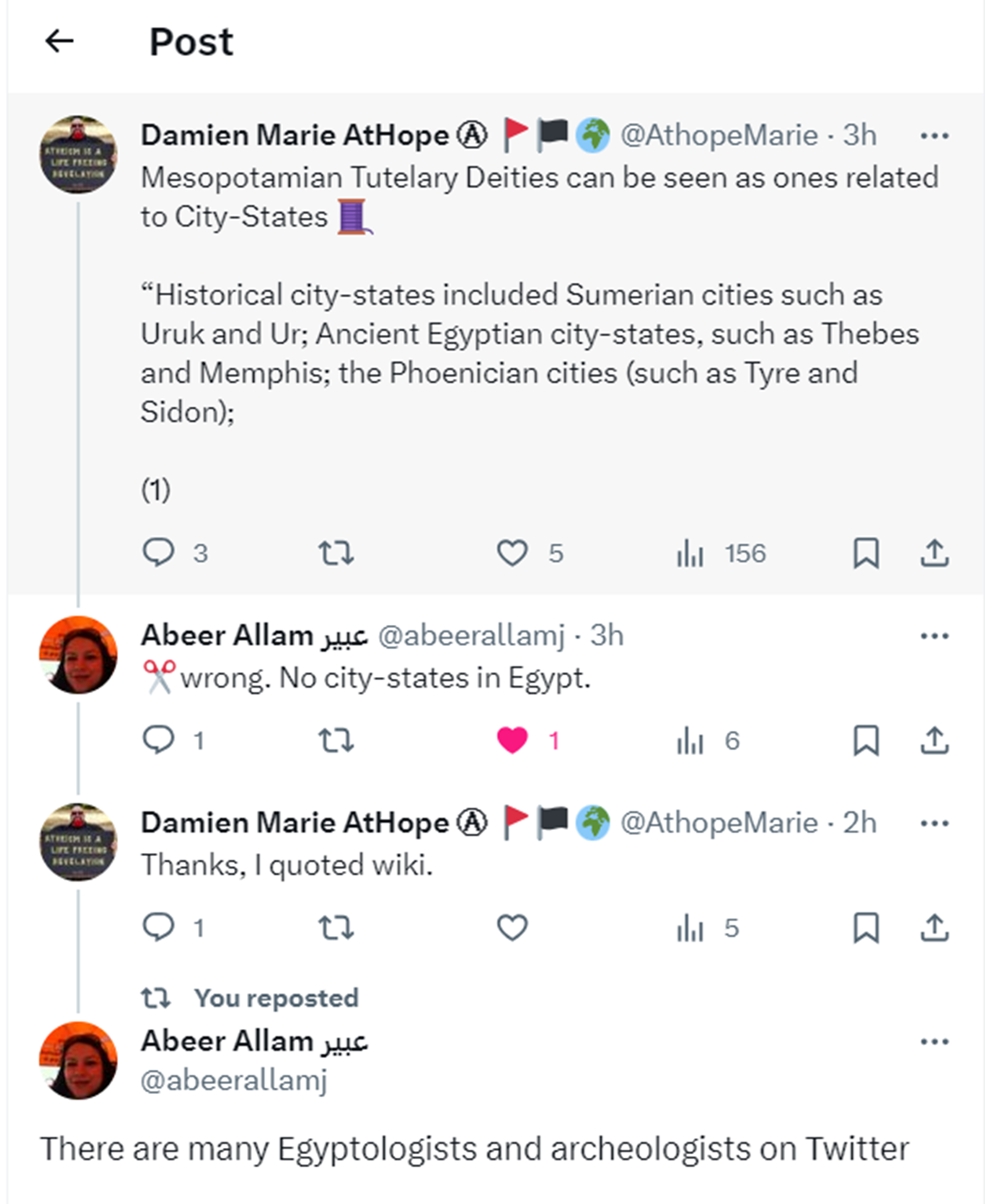
Abeer Allam @abeerallamj – “Wrong. No city-states in Egypt.” and “There are many Egyptologists and archeologists on Twitter.”
My response, Thanks, I quoted wiki. Yes, I value them and am happy you responded. I am also following a few and they follow me as well. I support mainstream archaeology, anthropology, and historical thinking and stand by archaeologists, anthropologists, and historians, appreciating all their hard work.
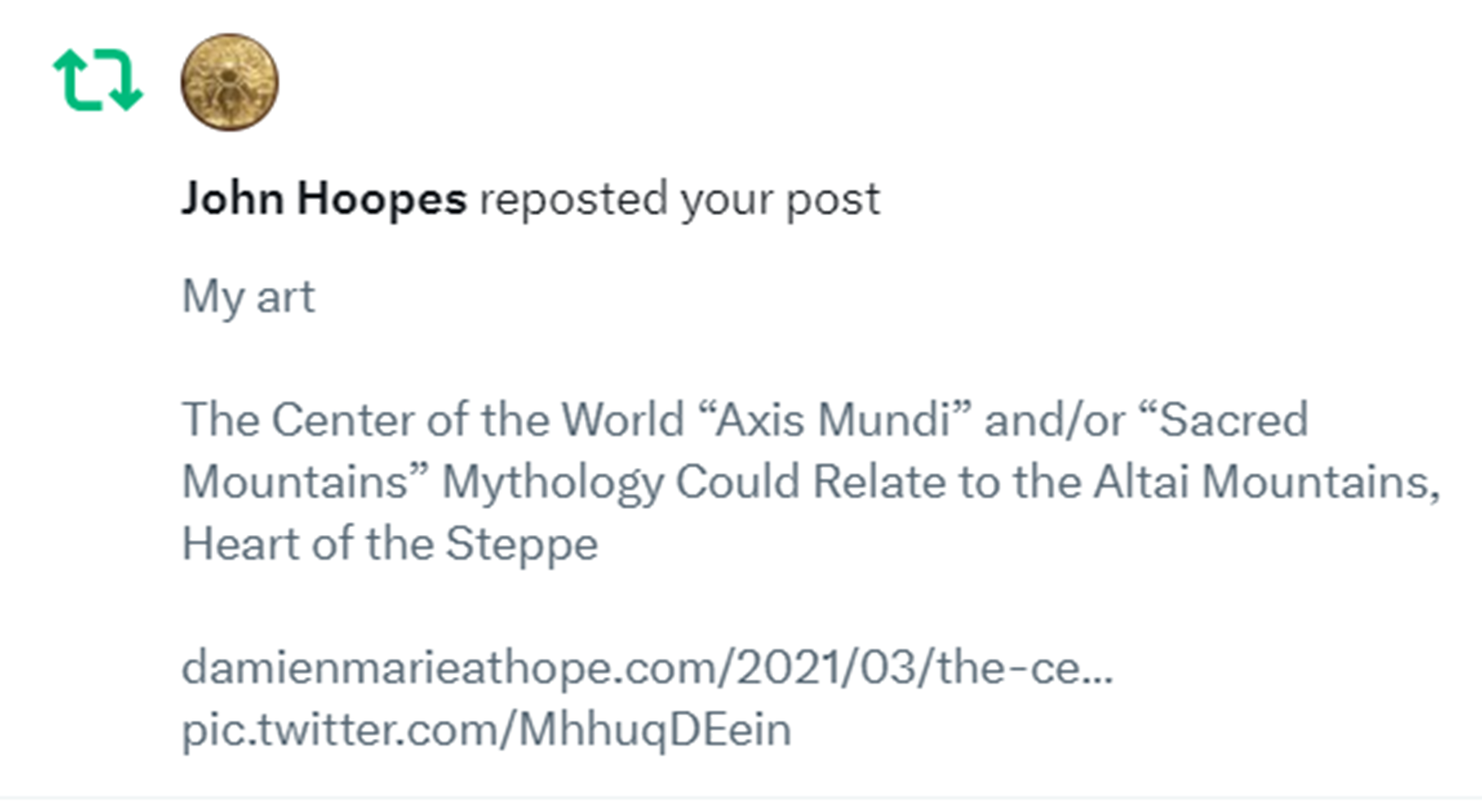
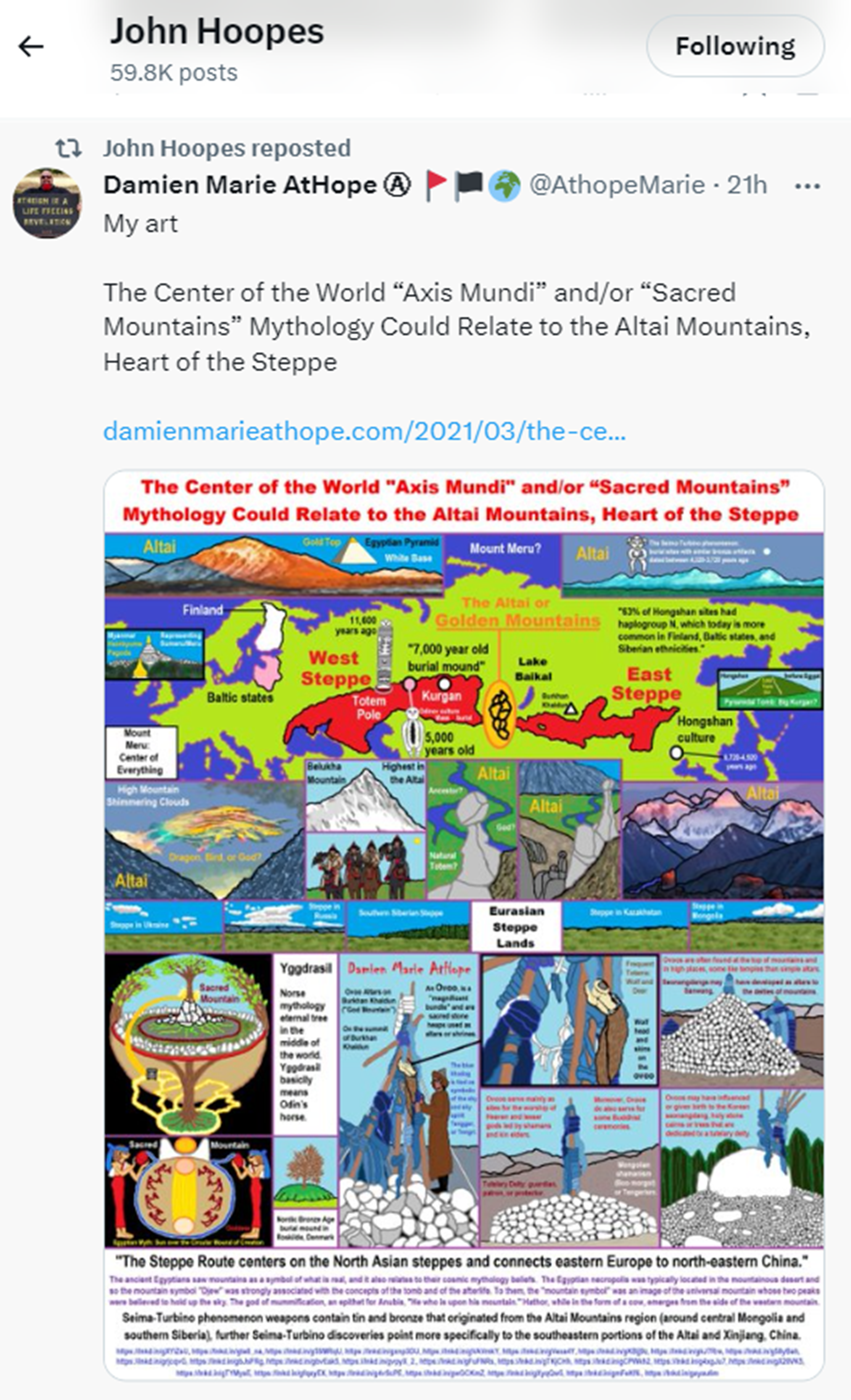
If my ideas were shit, famous Archaeologists like “John Hoopes” would never share them. So, not only, do my ideas not get real archaeologists thinking I do pseudo-archaeology/pseudo-history, they, actually, have liked my stuff, and sometimes share them.
Here is my blog post on John Hoopes @KUHoopes:
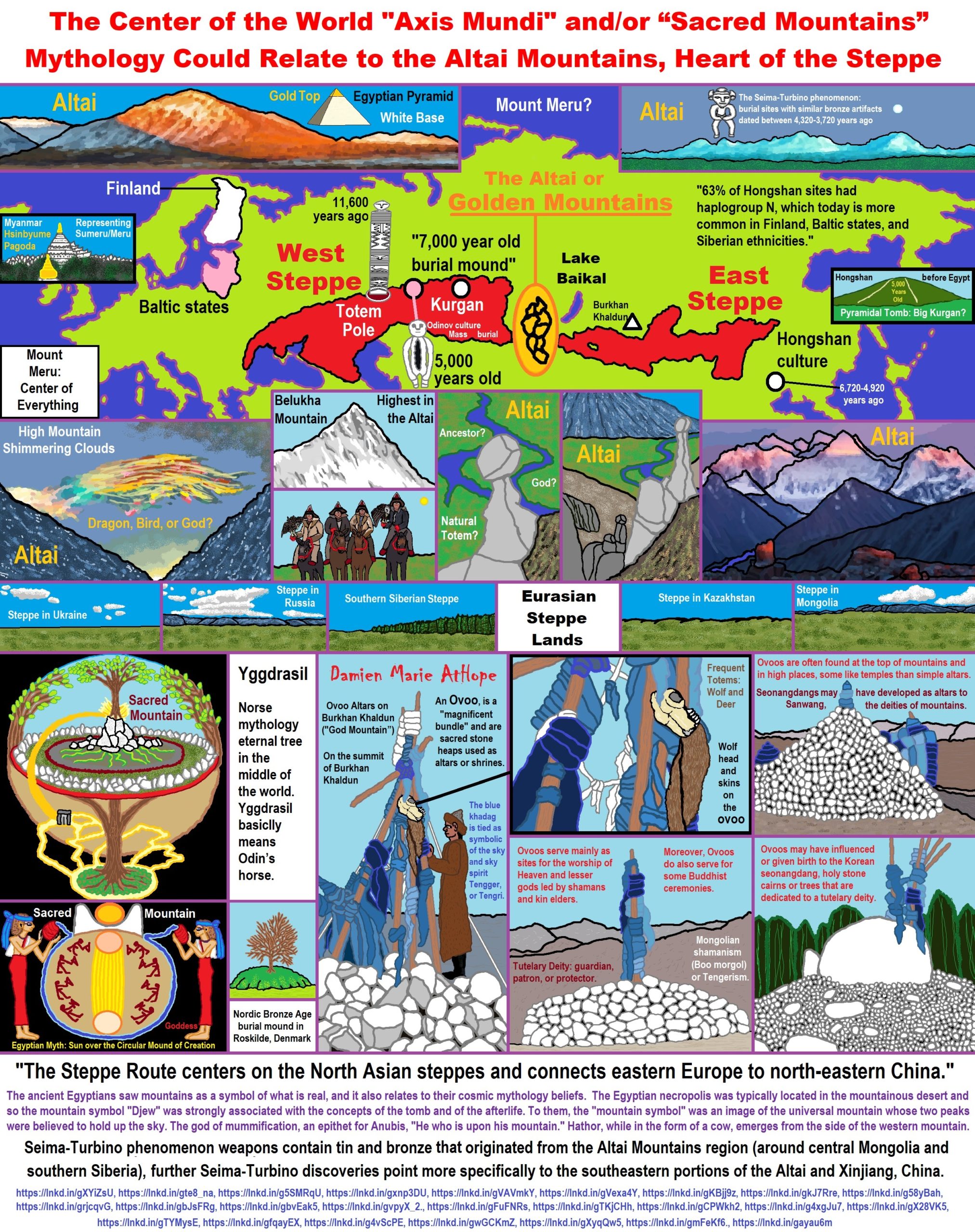
ref, ref, ref, ref, ref, ref, ref, ref, ref, ref, ref, ref, ref, ref, ref, ref, ref, ref, ref, ref, ref, ref, ref, ref, ref
The Center of the World “Axis Mundi” and/or “Sacred Mountains” Mythology Could Relate to the Altai Mountains, Heart of the Steppe
“Golden Mountains of Altai is the name of the Altai and Katun Natural Reserves, Lake Teletskoye, Belukha Mountain, and the Ukok Plateau. The region represents the most complete sequence of altitudinal vegetation zones in central Siberia, from steppe, forest-steppe, mixed forest, subalpine vegetation to alpine vegetation”. The Altai region is made up of four primary sites and landscapes: Mount Belukha, the Ukok Plateau, the Katun River, and the Karakol Valley. Mount Beluka is regarded as a sacred site to Buddhists and the Burkhanist. Their myths surrounding this portion of the mountain range lent credence to their claim that it was the location of Shangri-la (Shambala). The Ukok Plateau is an ancient burial site of the early Siberian people. Moreover, a number of myths are connected to this portion of the Golden Mountains. For example, the plateau was thought to have been the Elysian fields. The Katun River is an important religious location to the Altaians where they (during celebrations) utilize ancient ecological knowledge to restore and maintain the river. The Karakol Valley is home of three indigenous villages where tourism is greatly managed. While the Golden Mountains of Altai are listed on the World Heritage List under natural criteria, it holds information about the nomadic Scythian culture. The permafrost in these mountains has preserved Scythian burial mounds. These frozen tombs, or kurgans, hold metal objects, pieces of gold, mummified bodies, tattooed bodies, sacrificed horses, wood/leather objects, clothes, textiles, etc. However, the Ukok Plateau (in the Altai Mountains) is a sacred site to the Altai people, so archeologists and scholars who are looking to excavate the site for human remains raise controversy.” ref
Altai Mountains
“The Altai Mountains (also spelled Altay Mountains), are a mountain range in Central and East Asia, where Russia, China, Mongolia, and Kazakhstan come together, and where the rivers Irtysh and Ob have their headwaters. The massif merges with the Sayan Mountains in the northeast, and gradually becomes lower in the southeast, where it merges into the high plateau of the Gobi Desert. It spans from about 45° to 52° N and from about 84° to 99° E. The region is inhabited by a sparse but ethnically diverse population, including Russians, Kazakhs, Altais, and Mongols. The local economy is based on bovine, sheep, and horse husbandry, agriculture, forestry, and mining. The controversial Altaic language family takes its name from this mountain range.” ref
“The name comes from two words: al meaning “gold/reddish/yellowish” in Mongolic language, and -tai meaning “mountain” in Turkic languages too; thus, literally, the “Golden Mountain”. That matches their old Chinese name 金山, literally “Gold Mountain”. Also, the word altın/altun/al which means gold is a cognate word for Turkic and Mongolic languages. The mountains are called Altain nuruu (Алтайн нуруу) in Khalkha Mongolian, altai-yin niruɣu in Chakhar Mongolian, and Altay tuular (Алтай туулар) in the Altay language. They are also called Алтай таулары or التاي تاۋلارى in Kazakh; Altay dağları in Turkish; Altajskije gory (Алтайские горы) in Russian; Altay Taghliri (ىالتاي تاغلىرى or Алтай Тағлири) in Uyghur; ā’ěrtài shānmài in Chinese (阿尔泰山脉 simplified, 阿爾泰山脈 traditional, or اَعَرتَىْ شًامَىْ in Xiao’erjing); and Arteː shanmeː (Артэ Шанмэ) in Dungan.” ref
“In the north of the region is the Sailughem Mountains, also known as Kolyvan Altai, which stretch northeast from 49° N and 86° E towards the western extremity of the Sayan Mountains in 51° 60′ N and 89° E. Their mean elevation is 1,500 to 1,750 m. The snow-line runs at 2,000 m on the northern side and at 2,400 m on the southern, and above it the rugged peaks tower some 1,000 m higher. Mountain passes across the range are few and difficult, the chief being the Ulan-daban at 2,827 m (2,879 m according to Kozlov), and the Chapchan-daban, at 3,217 m, in the south and north respectively. On the east and southeast this range is flanked by the great plateau of Mongolia, the transition being affected gradually by means of several minor plateaus, such as Ukok (2,380 m) with Pazyryk Valley, Chuya (1,830 m), Kendykty (2,500 m), Kak (2,520 m), (2,590 m), and (2,410 m). This region is studded with large lakes, e.g. Uvs 720 m above sea level, Khyargas, Dorgon, and Khar 1,170 m, and traversed by various mountain ranges, of which the principal are the Tannu-Ola Mountains, running roughly parallel with the Sayan Mountains as far east as the Kosso-gol, and the Khan Khökhii mountains, also stretching west and east.” ref
“The Altai mountains are home to a diverse fauna, because of its different habitats, like steppes, northern taigas, and alpine vegetation. Steep slopes are home to the Siberian ibex (Capra sibirica), whereas the rare argali (Ovis ammon) is found on more gentle slopes. Deer are represented by five species: Altai wapiti (Cervus elaphus sibiricus), moose (Alces alces), forest reindeer (Rangifer tarandus valentinae), Siberian musk deer (Moschus moschiferus), and Siberian roe deer (Capreolus pygargus). Moose and reindeer, however, are restricted to the northern parts of the mountain range. The wild boar (Sus scrofa) is found in the lower foothills and surrounding lowlands. Until recently, the Mongolian gazelle (Procapra gutturosa) was found in the Russian Altai mountains, more specifically in the Chuya River steppe close to the Mongolian border. Large predators are represented by snow leopards (Panthera uncia, syn. Uncia uncia), wolves (Canis lupus), lynx (Lynx lynx), and brown bears (Ursus arctos), in the northern parts also by the wolverine (Gulo gulo). The Tien Shan dhole (Cuon alpinus hesperius) (a northwestern subspecies of the Asiatic wild dog) also lives there. And until the 20th century, the Caspian tiger (Panthera tigris virgata) was found in the southern parts of the Altai mountains, where it reached Lake Zaisan and the Black Irtysh. Single individuals were also shot further north, for example, close to Barnaul. Closely related to the Caspian tiger is the extant Amur tiger, which has the taxonomic name Panthera tigris altaica. The wisent was present in the Altai mountains until the Middle Ages, perhaps even until the 18th century. Today, there is a small herd in a nursery in the Altai Republic.” ref
“The Altai mountains have retained a remarkably stable climate-changing little since the last ice age. In addition, the mix of mammals has remained largely the same, with a few exceptions such as extinct mammoths, making it one of the few places on earth to retain an ice age fauna. The Altai mountains were home to the Denisovan branch of hominids who were contemporaries of Neanderthals and of Homo sapiens (modern humans), descended from Hominids who reached Asia earlier than modern humans. The Denisova hominin, dated to 40,000 years ago, was discovered in the Denisova Cave of the Altai mountains in southern Siberia. Knowledge of the Denisovan humans derives primarily from DNA evidence and artifacts, as no complete skeletons have yet been recovered. DNA evidence has been unusually well preserved because of the low average temperature in the Denisova caves. Neanderthal bones and tools made by Homo sapiens have also been found in the Denisova Cave, making it the only place in the world where all three hominids are known to have lived.” ref
A dog-like canid from 33,000 years ago was found in the Razboinichya Cave. DNA analysis published affirmed that it was more closely related to modern dogs than to wolves. The Altai Mountains have been identified as being the point of origin of a cultural enigma termed the Seima-Turbino Phenomenon which arose during the Bronze Age around the start of the 2nd millennium BCE and led to a rapid and massive migration of peoples from the region into distant parts of Europe and Asia.” ref
The five highest mountains of the Altai are:
· Belukha, 4,506 m (14,783 ft), Kazakhstan–Russia
· Khüiten Peak , 4,374 m (14,350 ft), China–Mongolia
· Mönkh Khairkhan , 4,204 m (13,793 ft), Mongolia
· Sutai Mountain , 4,220 m (13,850 ft), Mongolia
· Tsambagarav , 4,195 m (13,763 ft), Mongolia ref
“Sacred mountains are central to certain religions and are the subjects of many legends. For many, the most symbolic aspect of a mountain is the peak because it is believed that it is closest to heaven or other religious worlds. Many religions have traditions centered on sacred mountains, which either are or were considered holy (such as Mount Olympus in Greek mythology) or are related to famous events (like Mount Sinai in Judaism and descendant religions). In some cases, the sacred mountain is purely mythical, like the Hara Berezaiti in Zoroastrianism. Mount Kailash is believed to be the abode of the Hindu deities Shiva and Parvati, and is considered sacred in four religions: Hinduism, Bon, Buddhism, and Jainism. Volcanoes, such as Mount Etna in Italy, were also considered sacred, Mount Etna being believed to have been the home of Vulcan, the Roman god of fire and the forge. The north face of Mount Kailash, a mountain in the Tibet Autonomous Region of China which is considered sacred by four religions.” ref
I am not an academic. I am a revolutionary that teaches in public, in places like social media, and in the streets. I am not a leader by some title given but from my commanding leadership style of simply to start teaching everywhere to everyone, all manner of positive education.
My Thoughts on the Evolution of Gods?
Animal protector deities from old totems/spirit animal beliefs come first to me, 13,000/12,000 years ago, then women as deities 11,000/10,000 years ago, then male gods around 7,000/8,000 years ago. Moralistic gods around 5,000/4,000 years ago, and monotheistic gods around 4,000/3,000 years ago.
To me, the “male god” seems to have either emerged or become prominent around 7,000 years ago, whereas the now favored monotheism “male god” is more like 4,000 years ago or so. To me, the “female goddess” seems to have either emerged or become prominent around 11,000-10,000 years ago or so, losing the majority of its once prominence around 2,000 years ago due largely to the now favored monotheism “male god” that grow in prominence after 4,000 years ago or so.
To me, animal gods were likely first related to totemism animals around 13,000 to 12,000 years ago or older. Female as goddesses was next to me, 11,000 to 10,000 years ago or so with the emergence of agriculture. Then male gods come about 8,000 to 7,000 years ago with clan wars. Many monotheism-themed religions started in henotheism, emerging out of polytheism/paganism.
Gods?
“Animism” is needed to begin supernatural thinking.
“Totemism” is needed for supernatural thinking connecting human actions & related to clan/tribe.
“Shamanism” is needed for supernatural thinking to be controllable/changeable by special persons.
Together = Gods/paganism
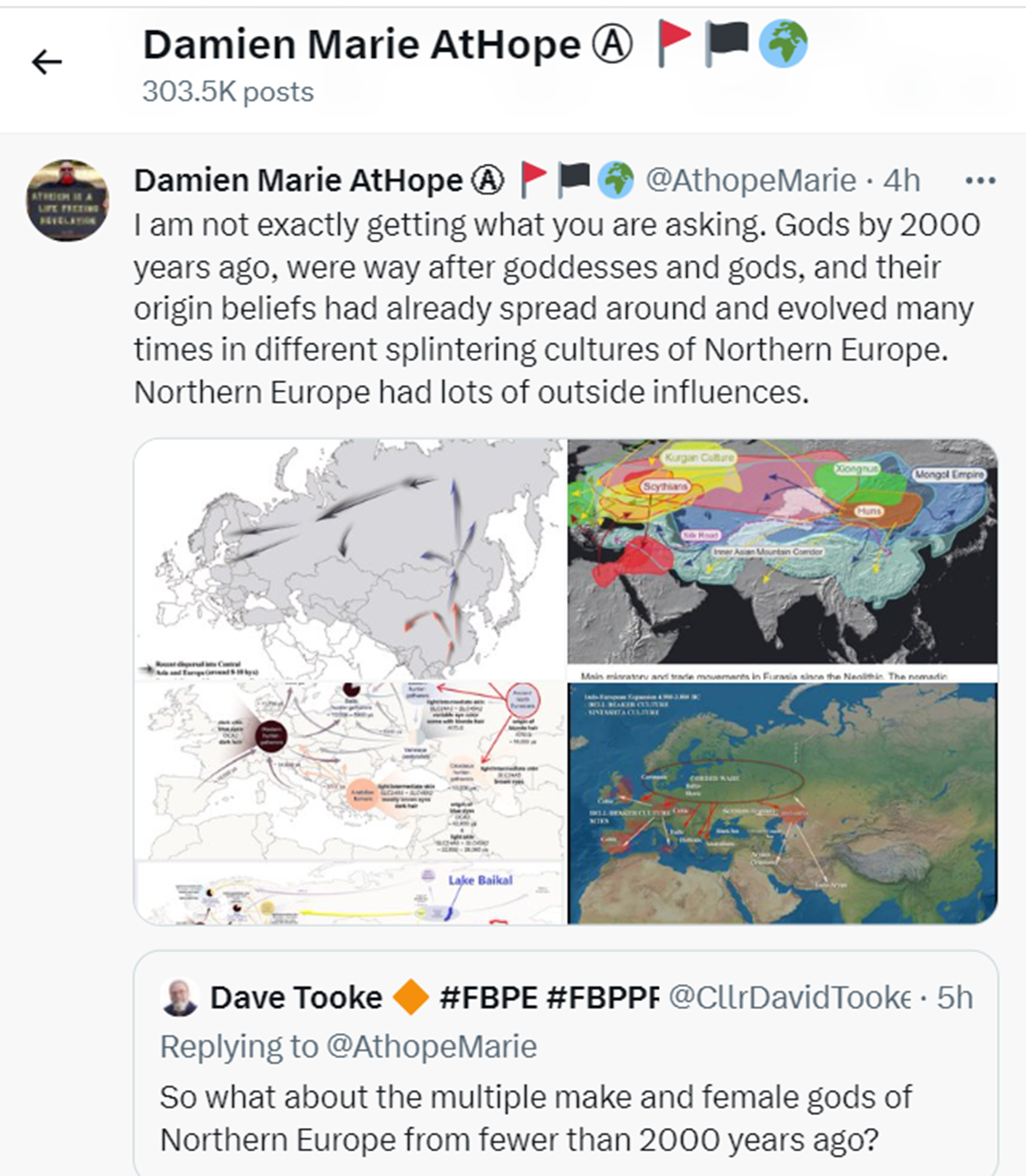
Dave Tooke @CllrDavidTooke – “So what about the multiple male and female gods of Northern Europe from fewer than 2000 years ago?”
My response, I am not exactly getting what you are asking. Gods by 2000 years ago, were way after goddesses and gods, and their origin beliefs had already spread around and evolved many times in different splintering cultures of Northern Europe. Northern Europe had lots of outside influences.
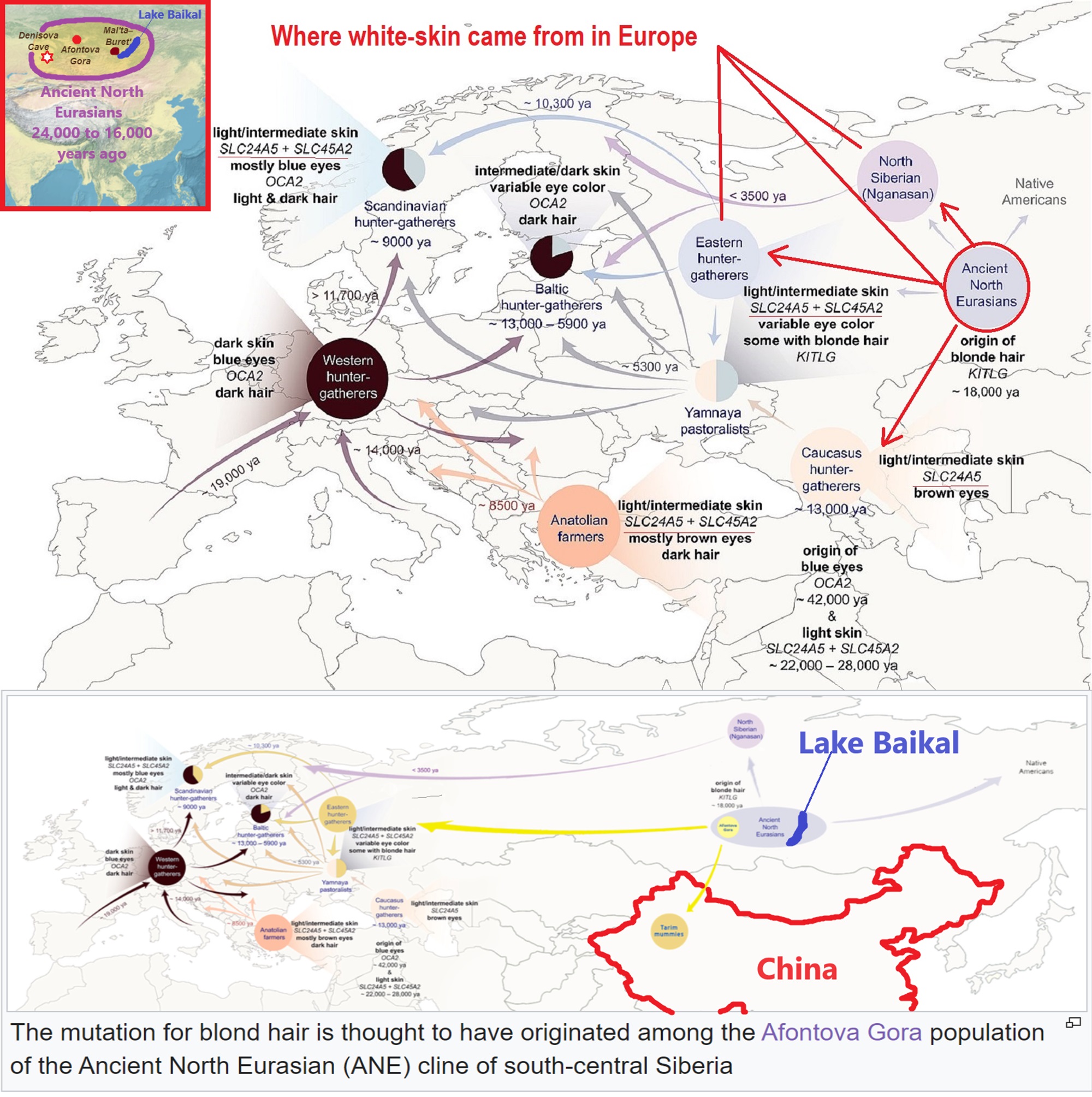
“Lighter skin and blond hair evolved in the Ancient North Eurasian (ANE) population. The SLC24A5 gene’s derived threonine or Ala111Thr allele (rs1426654) has been shown to be a major factor in the light skin tone of Europeans. Possibly originating as long as 19,000 years ago, it has been the subject of selection in the ancestors of Europeans as recently as within the last 5,000 years, and is fixed in modern European populations.” ref, ref

I tried to put all the DNA migrations, that together help explain Sami DNA, and thus some of their cultural influences.

ref, ref, ref, ref, ref, ref, ref, ref, ref, ref, ref, ref, ref, ref, ref, ref
Postglacial genomes from foragers across Northern Eurasia reveal prehistoric
mobility associated with the spread of the Uralic and Yeniseian languages
Abstract
“The North Eurasian forest and forest-steppe zones have sustained millennia of sociocultural connections among northern peoples. We present genome-wide ancient DNA data for 181 individuals from this region spanning the Mesolithic, Neolithic, and Bronze Age. We find that Early to Mid-Holocene hunter-gatherer populations from across the southern forest and forest-steppes of Northern Eurasia can be characterized by a continuous gradient of ancestry that remained stable for millennia, ranging from fully West Eurasian in the Baltic region to fully East Asian in the Transbaikal region. In contrast, cotemporaneous groups in far Northeast Siberia were genetically distinct, retaining high levels of continuity from a population that was the primary source of ancestry for Native Americans. By the mid-Holocene, admixture between this early Northeastern Siberian population and groups from Inland East Asia and the Amur River Basin produced two distinctive populations in eastern Siberia that played an important role in the genetic formation of later people. Ancestry from the first population, Cis-Baikal Late Neolithic-Bronze Age (Cisbaikal_LNBA), is found substantially only among Yeniseian-speaking groups and those known to have admixed with them. Ancestry from the second, Yakutian Late Neolithic-Bronze Age (Yakutia_LNBA), is strongly associated with present-day Uralic speakers. We show how Yakutia_LNBA ancestry spread from an east Siberian origin ~4.5kya, along with subclades of Y-chromosome haplogroup N occurring at high frequencies among present-day Uralic speakers, into Western and Central Siberia in communities associated with Seima-Turbino metallurgy: a suite of advanced bronze casting techniques that spread explosively across an enormous region of Northern Eurasia ~4.0kya. However, the ancestry of the 16 Seima-Turbino-period individuals–the first reported from sites with this metallurgy–was otherwise extraordinarily diverse, with partial descent from Indo-Iranian-speaking pastoralists and multiple hunter-gatherer populations from widely separated regions of Eurasia. Our results provide support for theories suggesting that early Uralic speakers at the beginning of their westward dispersal where involved in the expansion of Seima-Turbino metallurgical traditions, and suggests that both cultural transmission and migration were important in the spread of Seima-Turbino material culture.” ref
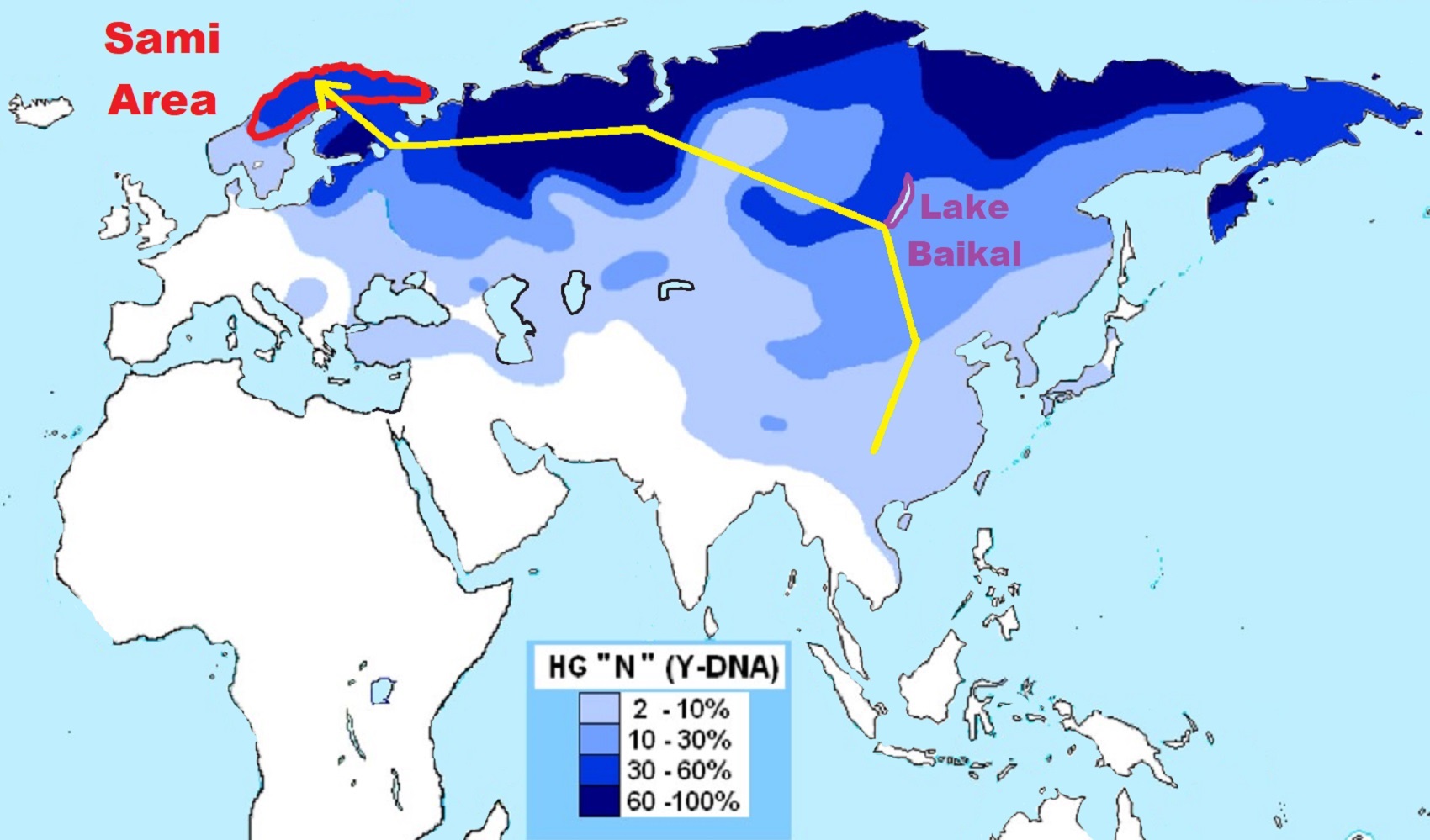

Globalization and the Emergence of Ceramic-using Hunter-gatherers in Northern Eurasia
The transmission of pottery technology among prehistoric European hunter-gatherers
“Although isolated cases of innovation cannot be excluded, a continuous process of adoption with the earlier occurrence of an antecedent tradition in western Siberia or central Asia, Siberia fit better though both are consistent with an ultimate origin for these traditions in the Far East.” ref
New Rituals and Violence with the appearance of Pottery and People?
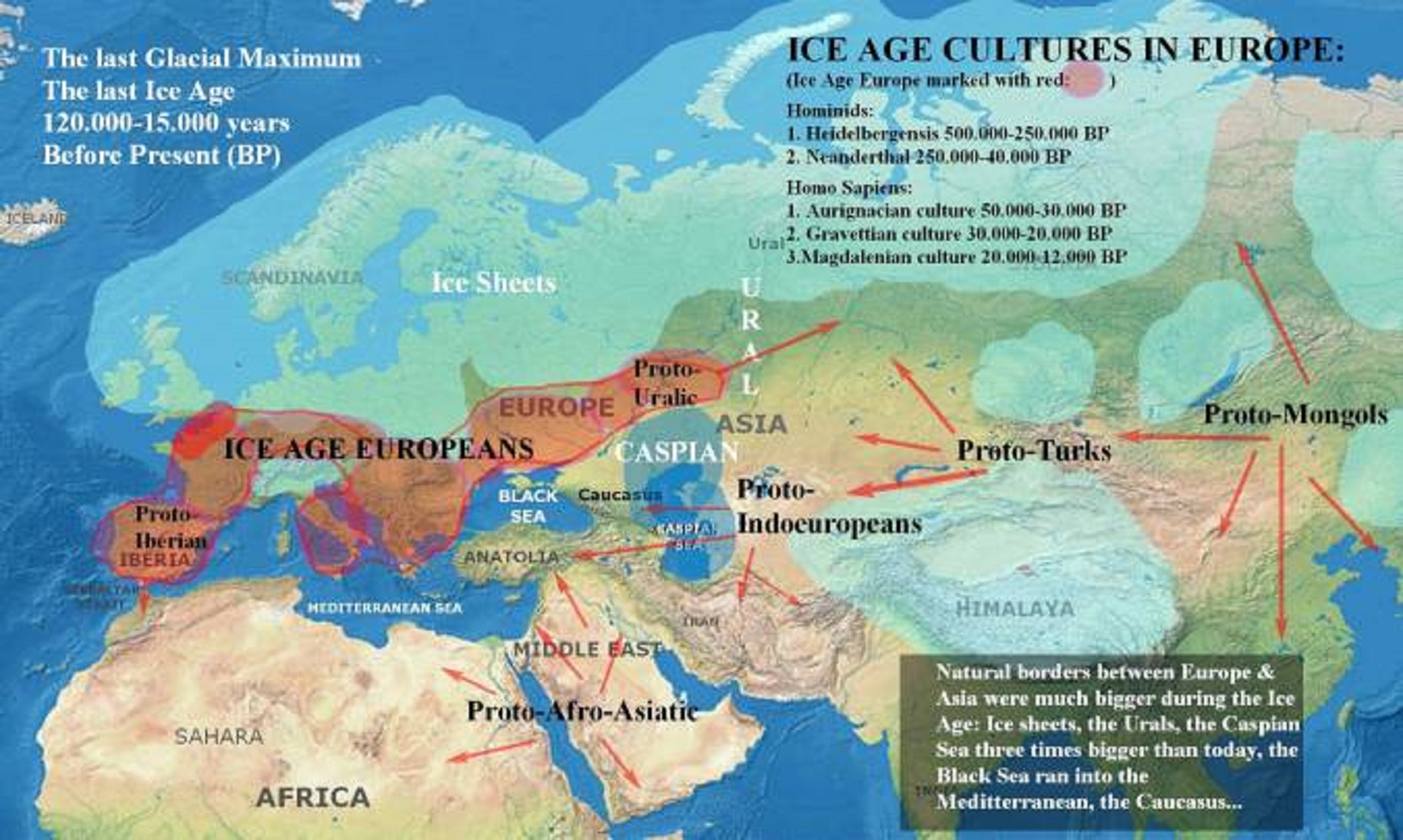
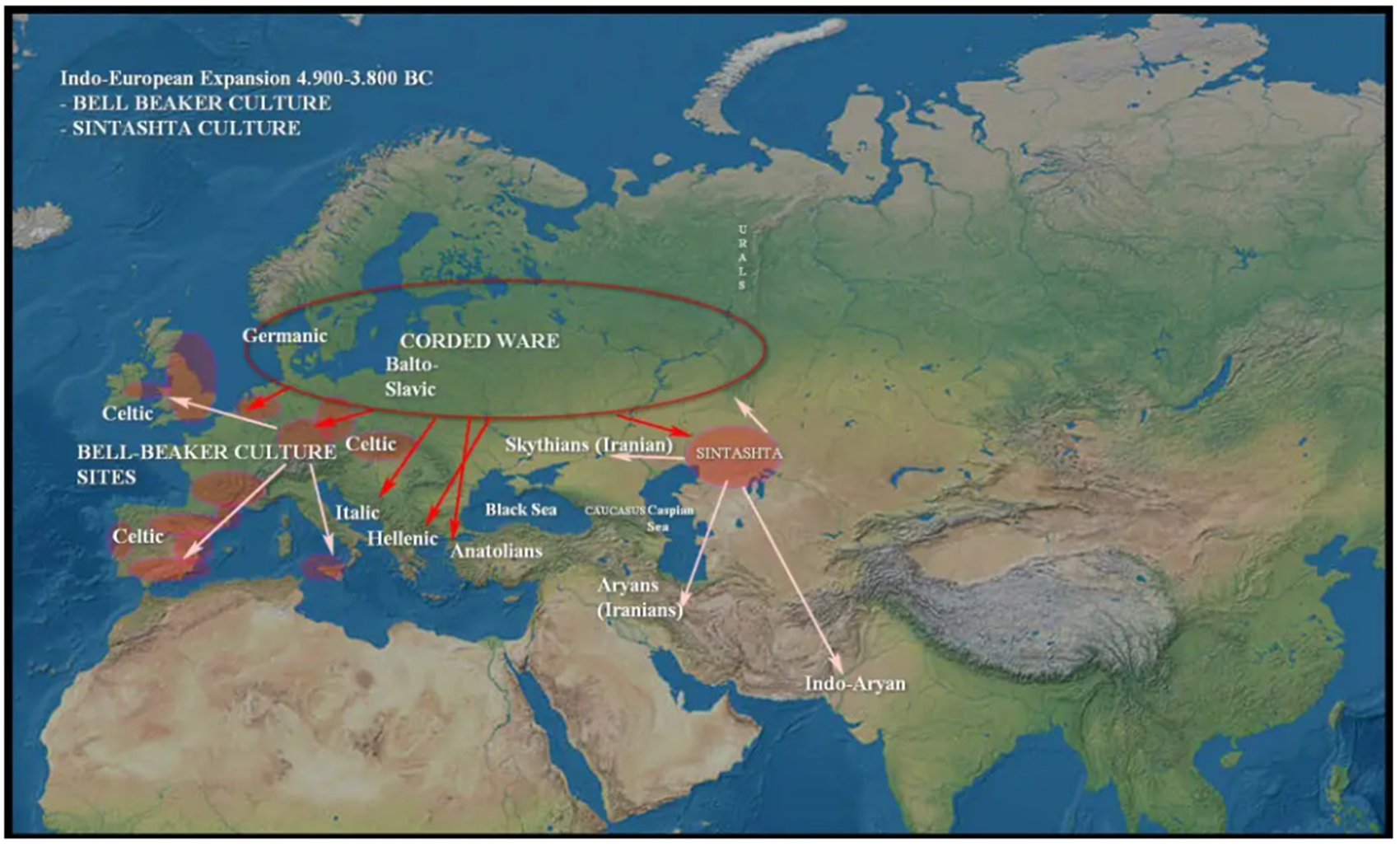
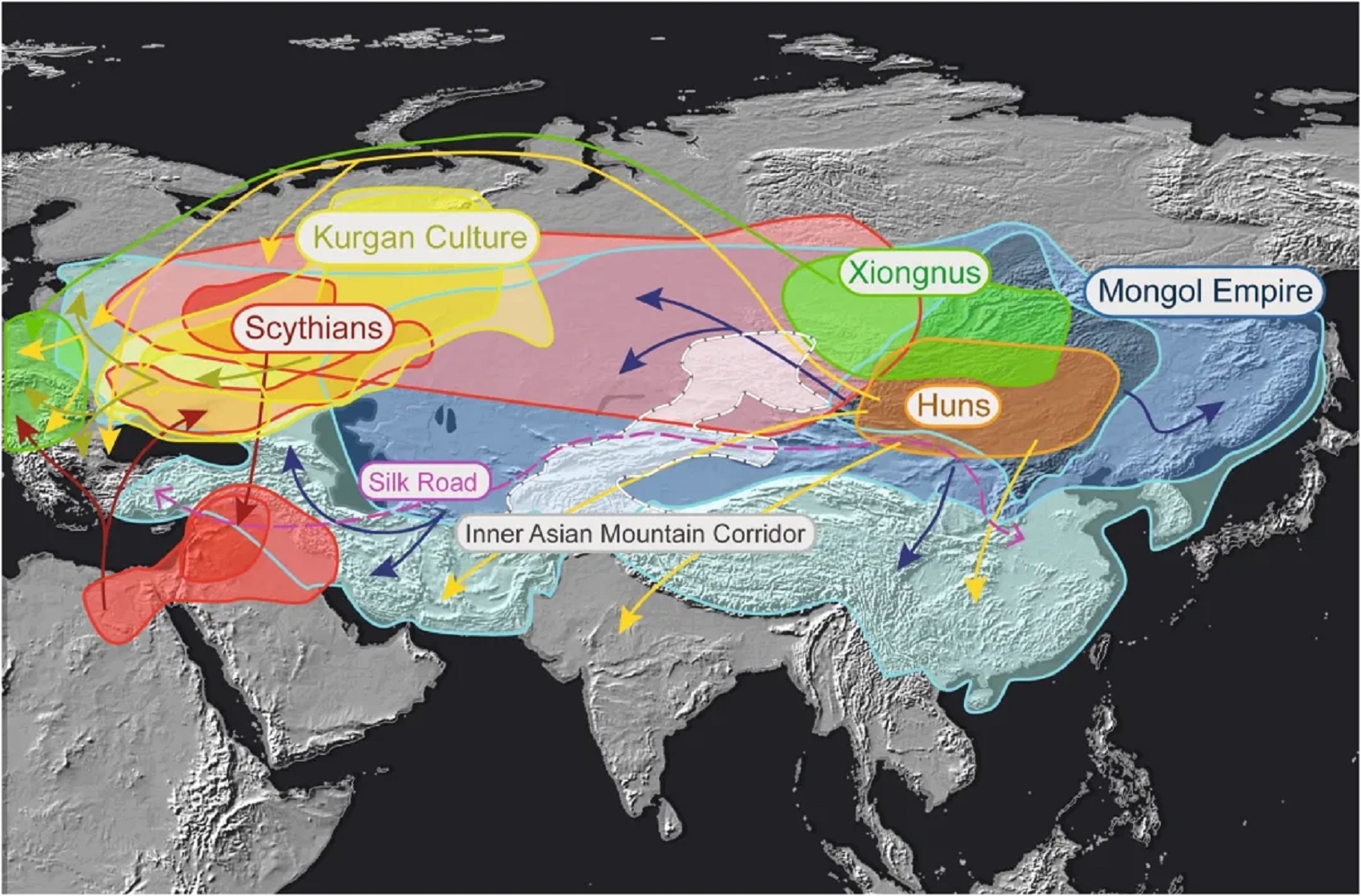

ref, ref, ref, ref, ref, ref, ref, ref, ref, ref, ref, ref, ref, ref, ref, ref, ref
“These ideas are my speculations from the evidence.”
I am still researching the “god‘s origins” all over the world. So you know, it is very complicated but I am smart and willing to look, DEEP, if necessary, which going very deep does seem to be needed here, when trying to actually understand the evolution of gods and goddesses. I am sure of a few things and less sure of others, but even in stuff I am not fully grasping I still am slowly figuring it out, to explain it to others. But as I research more I am understanding things a little better, though I am still working on understanding it all or something close and thus always figuring out more.
Sky Father/Sky God?
“Egyptian: (Nut) Sky Mother and (Geb) Earth Father” (Egypt is different but similar)
Turkic/Mongolic: (Tengri/Tenger Etseg) Sky Father and (Eje/Gazar Eej) Earth Mother *Transeurasian*
Hawaiian: (Wākea) Sky Father and (Papahānaumoku) Earth Mother *Austronesian*
New Zealand/ Māori: (Ranginui) Sky Father and (Papatūānuku) Earth Mother *Austronesian*
Proto-Indo-European: (Dyḗus/Dyḗus ph₂tḗr) Sky Father and (Dʰéǵʰōm/Pleth₂wih₁) Earth Mother
Indo-Aryan: (Dyaus Pita) Sky Father and (Prithvi Mata) Earth Mother *Indo-European*
Italic: (Jupiter) Sky Father and (Juno) Sky Mother *Indo-European*
Etruscan: (Tinia) Sky Father and (Uni) Sky Mother *Tyrsenian/Italy Pre–Indo-European*
Hellenic/Greek: (Zeus) Sky Father and (Hera) Sky Mother who started as an “Earth Goddess” *Indo-European*
Nordic: (Dagr) Sky Father and (Nótt) Sky Mother *Indo-European*
Slavic: (Perun) Sky Father and (Mokosh) Earth Mother *Indo-European*
Illyrian: (Deipaturos) Sky Father and (Messapic Damatura’s “earth-mother” maybe) Earth Mother *Indo-European*
Albanian: (Zojz) Sky Father and (?) *Indo-European*
Baltic: (Perkūnas) Sky Father and (Saulė) Sky Mother *Indo-European*
Germanic: (Týr) Sky Father and (?) *Indo-European*
Colombian-Muisca: (Bochica) Sky Father and (Huythaca) Sky Mother *Chibchan*
Aztec: (Quetzalcoatl) Sky Father and (Xochiquetzal) Sky Mother *Uto-Aztecan*
Incan: (Viracocha) Sky Father and (Mama Runtucaya) Sky Mother *Quechuan*
China: (Tian/Shangdi) Sky Father and (Dì) Earth Mother *Sino-Tibetan*
Sumerian, Assyrian and Babylonian: (An/Anu) Sky Father and (Ki) Earth Mother
Finnish: (Ukko) Sky Father and (Akka) Earth Mother *Finno-Ugric*
Sami: (Horagalles) Sky Father and (Ravdna) Earth Mother *Finno-Ugric*
Puebloan-Zuni: (Ápoyan Ta’chu) Sky Father and (Áwitelin Tsíta) Earth Mother
Puebloan-Hopi: (Tawa) Sky Father and (Kokyangwuti/Spider Woman/Grandmother) Earth Mother *Uto-Aztecan*
Puebloan-Navajo: (Tsohanoai) Sky Father and (Estsanatlehi) Earth Mother *Na-Dene*
ref, ref, ref, ref, ref, ref, ref, ref, ref, ref, ref, ref, ref, ref, ref, ref, ref, ref, ref, ref, ref, ref, ref, ref, ref, ref, ref

“These ideas are my speculations from the evidence.”
“1 central Eurasian Neolithic individual from Tajikistan (around 8,000 years ago) and approximately 8,200 years ago Yuzhniy Oleniy Ostrov group from Karelia in western Russia formed by 19 genomes affinity to Villabruna ancestry than all the other Eastern Hunter-Gatherer groups” https://www.nature.com/articles/s41586-023-05726-0

Gods are taught, to children, thus the majority of the world’s beliefs.

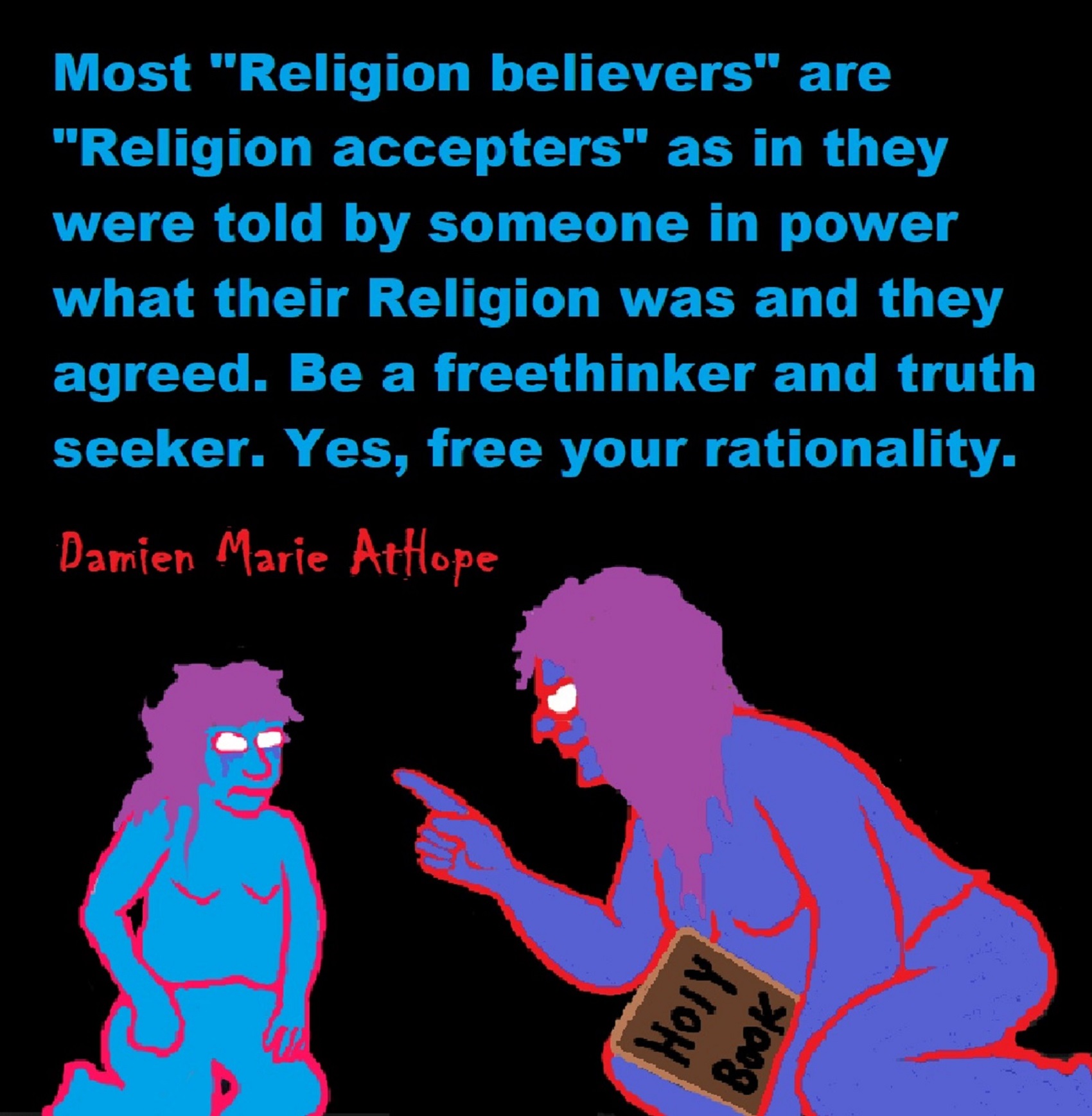

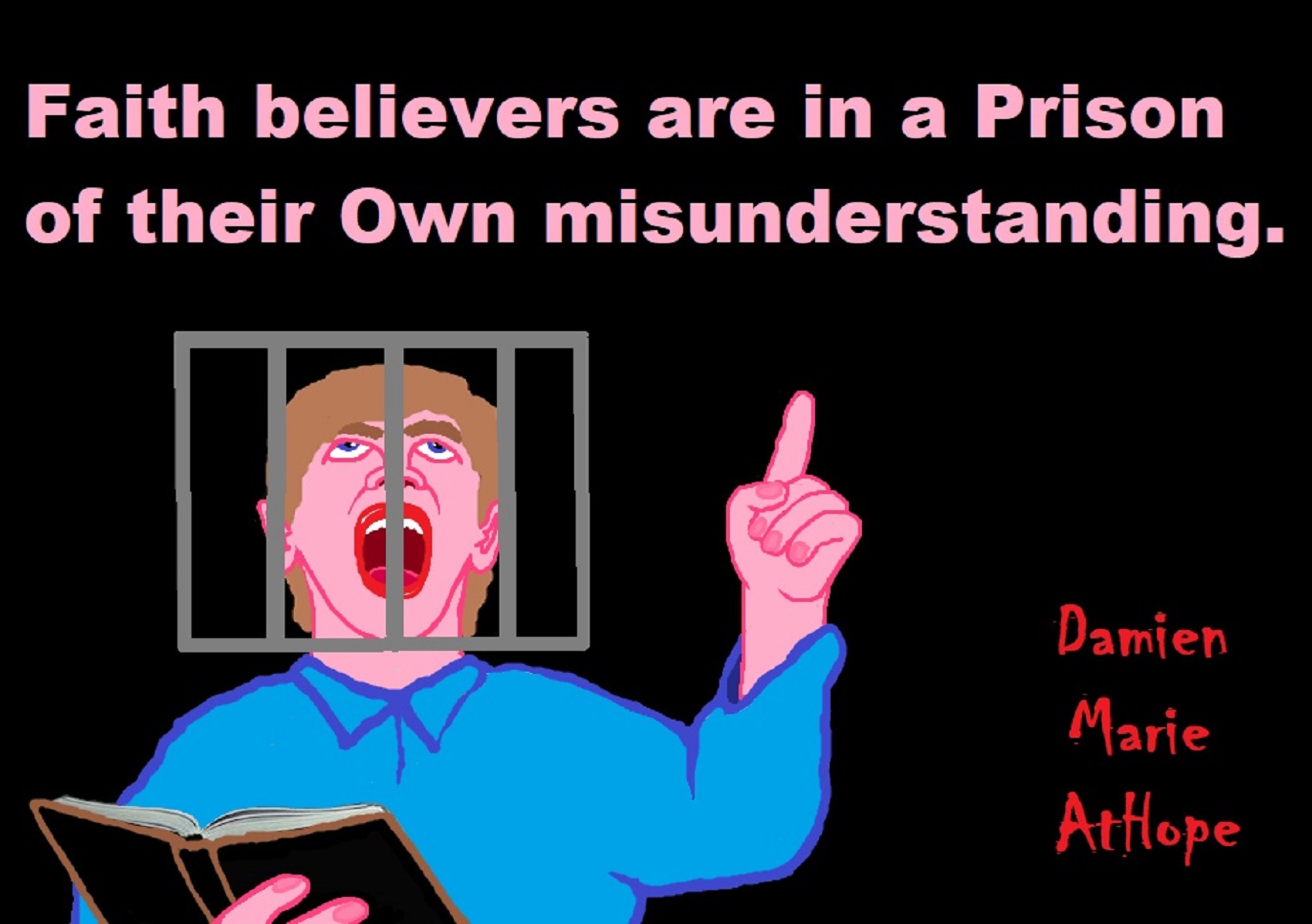
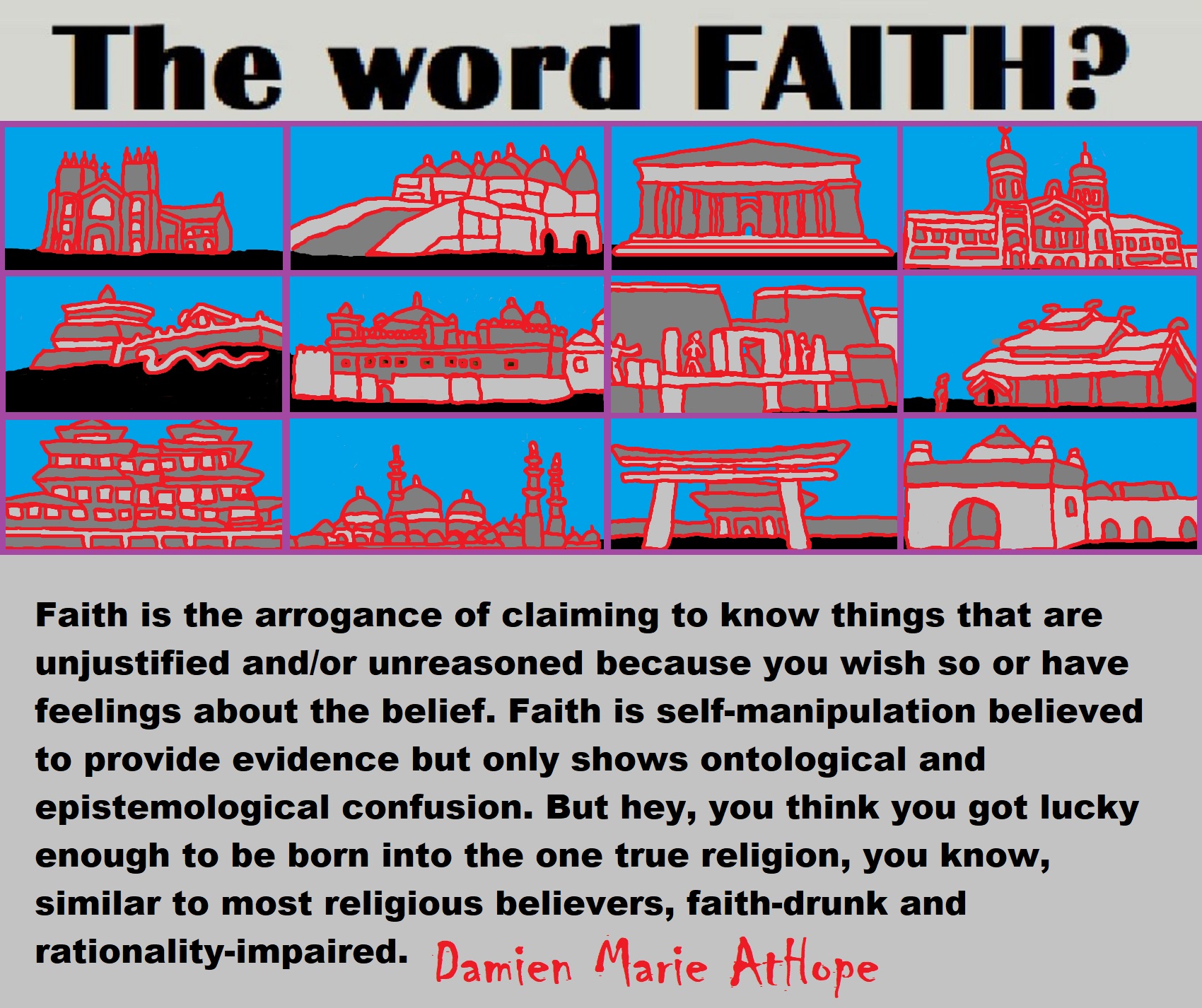

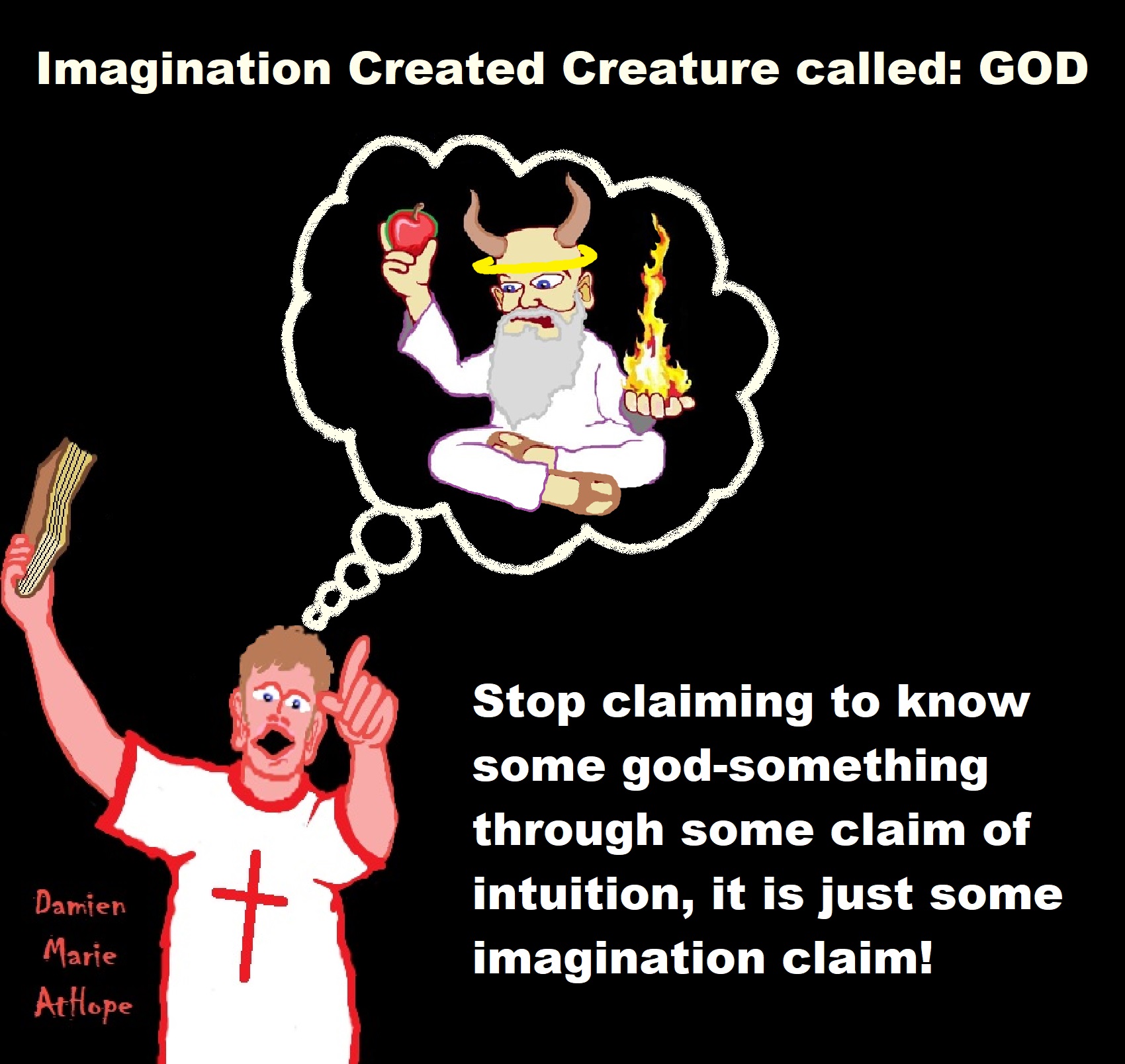

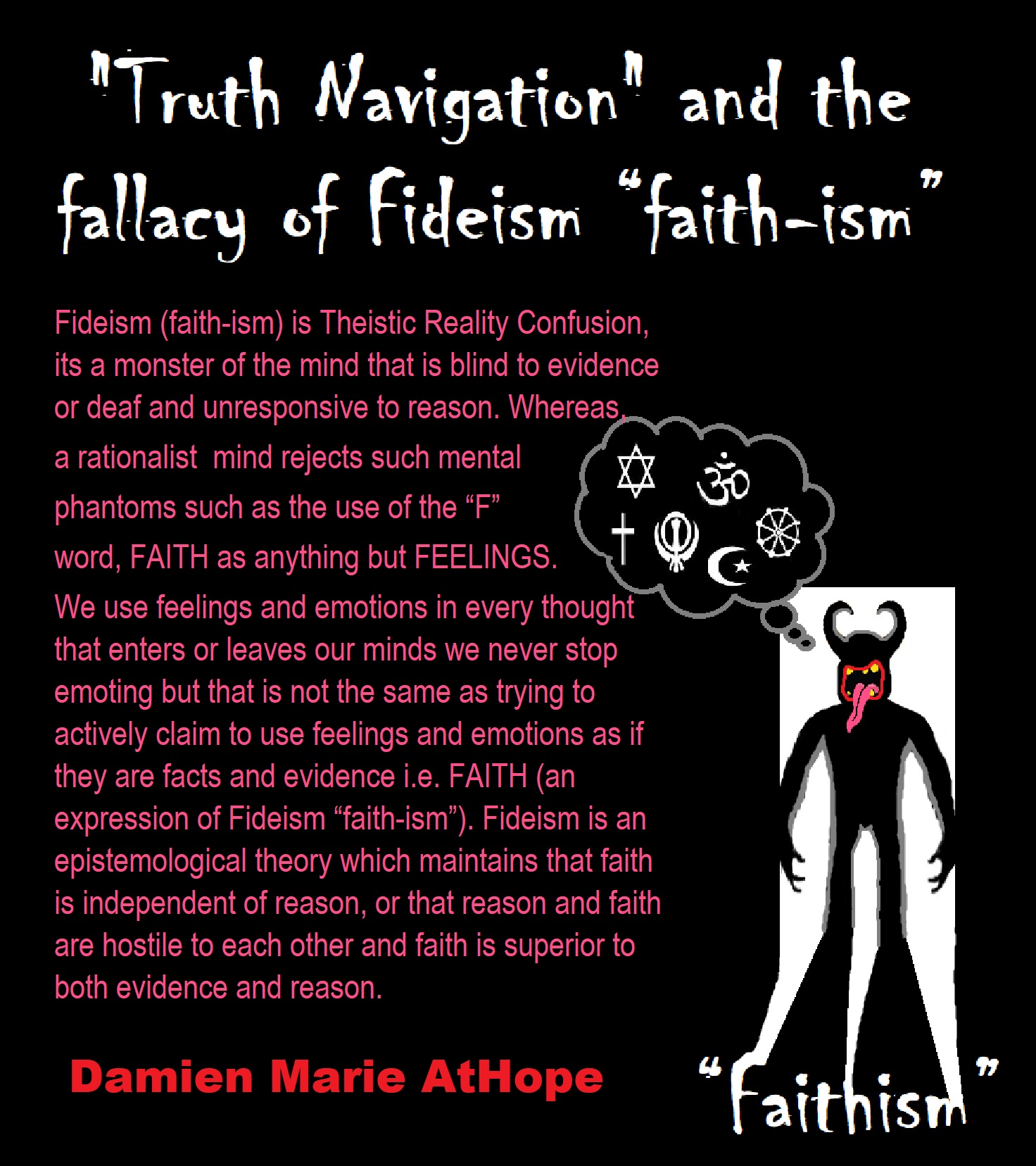
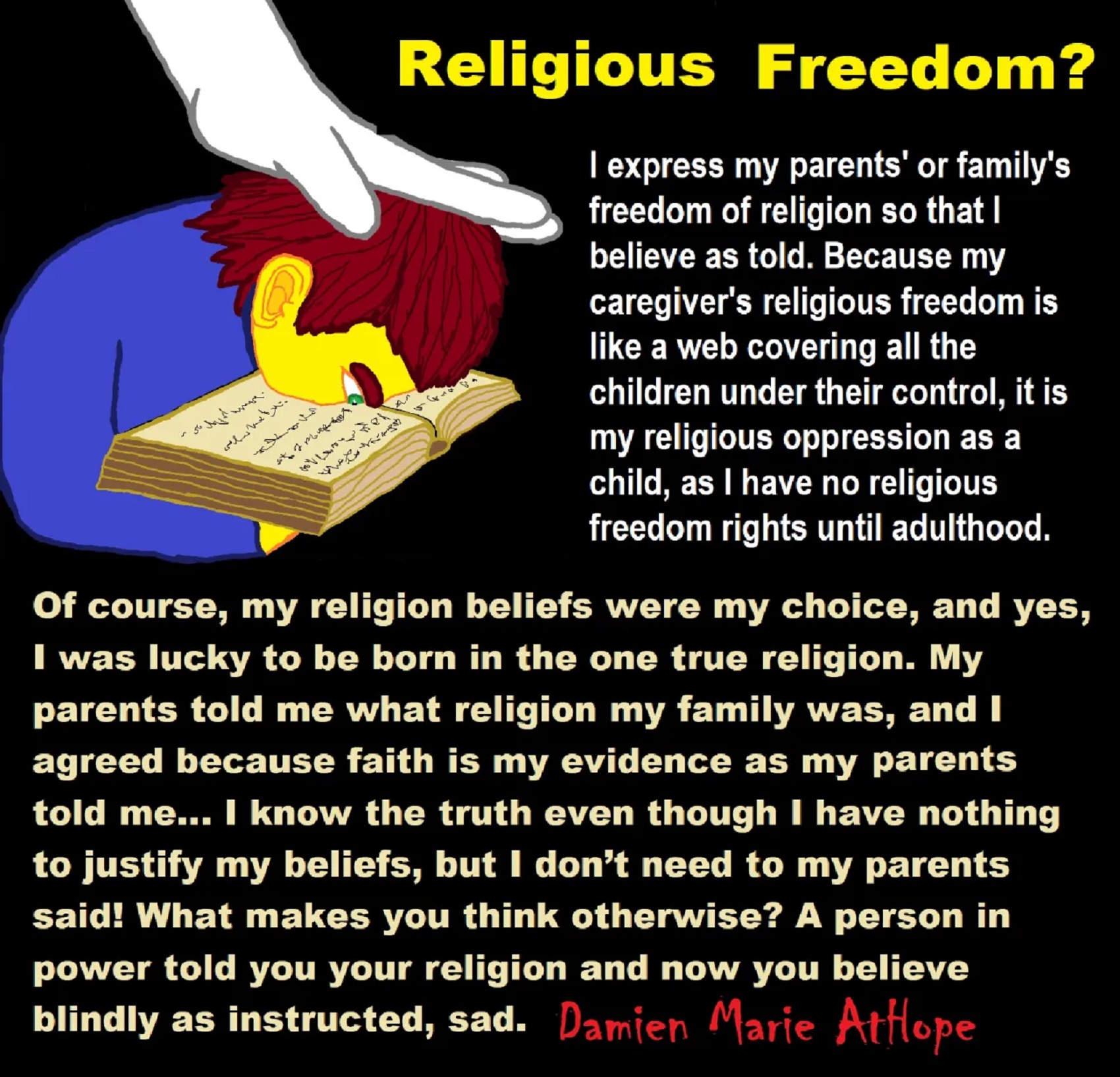
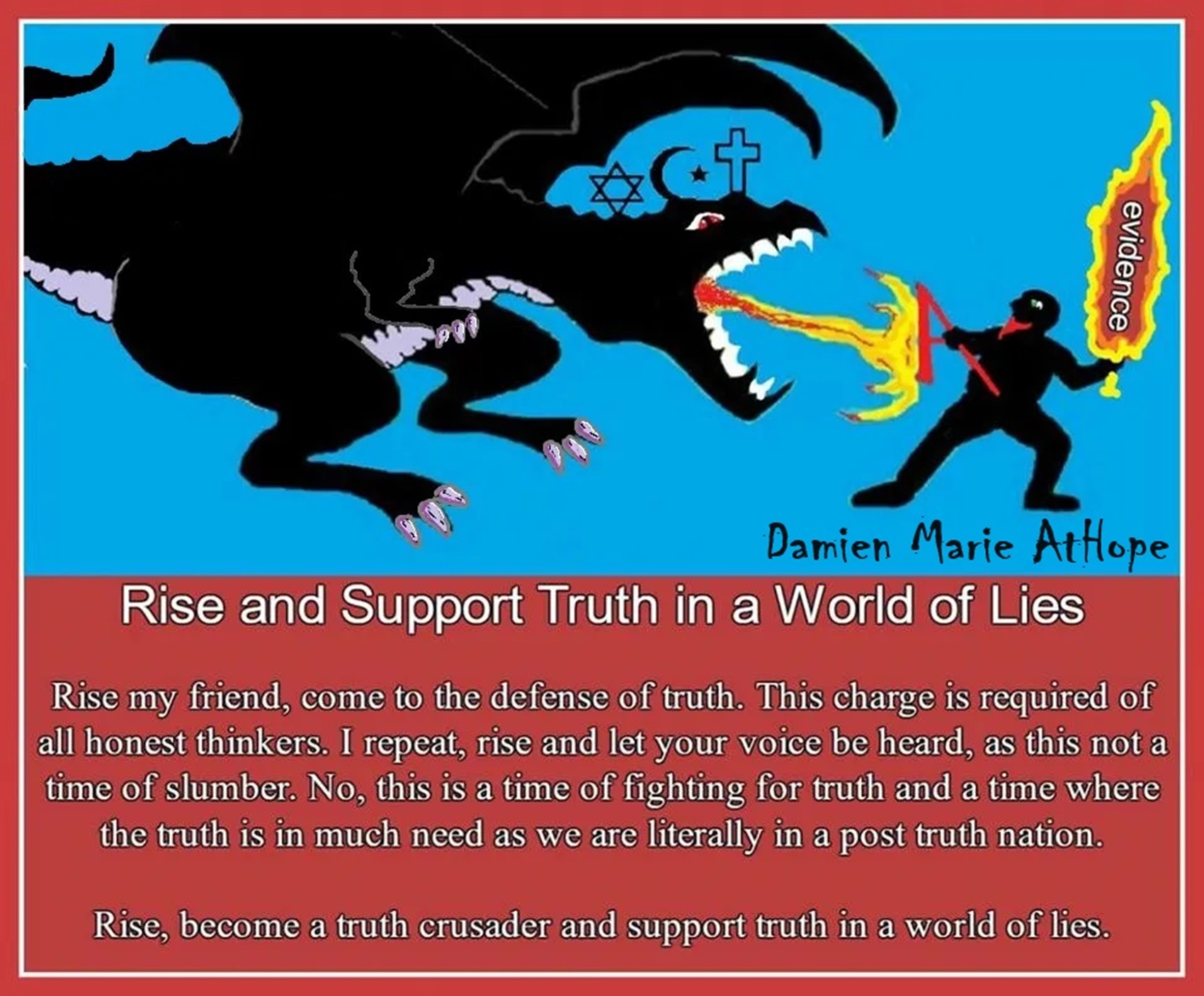

People don’t commonly teach religious history, even that of their own claimed religion. No, rather they teach a limited “pro their religion” history of their religion from a religious perspective favorable to the religion of choice.

Do you truly think “Religious Belief” is only a matter of some personal choice?
Do you not see how coercive one’s world of choice is limited to the obvious hereditary belief, in most religious choices available to the child of religious parents or caregivers? Religion is more commonly like a family, culture, society, etc. available belief that limits the belief choices of the child and that is when “Religious Belief” is not only a matter of some personal choice and when it becomes hereditary faith, not because of the quality of its alleged facts or proposed truths but because everyone else important to the child believes similarly so they do as well simply mimicking authority beliefs handed to them. Because children are raised in religion rather than being presented all possible choices but rather one limited dogmatic brand of “Religious Belief” where children only have a choice of following the belief as instructed, and then personally claim the faith hereditary belief seen in the confirming to the belief they have held themselves all their lives. This is obvious in statements asked and answered by children claiming a faith they barely understand but they do understand that their family believes “this or that” faith, so they feel obligated to believe it too. While I do agree that “Religious Belief” should only be a matter of some personal choice, it rarely is… End Hereditary Religion!

Animism: Respecting the Living World by Graham Harvey
“How have human cultures engaged with and thought about animals, plants, rocks, clouds, and other elements in their natural surroundings? Do animals and other natural objects have a spirit or soul? What is their relationship to humans? In this new study, Graham Harvey explores current and past animistic beliefs and practices of Native Americans, Maori, Aboriginal Australians, and eco-pagans. He considers the varieties of animism found in these cultures as well as their shared desire to live respectfully within larger natural communities. Drawing on his extensive casework, Harvey also considers the linguistic, performative, ecological, and activist implications of these different animisms.” ref

We are like believing machines we vacuum up ideas, like Velcro sticks to almost everything. We accumulate beliefs that we allow to negatively influence our lives, often without realizing it. Our willingness must be to alter skewed beliefs that impend our balance or reason, which allows us to achieve new positive thinking and accurate outcomes.

My thoughts on Religion Evolution with external links for more info:
- (Pre-Animism Africa mainly, but also Europe, and Asia at least 300,000 years ago), (Pre-Animism – Oxford Dictionaries)
- (Animism Africa around 100,000 years ago), (Animism – Britannica.com)
- (Totemism Europe around 50,000 years ago), (Totemism – Anthropology)
- (Shamanism Siberia around 30,000 years ago), (Shamanism – Britannica.com)
- (Paganism Turkey around 12,000 years ago), (Paganism – BBC Religion)
- (Progressed Organized Religion “Institutional Religion” Egypt around 5,000 years ago), (Ancient Egyptian Religion – Britannica.com)
- (CURRENT “World” RELIGIONS after 4,000 years ago) (Origin of Major Religions – Sacred Texts)
- (Early Atheistic Doubting at least by 2,600 years ago) (History of Atheism – Wikipedia)
“Religion is an Evolved Product” and Yes, Religion is Like Fear Given Wings…
Atheists talk about gods and religions for the same reason doctors talk about cancer, they are looking for a cure, or a firefighter talks about fires because they burn people and they care to stop them. We atheists too often feel a need to help the victims of mental slavery, held in the bondage that is the false beliefs of gods and the conspiracy theories of reality found in religions.
Understanding Religion Evolution:
- Pre-Animism (at least 300,000 years ago)
- Animism (Africa: 100,000 years ago)
- Totemism (Europe: 50,000 years ago)
- Shamanism (Siberia: 30,000 years ago)
- Paganism (Turkey: 12,000 years ago)
- Progressed organized religion (Egypt: 5,000 years ago), (Egypt, the First Dynasty 5,150 years ago)
- CURRENT “World” RELIGIONS (after 4,000 years ago)
- Early Atheistic Doubting (at least by 2,600 years ago)
“An Archaeological/Anthropological Understanding of Religion Evolution”
It seems ancient peoples had to survived amazing threats in a “dangerous universe (by superstition perceived as good and evil),” and human “immorality or imperfection of the soul” which was thought to affect the still living, leading to ancestor worship. This ancestor worship presumably led to the belief in supernatural beings, and then some of these were turned into the belief in gods. This feeble myth called gods were just a human conceived “made from nothing into something over and over, changing, again and again, taking on more as they evolve, all the while they are thought to be special,” but it is just supernatural animistic spirit-belief perceived as sacred.
Quick Evolution of Religion?
Pre-Animism (at least 300,000 years ago) pre-religion is a beginning that evolves into later Animism. So, Religion as we think of it, to me, all starts in a general way with Animism (Africa: 100,000 years ago) (theoretical belief in supernatural powers/spirits), then this is physically expressed in or with Totemism (Europe: 50,000 years ago) (theoretical belief in mythical relationship with powers/spirits through a totem item), which then enlists a full-time specific person to do this worship and believed interacting Shamanism (Siberia/Russia: 30,000 years ago) (theoretical belief in access and influence with spirits through ritual), and then there is the further employment of myths and gods added to all the above giving you Paganism (Turkey: 12,000 years ago) (often a lot more nature-based than most current top world religions, thus hinting to their close link to more ancient religious thinking it stems from). My hypothesis is expressed with an explanation of the building of a theatrical house (modern religions development). Progressed organized religion (Egypt: 5,000 years ago) with CURRENT “World” RELIGIONS (after 4,000 years ago).
Historically, in large city-state societies (such as Egypt or Iraq) starting around 5,000 years ago culminated to make religion something kind of new, a sociocultural-governmental-religious monarchy, where all or at least many of the people of such large city-state societies seem familiar with and committed to the existence of “religion” as the integrated life identity package of control dynamics with a fixed closed magical doctrine, but this juggernaut integrated religion identity package of Dogmatic-Propaganda certainly did not exist or if developed to an extent it was highly limited in most smaller prehistoric societies as they seem to lack most of the strong control dynamics with a fixed closed magical doctrine (magical beliefs could be at times be added or removed). Many people just want to see developed religious dynamics everywhere even if it is not. Instead, all that is found is largely fragments until the domestication of religion.
Religions, as we think of them today, are a new fad, even if they go back to around 6,000 years in the timeline of human existence, this amounts to almost nothing when seen in the long slow evolution of religion at least around 70,000 years ago with one of the oldest ritual worship. Stone Snake of South Africa: “first human worship” 70,000 years ago. This message of how religion and gods among them are clearly a man-made thing that was developed slowly as it was invented and then implemented peace by peace discrediting them all. Which seems to be a simple point some are just not grasping how devastating to any claims of truth when we can see the lie clearly in the archeological sites.
I wish people fought as hard for the actual values as they fight for the group/clan names political or otherwise they think support values. Every amount spent on war is theft to children in need of food or the homeless kept from shelter.
Here are several of my blog posts on history:
- To Find Truth You Must First Look
- (Magdalenian/Iberomaurusian) Connections to the First Paganists of the early Neolithic Near East Dating from around 17,000 to 12,000 Years Ago
- Natufians: an Ancient People at the Origins of Agriculture and Sedentary Life
- Possible Clan Leader/Special “MALE” Ancestor Totem Poles At Least 13,500 years ago?
- Jewish People with DNA at least 13,200 years old, Judaism, and the Origins of Some of its Ideas
- Baltic Reindeer Hunters: Swiderian, Lyngby, Ahrensburgian, and Krasnosillya cultures 12,020 to 11,020 years ago are evidence of powerful migratory waves during the last 13,000 years and a genetic link to Saami and the Finno-Ugric peoples.
- The Rise of Inequality: patriarchy and state hierarchy inequality
- Fertile Crescent 12,500 – 9,500 Years Ago: fertility and death cult belief system?
- 12,400 – 11,700 Years Ago – Kortik Tepe (Turkey) Pre/early-Agriculture Cultic Ritualism
- Ritualistic Bird Symbolism at Gobekli Tepe and its “Ancestor Cult”
- Male-Homosexual (female-like) / Trans-woman (female) Seated Figurine from Gobekli Tepe
- Could a 12,000-year-old Bull Geoglyph at Göbekli Tepe relate to older Bull and Female Art 25,000 years ago and Later Goddess and the Bull cults like Catal Huyuk?
- Sedentism and the Creation of goddesses around 12,000 years ago as well as male gods after 7,000 years ago.
- Alcohol, where Agriculture and Religion Become one? Such as Gobekli Tepe’s Ritualistic use of Grain as Food and Ritual Drink
- Neolithic Ritual Sites with T-Pillars and other Cultic Pillars
- Paganism: Goddesses around 12,000 years ago then Male Gods after 7,000 years ago
- First Patriarchy: Split of Women’s Status around 12,000 years ago & First Hierarchy: fall of Women’s Status around 5,000 years ago.
- Natufians: an Ancient People at the Origins of Agriculture and Sedentary Life
- J DNA and the Spread of Agricultural Religion (paganism)
- Paganism: an approximately 12,000-year-old belief system
- Paganism 12,000 years old: related to “Anarchism and Socialism” (Pre-Capitalism)
- Shaman burial in Israel 12,000 years ago and the Shamanism Phenomena
- Need to Mythicized: gods and goddesses
- 12,000 – 7,000 Years Ago – Paleo-Indian Culture (The Americas)
- 12,000 – 2,000 Years Ago – Indigenous-Scandinavians (Nordic)
- Norse did not wear helmets with horns?
- Pre-Pottery Neolithic Skull Cult around 11,500 to 8,400 Years Ago?
- 10,400 – 10,100 Years Ago, in Turkey the Nevail Cori Religious Settlement
- 9,000-6,500 Years Old Submerged Pre-Pottery/Pottery Neolithic Ritual Settlements off Israel’s Coast
- Catal Huyuk “first religious designed city” around 9,500 to 7,700 years ago (Turkey)
- Cultic Hunting at Catal Huyuk “first religious designed city”
- Special Items and Art as well as Special Elite Burials at Catal Huyuk
- New Rituals and Violence with the appearance of Pottery and People?
- Haplogroup N and its related Uralic Languages and Cultures
- Ainu people, Sámi people, Native Americans, the Ancient North Eurasians, and Paganistic-Shamanism with Totemism
- Ideas, Technology and People from Turkey, Europe, to China and Back again 9,000 to 5,000 years ago?
- First Pottery of Europe and the Related Cultures
- 9,000 years old Neolithic Artifacts Judean Desert and Hills Israel
- 9,000-7,000 years-old Sex and Death Rituals: Cult Sites in Israel, Jordan, and the Sinai
- 9,000-8500 year old Horned Female shaman Bad Dürrenberg Germany
- Neolithic Jewelry and the Spread of Farming in Europe Emerging out of West Turkey
- 8,600-year-old Tortoise Shells in Neolithic graves in central China have Early Writing and Shamanism
- Swing of the Mace: the rise of Elite, Forced Authority, and Inequality begin to Emerge 8,500 years ago?
- Migrations and Changing Europeans Beginning around 8,000 Years Ago
- My “Steppe-Anatolian-Kurgan hypothesis” 8,000/7,000 years ago
- Around 8,000-year-old Shared Idea of the Mistress of Animals, “Ritual” Motif
- Pre-Columbian Red-Paint (red ochre) Maritime Archaic Culture 8,000-3,000 years ago
- 7,522-6,522 years ago Linear Pottery culture which I think relates to Arcane Capitalism’s origins
- Arcane Capitalism: Primitive socialism, Primitive capital, Private ownership, Means of production, Market capitalism, Class discrimination, and Petite bourgeoisie (smaller capitalists)
- 7,500-4,750 years old Ritualistic Cucuteni-Trypillian culture of Moldova, Romania, and Ukraine
- Roots of a changing early society 7,200-6,700 years ago Jordan and Israel
- Agriculture religion (Paganism) with farming reached Britain between about 7,000 to 6,500 or so years ago and seemingly expressed in things like Western Europe’s Long Barrows
- My Thoughts on Possible Migrations of “R” DNA and Proto-Indo-European?
- “Millet” Spreading from China 7,022 years ago to Europe and related Language may have Spread with it leading to Proto-Indo-European
- Proto-Indo-European (PIE), ancestor of Indo-European languages: DNA, Society, Language, and Mythology
- The Dnieper–Donets culture and Asian varieties of Millet from China to the Black Sea region of Europe by 7,022 years ago
- Kurgan 6,000 years ago/dolmens 7,000 years ago: funeral, ritual, and other?
- 7,020 to 6,020-year-old Proto-Indo-European Homeland of Urheimat or proposed home of their Language and Religion
- Ancient Megaliths: Kurgan, Ziggurat, Pyramid, Menhir, Trilithon, Dolman, Kromlech, and Kromlech of Trilithons
- The Mytheme of Ancient North Eurasian Sacred-Dog belief and similar motifs are found in Indo-European, Native American, and Siberian comparative mythology
- Elite Power Accumulation: Ancient Trade, Tokens, Writing, Wealth, Merchants, and Priest-Kings
- Sacred Mounds, Mountains, Kurgans, and Pyramids may hold deep connections?
- Between 7,000-5,000 Years ago, rise of unequal hierarchy elite, leading to a “birth of the State” or worship of power, strong new sexism, oppression of non-elites, and the fall of Women’s equal status
- Paganism 7,000-5,000 years old: related to “Anarchism and Socialism” (Capitalism) (World War 0) Elite & their slaves
- Hell and Underworld mythologies starting maybe as far back as 7,000 to 5,000 years ago with the Proto-Indo-Europeans?
- The First Expression of the Male God around 7,000 years ago?
- White (light complexion skin) Bigotry and Sexism started 7,000 years ago?
- Around 7,000-year-old Shared Idea of the Divine Bird (Tutelary and/or Trickster spirit/deity), “Ritual” Motif
- Nekhbet an Ancient Egyptian Vulture Goddess and Tutelary Deity
- 6,720 to 4,920 years old Ritualistic Hongshan Culture of Inner Mongolia with 5,000-year-old Pyramid Mounds and Temples
- First proto-king in the Balkans, Varna culture around 6,500 years ago?
- 6,500–5,800 years ago in Israel Late Chalcolithic (Copper Age) Period in the Southern Levant Seems to Express Northern Levant Migrations, Cultural and Religious Transfer
- KING OF BEASTS: Master of Animals “Ritual” Motif, around 6,000 years old or older…
- Around 6000-year-old Shared Idea of the Solid Wheel & the Spoked Wheel-Shaped Ritual Motif
- “The Ghassulian Star,” a mysterious 6,000-year-old mural from Jordan; a Proto-Star of Ishtar, Star of Inanna or Star of Venus?
- Religious/Ritual Ideas, including goddesses and gods as well as ritual mounds or pyramids from Northeastern Asia at least 6,000 years old, seemingly filtering to Iran, Iraq, the Mediterranean, Europe, Egypt, and the Americas?
- Maykop (5,720–5,020 years ago) Caucasus region Bronze Age culture-related to Copper Age farmers from the south, influenced by the Ubaid period and Leyla-Tepe culture, as well as influencing the Kura-Araxes culture
- 5-600-year-old Tomb, Mummy, and First Bearded Male Figurine in a Grave
- Kura-Araxes Cultural 5,520 to 4,470 years old DNA traces to the Canaanites, Arabs, and Jews
- Minoan/Cretan (Keftiu) Civilization and Religion around 5,520 to 3,120 years ago
- Evolution Of Science at least by 5,500 years ago
- 5,500 Years old birth of the State, the rise of Hierarchy, and the fall of Women’s status
- “Jiroft culture” 5,100 – 4,200 years ago and the History of Iran
- Stonehenge: Paganistic Burial and Astrological Ritual Complex, England (5,100-3,600 years ago)
- Around 5,000-year-old Shared Idea of the “Tree of Life” Ritual Motif
- Complex rituals for elite, seen from China to Egypt, at least by 5,000 years ago
- Around 5,000 years ago: “Birth of the State” where Religion gets Military Power and Influence
- The Center of the World “Axis Mundi” and/or “Sacred Mountains” Mythology Could Relate to the Altai Mountains, Heart of the Steppe
- Progressed organized religion starts, an approximately 5,000-year-old belief system
- China’s Civilization between 5,000-3,000 years ago, was a time of war and class struggle, violent transition from free clans to a Slave or Elite society
- Origin of Logics is Naturalistic Observation at least by around 5,000 years ago.
- Paganism 5,000 years old: progressed organized religion and the state: related to “Anarchism and Socialism” (Kings and the Rise of the State)
- Ziggurats (multi-platform temples: 4,900 years old) to Pyramids (multi-platform tombs: 4,700 years old)
- Did a 4,520–4,420-year-old Volcano In Turkey Inspire the Bible God?
- Finland’s Horned Shaman and Pre-Horned-God at least 4,500 years ago?
- 4,000-year-Old Dolmens in Israel: A Connected Dolmen Religious Phenomenon?
- Creation myths: From chaos, Ex nihilo, Earth-diver, Emergence, World egg, and World parent
- Bronze Age “Ritual” connections of the Bell Beaker culture with the Corded Ware/Single Grave culture, which were related to the Yamnaya culture and Proto-Indo-European Languages/Religions
- Low Gods (Earth/ Tutelary deity), High Gods (Sky/Supreme deity), and Moralistic Gods (Deity enforcement/divine order)
- The exchange of people, ideas, and material-culture including, to me, the new god (Sky Father) and goddess (Earth Mother) religion between the Cucuteni-Trypillians and others which is then spread far and wide
- Koryaks: Indigenous People of the Russian Far East and Big Raven myths also found in Tlingit, Haida, Tsimshian, and other Indigenous People of North America
- 42 Principles Of Maat (Egyptian Goddess of the justice) around 4,400 years ago, 2000 Years Before Ten Commandments
- “Happy Easter” Well Happy Eostre/Ishter
- 4,320-3,820 years old “Shimao” (North China) site with Totemistic-Shamanistic Paganism and a Stepped Pyramid
- 4,250 to 3,400 Year old Stonehenge from Russia: Arkaim?
- 4,100-year-old beaker with medicinal & flowering plants in a grave of a woman in Scotland
- Early European Farmer ancestry, Kelif el Boroud people with the Cardial Ware culture, and the Bell Beaker culture Paganists too, spread into North Africa, then to the Canary Islands off West Africa
- Flood Accounts: Gilgamesh epic (4,100 years ago) Noah in Genesis (2,600 years ago)
- Paganism 4,000 years old: related to “Anarchism and Socialism” (First Moralistic gods, then the Origin time of Monotheism)
- When was the beginning: TIMELINE OF CURRENT RELIGIONS, which start around 4,000 years ago.
- Early Religions Thought to Express Proto-Monotheistic Systems around 4,000 years ago
- Kultepe? An archaeological site with a 4,000 years old women’s rights document.
- Single God Religions (Monotheism) = “Man-o-theism” started around 4,000 years ago with the Great Sky Spirit/God Tiān (天)?
- Confucianism’s Tiān (Shangdi god 4,000 years old): Supernaturalism, Pantheism or Theism?
- Yes, Your Male God is Ridiculous
- Mythology, a Lunar Deity is a Goddess or God of the Moon
- Sacred Land, Hills, and Mountains: Sami Mythology (Paganistic Shamanism)
- Horse Worship/Sacrifice: mythical union of Ruling Elite/Kingship and the Horse
- The Amorite/Amurru people’s God Amurru “Lord of the Steppe”, relates to the Origins of the Bible God?
- Bronze Age Exotic Trade Routes Spread Quite Far as well as Spread Religious Ideas with Them
- Sami and the Northern Indigenous Peoples Landscape, Language, and its Connection to Religion
- Prototype of Ancient Analemmatic Sundials around 3,900-3,150 years ago and a Possible Solar Connection to gods?
- Judaism is around 3,450 or 3,250 years old. (“Paleo-Hebrew” 3,000 years ago and Torah 2,500 years ago)
- The Weakening of Ancient Trade and the Strengthening of Religions around 3000 years ago?
- Are you aware that there are religions that worship women gods, explain now religion tears women down?
- Animistic, Totemistic, and Paganistic Superstition Origins of bible god and the bible’s Religion.
- Myths and Folklore: “Trickster gods and goddesses”
- Jews, Judaism, and the Origins of Some of its Ideas
- An Old Branch of Religion Still Giving Fruit: Sacred Trees
- Dating the BIBLE: naming names and telling times (written less than 3,000 years ago, provable to 2,200 years ago)
- Did a Volcano Inspire the bible god?
- Dené–Yeniseian language, Old Copper Complex, and Pre-Columbian Mound Builders?
- No “dinosaurs and humans didn’t exist together just because some think they are in the bible itself”
- Sacred Shit and Sacred Animals?
- Everyone Killed in the Bible Flood? “Nephilim” (giants)?
- Hey, Damien dude, I have a question for you regarding “the bible” Exodus.
- Archaeology Disproves the Bible
- Bible Battle, Just More, Bible Babble
- The Jericho Conquest lie?
- Canaanites and Israelites?
- Accurate Account on how did Christianity Began?
- Let’s talk about Christianity.
- So the 10 commandments isn’t anything to go by either right?
- Misinformed christian
- Debunking Jesus?
- Paulism vs Jesus
- Ok, you seem confused so let’s talk about Buddhism.
- Unacknowledged Buddhism: Gods, Savior, Demons, Rebirth, Heavens, Hells, and Terrorism
- His Foolishness The Dalai Lama
- Yin and Yang is sexist with an ORIGIN around 2,300 years ago?
- I Believe Archaeology, not Myths & Why Not, as the Religious Myths Already Violate Reason!
- Archaeological, Scientific, & Philosophic evidence shows the god myth is man-made nonsense.
- Aquatic Ape Theory/Hypothesis? As Always, Just Pseudoscience.
- Ancient Aliens Conspiracy Theorists are Pseudohistorians
- The Pseudohistoric and Pseudoscientific claims about “Bakoni Ruins” of South Africa
- Why do people think Religion is much more than supernaturalism and superstitionism?
- Religion is an Evolved Product
- Was the Value of Ancient Women Different?
- 1000 to 1100 CE, human sacrifice Cahokia Mounds a pre-Columbian Native American site
- Feminist atheists as far back as the 1800s?
- Promoting Religion as Real is Mentally Harmful to a Flourishing Humanity
- Screw All Religions and Their Toxic lies, they are all fraud
- Forget Religions’ Unfounded Myths, I Have Substantiated “Archaeology Facts.”
- Religion Dispersal throughout the World
- I Hate Religion Just as I Hate all Pseudoscience
- Exposing Scientology, Eckankar, Wicca and Other Nonsense?
- Main deity or religious belief systems
- Quit Trying to Invent Your God From the Scraps of Science.
- Archaeological, Scientific, & Philosophic evidence shows the god myth is man-made nonsense.
- Ancient Alien Conspiracy Theorists: Misunderstanding, Rhetoric, Misinformation, Fabrications, and Lies
- Misinformation, Distortion, and Pseudoscience in Talking with a Christian Creationist
- Judging the Lack of Goodness in Gods, Even the Norse God Odin
- Challenging the Belief in God-like Aliens and Gods in General
- A Challenge to Christian use of Torture Devices?
- Yes, Hinduism is a Religion
- Trump is One of the Most Reactionary Forces of Far-right Christian Extremism
- Was the Bull Head a Symbol of God? Yes!
- Primate Death Rituals
- Christian – “God and Christianity are objectively true”
- Australopithecus afarensis Death Ritual?
- You Claim Global Warming is a Hoax?
- Doubter of Science and Defamer of Atheists?
- I think that sounds like the Bible?
- History of the Antifa (“anti-fascist”) Movements
- Indianapolis Anti-Blasphemy Laws #Free Soheil Rally
- Damien, you repeat the golden rule in so many forms then you say religion is dogmatic?
- Science is a Trustable Methodology whereas Faith is not Trustable at all!
- Was I ever a believer, before I was an atheist?
- Atheists rise in reason
- Mistrust of science?
- Open to Talking About the Definition of ‘God’? But first, we address Faith.
- ‘United Monarchy’ full of splendor and power – Saul, David, and Solomon? Most likely not.
- Is there EXODUS ARCHAEOLOGY? The short answer is “no.”
- Lacking Proof of Bigfoots, Unicorns, and Gods is Just a Lack of Research?
- Religion and Politics: Faith Beliefs vs. Rational Thinking
- Hammer of Truth that lying pig RELIGION: challenged by an archaeologist
- “The Hammer of Truth” -ontology question- What do You Mean by That?
- Navigation of a bad argument: Ad Hominem vs. Attack
- Why is it Often Claimed that Gods have a Gender?
- Why are basically all monotheistic religions ones that have a male god?
- Shifting through the Claims in support of Faith
- Dear Mr. AtHope, The 20th Century is an Indictment of Secularism and a Failed Atheist Century
- An Understanding of the Worldwide Statistics and Dynamics of Terrorist Incidents and Suicide Attacks
- Intoxication and Evolution? Addressing and Assessing the “Stoned Ape” or “Drunken Monkey” Theories as Catalysts in Human Evolution
- Sacred Menstrual cloth? Inanna’s knot, Isis knot, and maybe Ma’at’s feather?
- Damien, why don’t the Hebrews accept the bible stories?
- Dealing with a Troll and Arguing Over Word Meaning
- Knowledge without Belief? Justified beliefs or disbeliefs worthy of Knowledge?
- Afrocentrism and African Religions
- Crecganford @crecganford offers history & stories of the people, places, gods, & culture
- Empiricism-Denier?
I am not an academic. I am a revolutionary that teaches in public, in places like social media, and in the streets. I am not a leader by some title given but from my commanding leadership style of simply to start teaching everywhere to everyone, all manner of positive education.







Not all “Religions” or “Religious Persuasions” have a god(s) but
All can be said to believe in some imaginary beings or imaginary things like spirits, afterlives, etc.


ref, ref, ref, ref, ref, ref, ref, ref, ref, ref, ref, ref, ref, ref, ref, ref, ref, ref, ref, ref, ref
Low Gods “Earth” or Tutelary deity and High Gods “Sky” or Supreme deity
“An Earth goddess is a deification of the Earth. Earth goddesses are often associated with the “chthonic” deities of the underworld. Ki and Ninhursag are Mesopotamian earth goddesses. In Greek mythology, the Earth is personified as Gaia, corresponding to Roman Terra, Indic Prithvi/Bhūmi, etc. traced to an “Earth Mother” complementary to the “Sky Father” in Proto-Indo-European religion. Egyptian mythology exceptionally has a sky goddess and an Earth god.” ref
“A mother goddess is a goddess who represents or is a personification of nature, motherhood, fertility, creation, destruction or who embodies the bounty of the Earth. When equated with the Earth or the natural world, such goddesses are sometimes referred to as Mother Earth or as the Earth Mother. In some religious traditions or movements, Heavenly Mother (also referred to as Mother in Heaven or Sky Mother) is the wife or feminine counterpart of the Sky father or God the Father.” ref
“Any masculine sky god is often also king of the gods, taking the position of patriarch within a pantheon. Such king gods are collectively categorized as “sky father” deities, with a polarity between sky and earth often being expressed by pairing a “sky father” god with an “earth mother” goddess (pairings of a sky mother with an earth father are less frequent). A main sky goddess is often the queen of the gods and may be an air/sky goddess in her own right, though she usually has other functions as well with “sky” not being her main. In antiquity, several sky goddesses in ancient Egypt, Mesopotamia, and the Near East were called Queen of Heaven. Neopagans often apply it with impunity to sky goddesses from other regions who were never associated with the term historically. The sky often has important religious significance. Many religions, both polytheistic and monotheistic, have deities associated with the sky.” ref
“In comparative mythology, sky father is a term for a recurring concept in polytheistic religions of a sky god who is addressed as a “father”, often the father of a pantheon and is often either a reigning or former King of the Gods. The concept of “sky father” may also be taken to include Sun gods with similar characteristics, such as Ra. The concept is complementary to an “earth mother“. “Sky Father” is a direct translation of the Vedic Dyaus Pita, etymologically descended from the same Proto-Indo-European deity name as the Greek Zeûs Pater and Roman Jupiter and Germanic Týr, Tir or Tiwaz, all of which are reflexes of the same Proto-Indo-European deity’s name, *Dyēus Ph₂tḗr. While there are numerous parallels adduced from outside of Indo-European mythology, there are exceptions (e.g. In Egyptian mythology, Nut is the sky mother and Geb is the earth father).” ref
Tutelary deity
“A tutelary (also tutelar) is a deity or spirit who is a guardian, patron, or protector of a particular place, geographic feature, person, lineage, nation, culture, or occupation. The etymology of “tutelary” expresses the concept of safety and thus of guardianship. In late Greek and Roman religion, one type of tutelary deity, the genius, functions as the personal deity or daimon of an individual from birth to death. Another form of personal tutelary spirit is the familiar spirit of European folklore.” ref
“A tutelary (also tutelar) in Korean shamanism, jangseung and sotdae were placed at the edge of villages to frighten off demons. They were also worshiped as deities. Seonangshin is the patron deity of the village in Korean tradition and was believed to embody the Seonangdang. In Philippine animism, Diwata or Lambana are deities or spirits that inhabit sacred places like mountains and mounds and serve as guardians. Such as: Maria Makiling is the deity who guards Mt. Makiling and Maria Cacao and Maria Sinukuan. In Shinto, the spirits, or kami, which give life to human bodies come from nature and return to it after death. Ancestors are therefore themselves tutelaries to be worshiped. And similarly, Native American beliefs such as Tonás, tutelary animal spirit among the Zapotec and Totems, familial or clan spirits among the Ojibwe, can be animals.” ref
“A tutelary (also tutelar) in Austronesian beliefs such as: Atua (gods and spirits of the Polynesian peoples such as the Māori or the Hawaiians), Hanitu (Bunun of Taiwan‘s term for spirit), Hyang (Kawi, Sundanese, Javanese, and Balinese Supreme Being, in ancient Java and Bali mythology and this spiritual entity, can be either divine or ancestral), Kaitiaki (New Zealand Māori term used for the concept of guardianship, for the sky, the sea, and the land), Kawas (mythology) (divided into 6 groups: gods, ancestors, souls of the living, spirits of living things, spirits of lifeless objects, and ghosts), Tiki (Māori mythology, Tiki is the first man created by either Tūmatauenga or Tāne and represents deified ancestors found in most Polynesian cultures). ” ref, ref, ref, ref, ref, ref, ref
Mesopotamian Tutelary Deities can be seen as ones related to City-States
“Historical city-states included Sumerian cities such as Uruk and Ur; Ancient Egyptian city-states, such as Thebes and Memphis; the Phoenician cities (such as Tyre and Sidon); the five Philistine city-states; the Berber city-states of the Garamantes; the city-states of ancient Greece (the poleis such as Athens, Sparta, Thebes, and Corinth); the Roman Republic (which grew from a city-state into a vast empire); the Italian city-states from the Middle Ages to the early modern period, such as Florence, Siena, Ferrara, Milan (which as they grew in power began to dominate neighboring cities) and Genoa and Venice, which became powerful thalassocracies; the Mayan and other cultures of pre-Columbian Mesoamerica (including cities such as Chichen Itza, Tikal, Copán and Monte Albán); the central Asian cities along the Silk Road; the city-states of the Swahili coast; Ragusa; states of the medieval Russian lands such as Novgorod and Pskov; and many others.” ref
“The Uruk period (ca. 4000 to 3100 BCE; also known as Protoliterate period) of Mesopotamia, named after the Sumerian city of Uruk, this period saw the emergence of urban life in Mesopotamia and the Sumerian civilization. City-States like Uruk and others had a patron tutelary City Deity along with a Priest-King.” ref
“Chinese folk religion, both past, and present, includes myriad tutelary deities. Exceptional individuals, highly cultivated sages, and prominent ancestors can be deified and honored after death. Lord Guan is the patron of military personnel and police, while Mazu is the patron of fishermen and sailors. Such as Tu Di Gong (Earth Deity) is the tutelary deity of a locality, and each individual locality has its own Earth Deity and Cheng Huang Gong (City God) is the guardian deity of an individual city, worshipped by local officials and locals since imperial times.” ref
“A tutelary (also tutelar) in Hinduism, personal tutelary deities are known as ishta-devata, while family tutelary deities are known as Kuladevata. Gramadevata are guardian deities of villages. Devas can also be seen as tutelary. Shiva is the patron of yogis and renunciants. City goddesses include: Mumbadevi (Mumbai), Sachchika (Osian); Kuladevis include: Ambika (Porwad), and Mahalakshmi. In NorthEast India Meitei mythology and religion (Sanamahism) of Manipur, there are various types of tutelary deities, among which Lam Lais are the most predominant ones. Tibetan Buddhism has Yidam as a tutelary deity. Dakini is the patron of those who seek knowledge.” ref
“A tutelary (also tutelar) The Greeks also thought deities guarded specific places: for instance, Athena was the patron goddess of the city of Athens. Socrates spoke of hearing the voice of his personal spirit or daimonion:
You have often heard me speak of an oracle or sign which comes to me … . This sign I have had ever since I was a child. The sign is a voice which comes to me and always forbids me to do something which I am going to do, but never commands me to do anything, and this is what stands in the way of my being a politician.” ref
“Tutelary deities who guard and preserve a place or a person are fundamental to ancient Roman religion. The tutelary deity of a man was his Genius, that of a woman her Juno. In the Imperial era, the Genius of the Emperor was a focus of Imperial cult. An emperor might also adopt a major deity as his personal patron or tutelary, as Augustus did Apollo. Precedents for claiming the personal protection of a deity were established in the Republican era, when for instance the Roman dictator Sulla advertised the goddess Victory as his tutelary by holding public games (ludi) in her honor.” ref
“Each town or city had one or more tutelary deities, whose protection was considered particularly vital in time of war and siege. Rome itself was protected by a goddess whose name was to be kept ritually secret on pain of death (for a supposed case, see Quintus Valerius Soranus). The Capitoline Triad of Juno, Jupiter, and Minerva were also tutelaries of Rome. The Italic towns had their own tutelary deities. Juno often had this function, as at the Latin town of Lanuvium and the Etruscan city of Veii, and was often housed in an especially grand temple on the arx (citadel) or other prominent or central location. The tutelary deity of Praeneste was Fortuna, whose oracle was renowned.” ref
“The Roman ritual of evocatio was premised on the belief that a town could be made vulnerable to military defeat if the power of its tutelary deity were diverted outside the city, perhaps by the offer of superior cult at Rome. The depiction of some goddesses such as the Magna Mater (Great Mother, or Cybele) as “tower-crowned” represents their capacity to preserve the city. A town in the provinces might adopt a deity from within the Roman religious sphere to serve as its guardian, or syncretize its own tutelary with such; for instance, a community within the civitas of the Remi in Gaul adopted Apollo as its tutelary, and at the capital of the Remi (present-day Rheims), the tutelary was Mars Camulus.” ref
Household deity (a kind of or related to a Tutelary deity)
“A household deity is a deity or spirit that protects the home, looking after the entire household or certain key members. It has been a common belief in paganism as well as in folklore across many parts of the world. Household deities fit into two types; firstly, a specific deity – typically a goddess – often referred to as a hearth goddess or domestic goddess who is associated with the home and hearth, such as the ancient Greek Hestia.” ref
“The second type of household deities are those that are not one singular deity, but a type, or species of animistic deity, who usually have lesser powers than major deities. This type was common in the religions of antiquity, such as the Lares of ancient Roman religion, the Gashin of Korean shamanism, and Cofgodas of Anglo-Saxon paganism. These survived Christianisation as fairy-like creatures existing in folklore, such as the Anglo-Scottish Brownie and Slavic Domovoy.” ref
“Household deities were usually worshipped not in temples but in the home, where they would be represented by small idols (such as the teraphim of the Bible, often translated as “household gods” in Genesis 31:19 for example), amulets, paintings, or reliefs. They could also be found on domestic objects, such as cosmetic articles in the case of Tawaret. The more prosperous houses might have a small shrine to the household god(s); the lararium served this purpose in the case of the Romans. The gods would be treated as members of the family and invited to join in meals, or be given offerings of food and drink.” ref
“In many religions, both ancient and modern, a god would preside over the home. Certain species, or types, of household deities, existed. An example of this was the Roman Lares. Many European cultures retained house spirits into the modern period. Some examples of these include:
- Brownie (Scotland and England) or Hob (England) / Kobold (Germany) / Goblin / Hobgoblin
- Domovoy (Slavic)
- Nisse (Norwegian or Danish) / Tomte (Swedish) / Tonttu (Finnish)
- Húsvættir (Norse)” ref
“Although the cosmic status of household deities was not as lofty as that of the Twelve Olympians or the Aesir, they were also jealous of their dignity and also had to be appeased with shrines and offerings, however humble. Because of their immediacy they had arguably more influence on the day-to-day affairs of men than the remote gods did. Vestiges of their worship persisted long after Christianity and other major religions extirpated nearly every trace of the major pagan pantheons. Elements of the practice can be seen even today, with Christian accretions, where statues to various saints (such as St. Francis) protect gardens and grottos. Even the gargoyles found on older churches, could be viewed as guardians partitioning a sacred space.” ref
“For centuries, Christianity fought a mop-up war against these lingering minor pagan deities, but they proved tenacious. For example, Martin Luther‘s Tischreden have numerous – quite serious – references to dealing with kobolds. Eventually, rationalism and the Industrial Revolution threatened to erase most of these minor deities, until the advent of romantic nationalism rehabilitated them and embellished them into objects of literary curiosity in the 19th century. Since the 20th century this literature has been mined for characters for role-playing games, video games, and other fantasy personae, not infrequently invested with invented traits and hierarchies somewhat different from their mythological and folkloric roots.” ref
“In contradistinction to both Herbert Spencer and Edward Burnett Tylor, who defended theories of animistic origins of ancestor worship, Émile Durkheim saw its origin in totemism. In reality, this distinction is somewhat academic, since totemism may be regarded as a particularized manifestation of animism, and something of a synthesis of the two positions was attempted by Sigmund Freud. In Freud’s Totem and Taboo, both totem and taboo are outward expressions or manifestations of the same psychological tendency, a concept which is complementary to, or which rather reconciles, the apparent conflict. Freud preferred to emphasize the psychoanalytic implications of the reification of metaphysical forces, but with particular emphasis on its familial nature. This emphasis underscores, rather than weakens, the ancestral component.” ref
“William Edward Hearn, a noted classicist, and jurist, traced the origin of domestic deities from the earliest stages as an expression of animism, a belief system thought to have existed also in the neolithic, and the forerunner of Indo-European religion. In his analysis of the Indo-European household, in Chapter II “The House Spirit”, Section 1, he states:
The belief which guided the conduct of our forefathers was … the spirit rule of dead ancestors.” ref
“In Section 2 he proceeds to elaborate:
It is thus certain that the worship of deceased ancestors is a vera causa, and not a mere hypothesis. …
In the other European nations, the Slavs, the Teutons, and the Kelts, the House Spirit appears with no less distinctness. … [T]he existence of that worship does not admit of doubt. … The House Spirits had a multitude of other names which it is needless here to enumerate, but all of which are more or less expressive of their friendly relations with man. … In [England] … [h]e is the Brownie. … In Scotland this same Brownie is well known. He is usually described as attached to particular families, with whom he has been known to reside for centuries, threshing the corn, cleaning the house, and performing similar household tasks. His favorite gratification was milk and honey.” ref

ref, ref, ref, ref, ref, ref, ref, ref, ref, ref, ref, ref, ref, ref, ref, ref, ref
“These ideas are my speculations from the evidence.”
I am still researching the “god‘s origins” all over the world. So you know, it is very complicated but I am smart and willing to look, DEEP, if necessary, which going very deep does seem to be needed here, when trying to actually understand the evolution of gods and goddesses. I am sure of a few things and less sure of others, but even in stuff I am not fully grasping I still am slowly figuring it out, to explain it to others. But as I research more I am understanding things a little better, though I am still working on understanding it all or something close and thus always figuring out more.
Sky Father/Sky God?
“Egyptian: (Nut) Sky Mother and (Geb) Earth Father” (Egypt is different but similar)
Turkic/Mongolic: (Tengri/Tenger Etseg) Sky Father and (Eje/Gazar Eej) Earth Mother *Transeurasian*
Hawaiian: (Wākea) Sky Father and (Papahānaumoku) Earth Mother *Austronesian*
New Zealand/ Māori: (Ranginui) Sky Father and (Papatūānuku) Earth Mother *Austronesian*
Proto-Indo-European: (Dyḗus/Dyḗus ph₂tḗr) Sky Father and (Dʰéǵʰōm/Pleth₂wih₁) Earth Mother
Indo-Aryan: (Dyaus Pita) Sky Father and (Prithvi Mata) Earth Mother *Indo-European*
Italic: (Jupiter) Sky Father and (Juno) Sky Mother *Indo-European*
Etruscan: (Tinia) Sky Father and (Uni) Sky Mother *Tyrsenian/Italy Pre–Indo-European*
Hellenic/Greek: (Zeus) Sky Father and (Hera) Sky Mother who started as an “Earth Goddess” *Indo-European*
Nordic: (Dagr) Sky Father and (Nótt) Sky Mother *Indo-European*
Slavic: (Perun) Sky Father and (Mokosh) Earth Mother *Indo-European*
Illyrian: (Deipaturos) Sky Father and (Messapic Damatura’s “earth-mother” maybe) Earth Mother *Indo-European*
Albanian: (Zojz) Sky Father and (?) *Indo-European*
Baltic: (Perkūnas) Sky Father and (Saulė) Sky Mother *Indo-European*
Germanic: (Týr) Sky Father and (?) *Indo-European*
Colombian-Muisca: (Bochica) Sky Father and (Huythaca) Sky Mother *Chibchan*
Aztec: (Quetzalcoatl) Sky Father and (Xochiquetzal) Sky Mother *Uto-Aztecan*
Incan: (Viracocha) Sky Father and (Mama Runtucaya) Sky Mother *Quechuan*
China: (Tian/Shangdi) Sky Father and (Dì) Earth Mother *Sino-Tibetan*
Sumerian, Assyrian and Babylonian: (An/Anu) Sky Father and (Ki) Earth Mother
Finnish: (Ukko) Sky Father and (Akka) Earth Mother *Finno-Ugric*
Sami: (Horagalles) Sky Father and (Ravdna) Earth Mother *Finno-Ugric*
Puebloan-Zuni: (Ápoyan Ta’chu) Sky Father and (Áwitelin Tsíta) Earth Mother
Puebloan-Hopi: (Tawa) Sky Father and (Kokyangwuti/Spider Woman/Grandmother) Earth Mother *Uto-Aztecan*
Puebloan-Navajo: (Tsohanoai) Sky Father and (Estsanatlehi) Earth Mother *Na-Dene*
ref, ref, ref, ref, ref, ref, ref, ref, ref, ref, ref, ref, ref, ref, ref, ref, ref, ref, ref, ref, ref, ref, ref, ref, ref, ref, ref

Hinduism around 3,700 to 3,500 years old. ref
Judaism around 3,450 or 3,250 years old. (The first writing in the bible was “Paleo-Hebrew” dated to around 3,000 years ago Khirbet Qeiyafa is the site of an ancient fortress city overlooking the Elah Valley. And many believe the religious Jewish texts were completed around 2,500) ref, ref
Judaism is around 3,450 or 3,250 years old. (“Paleo-Hebrew” 3,000 years ago and Torah 2,500 years ago)
“Judaism is an Abrahamic, its roots as an organized religion in the Middle East during the Bronze Age. Some scholars argue that modern Judaism evolved from Yahwism, the religion of ancient Israel and Judah, by the late 6th century BCE, and is thus considered to be one of the oldest monotheistic religions.” ref
“Yahwism is the name given by modern scholars to the religion of ancient Israel, essentially polytheistic, with a plethora of gods and goddesses. Heading the pantheon was Yahweh, the national god of the Israelite kingdoms of Israel and Judah, with his consort, the goddess Asherah; below them were second-tier gods and goddesses such as Baal, Shamash, Yarikh, Mot, and Astarte, all of whom had their own priests and prophets and numbered royalty among their devotees, and a third and fourth tier of minor divine beings, including the mal’ak, the messengers of the higher gods, who in later times became the angels of Judaism, Christianity and Islam. Yahweh, however, was not the ‘original’ god of Israel “Isra-El”; it is El, the head of the Canaanite pantheon, whose name forms the basis of the name “Israel”, and none of the Old Testament patriarchs, the tribes of Israel, the Judges, or the earliest monarchs, have a Yahwistic theophoric name (i.e., one incorporating the name of Yahweh).” ref
“El is a Northwest Semitic word meaning “god” or “deity“, or referring (as a proper name) to any one of multiple major ancient Near Eastern deities. A rarer form, ‘ila, represents the predicate form in Old Akkadian and in Amorite. The word is derived from the Proto-Semitic *ʔil-, meaning “god”. Specific deities known as ‘El or ‘Il include the supreme god of the ancient Canaanite religion and the supreme god of East Semitic speakers in Mesopotamia’s Early Dynastic Period. ʼĒl is listed at the head of many pantheons. In some Canaanite and Ugaritic sources, ʼĒl played a role as father of the gods, of creation, or both. For example, in the Ugaritic texts, ʾil mlk is understood to mean “ʼĒl the King” but ʾil hd as “the god Hadad“. The Semitic root ʾlh (Arabic ʾilāh, Aramaic ʾAlāh, ʾElāh, Hebrew ʾelōah) may be ʾl with a parasitic h, and ʾl may be an abbreviated form of ʾlh. In Ugaritic the plural form meaning “gods” is ʾilhm, equivalent to Hebrew ʾelōhîm “powers”. In the Hebrew texts this word is interpreted as being semantically singular for “god” by biblical commentators. However the documentary hypothesis for the Old Testament (corresponds to the Jewish Torah) developed originally in the 1870s, identifies these that different authors – the Jahwist, Elohist, Deuteronomist, and the Priestly source – were responsible for editing stories from a polytheistic religion into those of a monotheistic religion. Inconsistencies that arise between monotheism and polytheism in the texts are reflective of this hypothesis.” ref
Jainism around 2,599 – 2,527 years old. ref
Confucianism around 2,600 – 2,551 years old. ref
Buddhism around 2,563/2,480 – 2,483/2,400 years old. ref
Christianity around 2,o00 years old. ref
Shinto around 1,305 years old. ref
Islam around 1407–1385 years old. ref

Knowledge to Ponder:
Stars/Astrology:
- Possibly, around 30,000 years ago (in simpler form) to 6,000 years ago, Stars/Astrology are connected to Ancestors, Spirit Animals, and Deities.
- The star also seems to be a possible proto-star for Star of Ishtar, Star of Inanna, or Star of Venus.
- Around 7,000 to 6,000 years ago, Star Constellations/Astrology have connections to the “Kurgan phenomenon” of below-ground “mound” stone/wood burial structures and “Dolmen phenomenon” of above-ground stone burial structures.
- Around 6,500–5,800 years ago, The Northern Levant migrations into Jordon and Israel in the Southern Levant brought new cultural and religious transfer from Turkey and Iran.
- “The Ghassulian Star,” a mysterious 6,000-year-old mural from Jordan may have connections to the European paganstic kurgan/dolmens phenomenon.
“Astrology is a range of divinatory practices, recognized as pseudoscientific since the 18th century, that claim to discern information about human affairs and terrestrial events by studying the apparent positions of celestial objects. Different cultures have employed forms of astrology since at least the 2nd millennium BCE, these practices having originated in calendrical systems used to predict seasonal shifts and to interpret celestial cycles as signs of divine communications. Most, if not all, cultures have attached importance to what they observed in the sky, and some—such as the Hindus, Chinese, and the Maya—developed elaborate systems for predicting terrestrial events from celestial observations. Western astrology, one of the oldest astrological systems still in use, can trace its roots to 19th–17th century BCE Mesopotamia, from where it spread to Ancient Greece, Rome, the Islamicate world and eventually Central and Western Europe. Contemporary Western astrology is often associated with systems of horoscopes that purport to explain aspects of a person’s personality and predict significant events in their lives based on the positions of celestial objects; the majority of professional astrologers rely on such systems.” ref
Around 5,500 years ago, Science evolves, The first evidence of science was 5,500 years ago and was demonstrated by a body of empirical, theoretical, and practical knowledge about the natural world. ref
Around 5,000 years ago, Origin of Logics is a Naturalistic Observation (principles of valid reasoning, inference, & demonstration) ref
Around 4,150 to 4,000 years ago: The earliest surviving versions of the Sumerian Epic of Gilgamesh, which was originally titled “He who Saw the Deep” (Sha naqba īmuru) or “Surpassing All Other Kings” (Shūtur eli sharrī) were written. ref
Hinduism:
- 3,700 years ago or so, the oldest of the Hindu Vedas (scriptures), the Rig Veda was composed.
- 3,500 years ago or so, the Vedic Age began in India after the collapse of the Indus Valley Civilization.
Judaism:
- around 3,000 years ago, the first writing in the bible was “Paleo-Hebrew”
- around 2,500 years ago, many believe the religious Jewish texts were completed
Myths: The bible inspired religion is not just one religion or one myth but a grouping of several religions and myths
- Around 3,450 or 3,250 years ago, according to legend, is the traditionally accepted period in which the Israelite lawgiver, Moses, provided the Ten Commandments.
- Around 2,500 to 2,400 years ago, a collection of ancient religious writings by the Israelites based primarily upon the Hebrew Bible, Tanakh, or Old Testament is the first part of Christianity’s bible.
- Around 2,400 years ago, the most accepted hypothesis is that the canon was formed in stages, first the Pentateuch (Torah).
- Around 2,140 to 2,116 years ago, the Prophets was written during the Hasmonean dynasty, and finally the remaining books.
- Christians traditionally divide the Old Testament into four sections:
- The first five books or Pentateuch (Torah).
- The proposed history books telling the history of the Israelites from their conquest of Canaan to their defeat and exile in Babylon.
- The poetic and proposed “Wisdom books” dealing, in various forms, with questions of good and evil in the world.
- The books of the biblical prophets, warning of the consequences of turning away from God:
- Henotheism:
- Exodus 20:23 “You shall not make other gods besides Me (not saying there are no other gods just not to worship them); gods of silver or gods of gold, you shall not make for yourselves.”
- Polytheism:
- Judges 10:6 “Then the sons of Israel again did evil in the sight of the LORD, served the Baals and the Ashtaroth, the gods of Aram, the gods of Sidon, the gods of Moab, the gods of the sons of Ammon, and the gods of the Philistines; thus they forsook the LORD and did not serve Him.”
- 1 Corinthians 8:5 “For even if there are so-called gods whether in heaven or on earth, as indeed there are many gods and many lords.”
- Monotheism:
- Isaiah 43:10 “You are my witnesses,” declares the LORD, “and my servant whom I have chosen, so that you may know and believe me and understand that I am he. Before me no god was formed, nor will there be one after me.
Around 2,570 to 2,270 Years Ago, there is a confirmation of atheistic doubting as well as atheistic thinking, mainly by Greek philosophers. However, doubting gods is likely as old as the invention of gods and should destroy the thinking that belief in god(s) is the “default belief”. The Greek word is apistos (a “not” and pistos “faithful,”), thus not faithful or faithless because one is unpersuaded and unconvinced by a god(s) claim. Short Definition: unbelieving, unbeliever, or unbelief.

Expressions of Atheistic Thinking:
- Around 2,600 years ago, Ajita Kesakambali, ancient Indian philosopher, who is the first known proponent of Indian materialism. ref
- Around 2,535 to 2,475 years ago, Heraclitus, Greek pre-Socratic philosopher, a native of the Greek city Ephesus, Ionia, on the coast of Anatolia, also known as Asia Minor or modern Turkey. ref
- Around 2,500 to 2,400 years ago, according to The Story of Civilization book series certain African pygmy tribes have no identifiable gods, spirits, or religious beliefs or rituals, and even what burials accrue are without ceremony. ref
- Around 2,490 to 2,430 years ago, Empedocles, Greek pre-Socratic philosopher and a citizen of Agrigentum, a Greek city in Sicily. ref
- Around 2,460 to 2,370 years ago, Democritus, Greek pre-Socratic philosopher considered to be the “father of modern science” possibly had some disbelief amounting to atheism. ref
- Around 2,399 years ago or so, Socrates, a famous Greek philosopher was tried for sinfulness by teaching doubt of state gods. ref
- Around 2,341 to 2,270 years ago, Epicurus, a Greek philosopher known for composing atheistic critics and famously stated, “Is God willing to prevent evil, but not able? Then he is not omnipotent. Is he able, but not willing? Then he is malevolent. Is he both able and willing? Then whence cometh evil? Is he neither able nor willing? Then why call him god?” ref
This last expression by Epicurus, seems to be an expression of Axiological Atheism. To understand and utilize value or actually possess “Value Conscious/Consciousness” to both give a strong moral “axiological” argument (the problem of evil) as well as use it to fortify humanism and positive ethical persuasion of human helping and care responsibilities. Because value-blindness gives rise to sociopathic/psychopathic evil.

“Theists, there has to be a god, as something can not come from nothing.”
Well, thus something (unknown) happened and then there was something. This does not tell us what the something that may have been involved with something coming from nothing. A supposed first cause, thus something (unknown) happened and then there was something is not an open invitation to claim it as known, neither is it justified to call or label such an unknown as anything, especially an unsubstantiated magical thinking belief born of mythology and religious storytelling.


While hallucinogens are associated with shamanism, it is alcohol that is associated with paganism.
The Atheist-Humanist-Leftist Revolutionaries Shows in the prehistory series:
Show two: Pre-animism 300,000 years old and animism 100,000 years old: related to “Anarchism and Socialism”
Show tree: Totemism 50,000 years old: related to “Anarchism and Socialism”
Show four: Shamanism 30,000 years old: related to “Anarchism and Socialism”
Show five: Paganism 12,000 years old: related to “Anarchism and Socialism”
Show six: Emergence of hierarchy, sexism, slavery, and the new male god dominance: Paganism 7,000-5,000 years old: related to “Anarchism and Socialism” (Capitalism) (World War 0) Elite and their slaves!
Prehistory: related to “Anarchism and Socialism” the division of labor, power, rights, and recourses: VIDEO
Pre-animism 300,000 years old and animism 100,000 years old: related to “Anarchism and Socialism”: VIDEO
Totemism 50,000 years old: related to “Anarchism and Socialism”: VIDEO
Shamanism 30,000 years old: related to “Anarchism and Socialism”: VIDEO
Paganism 12,000 years old: related to “Anarchism and Socialism” (Pre-Capitalism): VIDEO
Paganism 7,000-5,000 years old: related to “Anarchism and Socialism” (Capitalism) (World War 0) Elite and their slaves: VIEDO
Paganism 5,000 years old: progressed organized religion and the state: related to “Anarchism and Socialism” (Kings and the Rise of the State): VIEDO
Paganism 4,000 years old: related to “Anarchism and Socialism” (First Moralistic gods, then the Origin time of Monotheism): VIEDO
I do not hate simply because I challenge and expose myths or lies any more than others being thought of as loving simply because of the protection and hiding from challenge their favored myths or lies.
The truth is best championed in the sunlight of challenge.
An archaeologist once said to me “Damien religion and culture are very different”
My response, So are you saying that was always that way, such as would you say Native Americans’ cultures are separate from their religions? And do you think it always was the way you believe?
I had said that religion was a cultural product. That is still how I see it and there are other archaeologists that think close to me as well. Gods too are the myths of cultures that did not understand science or the world around them, seeing magic/supernatural everywhere.
I personally think there is a goddess and not enough evidence to support a male god at Çatalhöyük but if there was both a male and female god and goddess then I know the kind of gods they were like Proto-Indo-European mythology.
This series idea was addressed in, Anarchist Teaching as Free Public Education or Free Education in the Public: VIDEO
Our 12 video series: Organized Oppression: Mesopotamian State Force and the Politics of power (9,000-4,000 years ago), is adapted from: The Complete and Concise History of the Sumerians and Early Bronze Age Mesopotamia (7000-2000 BC): https://www.youtube.com/watch?v=szFjxmY7jQA by “History with Cy“
Show #1: Mesopotamian State Force and the Politics of Power (Samarra, Halaf, Ubaid)
Show #2: Mesopotamian State Force and the Politics of Power
Show #3: Mesopotamian State Force and the Politics of Power (Uruk and the First Cities)
Show #4: Mesopotamian State Force and the Politics of Power (First Kings)
Show #5: Mesopotamian State Force and the Politics of Power (Early Dynastic Period)
Show #6: Mesopotamian State Force and the Politics of Power
Show #7: Mesopotamian State Force and the Politics of Power (Sargon and Akkadian Rule)
Show #9: Mesopotamian State Force and the Politics of Power (Gudea of Lagash and Utu-hegal)
Show #12: Mesopotamian State Force and the Politics of Power (Aftermath and Legacy of Sumer)

The “Atheist-Humanist-Leftist Revolutionaries”
Cory Johnston ☭ Ⓐ Atheist Leftist @Skepticallefty & I (Damien Marie AtHope) @AthopeMarie (my YouTube & related blog) are working jointly in atheist, antitheist, antireligionist, antifascist, anarchist, socialist, and humanist endeavors in our videos together, generally, every other Saturday.
Why Does Power Bring Responsibility?
Think, how often is it the powerless that start wars, oppress others, or commit genocide? So, I guess the question is to us all, to ask, how can power not carry responsibility in a humanity concept? I know I see the deep ethical responsibility that if there is power their must be a humanistic responsibility of ethical and empathic stewardship of that power. Will I be brave enough to be kind? Will I possess enough courage to be compassionate? Will my valor reach its height of empathy? I as everyone, earns our justified respect by our actions, that are good, ethical, just, protecting, and kind. Do I have enough self-respect to put my love for humanity’s flushing, over being brought down by some of its bad actors? May we all be the ones doing good actions in the world, to help human flourishing.
I create the world I want to live in, striving for flourishing. Which is not a place but a positive potential involvement and promotion; a life of humanist goal precision. To master oneself, also means mastering positive prosocial behaviors needed for human flourishing. I may have lost a god myth as an atheist, but I am happy to tell you, my friend, it is exactly because of that, leaving the mental terrorizer, god belief, that I truly regained my connected ethical as well as kind humanity.
Cory and I will talk about prehistory and theism, addressing the relevance to atheism, anarchism, and socialism.
At the same time as the rise of the male god, 7,000 years ago, there was also the very time there was the rise of violence, war, and clans to kingdoms, then empires, then states. It is all connected back to 7,000 years ago, and it moved across the world.
Cory Johnston: https://damienmarieathope.com/2021/04/cory-johnston-mind-of-a-skeptical-leftist/?v=32aec8db952d
The Mind of a Skeptical Leftist (YouTube)
Cory Johnston: Mind of a Skeptical Leftist @Skepticallefty
The Mind of a Skeptical Leftist By Cory Johnston: “Promoting critical thinking, social justice, and left-wing politics by covering current events and talking to a variety of people. Cory Johnston has been thoughtfully talking to people and attempting to promote critical thinking, social justice, and left-wing politics.” http://anchor.fm/skepticalleft
Cory needs our support. We rise by helping each other.
Cory Johnston ☭ Ⓐ @Skepticallefty Evidence-based atheist leftist (he/him) Producer, host, and co-host of 4 podcasts @skeptarchy @skpoliticspod and @AthopeMarie
Damien Marie AtHope (“At Hope”) Axiological Atheist, Anti-theist, Anti-religionist, Secular Humanist. Rationalist, Writer, Artist, Poet, Philosopher, Advocate, Activist, Psychology, and Armchair Archaeology/Anthropology/Historian.
Damien is interested in: Freedom, Liberty, Justice, Equality, Ethics, Humanism, Science, Atheism, Antiteism, Antireligionism, Ignosticism, Left-Libertarianism, Anarchism, Socialism, Mutualism, Axiology, Metaphysics, LGBTQI, Philosophy, Advocacy, Activism, Mental Health, Psychology, Archaeology, Social Work, Sexual Rights, Marriage Rights, Woman’s Rights, Gender Rights, Child Rights, Secular Rights, Race Equality, Ageism/Disability Equality, Etc. And a far-leftist, “Anarcho-Humanist.”
I am not a good fit in the atheist movement that is mostly pro-capitalist, I am anti-capitalist. Mostly pro-skeptic, I am a rationalist not valuing skepticism. Mostly pro-agnostic, I am anti-agnostic. Mostly limited to anti-Abrahamic religions, I am an anti-religionist.
To me, the “male god” seems to have either emerged or become prominent around 7,000 years ago, whereas the now favored monotheism “male god” is more like 4,000 years ago or so. To me, the “female goddess” seems to have either emerged or become prominent around 11,000-10,000 years ago or so, losing the majority of its once prominence around 2,000 years ago due largely to the now favored monotheism “male god” that grow in prominence after 4,000 years ago or so.
My Thought on the Evolution of Gods?
Animal protector deities from old totems/spirit animal beliefs come first to me, 13,000/12,000 years ago, then women as deities 11,000/10,000 years ago, then male gods around 7,000/8,000 years ago. Moralistic gods around 5,000/4,000 years ago, and monotheistic gods around 4,000/3,000 years ago.
To me, animal gods were likely first related to totemism animals around 13,000 to 12,000 years ago or older. Female as goddesses was next to me, 11,000 to 10,000 years ago or so with the emergence of agriculture. Then male gods come about 8,000 to 7,000 years ago with clan wars. Many monotheism-themed religions started in henotheism, emerging out of polytheism/paganism.


Damien Marie AtHope (Said as “At” “Hope”)/(Autodidact Polymath but not good at math):
Axiological Atheist, Anti-theist, Anti-religionist, Secular Humanist, Rationalist, Writer, Artist, Jeweler, Poet, “autodidact” Philosopher, schooled in Psychology, and “autodidact” Armchair Archaeology/Anthropology/Pre-Historian (Knowledgeable in the range of: 1 million to 5,000/4,000 years ago). I am an anarchist socialist politically. Reasons for or Types of Atheism
My Website, My Blog, & Short-writing or Quotes, My YouTube, Twitter: @AthopeMarie, and My Email: damien.marie.athope@gmail.com
